Early Views of Pasadena
Historical Photos of Early Pasadena |
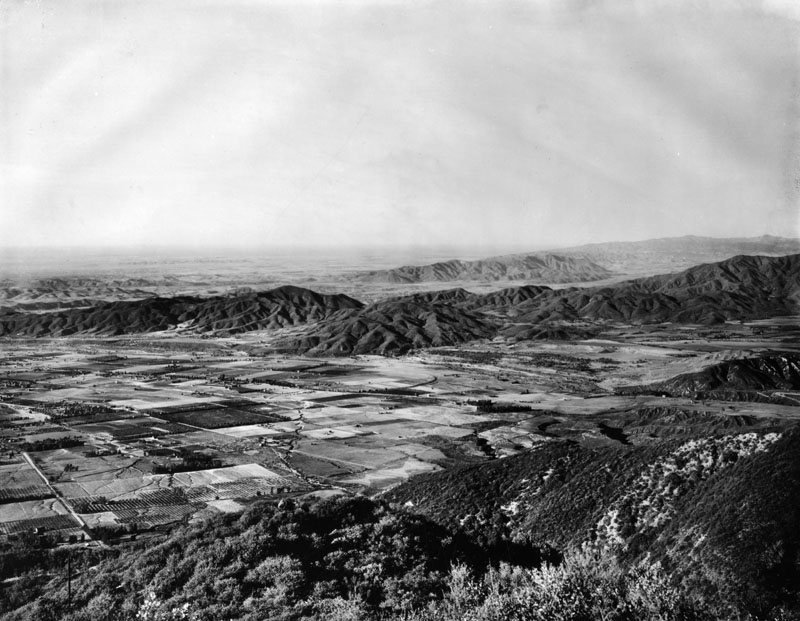 |
|
| (ca. 1880)* - Panoramic view of Pasadena as seen from the San Gabriel Mountains on a clear day. |
Historical Notes Pasadena is a part of the original Mexican land grant named Rancho del Rincon de San Pascual, so named because it was deeded on Easter Sunday to Eulalia Perez de Guillén Mariné of Mission San Gabriel Arcángel. The Rancho comprised the lands of today's communities of Pasadena, Altadena and South Pasadena. |
 |
|
| (ca. 1900)* - View of Pasadena and it's surrounding areas, from Echo Mountain in the San Gabriel Mts. Note: the original file on this image states that it is dated ca. 1880, but if that is the footing for the Echo Mountain Hotel the date is somewhere between 1897 & 1905. Also, Echo Mountain House destroyed by fire (Feb 1900). |
Historical Notes Prior to the annexation of California in 1848, the last of the Mexican owners was Manuel Garfias who retained title to the property after statehood in 1850. Garfias sold sections of the property to the first Anglo settlers to come into the area: Dr. Benjamin Eaton, the father of Fred Eaton, Dr. S. Griffin, and Benjamin Wilson. Much of the property was purchased by Benjamin Wilson who established his Lake Vineyard property in the vicinity. Wilson, known as Don Benito to the local Indians, was also owner of the Rancho Jurupa (Riverside, California) and mayor of Los Angeles. He is the grandfather of WWII General George S. Patton, Jr. In 1864 Wilson took the first white man's expedition to a high peak of the San Gabriel Mountains that would be named Mount Wilson. He hoped to harvest timber there for the making of wine vats, but he found the wood inadequate. The Wilson Trail became a popular one or two-day hike to the crest of the San Gabriel Mountains by local residents for years to come. |
Then and Now
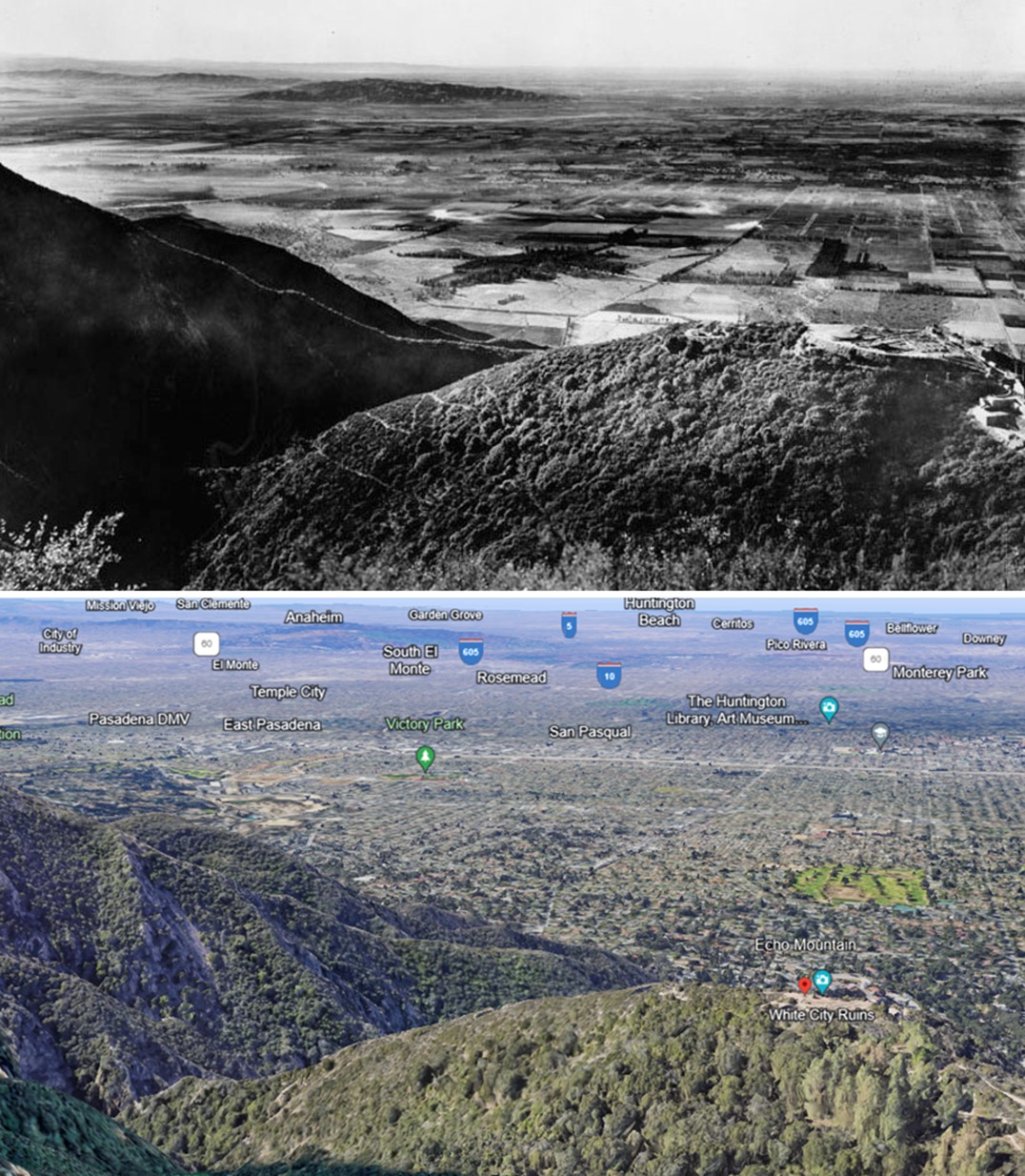 |
|
| (ca.1900 vs 2023)* – Looking southeasterly from over Echo Mountain toward the San Gabriel Valley. |
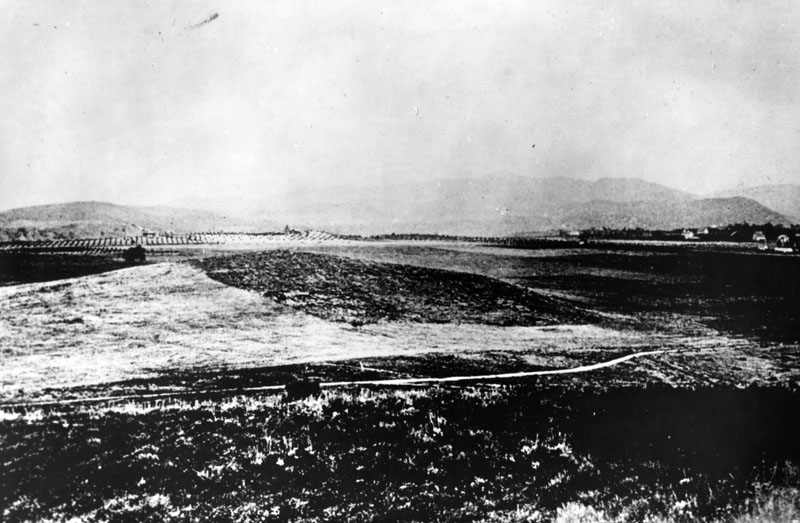 |
|
| (ca. 1870)* - View from Bacon Hill. The Raymond Hotel was built atop Bacon Hill which lies between Pasadena and South Pasadena and was renamed Raymond Hill with the opening of the hotel in 1886. |
Historical Notes In 1873, Benjamin Wilson and Dr. S. Griffin subdivided their land (with Griffin getting almost 2/3 of the property, but Wilson retaining some better land (east of current Fair Oaks Avenue), near his Lake Vineyard property). Griffin then sold 2,500 acres of his property to the "Indiana Colony," represented by Daniel M. Berry. In 1876, after the Colony had sold most of its allotted land and established what would become the City of Pasadena, Wilson began subdividing and developing his adjacent landholdings which would become the eastern side of the new settlement. |
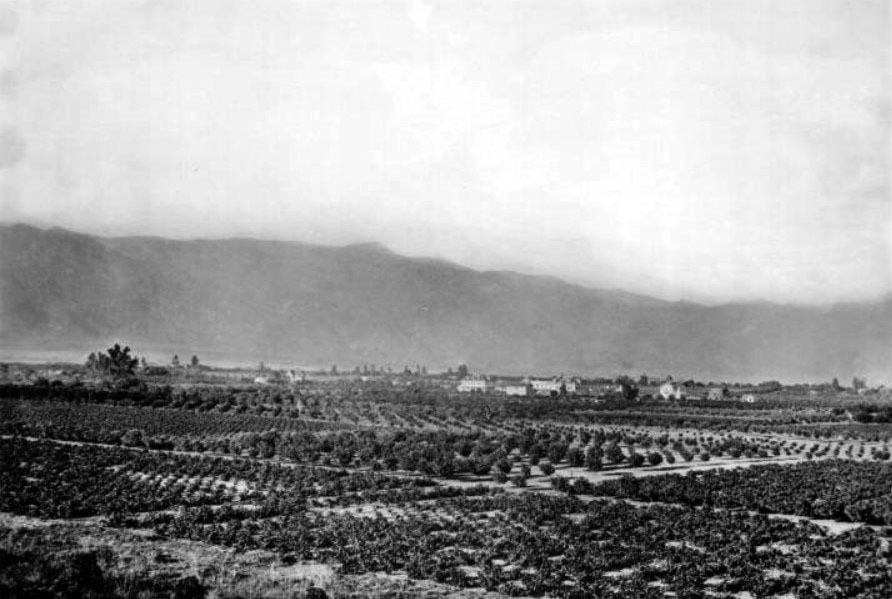 |
|
| (ca. 1874)^ - Panoramic view of the orange groves of the first Pasadena settlers, looking northwest. Houses and stores are clustered around Colorado Street (later Boulevard) and Fair Oaks Avenue in the distance at right. Mountains are visible in the background. |
Historical Notes In 1873, Dr. Daniel M. Berry of Indiana visited the area in search of a place that could offer better climate to his patients, most of whom suffered from respiratory ailments. Berry was an asthmatic and claimed that he had his best three nights sleep at Rancho San Pascual. To raise funds to bring the company of people to San Pascual, Berry formed the Southern California Orange and Citrus Growers Association for which he sold stock. The newcomers were able to purchase a large portion of the property along the Arroyo Seco and on January 31, 1874, they incorporated the Indiana Colony. The Indiana Colony was a narrow strip of land between the Arroyo Seco and Fair Oaks Avenue. On the other side of the street was Benjamin Wilson's Lake Vineyard development. After more than a decade of parallel development on both sides, the two settlements merged into the City of Pasadena. |
* * * * * |
First House
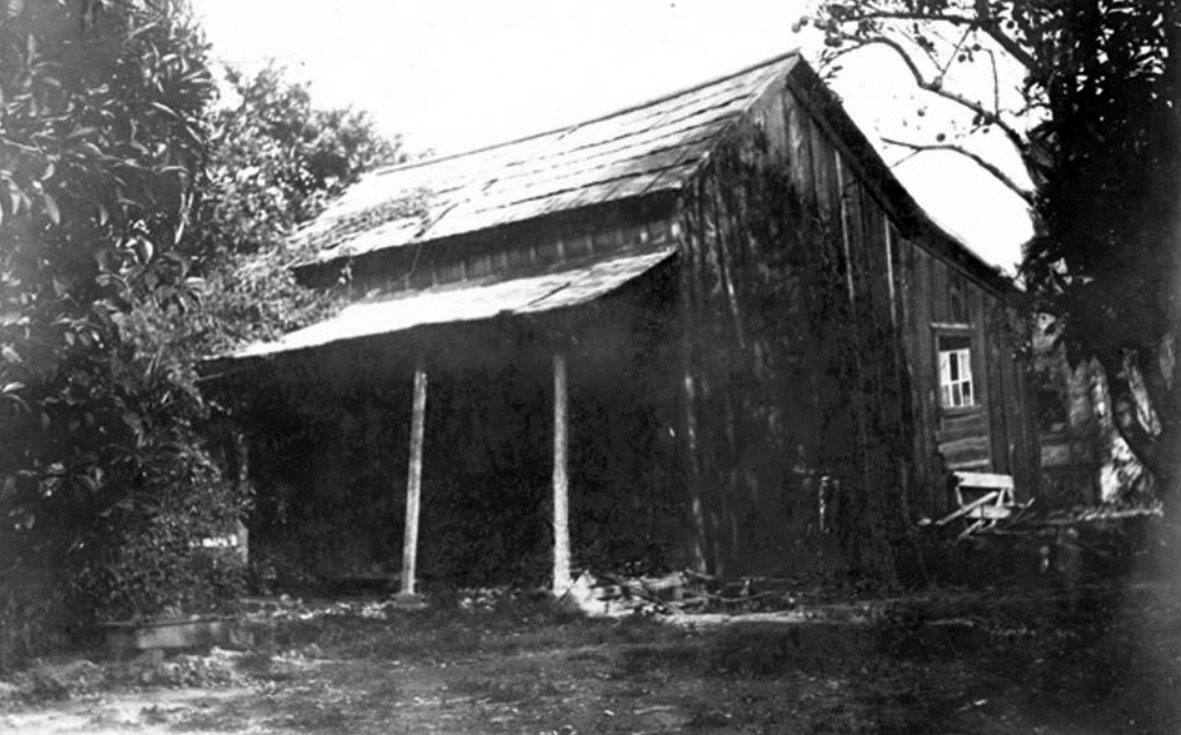 |
|
| (1874)* – View showing the home of A. O. Bristol, located on the SW corner of Orange Grove and Lincoln Avenue. This was the first house completed in Pasadena. |
Historical Notes In January 1874, the new settlement was divided among the settlers and mapped. Generously sized parcels which were intended for the planting of orange groves were arranged on either side of the north-south axis of the colony, a street soon known as Orange Grove Boulevard. Houses for the new residents began to be built on the parcels, the first of which was the A. O. Bristol home near the corner of Orange Grove and Lincoln Avenue, finished in March 1874. By the end of 1875, there were 40 houses set among orchards, groves and vineyards. |
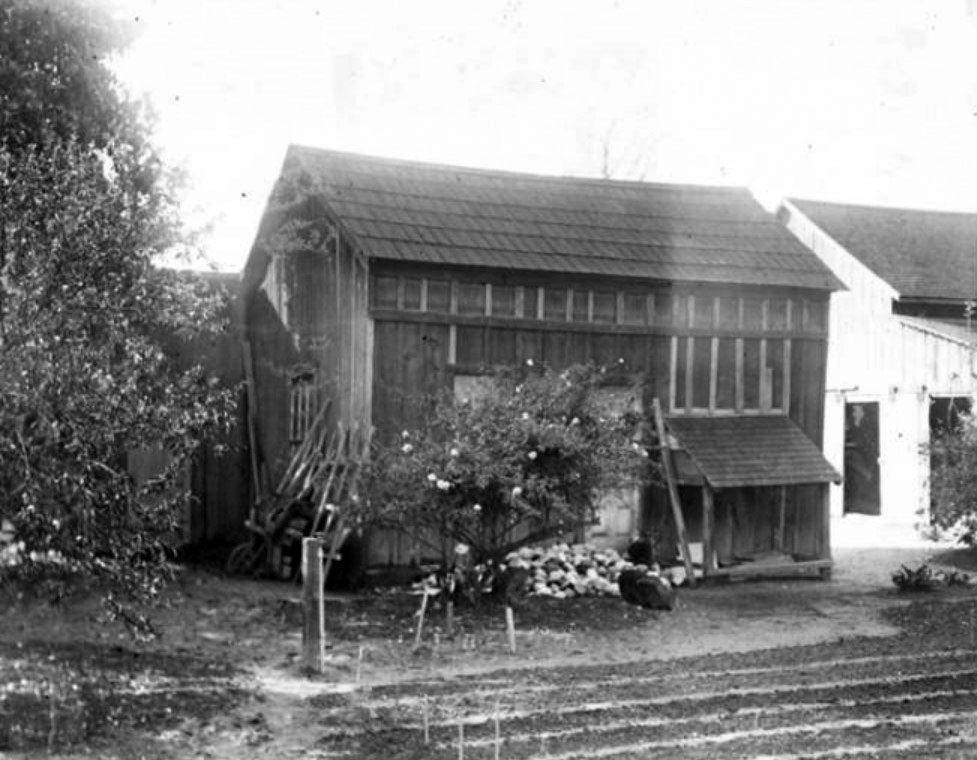 |
|
| (n.d.)* - Early view of the Bristol House, 1st house built in Pasadena. This photo was clearly taken after its use as a house had passed. |
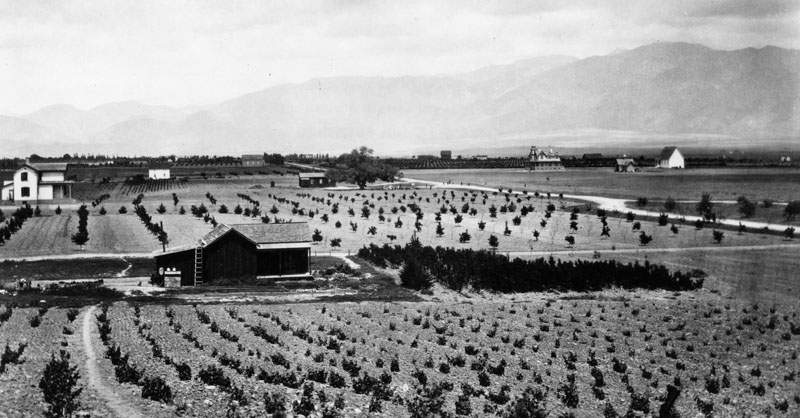 |
|
| (1876)* - View of Pasadena from south Orange Grove Avenue with the San Gabriel Mountains in the distance. Orange groves are seen throughout. |
Historical Notes Seen in the photograph are a number of Pasadena landmarks, as follows: In the far left of the frame is a two story, white house - the H. J. Holmes House. To the right of the Holmes House is another white building - this is the W.T. Clapp House. To the right of the Clapp House is the First Methodist Church. To the right of the church, under a large oak tree, is the first school house of Pasadena. To the right of the school house is a large, ornately designed house - the Gilmore House. The right-most building in the photograph - a large white structure - is the First Presbyterian Church. In the foreground of the photograph is Henry G. Bennett's House - the 4th house in Pasadena. Running behind the Bennett house is a road - now Bellefontaine Street, and from the right of the photograph running north is what is now Orange Grove Blvd. Note: An enlargement of this photograph is framed and hangs in the Pasadena Museum of History Reading Room, labeled "Pasadena as it was in 1876." |
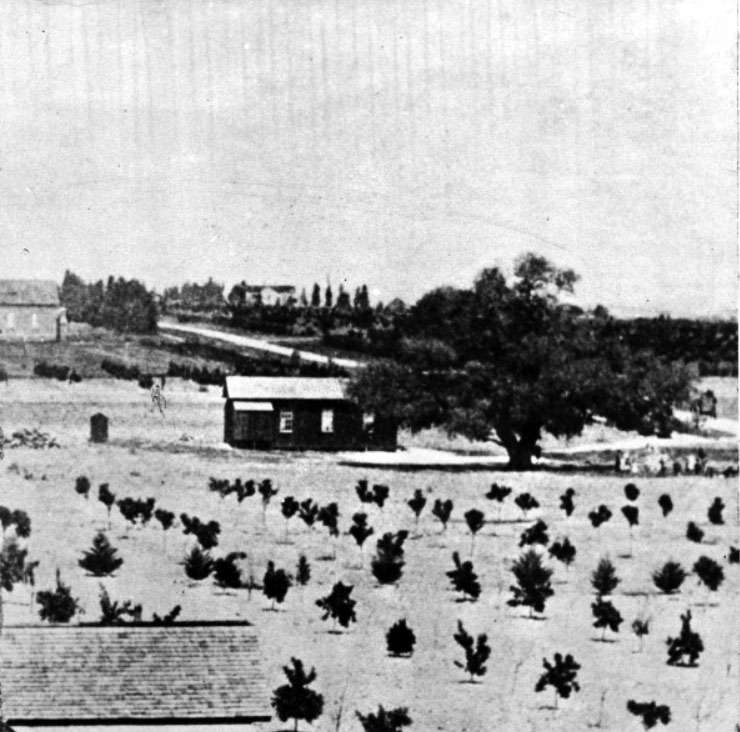 |
|
| (ca. 1874)** – View of the 1st School in Pasadena, Orange Grove St. on Clapp property. Jennie Clapp was the first teacher. |
Historical Notes Initially, with only two students, Jennie Clapp became the first teacher in town and utilized one of the rooms at her house located on Orange Grove Avenue, on the southwest corner of California Street. But soon enrollment shot up to 16 pupils and the room became too small. The Colonists met and decided that a real schoolhouse must be built. Three hundred dollars was soon collected and in October, 1874, a plain, rough board building was built on Orange Grove Avenue, close to the Clapp home. This was Pasadena's first schoolhouse. |
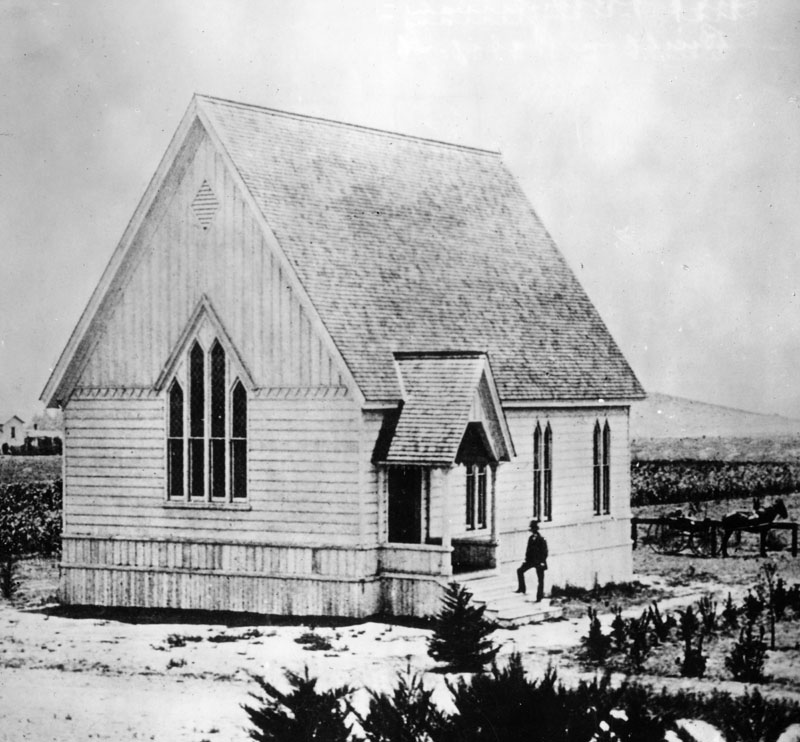 |
|
| (ca. 1875)* - Exterior view of the First Church in Pasadena. First Presbyterian - built on California Street near Orange Grove. |
Historical Notes On March 21, 1875, the Pasadena Presbyterian Church, the city's first church, was organized in a school house, also the city's first, on Orange Grove Avenue near California Street. That same year the church would be built near the school house. |
 |
|
| (1886)* - View looking northeast at the First Church in Pasadena (on he right). The schoolhouse is seen on the left. Photo was taken from the Methodist Episcopal Church, corner Colordo Boulevard and Marengo Avenue. |
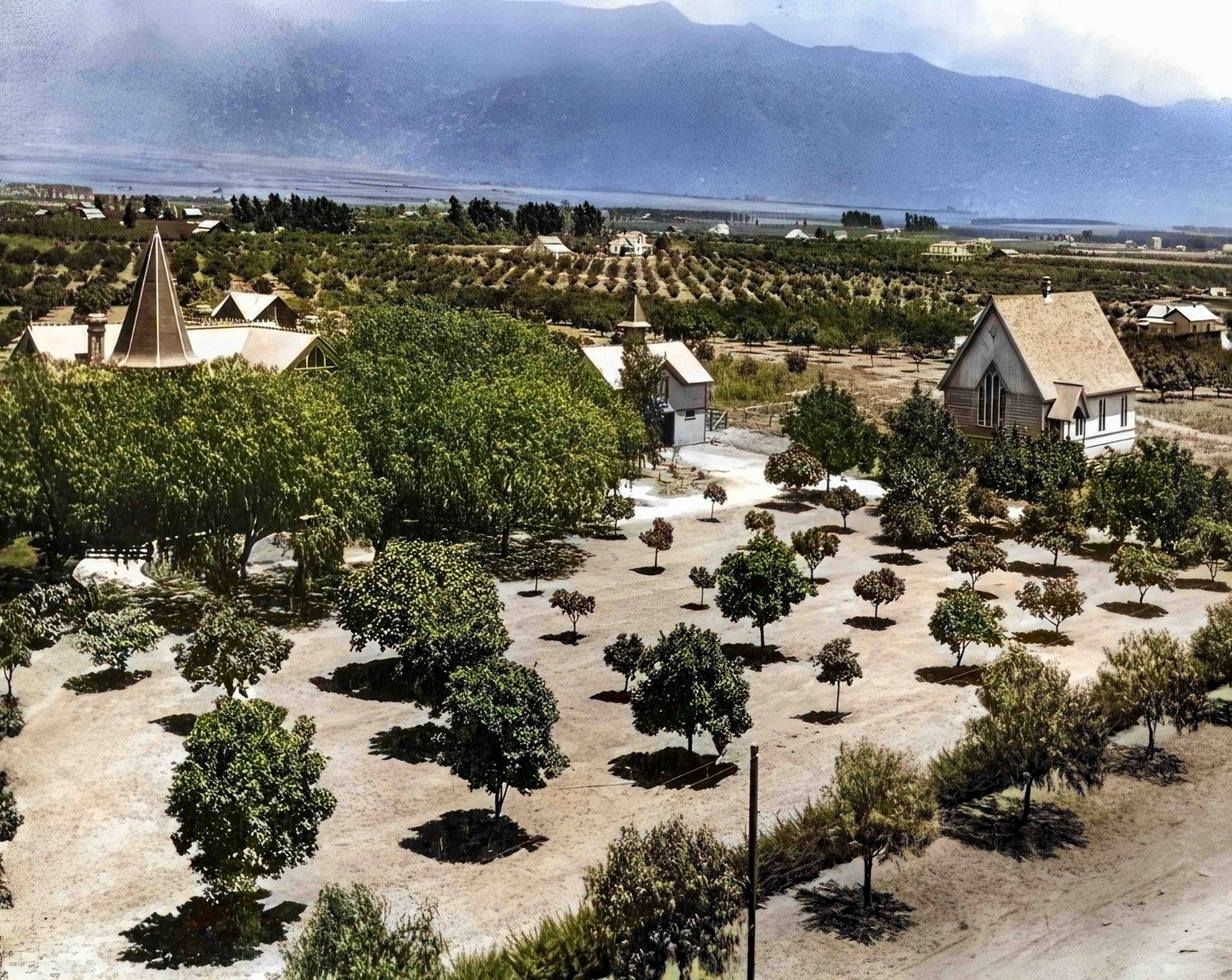 |
|
| (1886)* - View looking northeast at the First Church in Pasadena (on he right). The schoolhouse is seen on the left. Photo was taken from the Methodist Episcopal Church, corner Colordo Boulevard and Marengo Avenue.Image enhancement and colorization by Richard Holoff. |
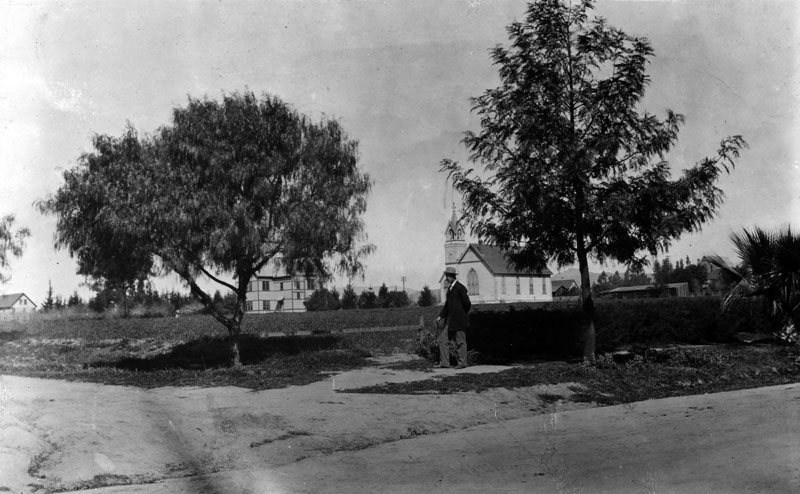 |
|
| (ca. 1893)* - A man identified as Nels Eckline poses near a fence, behind which are the first church (background right) and the first school (background left) in South Pasadena. |
 |
|
| (ca. 1893)* - A man identified as Nels Eckline poses near a fence, behind which are the first church (background right) and the first school (background left) in South Pasadena. Image enhancement and colorization by Richard Holoff |
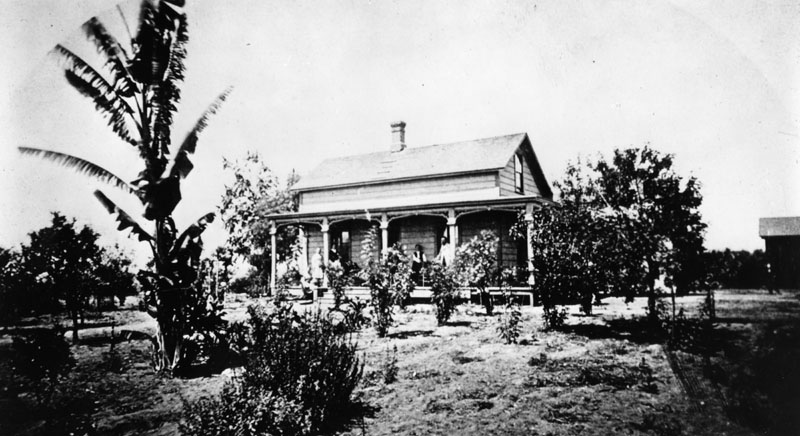 |
|
| (1876)* - Exterior view of Col. Banbury's ranch in Pasadena. This is the second house built on the colony. |
Historical Notes Colonel J. Banbury built the second home in Pasadena on South Orange Grove Avenue. It was a one and a half story plastered, eastern style house where the Tournament of Roses' Wrigley Mansion, one of the first houses in the Colony, now stands. For a while he was the "zanjero," or manager of the water supply. Banbury's twin daughters, Jennie and Jessie, were the original two students who attended the Pasadena’s first school on Orange Grove. |
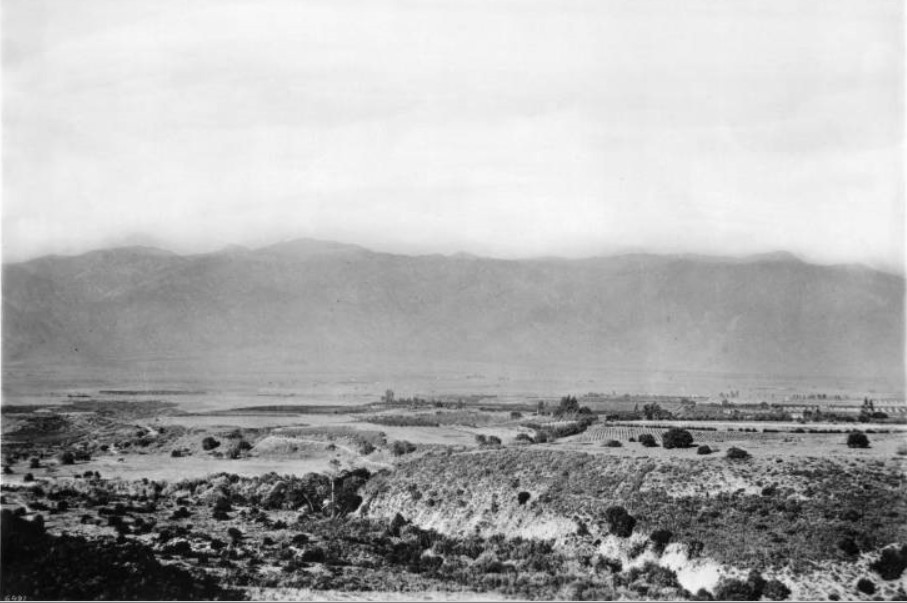 |
|
| (1876)^ - Panoramic view of early Pasadena looking northeast from the Arroyo Seco. Young orchards full of rows of underdeveloped trees dot the hilly landscape. Bushed and other scrub vegetation grow as well. No houses are immediately evident. The San Gabriel Mountains stand in the background. |
Historical Notes Pasadena’s setting at the foot of the San Gabriel Mountains and on the edge of the ravine called Arroyo Seco both promoted its growth and limited its development. The mountains and the Arroyo imposed physical barriers to expansion, yet their dramatic beauty drew settlers and tourists alike. |
* * * * * |
First Methodist Church
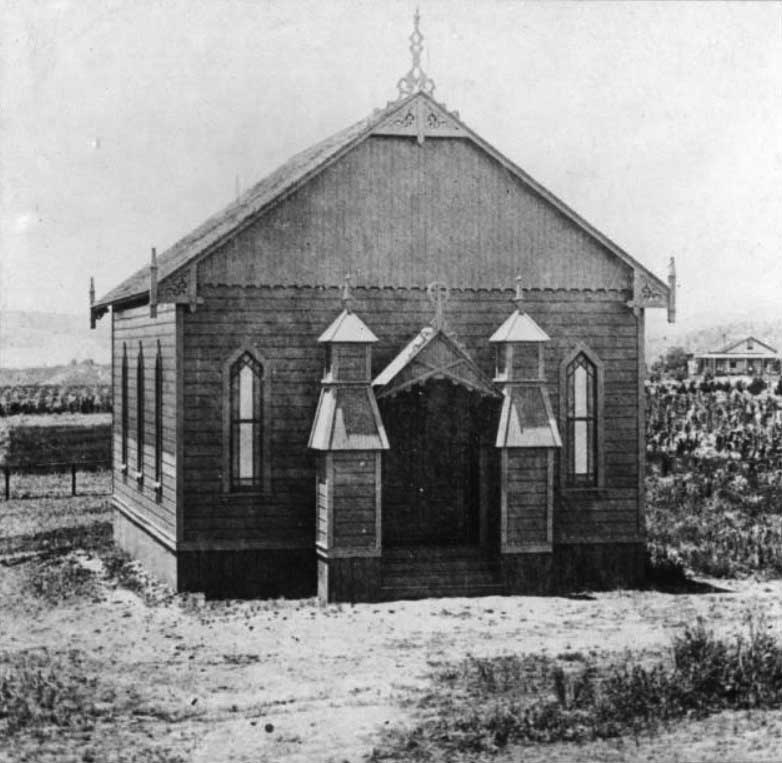 |
|
| (ca. 1877)* – View showing the First Methodist Church located at Orange Grove and Palmetto. This was the second church built in Pasadena. |
Historical Notes On January 7, 1877, a one-room Methodist Church was dedicated on Orange Grove and Palmetto by a congregation of twenty-four members. The facility had two hundred seats, a pump organ, a church bell and kerosene lamps. The pastor preached every other Sunday, sharing a circuit ministry with San Gabriel and Alhambra until 1882. Pasadena began to develop on Colorado instead of Orange Grove. Better roads and street lights were needed for evening services, so the church was put on rollers and moved near a livery stable on Colorado and De Lacey. The congregation’s next development was the purchase of land on the “hill” at the southeast corner of Colorado and Marengo. On March 20, 1887, a frame church with a 140-foot steeple and an adjacent eight-room parsonage were dedicated. |
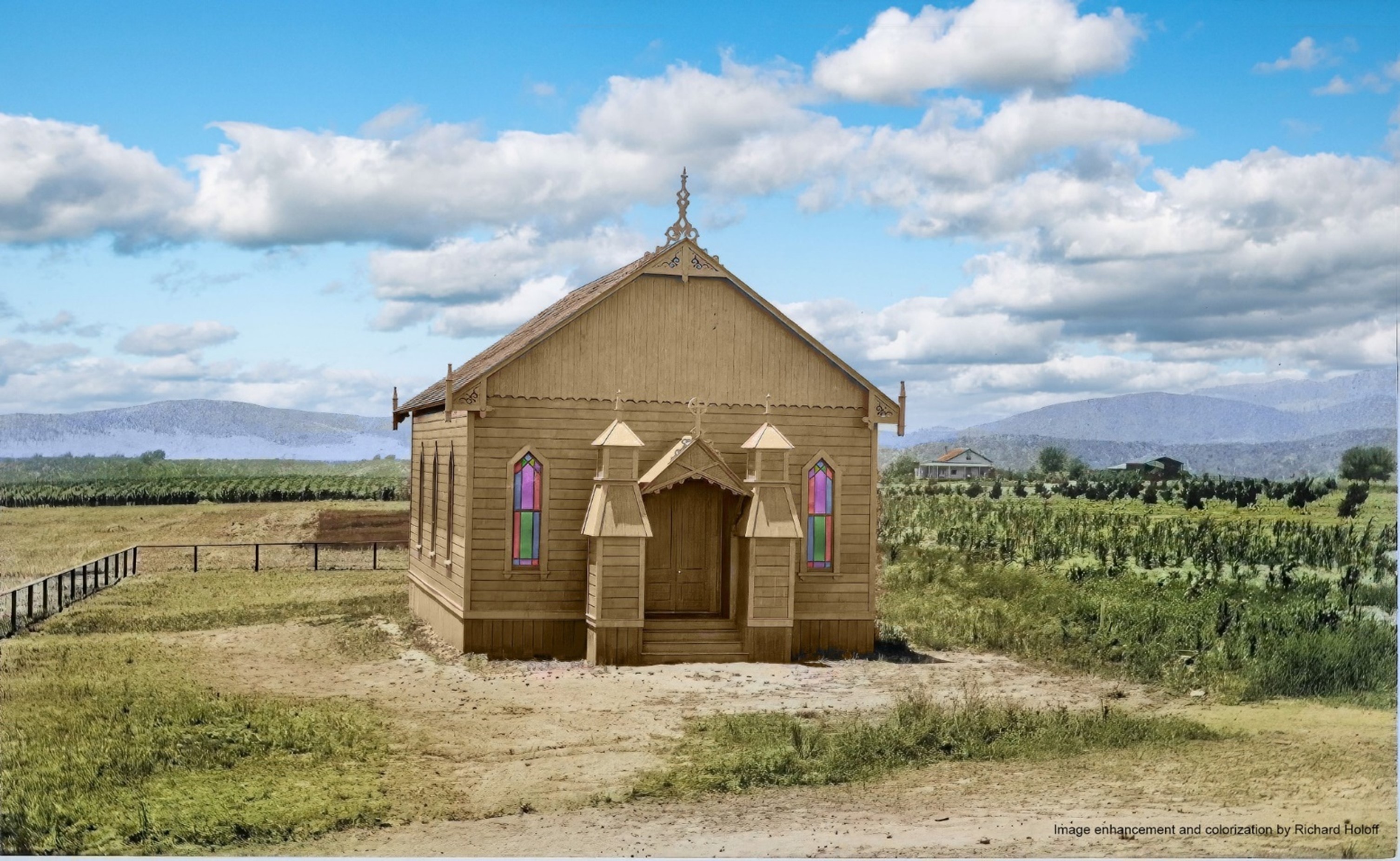 |
|
| (ca. 1877)* – View showing the First Methodist Church located at Orange Grove and Palmetto. This was the second church built in Pasadena. Image enhancement and colorization by Richard Holoff |
* * * * * |
Giddings House
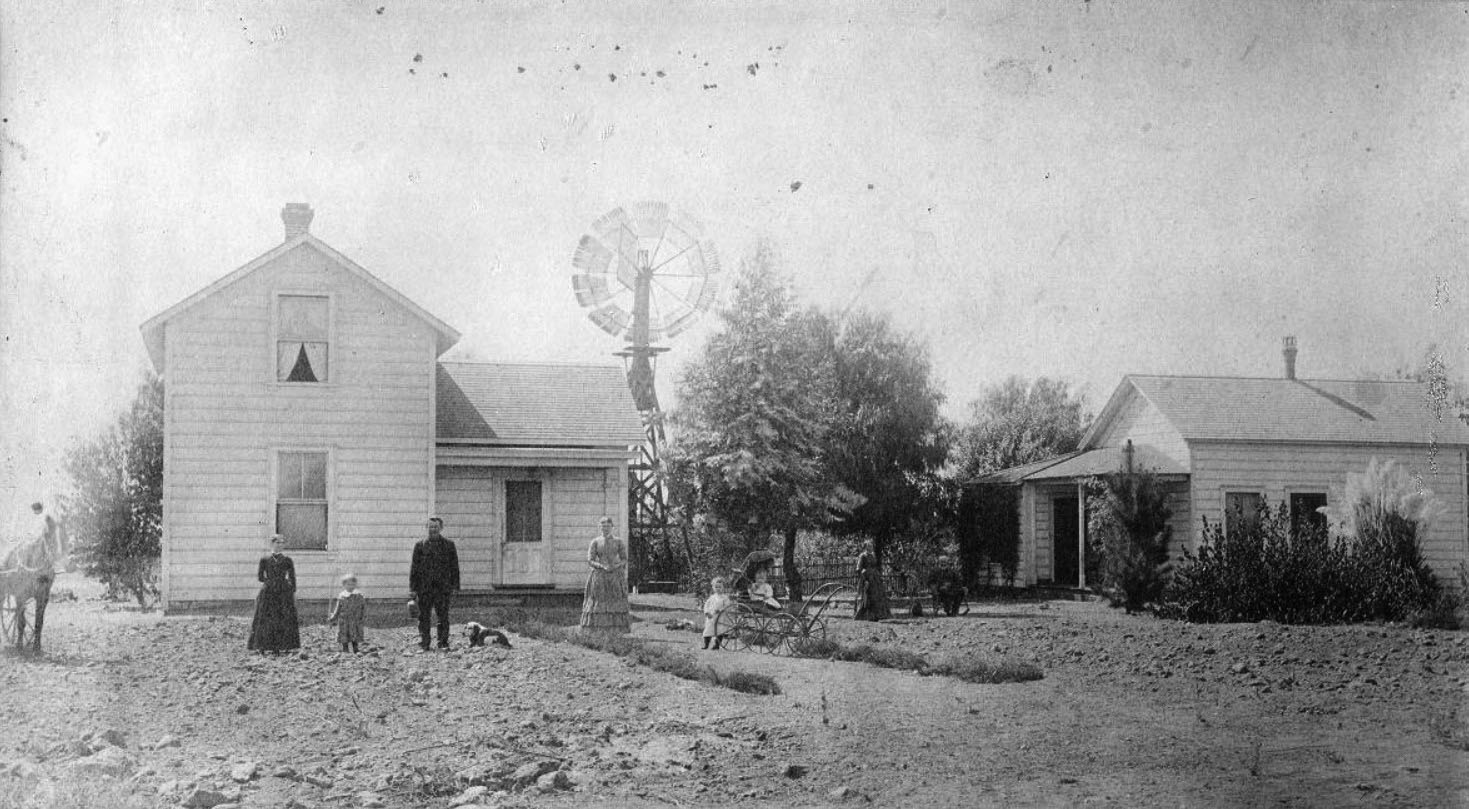 |
|
| (ca. 1878)* - View showing members of the Giddings and Hollingsworth families in front of their home at 1318 E. Colorado Street in Pasadena. While Jennie Giddings later wrote of moving to the property in 1881, this image—dated by the Pasadena Museum of History—suggests that at least part of the homestead was already in place by 1878, possibly built by or for another family member. Today, the site is occupied by a McDonald's on the southwest corner of Colorado Boulevard and Holliston Avenue. |
Historical Notes Joshua Reed Giddings of Iowa moved to Pasadena in 1874 as one of the original "old settlers." A street in Pasadena, Ashtabula Street, was named after his uncle (also named Joshua Reed Giddings), who was a famous abolitionist and U.S. House of Representatives member from 1838 to 1859 in Ohio (he lived in Ashtabula County, Ohio). Mr. Giddings was one of the founding members of the Pasadena Cemetery Association, along with a number of his family members. A photocopy slip dated 1937 found in the file with the photograph includes an excerpt which reads: "One of the first purchasers in the Lake Vineyard Colony was J. R. Giddings. Mrs. Giddings was the daughter of L. D. Hollingsworth who settled here in 1876. The Giddings home was at 1318 E. Colorado Street. Mr. Chapin writes in 1930 - 'At the present Giddings home on east Colorado Street there is a famous mulberry tree that provides the coolest possible shade in summer, and with so broad a spread that many sizable gatherings have been held under its overhanging branches, which indeed fall like a spray to the very ground.' Thirty Years in Pasadena, by Lon F. Chapin" Reverse: "J. R. Giddings house 1878" |
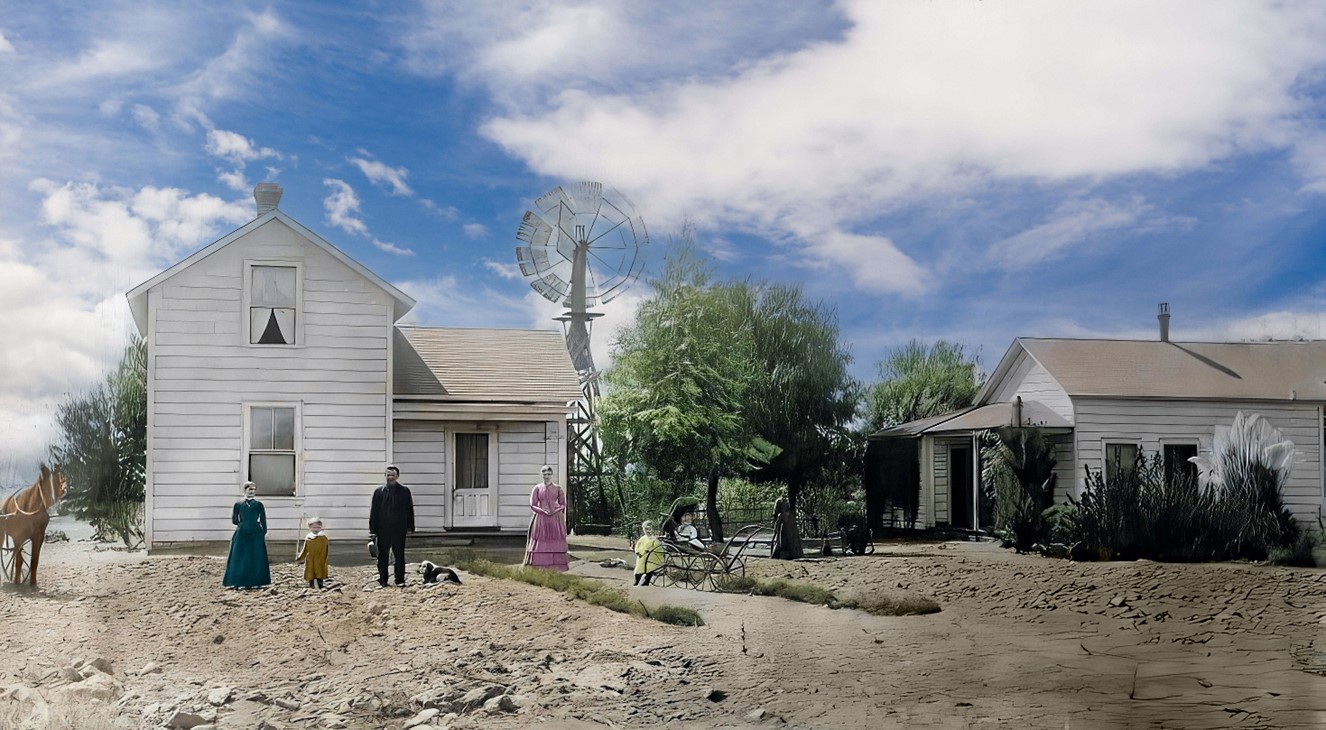 |
|
| (ca. 1878)* – View showing members of the Giddings and Hollingsworth families in front of their home at 1318 E. Colorado Street in Pasadena. While Jennie Giddings later wrote of moving to the property in 1881, this image—dated by the Pasadena Museum of History—suggests that at least part of the homestead was already in place by 1878, possibly built by or for another family member. Today, the site is occupied by a McDonald's on the southwest corner of Colorado Boulevard and Holliston Avenue. Photo enhancement and colorization by Richard Holoff. |
Historical Notes The Giddings family played a pivotal role in Pasadena’s early development after arriving from Iowa in 1874 as part of the original “Old Settlers.” Joshua Reed Giddings—named after his abolitionist uncle who served in Congress—settled on land near Millard Canyon, an area that became known as “Giddings Heights.” Their home at 1318 E. Colorado Street—later replaced by a McDonald’s—became a local landmark, shaded by a sprawling mulberry tree that often hosted community gatherings. The family’s citrus groves and vineyards contributed to Pasadena’s emergence as a fertile agricultural oasis. The Giddings' civic and political legacy extended beyond California through their ties to Joshua Reed Giddings of Ohio, a fiery anti-slavery congressman censured in 1842 for challenging congressional gag rules. His defiance made him a hero in abolitionist circles and earned him a quiet tribute in Pasadena: Ashtabula Street, named after his hometown. His grandnephew carried that spirit westward, co-founding the Pasadena Cemetery Association and helping shape the city’s civic foundation. |
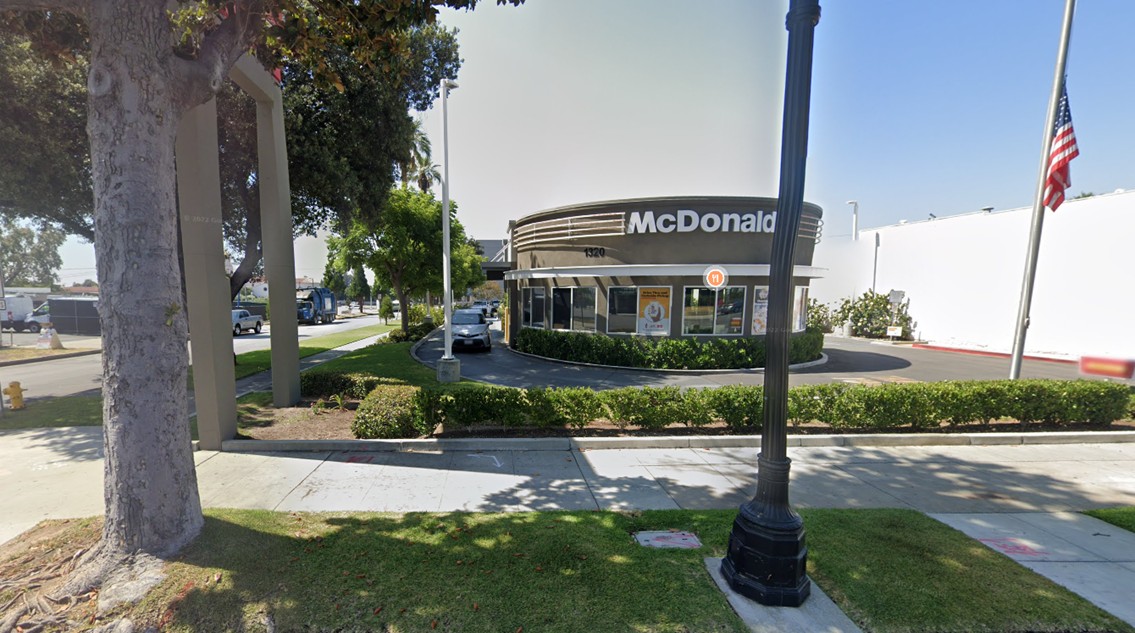 |
|
| (2022)* – A McDonald’s now stands on the southwest corner of Colorado Boulevard and Holliston Avenue in Pasadena, once the site of the historic Giddings House. |
Historical Notes Though the original home is gone, a subtle marker endures: a 1906 Foothill Boulevard Milestone (Mile 11), embedded in the sidewalk near McDonald’s, part of a now-obscure road system once measured from Los Angeles' old courthouse. |
Then and Now
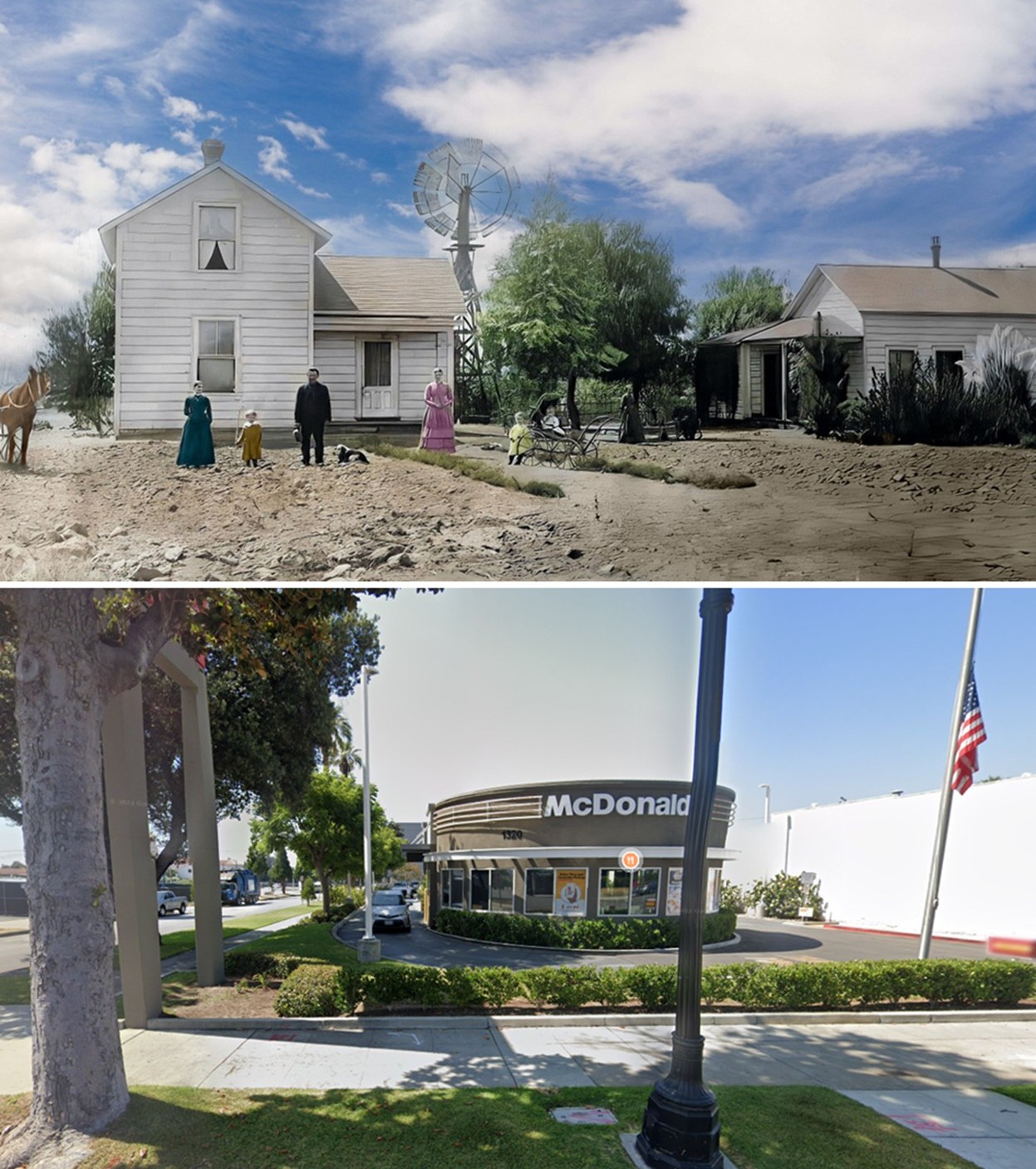 |
|
| (1878 vs. 2022)* – A 'Then and Now' comparison of the Giddings House at 1318 E. Colorado Street in Pasadena, now the site of a McDonald's. Interestingly, the Foothill Boulevard Milestone (Mile 11), a historical marker commemorating the area's history, stands on the sidewalk in front of this McDonald's at the corner of Colorado Boulevard and Holliston Avenue. Photo comparison by Jack Feldman. |
Historical Notes This site captures Pasadena’s transformation from pioneer homesteads to modern commerce. The Giddings' story—spanning covered wagons, agricultural innovation, and national reform—illustrates how early settlers wove personal legacies into the city’s fabric. While their house has vanished, their presence echoes in local place names, mountain trails like Giddings Peak, and the quiet markers that invite us to discover the layers of history beneath the modern landscape. |
* * * * * |
Pasadena's 1st Hotel
 |
|
| (1870s)* – View showing the Lake Vineyard House; Pasadena's first hotel, located at Marengo Avenue near Pleasant Street; John Griswold, proprietor. |
Historical Notes The Lake Vineyard House, built and operated by John Griswold around 1879–1880, was Pasadena’s first hotel and was located on Marengo Avenue near Pleasant Street. At a time when Pasadena was largely agricultural land, the hotel—set among vineyards and orchards—served as a focal point and gathering place for early settlers. In 1880, Griswold sold the property to Isaac Banta, who continued to run it as a hotel for a few years. By 1884, Banta found the Lake Vineyard House too remote from "The Four Corners," the bustling intersection of Colorado and Fair Oaks that defined Pasadena’s business district. He consequently converted the property into a private residence and went on to build the Los Angeles House Hotel, strategically situated near the center of town to better accommodate visitors and capitalize on the city’s growth. These events highlight the evolving character of Pasadena as it transitioned from a rural colony to a more urbanized community, with the Lake Vineyard House standing as an enduring symbol of the city’s early hospitality history. |
* * * * * |
Pasadena's 1st School (Central School)
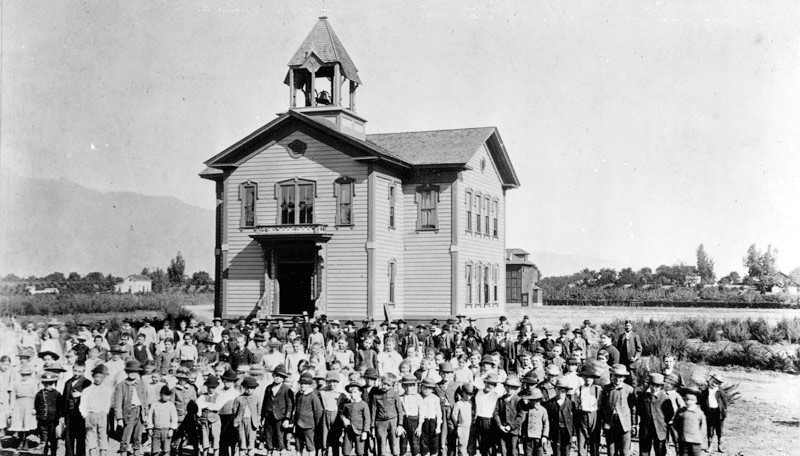 |
|
| (ca. 1880s)* - Group photo of the students attending the "First" school in Pasadena (Central School). The school building was the largest building in the area and visible from almost any part of Pasadena. It was located near the corner of Raymond and Green. |
Historical Notes The first school in Pasadena, often referred to as Central School, originated with classes held in 1874 in the home of William T. Clapp on South Orange Grove Avenue near California Street. As enrollment quickly grew from just two to sixteen students, the community raised funds and built a dedicated schoolhouse on Orange Grove Avenue close to the Clapp property. This original schoolhouse was a modest structure but marked the beginning of organized public education in Pasadena. By the 1880s, as Pasadena expanded, a larger and more prominent school building—commonly known as Central School—was constructed near the corner of Raymond and Green. This building was reportedly the largest in the area at the time and could be seen from much of Pasadena, symbolizing the city’s growing commitment to education. |
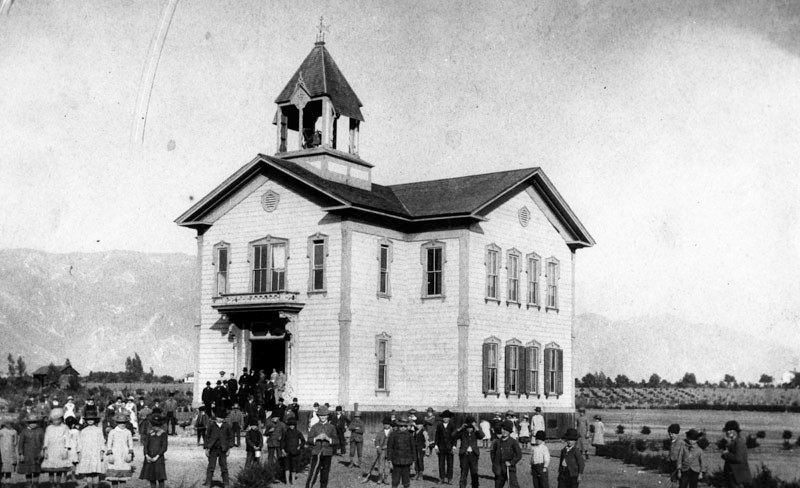 |
|
| (ca. 1880s)* - Closer view showing the first school in Pasadena and its students. The school was a handsome building for its day with separate classrooms for the different grades and of course a bell tower and bell. |
Historical Notes Central School’s location at Raymond and Green made it a key landmark in late 19th-century Pasadena. Interestingly, the building later served as Pasadena’s City Hall from 1887 to 1889 before subsequent educational facilities further accommodated the city’s rising population. The Pasadena school system continued to evolve, with high school-level classes introduced by 1878 and the establishment of Pasadena High School in 1891. Over time, the original Central School gave way to newer schools as the city’s educational demands increased, but its legacy remains as Pasadena’s foundational educational institution and a visible icon of the city’s early development. |
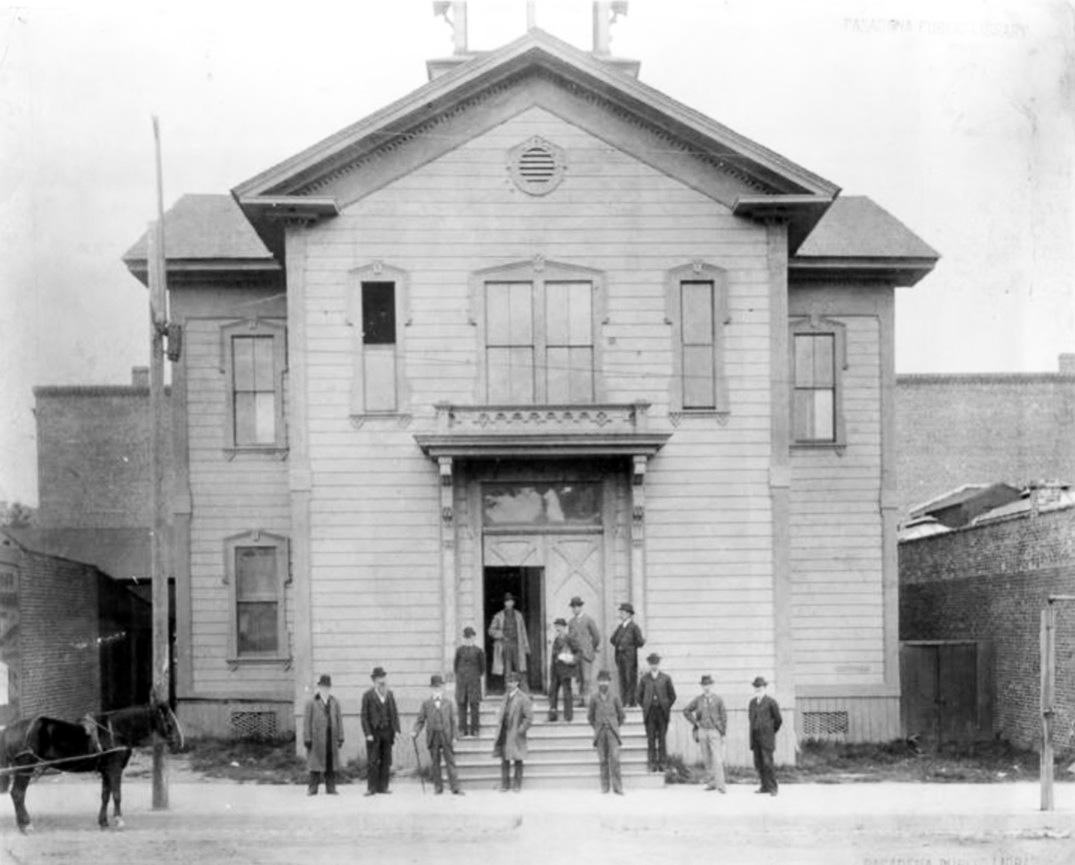 |
|
| (ca. 1897)* - This building, at the corner of Raymond and Green, formerly Central School, served as Pasadena's City Hall from March 21,1887 to December 10, 1889. |
Historical Notes This two-story, cross-gabled building served as Pasadena's first Central School during the 1880s. In 1887, a new Central School was erected, and this building rented to Pasadena's new city government, formed in 1886. It functioned as a city hall for a few years, perhaps between 1887 and 1891, before it was obtained by young men belonging to the Pasadena Athletic Club. |
* * * * * |
Pasadena Panoramic Views (1880s)
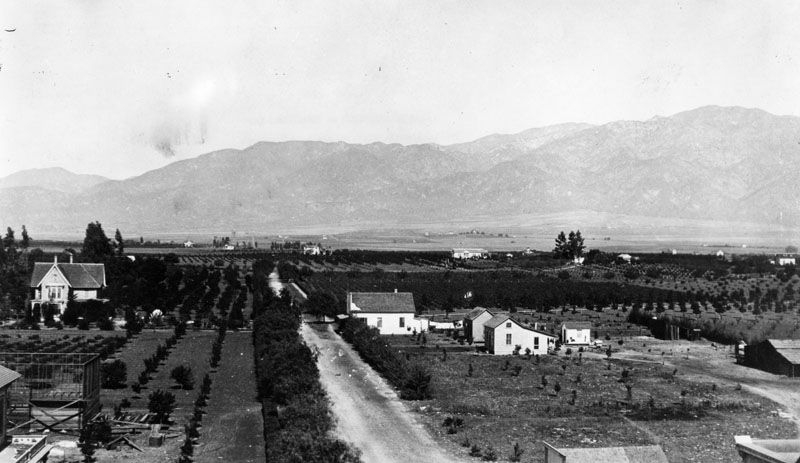 |
|
| (ca. 1880)* - View looking north on Oak Avenue from Colorado Street (now Colorado Boulevard), showing a patchwork of cultivated fields, orchards, and early homes in the Indiana Colony. |
Historical Notes This view captures the rural identity of Pasadena in the early 1880s, when the town was still defined by its agricultural roots. Organized rows of orange and lemon groves, vineyards, and shade trees lined the modest homes of settlers—many of whom had arrived from Indiana to form the “Indiana Colony.” Oak Avenue, seen here, was a smaller and more residential street, distinct from Fair Oaks Avenue, which lay several blocks to the west and developed into Pasadena’s primary north–south commercial corridor. Streets at the time were unpaved, and water was channeled via ditches from nearby creeks and artesian wells. The name Pasadena was adopted in 1886 after local leaders petitioned for a post office. Among the proposed names—Indianola, Granada, and Pasadena—the latter, derived from a Chippewa phrase meaning “of the valley,” was selected for its appealing sound. |
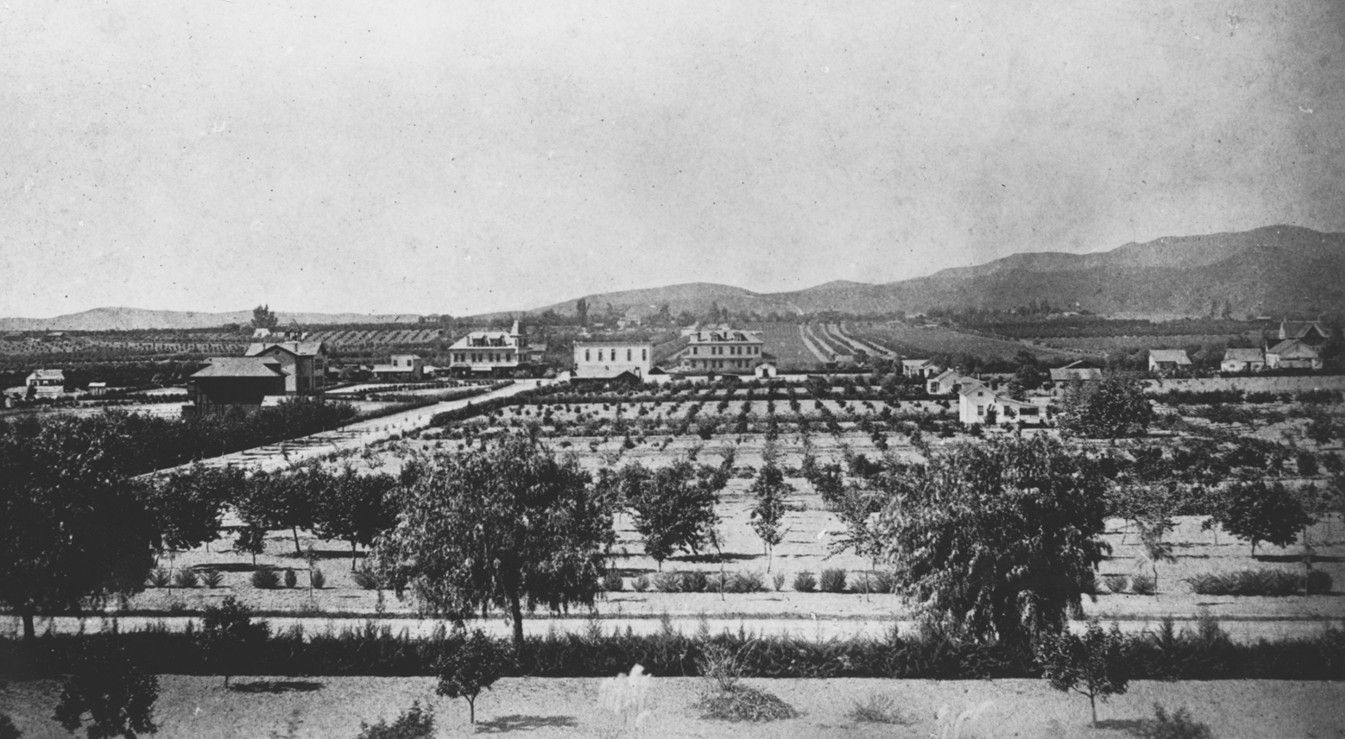 |
|
| (ca. 1884-1885)* - Panoramic view of Pasadena looking west, with the intersection of Fair Oaks Avenue and Colorado Street (now Boulevard) visible at center left. Based on building and infrastructure clues, this photo likely dates just before the arrival of the LA&SGV Railroad in late 1885. |
Historical Notes This photograph captures Pasadena just before its explosive growth in the mid-1880s. The dirt roads and early wooden buildings shown here were soon joined by more substantial commercial and civic structures, as the town began its transformation into a bustling city. Visible in this view is the intersection of Fair Oaks Avenue and Colorado Street—the future heart of Pasadena’s business district. Fair Oaks, named after a local ranch and dating back to 1874, formed the western boundary of the Indiana Colony and would evolve into a key commercial corridor. Colorado Street, running east–west, developed early as a commercial spine and remains central to the city’s identity today. Crucially, architectural details in this image help narrow the date to around 1884–1885. The Pasadena Library and Village Improvement Society building (constructed in 1884) is visible just east of the schoolhouse, and the Ward Block (completed in 1884) stands prominently at the southwest corner of Colorado and Fair Oaks. Notably absent is the Los Angeles and San Gabriel Valley Railroad, which would arrive in Pasadena in late 1885—further confirming the dating. |
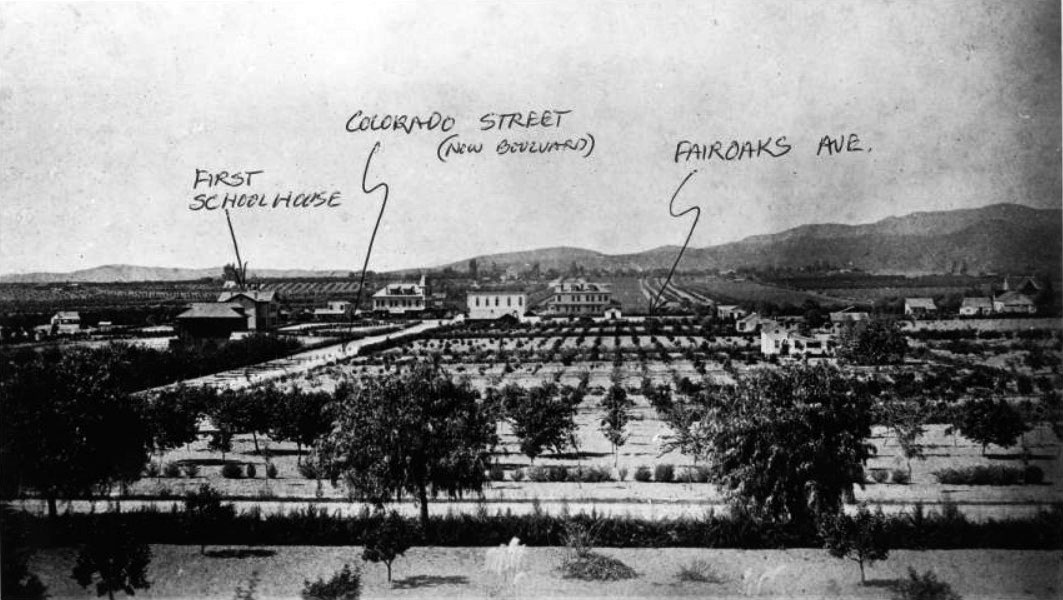 |
|
| (ca. 1884-1885)* - Annotated version of the previous image, identifying the first schoolhouse, Colorado Street, and Fair Oaks Avenue. |
Historical Notes This annotated version highlights several important landmarks of early Pasadena. The first schoolhouse, shown at left, reflects the Indiana Colony’s early commitment to education and civic life. Just east of it stands the Pasadena Library and Village Improvement Society building, constructed between 1883 and 1884. Together, these early institutions reveal how community values shaped the young settlement. At center is the intersection of Fair Oaks Avenue and Colorado Street—already beginning to emerge as the town’s commercial core. The Ward Block, completed in 1884 and visible at that corner, marks the arrival of more permanent architecture in downtown Pasadena. The surrounding landscape, still dominated by open fields and minimal tree cover, reflects a transitional moment. Though the railroad had not yet arrived—its tracks would reach Pasadena in September 1885—the town was on the verge of major transformation. This image captures that moment just before modern infrastructure, population growth, and economic expansion reshaped the region. |
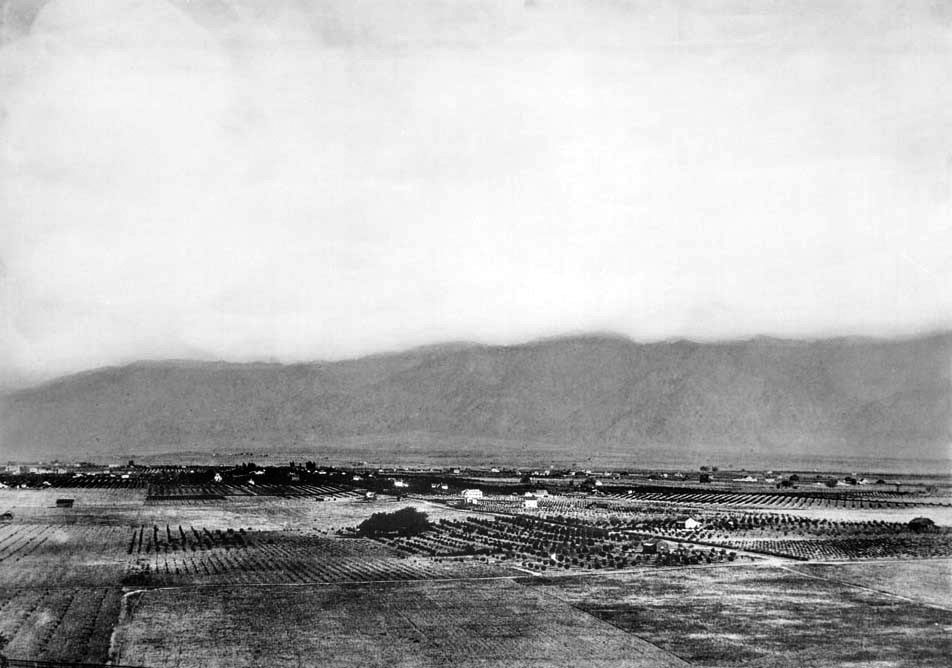 |
|
| (1883)* - Elevated view from Raymond Hill looking north across the Indiana Colony’s orchards and homes toward the San Gabriel Mountains. |
Historical Notes Raymond Hill, later home to the lavish Hotel Raymond (opened 1886), offered a commanding view over the developing town. This image shows the Indiana Colony at its agricultural peak: irrigation-fed groves, orderly plots, and scattered farmhouses laid out in a grid. This pre-hotel scene reveals a town rooted in nature and horticulture. The foothills of the San Gabriels dominate the background, while in the foreground, fences, windmills, and tilled fields reflect the settlers’ hard work to create a productive and healthful community. By 1886, this view would transform as tourism, resort culture, and real estate speculation remade Pasadena into a winter haven for affluent Easterners. |
* * * * * |
"The Four Corners" (Center of Old Pasadena, Colorado and Fair Oaks)
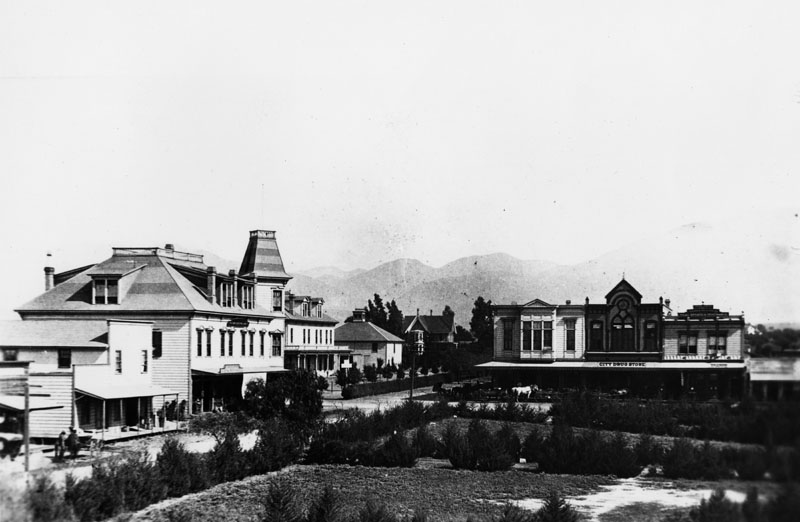 |
|
| (1884)* - View of Colorado and Fair Oaks in Pasadena, looking northwest. Building on the left is the Ward Block building. City Drug Store is on the right. |
Historical Notes The building on the left with the tower is the Ward Block, located on the southwest corner of Colorado Street and Fair Oaks Avenue. Behind it, on the northwest corner, was the Angeles House hotel (with veranda). To the right, on the northeast corner, is the general store, originally built by L.D. Hollingsworth in 1876. The landscaped foreground is part of Central Schoolhouse (Pasadena's first school) lot on the southeast corner. |
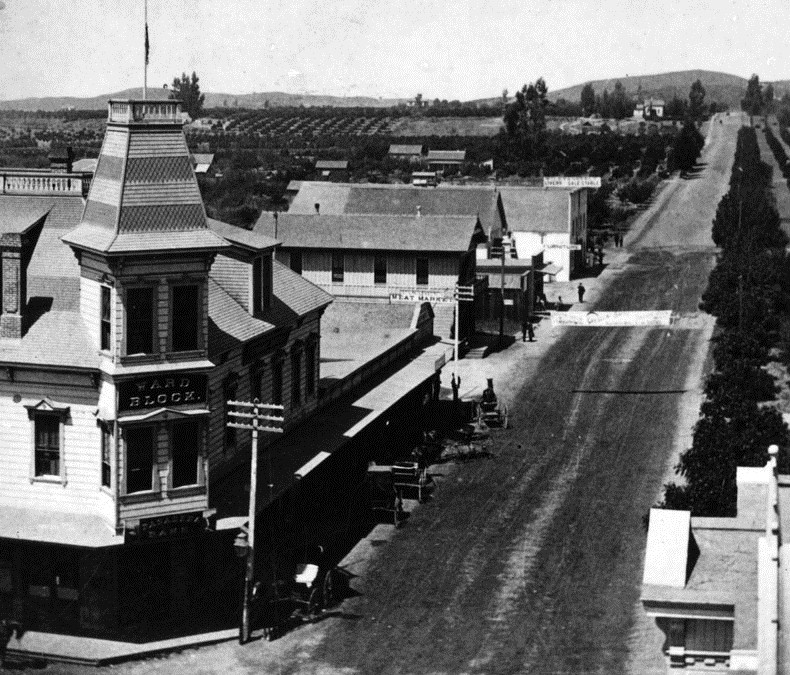 |
|
| (ca. 1883)* - Colorado and Fair Oaks looking west. Ward Block is on the left, which includes the Pasadena Bank and the Grand Hotel. Several horse-drawn carriages are parked along the sides of the building. There is a Meat Market and a Livery Stable past Ward Block. Cultivated fields can be seen in the background. |
Historical Notes The Ward family from Connecticut, Ben, Frank, Walter, and their father, Gen. Edwin Ward, built an imposing two-story building with a tower on the southwest corner of Colorado and Fair Oaks Avenue in 1883. The building housed the Grand Hotel and the Wells Fargo Express office. The Wards also founded Pasadena’s first newspaper, the Pasadena Chronicle, in 1883. |
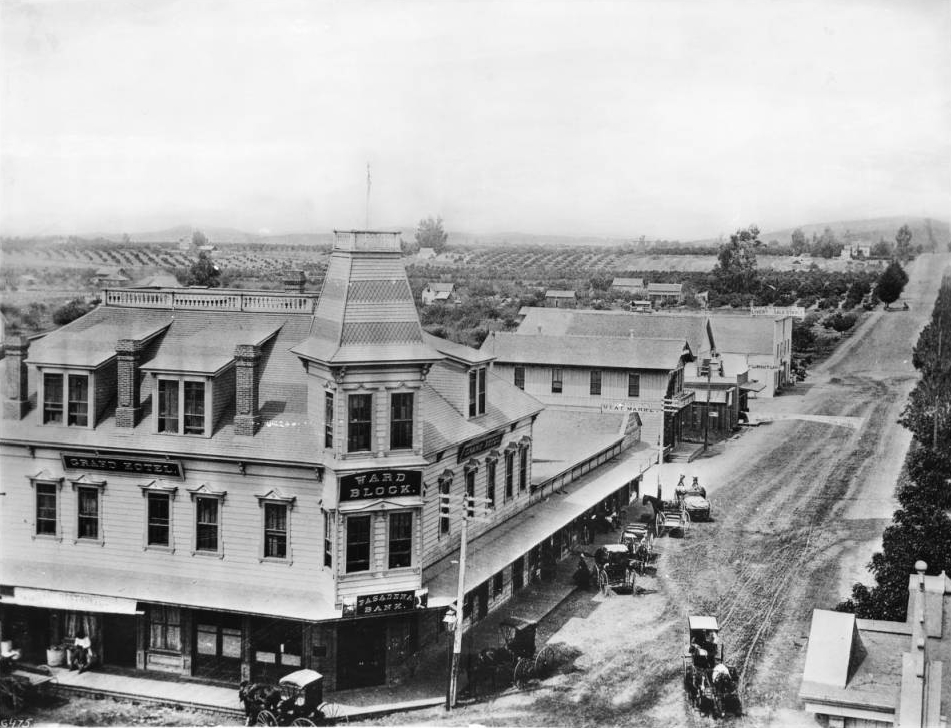 |
|
| (1884)* - Horse- drawn carriage traffic around the Ward Block, at the dusty intersection of Colorado and Fair Oaks in Pasadena. |
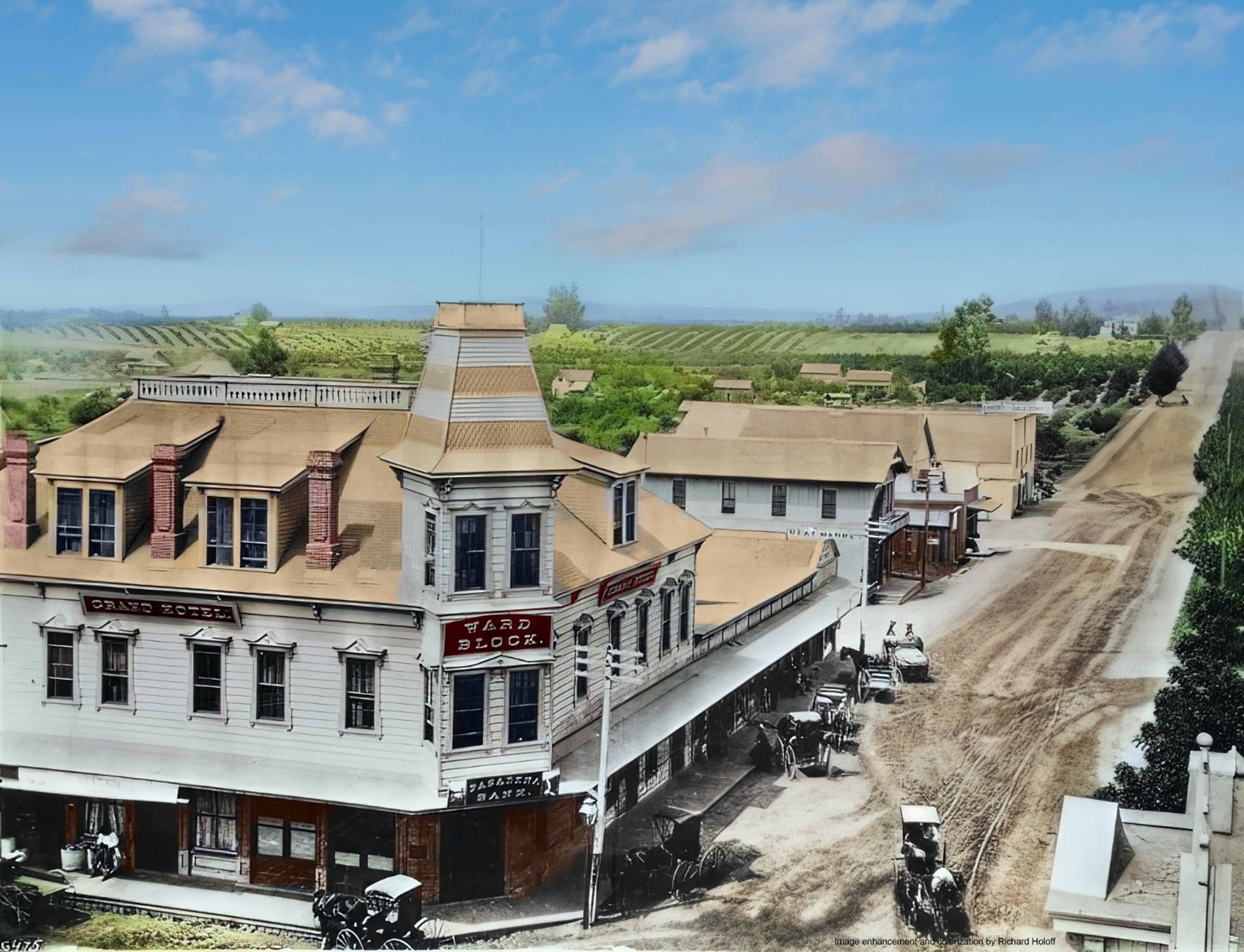 |
|
| (1884)* - Horse- drawn carriage traffic around the Ward Block, at the dusty intersection of Colorado and Fair Oaks in Pasadena. Image enhancement and colorization by Richard Holoff |
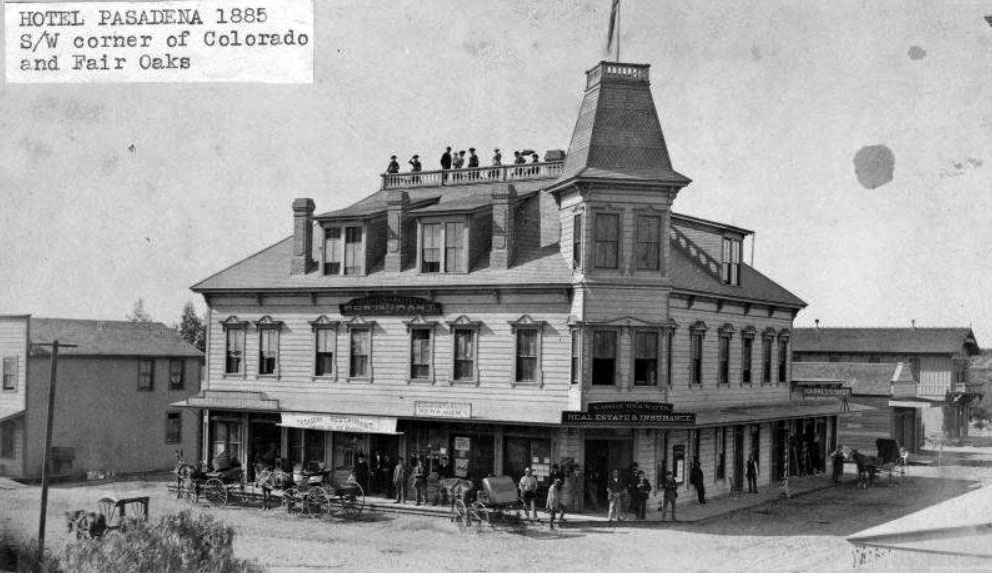 |
|
| (1885)* - View of the Hotel Pasadena located on the southwest corner of Colorado and Fair Oaks showing over a dozen people in front of the building with four horse-drawn wagons parked at the curb. There is also a group of people standing on the roof deck. |
Historical Notes Verso reads: "1885 Hotel Pasadena", "Ward Block / Cor. Fair Oaks & Colorado St", "Picture Belongs to L.E. Jarvis", "This was the home of the First National Bank, the first bank in Pasadena", "Webster's Hotel", and "Pasadena Restaurant". "Visible in the photograph on the ground floor are shop signs for, from Left to Right: L.H. (?) Bixby General Merchandise; Pasadena Restaurant; Cigars and Tobacco, News Agency; Washburn & Watts Real Estate & Insurance; Harness Shop. A large sign above the windows of the second floor reads: "Webster's Hotel / Restaurant / E.G. Webster, Pro." |
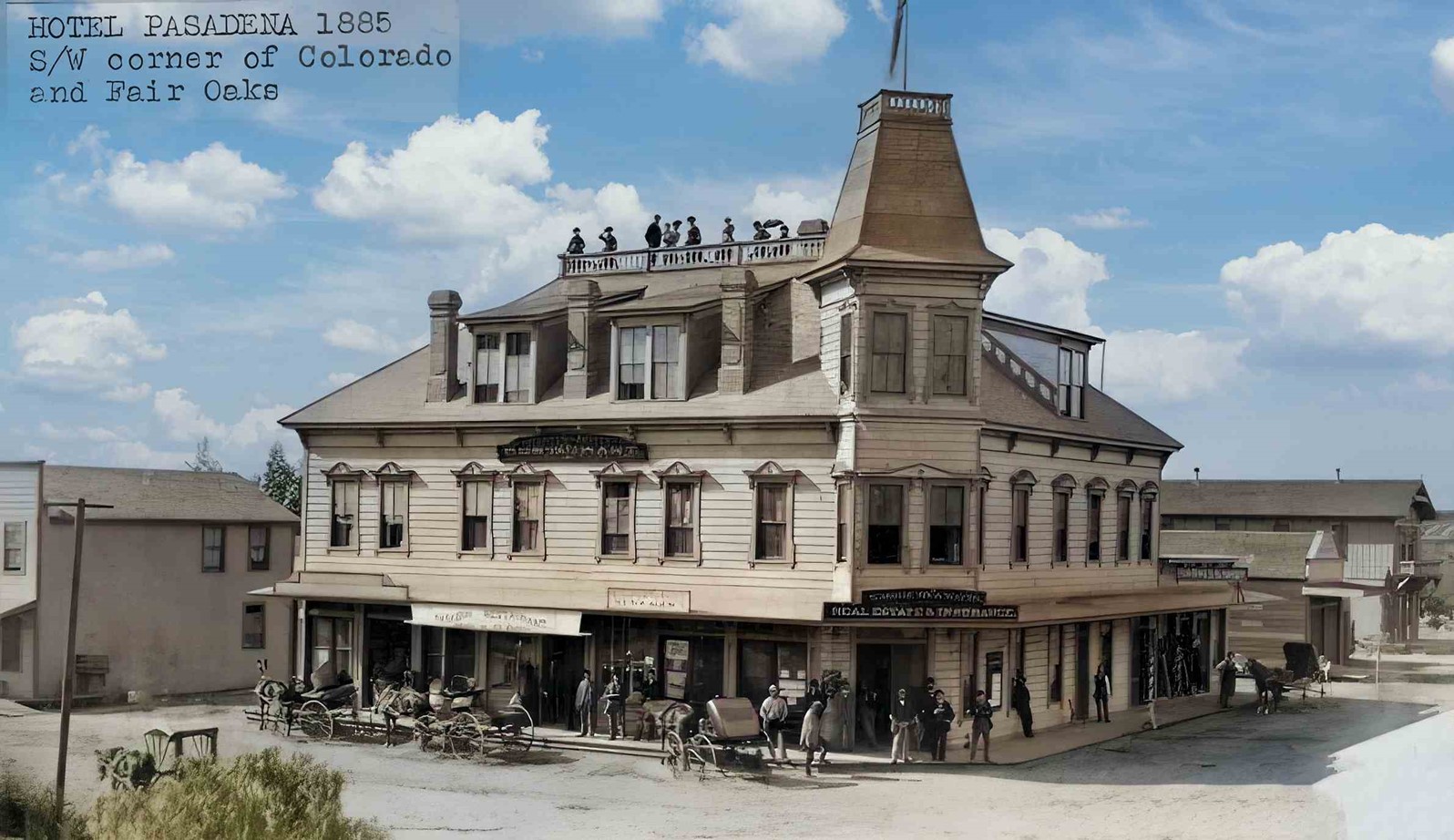 |
|
| (1885)* - Hotel Pasadena located on the southwest corner of Colorado and Fair Oaks at the intersection of what is kown as "The Four Corners", the center of Old Pasadena. AI image enhancement and colorization by Richard Holoff |
Then and Now
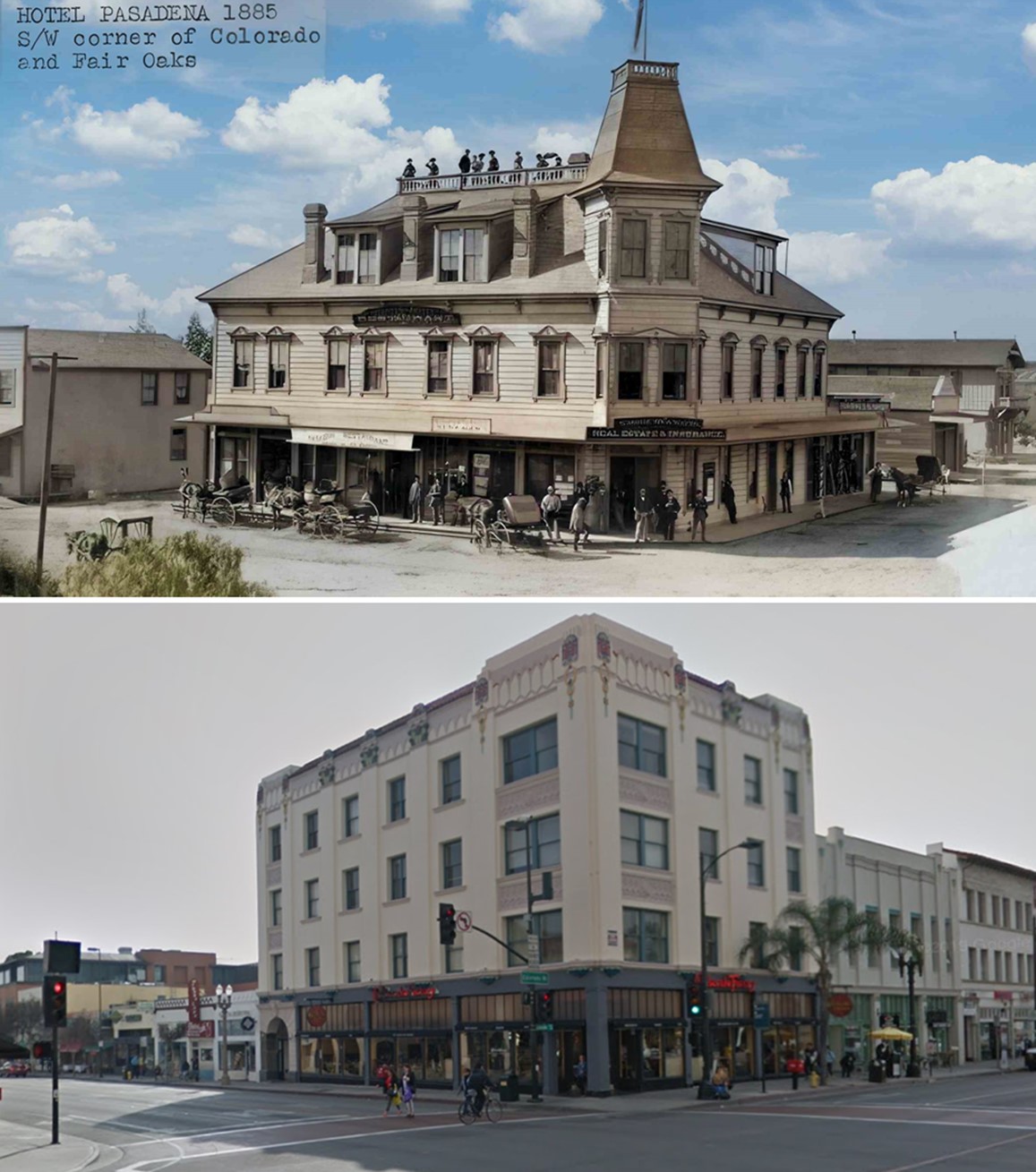 |
|
| (1885 vs 2019)* - Looking at the S/W corner of Colorado and Fair Oaks. Photo comparison by Jack Feldman. |
* * * * * |
Colorado Street
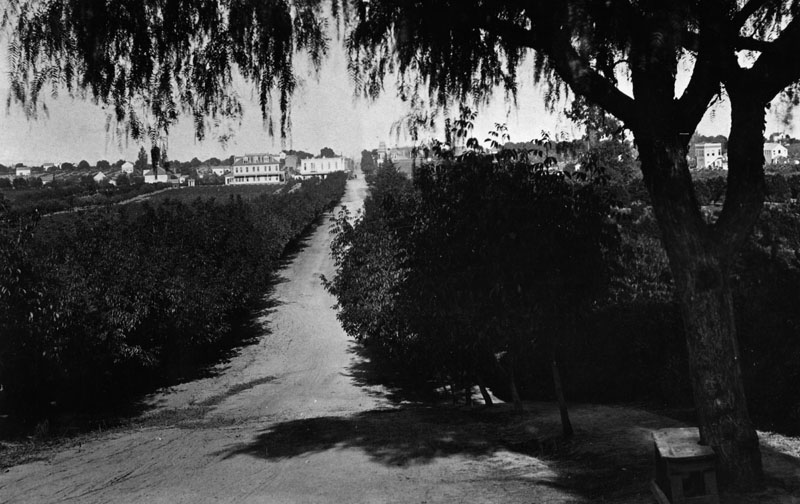 |
|
| (ca. 1887)* - View is looking east at Colorado Street in Pasadena. The western end of Colorado Sreet stretches from a point in the foreground where a bench can be seen set underneath an orchard tree at right. Further down the road in the distance, The Los Angeles House Hotel and Williams' Store can be seen to the left. |
Historical Notes By 1887, Colorado Street was transitioning from a rural orchard-lined lane into Pasadena’s central business corridor. The Los Angeles House Hotel and Williams’ Store, visible on the left, anchored this early commercial hub west of Fair Oaks Avenue. A bench under an orchard tree in the foreground reflects the semi-rural character that still defined much of the area. The opening of the Colorado Street Railway in 1886 accelerated development, setting the stage for Colorado Street to become the city’s principal thoroughfare. |
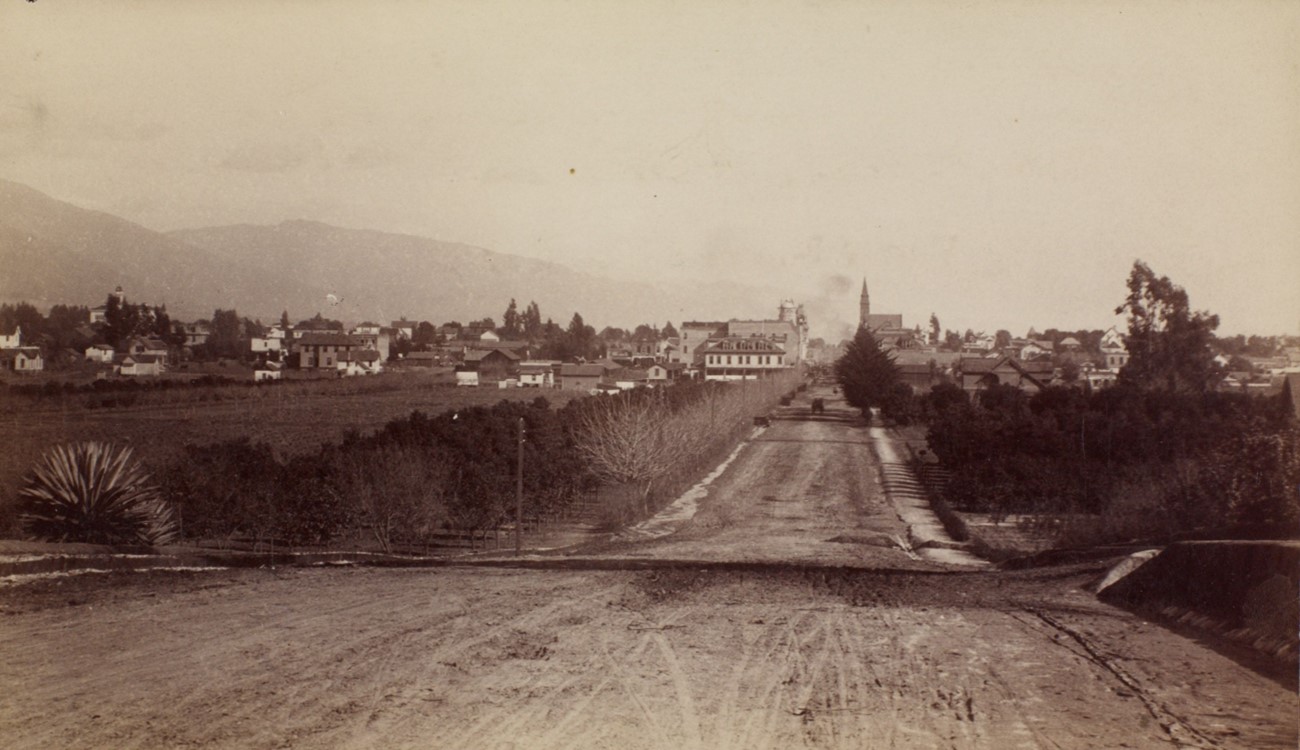 |
|
| (ca. 1890)* - View looking east on Colorado Street after widening. The Los Angeles House Hotel can be seen at center of photo on the northwest corner of Colorado and DeLacy. The tall tower in the distance is the Pasadena First Methodist Church located on the southeast corner of Colorado Street and Marengo Avenue. |
Historical Notes This view, taken after an early widening project around 1890, shows Colorado Street developing into a true business district. The Los Angeles House Hotel dominates the northwest corner of Colorado and DeLacy, while the 1888-built First Methodist Church, with its tall spire, can be seen on the southeast corner of Colorado and Marengo. Boardwalks and improved road grading replaced the rougher track of the 1880s, reflecting Pasadena’s growing prosperity just a few years after its 1886 incorporation. |
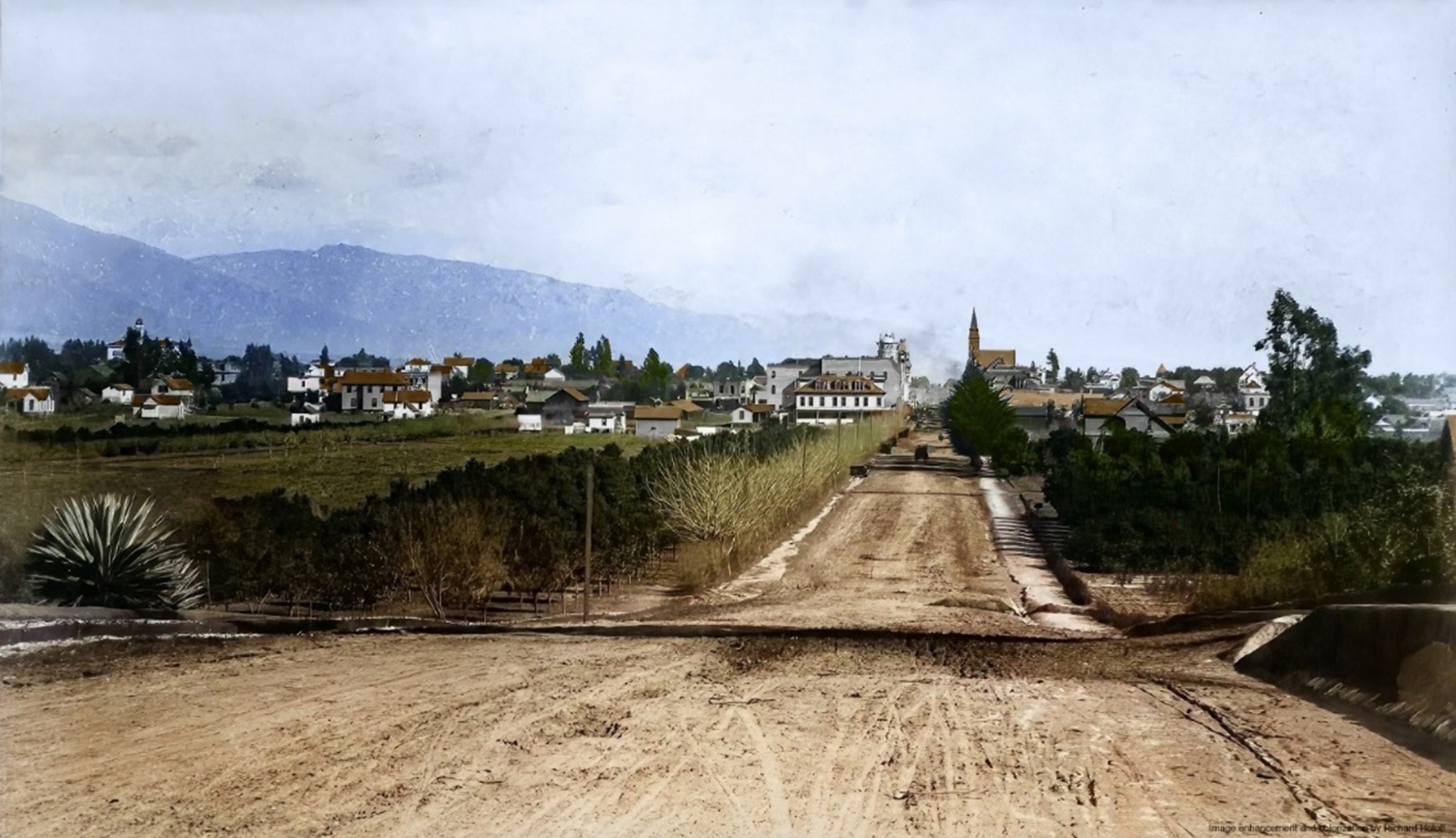 |
|
| (ca. 1890)* - View looking east on Colorado Street after widening. The Los Angeles House Hotel can be seen at center of photo on the northwest corner of Colorado and DeLacy. The tall tower in the distance is the Pasadena First Methodist Church located on the southeast corner of Colorado Street and Marengo Avenue. Image enhance and colorized by Richard Holoff |
Historical Notes This colorized version of the 1890 photograph highlights the same view as the original black-and-white image, showing the Los Angeles House Hotel and the First Methodist Church spire in the distance. The enhanced colors, added by Richard Holoff, are modern interpretations but help illustrate the vibrant transformation of Colorado Street into a bustling commercial avenue during Pasadena’s boom era. |
Before and After
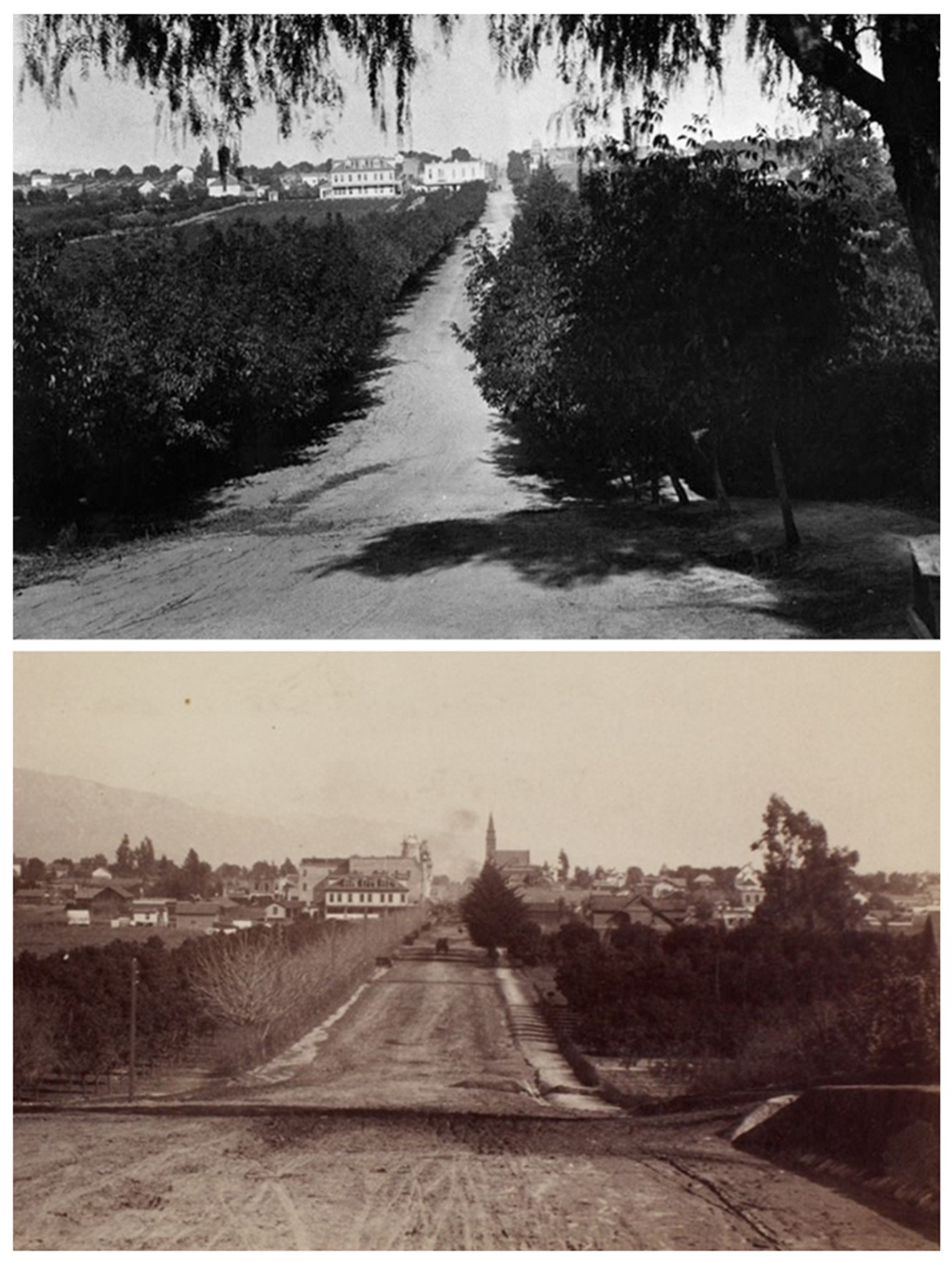 |
|
| (1887 vs 1890)* - Looking east on Colorado Street before and after widening. The Los Angeles House Hotel can be seen at center of photo on the northwest corner of Colorado and DeLacy. The tall tower in the distance is the 1888-built First Methodist Church located on the southeast corner of Colorado Street and Marengo Avenue. Photo comparison by Jack Feldman. |
Historical Notes These images present a before and after comparison of Colorado Street between 1887 and 1890. The Los Angeles House Hotel remains a constant landmark, while the newly built First Methodist Church spire punctuates the skyline in the later view. The widening of the street and the shift from semi-rural to urban storefronts underscore Pasadena’s rapid growth, foreshadowing the major 1929 widening that would permanently redefine Colorado Boulevard. |
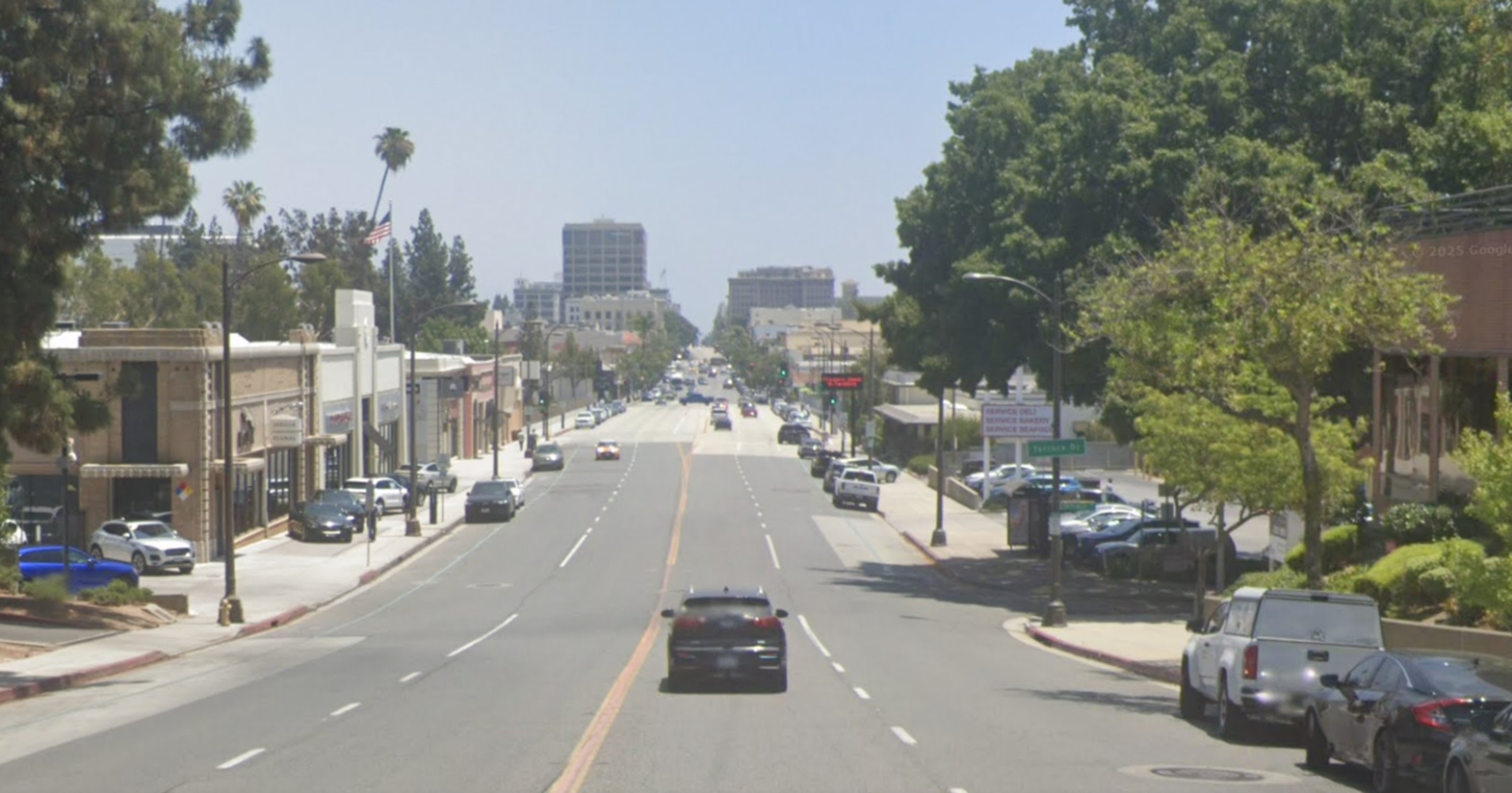 |
|
| (2022)* – Looking east along Colorado Boulevard as it gently descends Conger Hill. Just west of this view (behind the camera), on the right, stands the Wells Fargo Building and the Pasadena Elks Lodge, while the Norton Simon Museum sits just behind on the left. |
Historical Notes In the 1880s, this descent—known as Conger Hill—was lined with orchards and open land, named for the Conger family, early settlers of Pasadena. Today, this stretch of Colorado Boulevard is a key part of the Tournament of Roses Parade route, with floats and bands traveling east from Orange Grove Boulevard past this point each New Year’s Day. Just west of the modern view are the Pasadena Elks Lodge (1912), a historic fraternal landmark, and the Wells Fargo Building, representing mid-20th-century commercial growth. On the left stands the Norton Simon Museum, built on the former Carmelita Gardens estate, which since 1974 has housed one of the nation’s premier private art collections. This segment of Colorado Boulevard is also a celebrated portion of historic Route 66, designated in 1926, attracting travelers and history enthusiasts alike. |
Then and Now
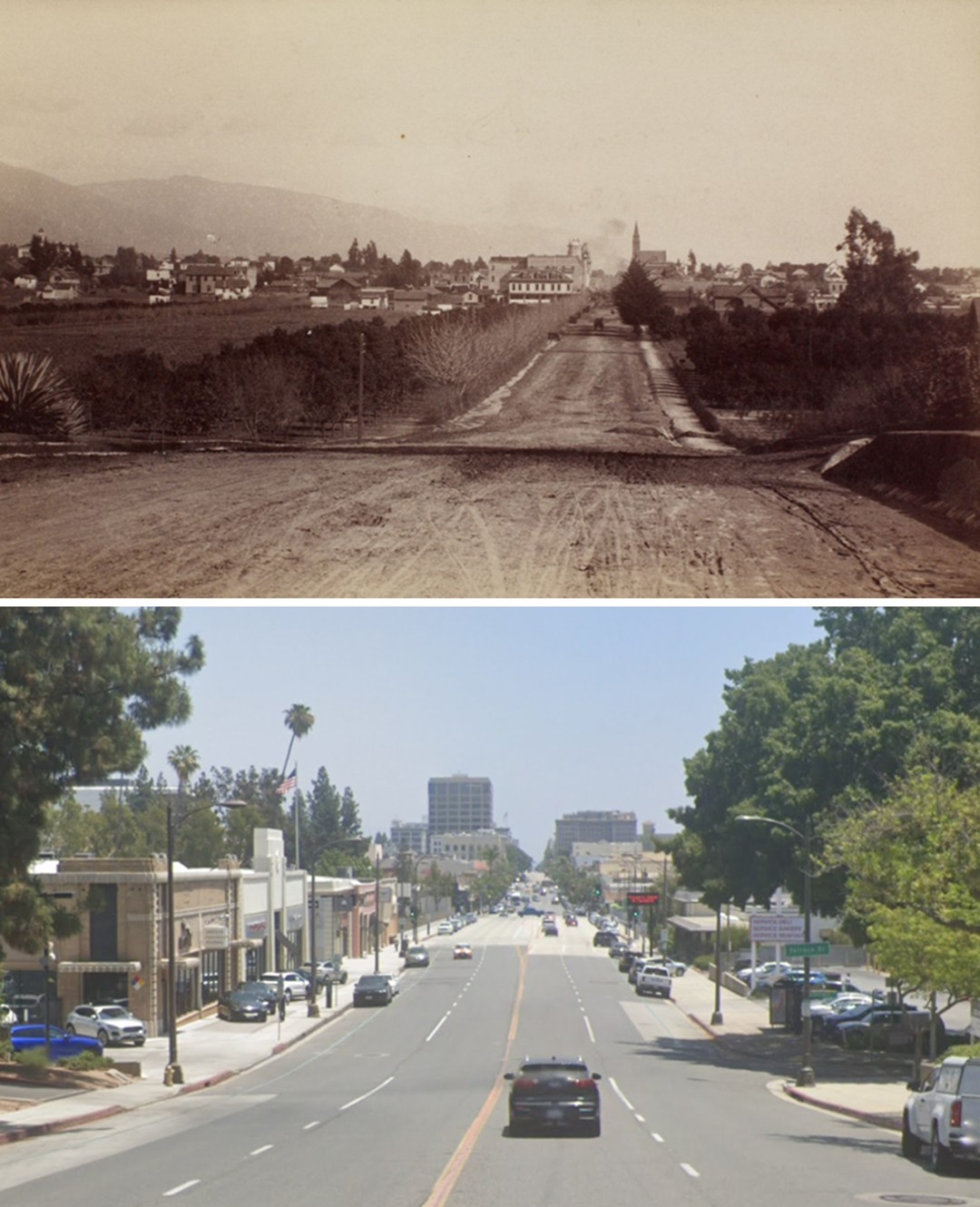 |
|
| (1890 vs. 2022)* –A ‘Then and Now’ view looking east along Colorado Street (now Colorado Boulevard) as it descends Conger Hill. Out of view and behind the camera are landmarks like the Norton Simon Museum, Elks Lodge, and Wells Fargo Building, while ahead lies the route of the world-famous Tournament of Roses Parade. Photo comparison by Jack Feldman. |
Historical Notes The 1890 view shows Colorado Street as a dirt road lined with orchards, just beginning to transition into Pasadena’s commercial heart. Over the decades, it was widened (most notably in 1929), modernized, and renamed Colorado Boulevard in 1958. By 1926, it had become part of Route 66, connecting Pasadena to a national highway system. Today, the boulevard serves as the focal point of the annual Tournament of Roses Parade, symbolizing the city’s growth from a rural colony to a well-known cultural destination. |
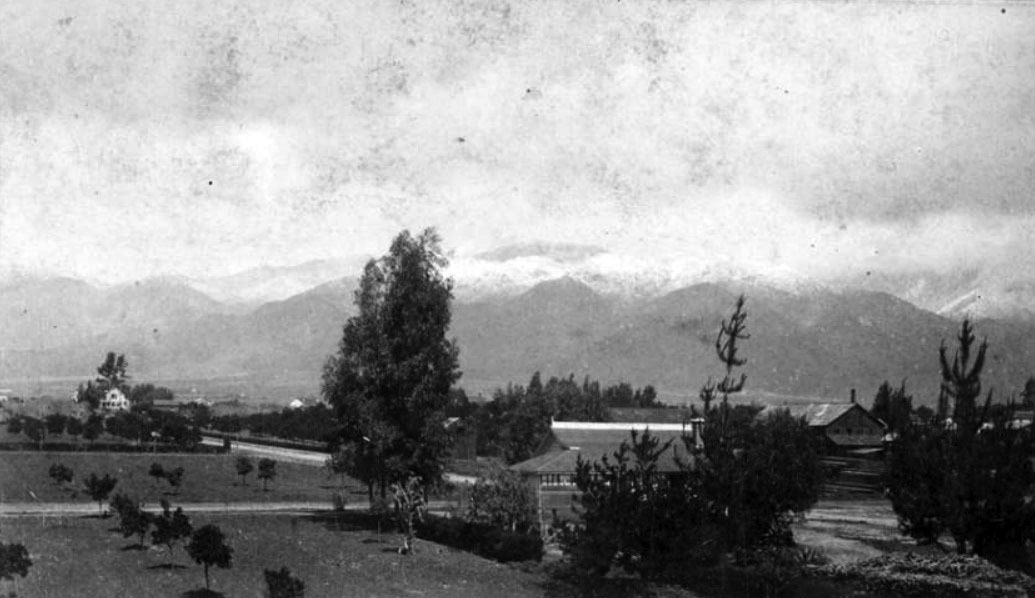 |
|
| (ca. 1880s)* – Early winter view of Colorado Street, now Colorado Boulevard, looking north. The San Gabriel Mountain range with snow and clouds is in the background. |
Historical Notes In this winter view of the 1880s, Colorado Street is still a lightly developed road with orchards and open fields, set against the snowy San Gabriel Mountains. Such views were often used to promote Pasadena’s climate and scenery to winter tourists from the East. Within a generation, this once-rural street would become Colorado Boulevard, a major artery and the world-famous route of the Tournament of Roses Parade. |
 |
|
| (ca. 1880s)* - Landscape view of Pasadena showing groves of trees and other crops in the foreground, and buildings and houses in the town. |
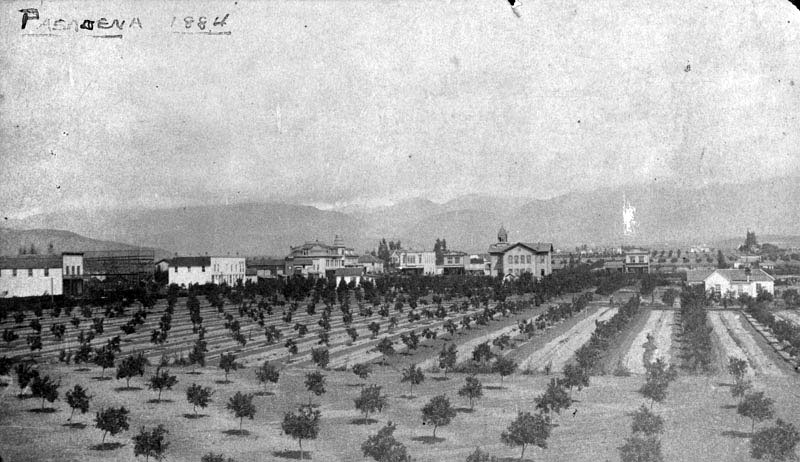 |
|
| (1884)* - View of Pasadena looking north with orchards in the foreground. |
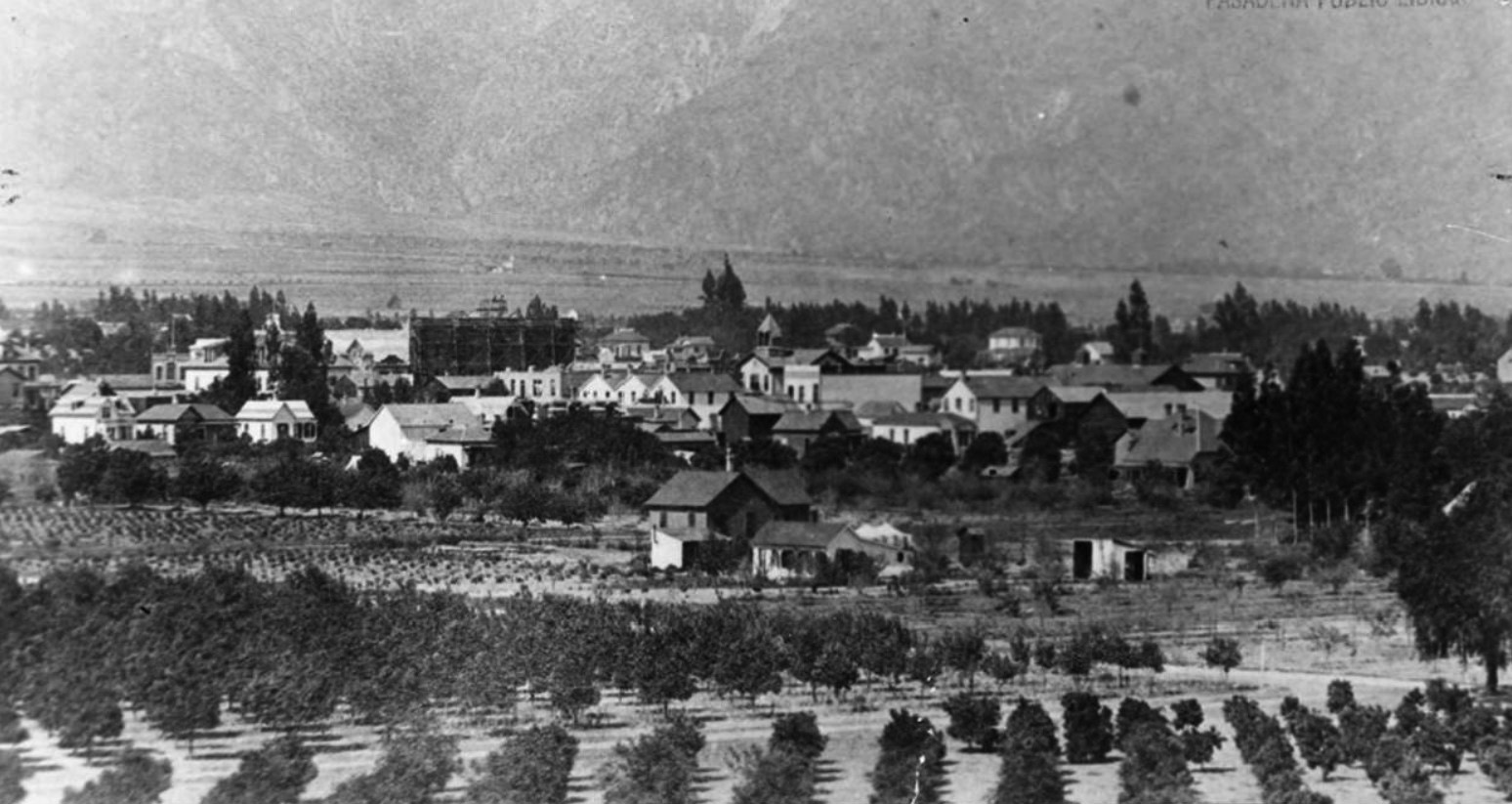 |
|
| (1885)* - Panoramic view looking northeast from Valley and Pasadena Avenue. |
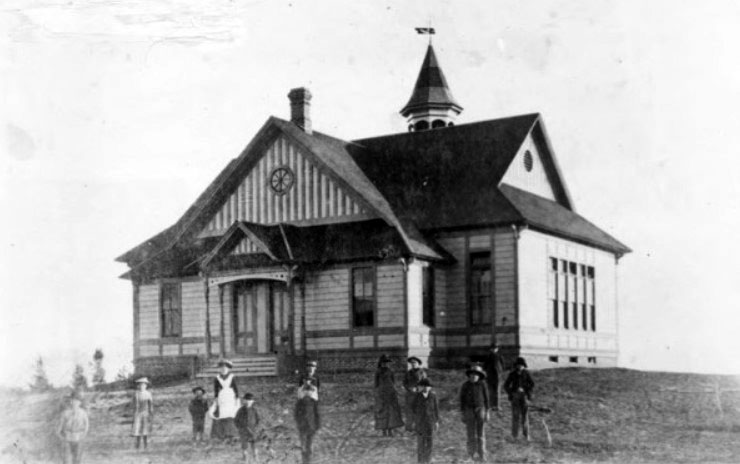 |
|
| (1884)** - View of a young woman and school children in front of building on a rise of land in early Pasadena. |
Historical Notes The story and a half gabled frame building with cupola was built in 1884 as a school on Columbia Hill between South Orange Grove and Grand. The building was given in 1885 to Sierra Madre College. The college failed after two years and became a private residence. After Pasadena was formally incorporated in 1886 this building was outside the city limits in South Pasadena. |
* * * * * |
Munger & Griffith Hardware Store
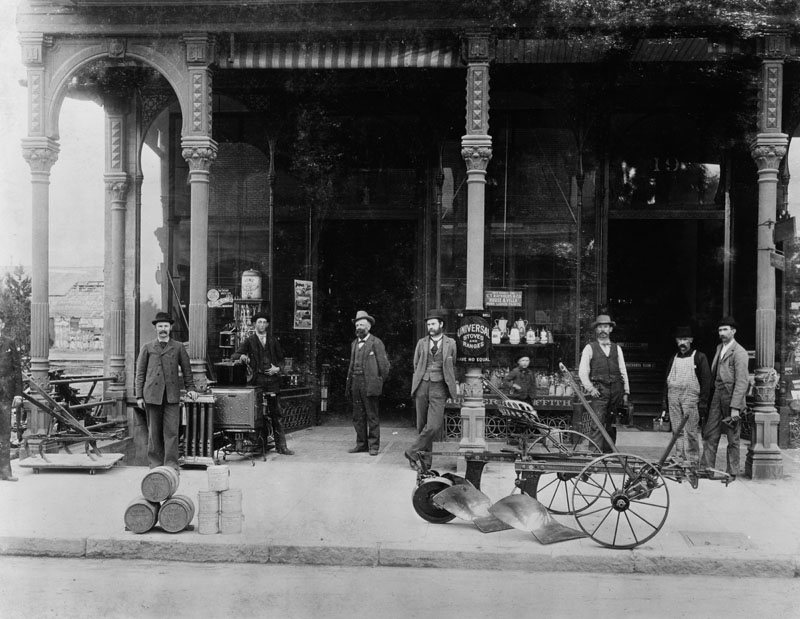 |
|
| (1885)* - A group of men and a young boy pose for the camera outside the ornately detailed Munger & Griffith Hardware store at 19 East Colorado Street in Pasadena. Agricultural implements, wood stoves, and barrels are displayed on the sidewalk, reflecting the store’s essential role in supplying early Pasadena’s residents and farmers. Although addresses and tenants have changed over time, the location remains a vital corner of Pasadena’s commercial life — just as it was when this photo was taken nearly 140 years ago. |
Historical Notes The Munger & Griffith Hardware store was one of Pasadena’s most prominent early businesses. Co-founded by Frank Munger and George W. Griffith in the 1880s, the store catered to the fast-growing community’s demand for tools, construction supplies, stoves, and farm equipment. Pasadena was rapidly transitioning from an agricultural settlement into a suburban boomtown, and stores like Munger & Griffith played a vital role in that transformation. In this 1885 image, the storefront at 19 East Colorado Street showcases ornate Victorian cast-iron columns, a striped awning, and an open façade filled with merchandise. The storefront’s elegance and variety highlight the ambition of Pasadena’s commercial core just east of the intersection with Fair Oaks Avenue. Address Confusion Explained Over the years, the address associated with Munger & Griffith shifted multiple times in historical records: The 1888 Pasadena city directory lists the business at 20 South Fair Oaks Avenue. The 1893–1894 directory places it at 21 West Colorado Street. The photo itself shows the number “19” above the doorway, tying this location to East Colorado as of 1885. These variations are likely due to: Early address renumbering and realignment as Pasadena’s street grid evolved. The business possibly relocating within the same block or to nearby parcels. Changes in corner lot designation and orientation, especially near the prominent Fair Oaks & Colorado intersection. |
* * * * * |
Los Angeles House Hotel (Pasadena)
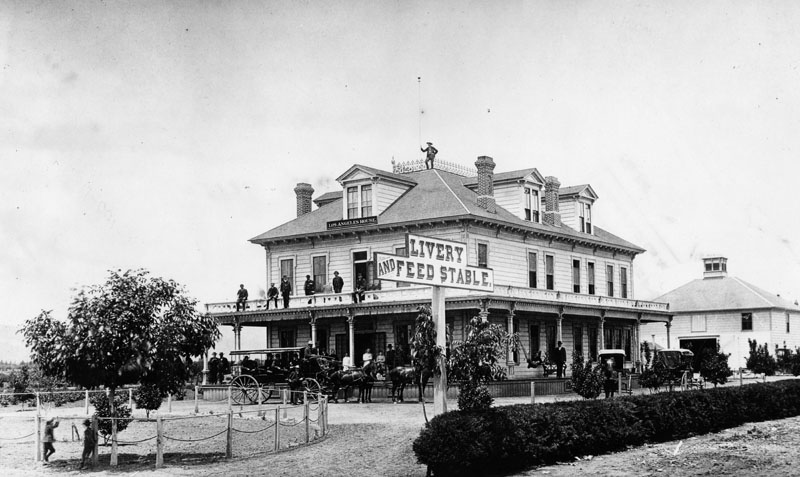 |
|
| (1885)* - View of the Los Angeles House Hotel located on the northwest corner of Colorado and Fair Oaks. A horse-drawn carriage is stopped at the hotel, and several guests are standing on the porch and balcony. Note a man standing at the top of the hotel next to the flag pole. A large sign reads, "Livery and Feed Stable." |
Historical Notes The Los Angeles House Hotel opened July, 1883 by Isaac Banta on the northwest corner of Colorado & Fair Oaks Avenue on a 2 1/2 acre lot bought from Ezra Carr. This was Pasadena's first real hotel although Banta had run 2 small houses prior to this on South Marengo. |
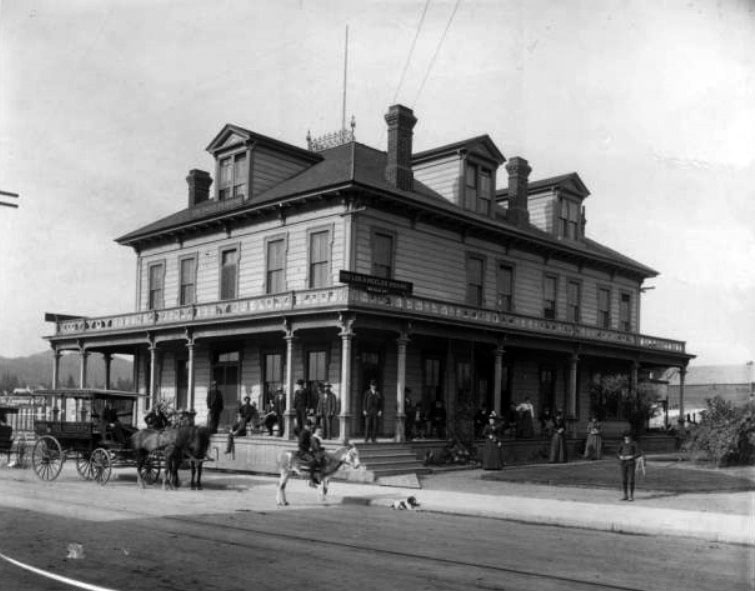 |
|
| (ca. 1886)** - View of the Los Angeles Hotel at its new location on the northwest corner of Colorado and DeLacy. Photo depicts a three story hotel with a crowd of nineteen men, four women two small boys riding a donkey and a black and white dog lying in the gutter. Two horse-drawn carriages are on the lower left. Notice sign -'Meals 25 cents'. |
* * * * * |
The Marion House
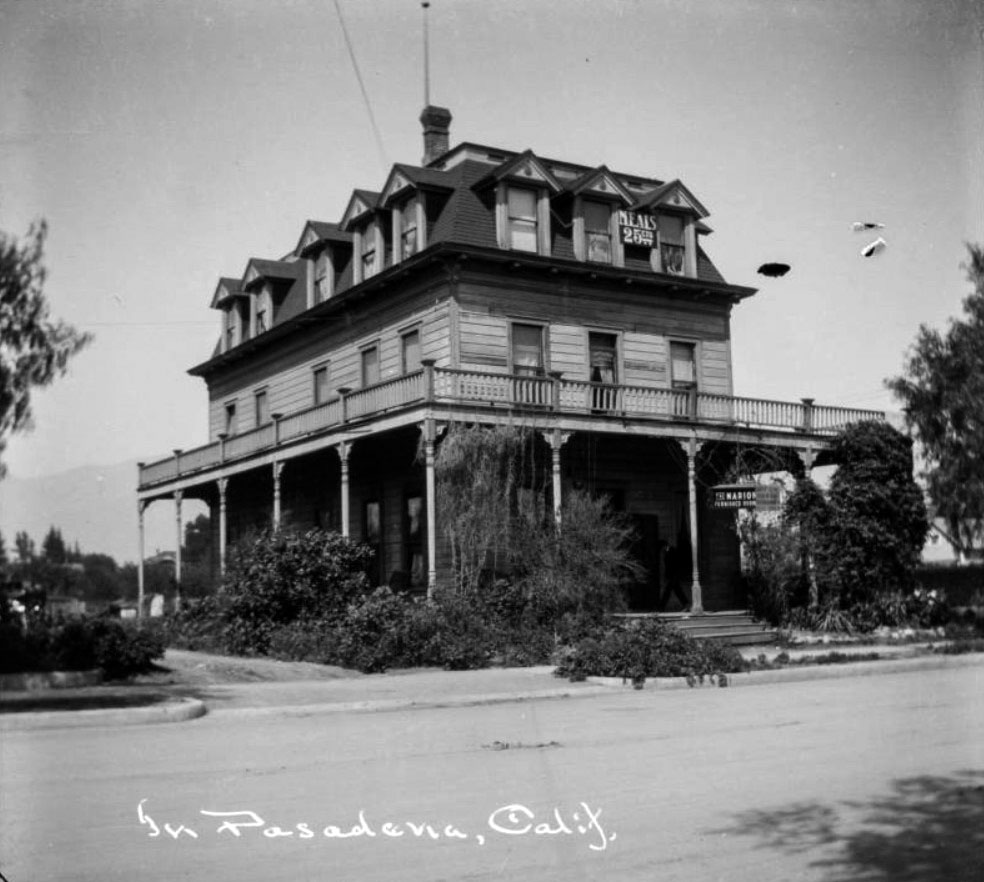 |
|
| (ca. 1890)* - View of a three-story boarding house or hotel with wraparound porch, on a road in Pasadena, California. A sign on the third story reads: "Meals 25 cts." A sign hanging from the front porch reads: "The Marion. Furnished Rooms." |
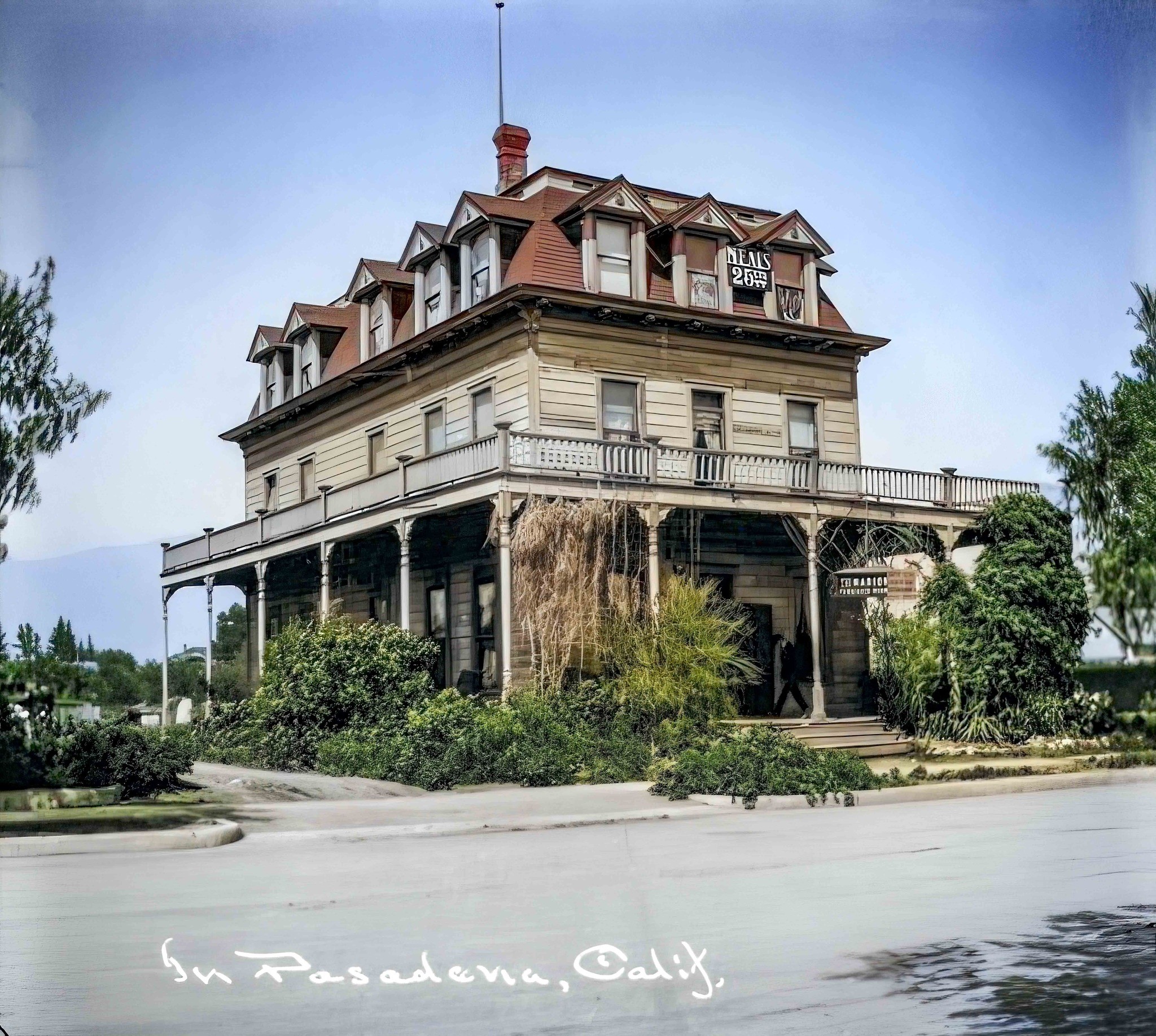 |
|
| (ca. 1890)* - View of a three-story boarding house or hotel with wraparound porch, on a road in Pasadena, California. A sign on the third story reads: "Meals 25 cts." A sign hanging from the front porch reads: "The Marion. Furnished Rooms." Photo by George Washington Hazard; Image enhancement and colorization by Richard Holoff. |
* * * * * |
Pasadena's First Brick Block
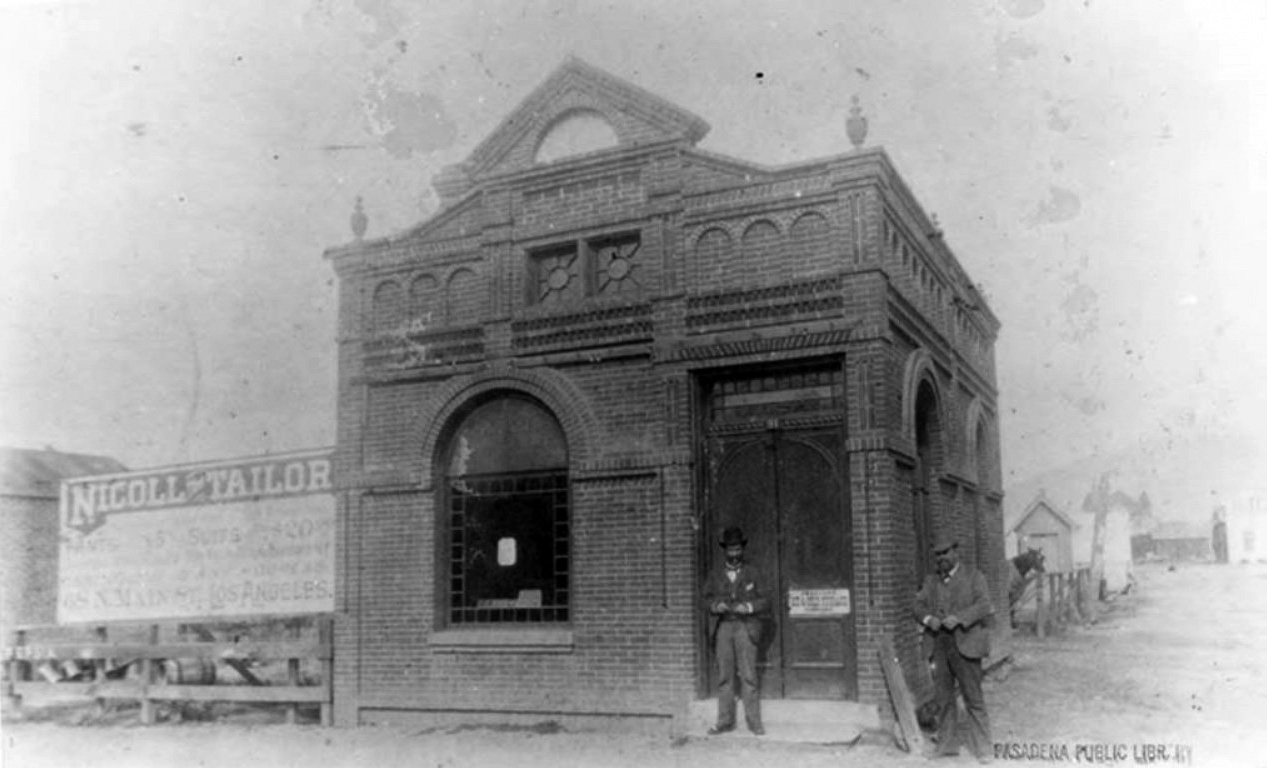 |
|
| (ca. 1885)* - View showing two men standing in front of the Brown & Blattenburg real estate office, 91 E. Colorado. It was part of first brick business block built by John W. Wood. |
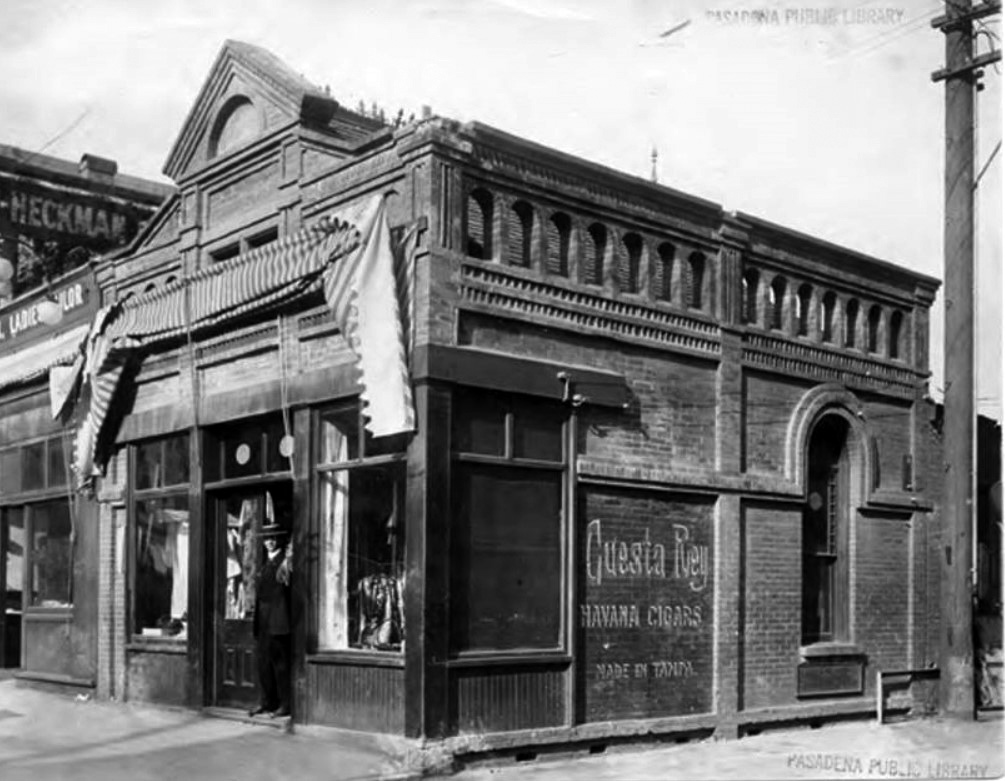 |
|
| (n.d.)* - View showing a man standing in the doorway of the brick building at 91 E. Colorado. Writing on side of building reads: Cuesta Rey - Havana Cigars. |
* * * * * |
School Property Auction
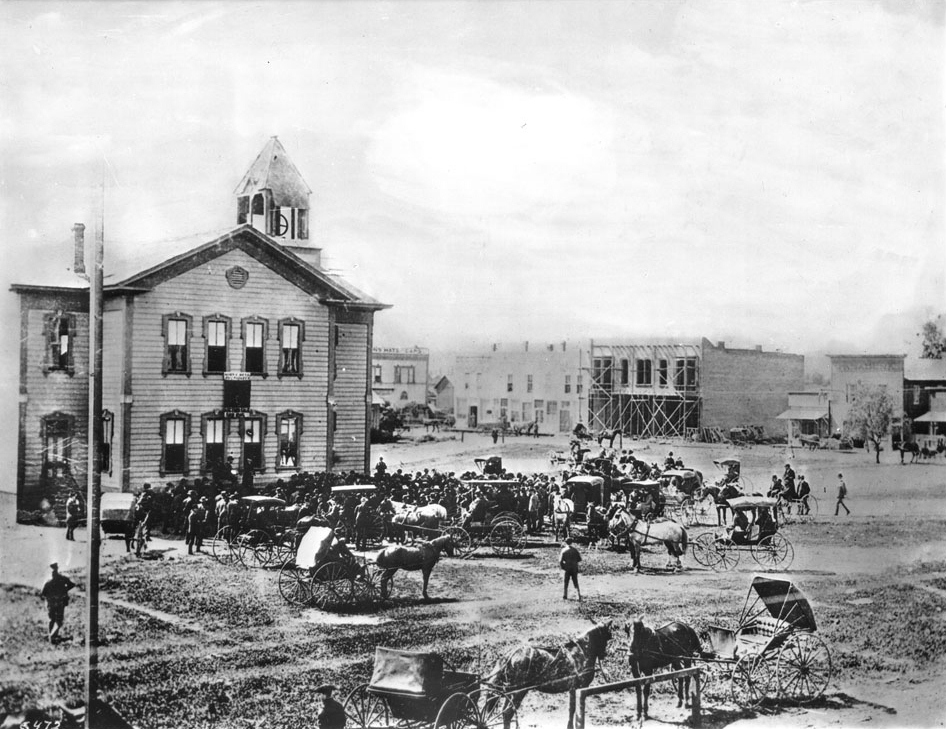 |
|
| (1886)* - View of the school property auction (5 acres) in front of Pasadena’s first school building (Central School) near the corner of Colorado Street and Fair Oaks Avenue. A large crowd of people standing behind a number of horse-and-buggies gather at bottom of the two-story schoolhouse, which sports a bell tower and clapboard veneer. In the foreground, two horses attached to still more buggies are tied to a hitching post, facing one another. |
Historical Notes The historic schoolhouse auction took place on March 12, 1886. In total, 35 lots from the school property were sold for almost $45,000. This set off a building boom on the south side of Colorado Street and on South Raymond Avenue. |
* * * * * |
First National Bank
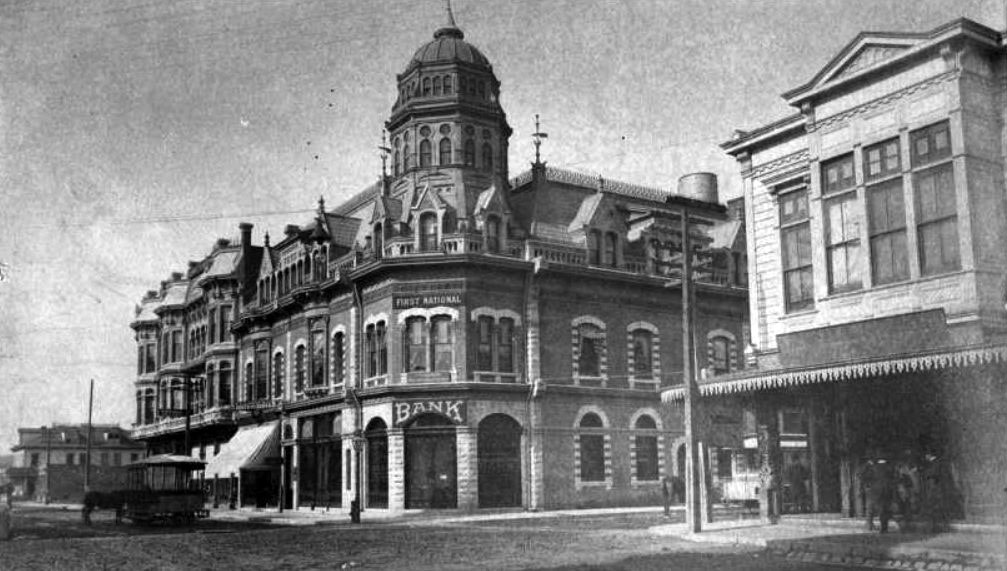 |
|
| (ca. 1886)** - View of the First National Bank located on the northwest corner of Colorado at Fair Oaks. Barney Williams Store is located on the northeast corner. On the left, it appears a horse is taking a break from pulling a trolley. |
Historical Notes In 1886, First National Bank opened at the northwest corner of Colorado Street and Fair Oaks Avenue, on the former site of the Los Angeles House Hotel. The building, designed by Harry Ridgway, was a three-story, brick building with a round two-story tower topped by a flagpole and it was the tallest building in downtown. It had Romanesque arches, Italianate window hoods, and Gothic dormers. |
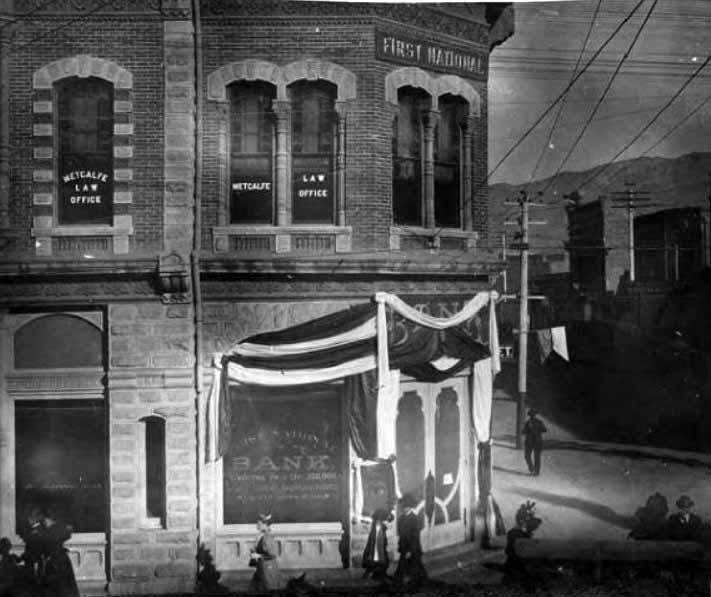 |
|
| (ca 1880s)** - Close-up view showing the front entrance to the First National Bank on the northwest corner of Colorado and Fair Oaks. The Metcalfe Law Office is on the second floor. |
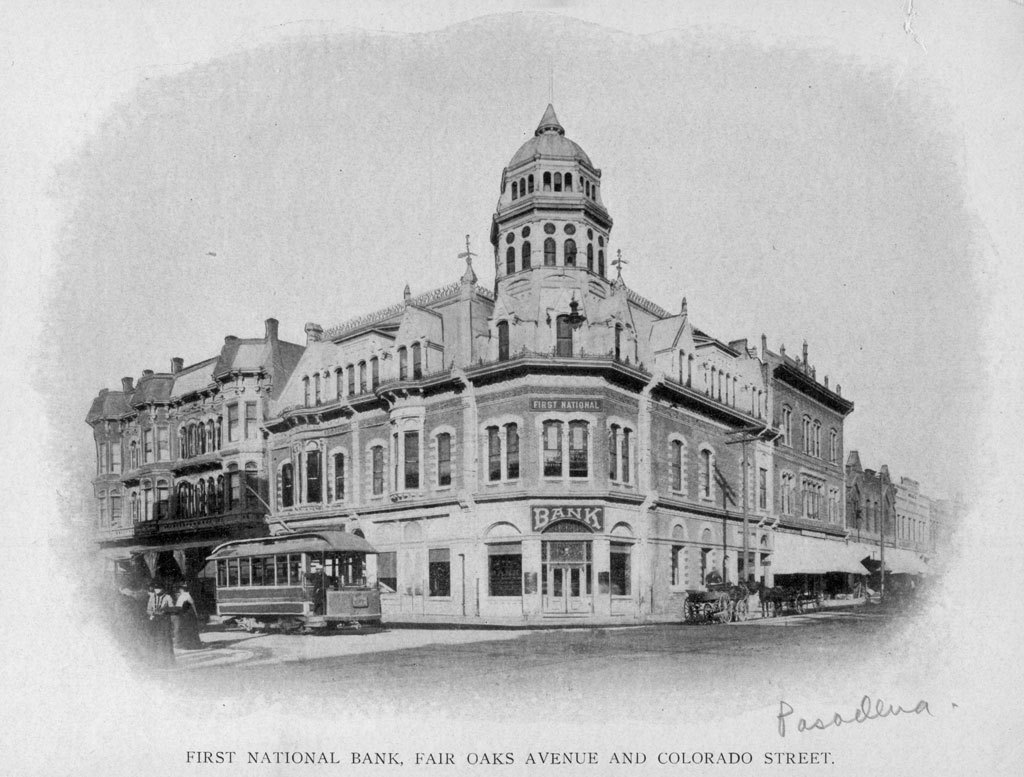 |
|
| (ca. 1890s)* - View of First National Bank on the northwest corner of Fair Oaks and Colorado Street. Electric trolley is seen on the left. |
* * * * * |
Frost Block
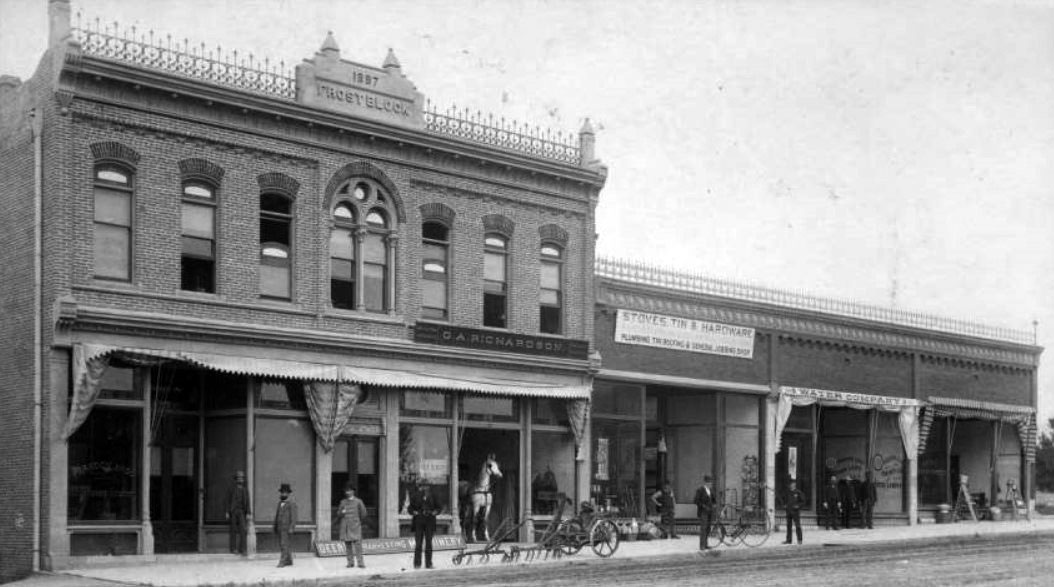 |
|
| (ca. 1887)** - Panoramic view of the Frost Block, located on East Colorado Street. |
Historical Notes The Frost Block on East Colorado Street, built in 1885 and expanded in 1887, was home to a variety of utilitarian businesses such as the carriage shop pictured here. The 1885 Frost Block suffered severe damage in a powerful windstorm shortly after it was built, leading to the necessity of the 1887 expansion. |
* * * * * |
Pasadena Presbyterian Church
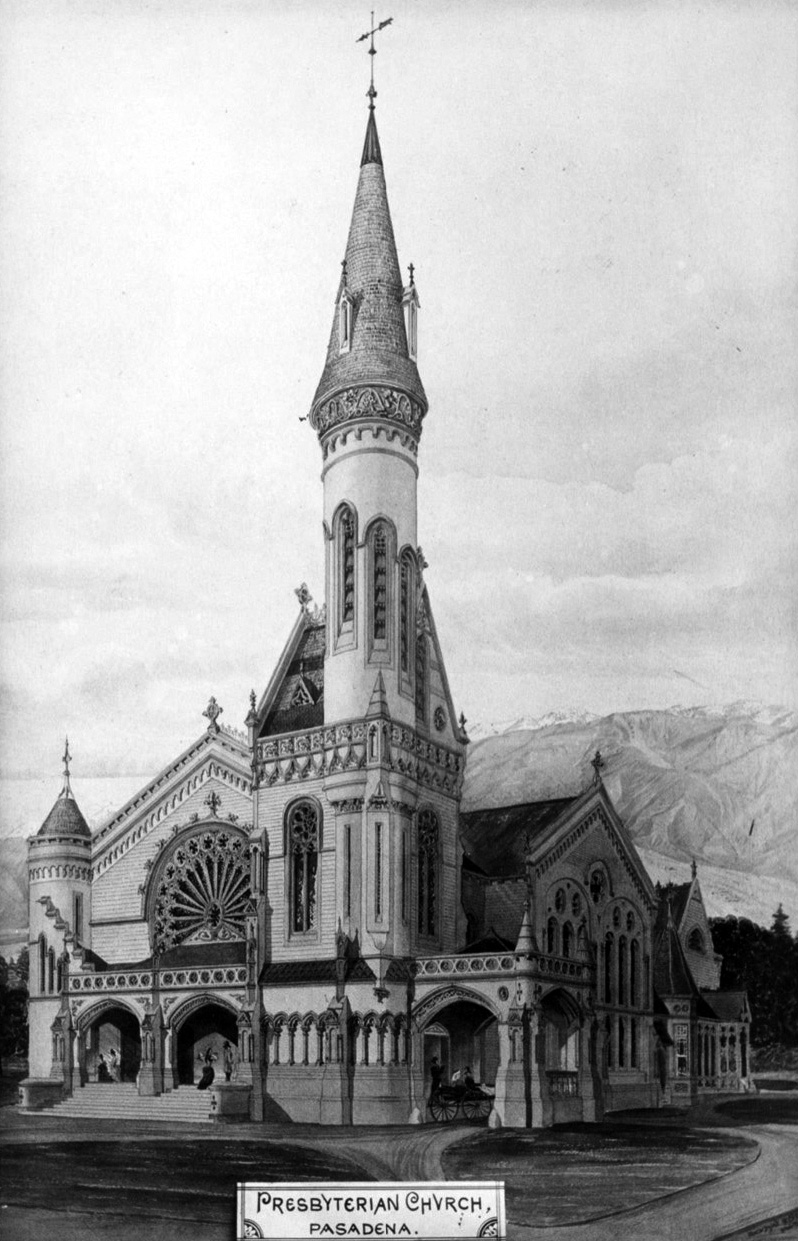 |
|
| (1886)* - Sketch showing the Presbyterian Church in Pasadena with the San Gabriel Mountains in the background. |
Historical Notes The Methodists and Presbyterians claimed the largest congregations in Pasadena and so it was fitting that they had the biggest churches on Colorado Street. Before moving further east the Presbyterians first built a church on this site in 1876, which was replaced by a more impressive structure in 1886 (seen above). |
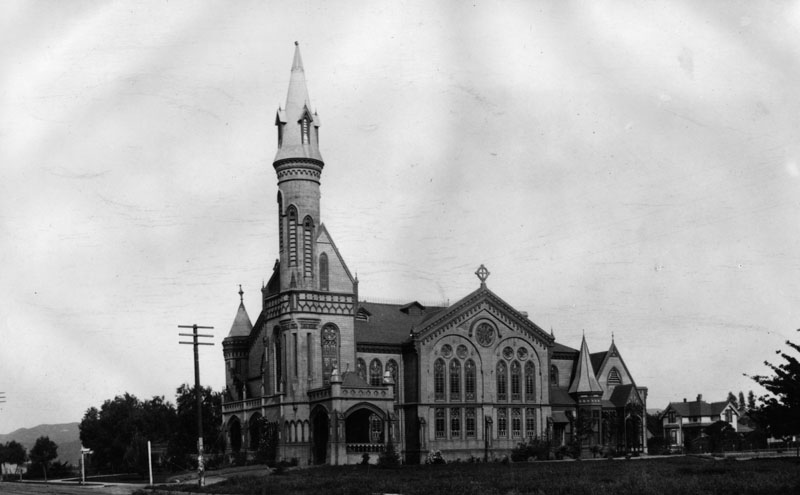 |
|
| (1886)* - View of the Presbyterian Church in Pasadena, located on the northwest corner of Colorado Street and Garfield Avenue. Note the architectural design on the building, especially its beautifal tower. |
Historical Notes By 1910, Pasadena would have more than 50 churches. |
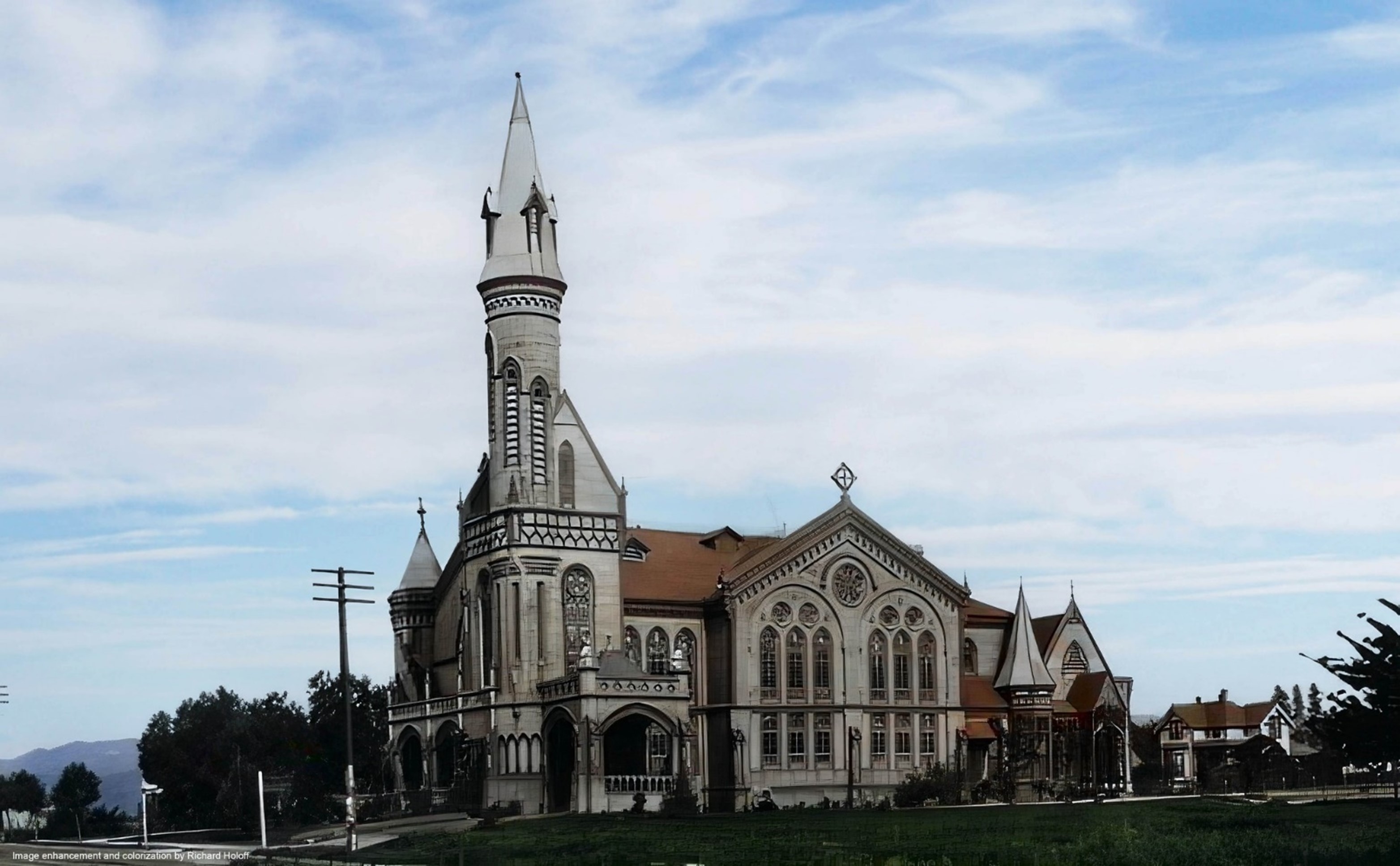 |
|
| (1886)* - View of the Presbyterian Church in Pasadena, located on the northwest corner of Colorado Street and Garfield Avenue. Note the architectural design on the building, especially its beautifal tower. Image enhancement and colorization by Richard Holoff. |
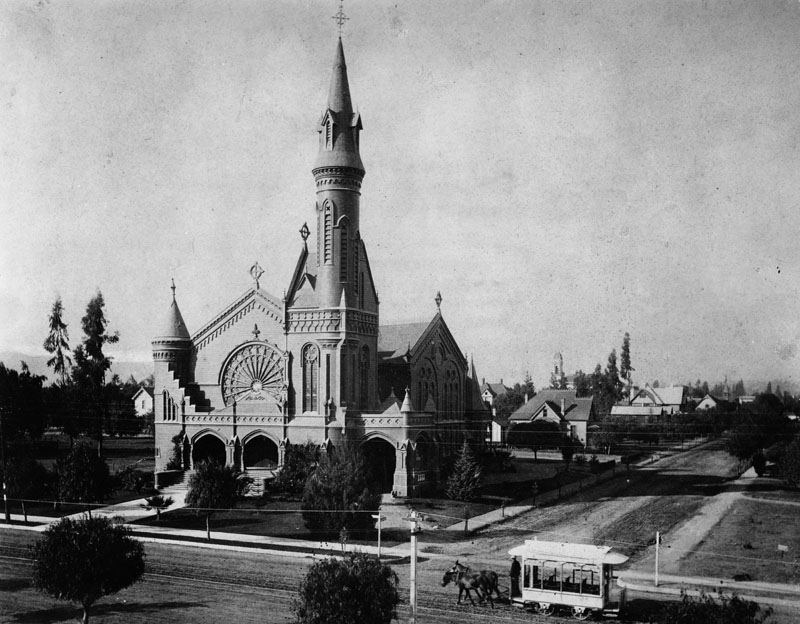 |
|
| (ca. 1880s)* - Exterior view of the Pasadena Presbyterian Church showing its impressive circular stained-glass window. A trolley pulled by two horses is seen heading west on Colorado. |
Historical Notes In 1891, a windstorm blew down the ornate and very tall church tower.* |
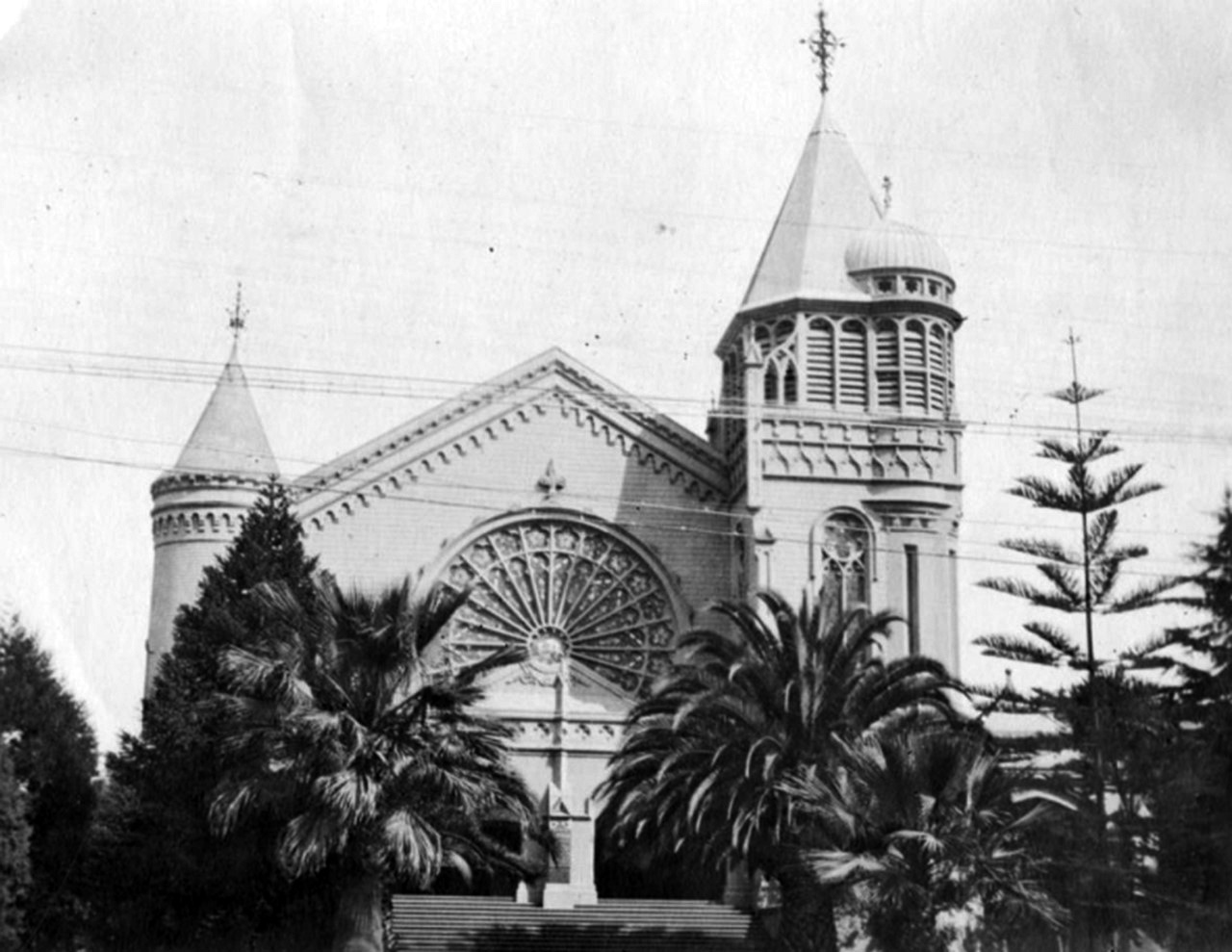 |
|
| (ca. 1900s)* - Pasadena Presbyterian Church with rebuilt tower after original was destroyed by a windstorm in 1891. |
Historical Notes By 1914 a post office replaced the church seen above and encouraged the eastward expansion of the Pasadena shopping and business district. |
* * * * * |
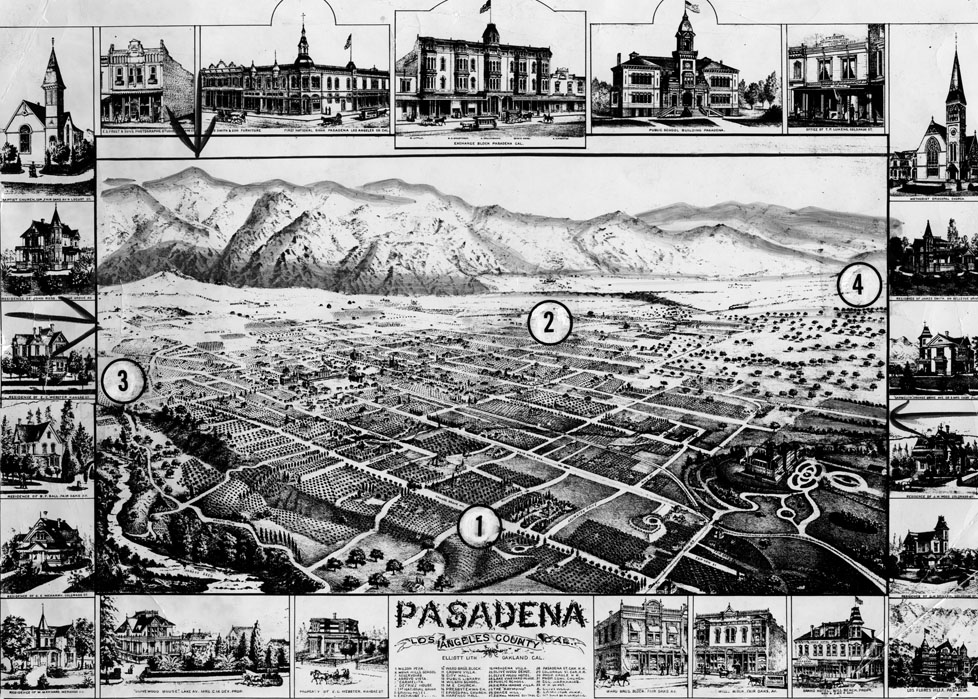 |
|
| (1886)* - A 1886 map of Pasadena, when it was largely a town of orange groves. Drawings of various historical significant buildings surround the map. |
Historical Notes In March 1886, Pasadena became the second incorporated municipality, after the city of Los Angeles, in Los Angeles County. |
* * * * * |
Stetson Residence
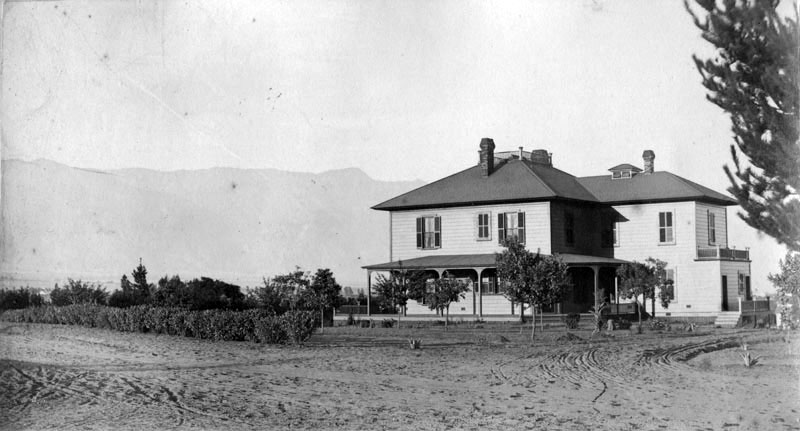 |
|
| (ca. 1886)* - Exterior view of the Stetson residence located at 170 N. Orange Grove Avenue. |
Historical Notes The house was built for the Channing family of Boston circa 1886. Their daughter, Grace, married William Stetson, famous painter, and brought up his daughter by his first wife, Charlotte Perkins Stetson (later Gilman). The house is also known as the Channing (William Ellery) house.* |
Carmelita House
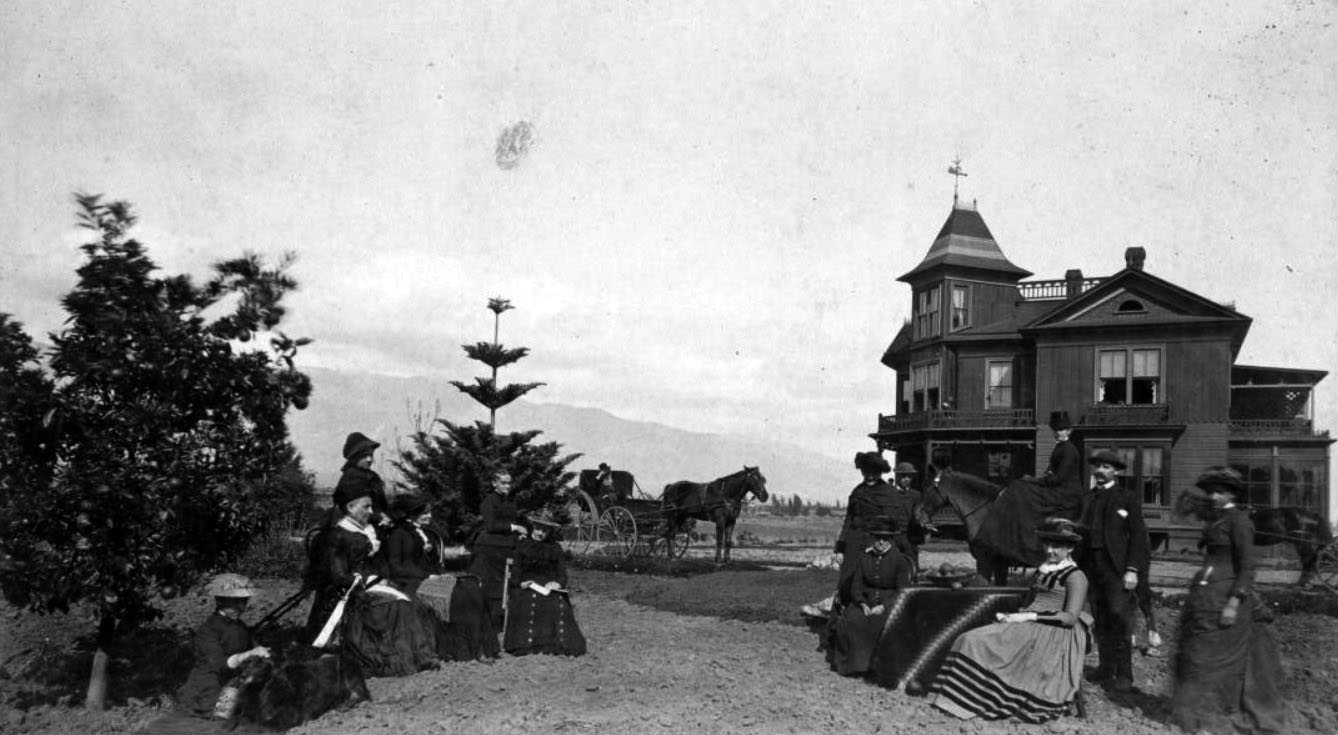 |
|
| (1886)*^* - View showing the Carmelita House with guests on lawn and on horseback posing for the camera. |
Historical Notes Back of Photo reads: "1886 - Built by J.B. Springer; 1937 - now on corner of Maylin and S. Orange Grove; Built over". Also written by hand in ink on reverse is "Grace W. Hodge, 1266 N. Raymond Ave." Grace W. Hodge was the wife of Nathaniel Hodge and the daughter-in-law of Dr. Jacob Sylvester Hodge. (J.S. Hodge family identified in 1894 City Directory, including Nathaniel; Nathaniel and Grace located at 1266 N. Raymond Ave. in 1920 City Directory. Grace listed as widowed in 1930 City Directory.) Dr. Carr and Dr. Hodge possibly knew one another. Based on Mrs. Hodge's writing on the photograph, it is possible some of the people in the photograph are members of the Hodge family.*^* |
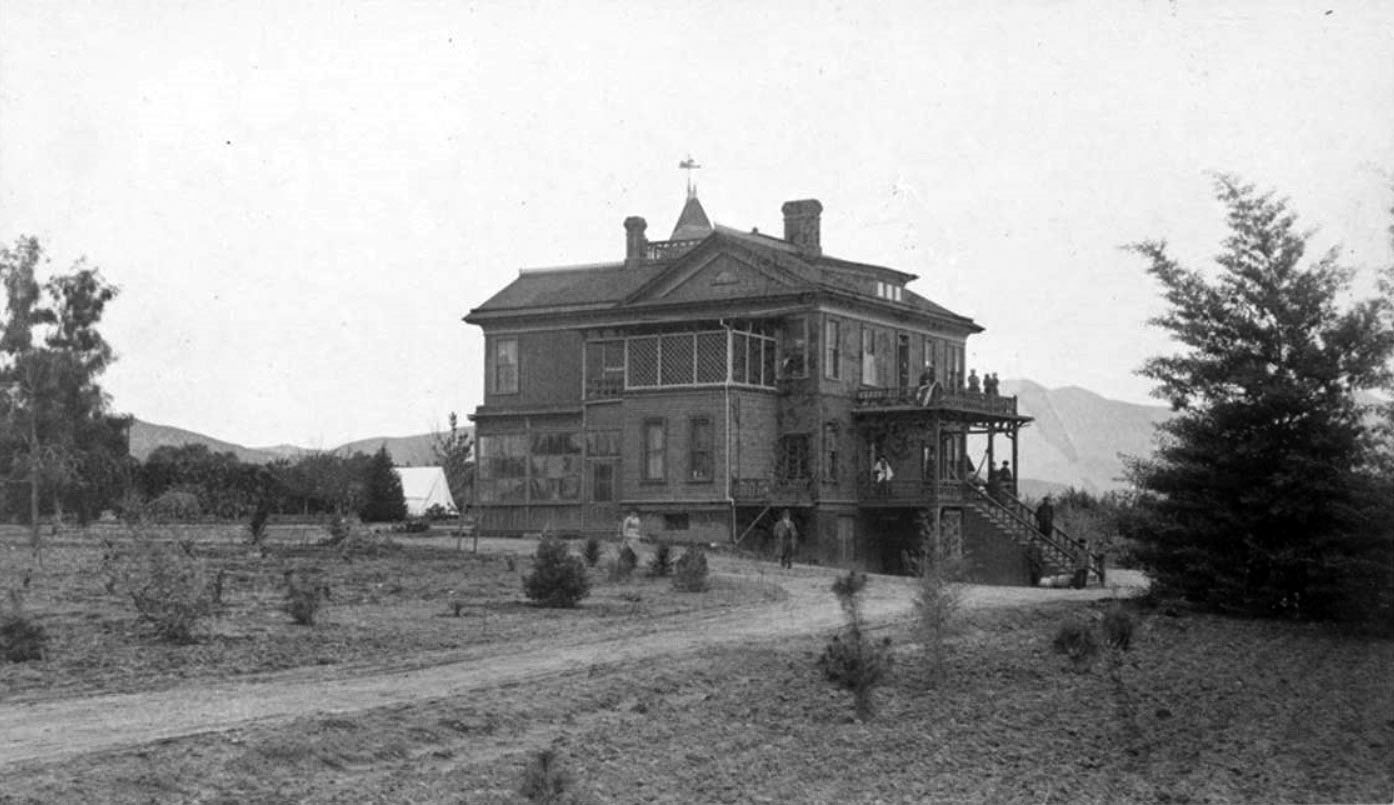 |
|
| (ca. 1886)*^* – Another view of the Carmelita House from a different angle showing several people standing on and around building including on balcony, porch, and stairway. |
Historical Notes According to Pasadena PIO, in an article dated "August 20, 2009", the house was owned by Dr. Ezra S. Carr, who moved to Pasadena in 1880. On the back of the photograph, on the right side, it says "Residence of Carrs. Pasadena. This was built in Carmelita and now stands on S. Orange Grove." *^* |
Sierra Madre Villa Hotel
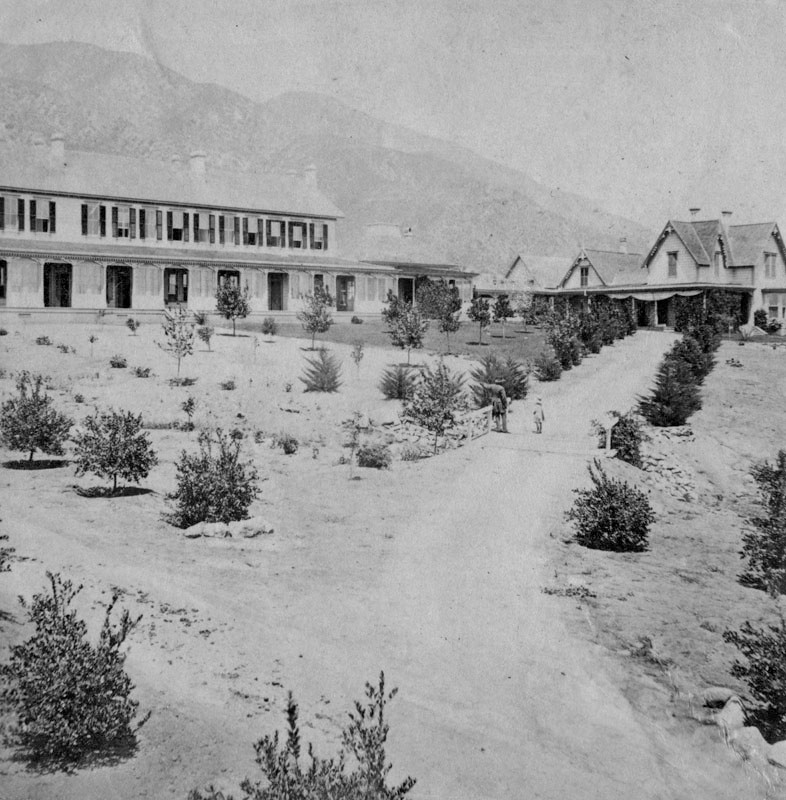 |
|
| (1876)* - View showing a man and child walking on a dirt path toward the Sierra Madre Villa Hotel, the pioneer summer resort of the San Gabriel River Valley. |
Historical Notes The Sierra Madre Villa Hotel got its start in 1876 and is now remembered as southern California’s first famous resort. The hotel building was just above where the Eaton Canyon Golf Course is now and the Villa property stretched all the way down to approximately Foothill. #+ |
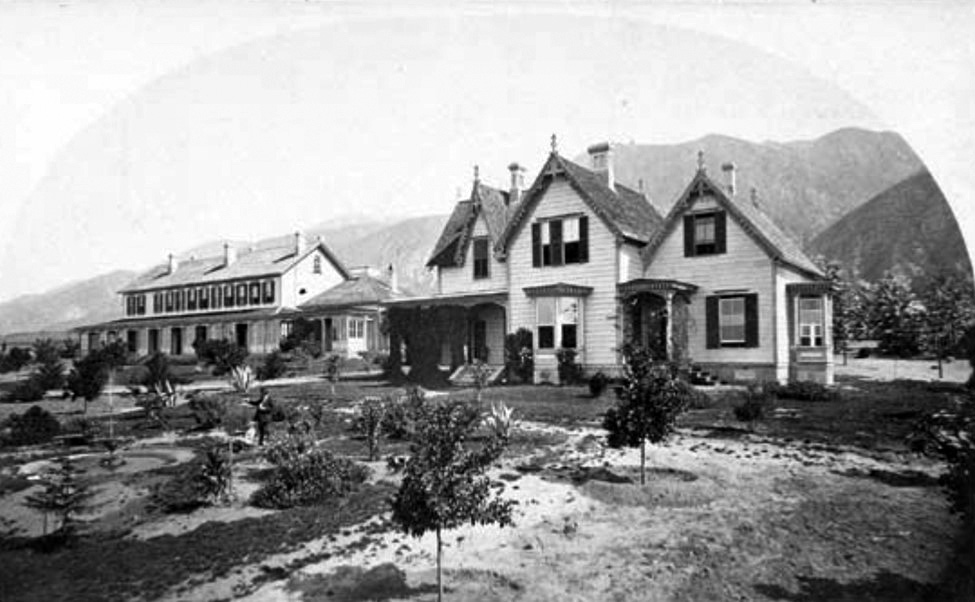 |
|
| (ca. 1878)^## - View showing the Sierra Madre Villa Hotel (left) and the Victorian Cogswell/Rhoades House (right). Note the man standing in front of a fountain in the midst of an orange grove. |
Historical Notes Artist William F. Cogswell was an east Pasadena pioneer and founded the world-renowned Sierra Madre Villa Hotel. He was also a noted portrait artist. The best known of his works is this 1864 portrait of President Abraham Lincoln that is part of the White House Collection. In 1873 he purchased 473 acres of wild mesa land in what is now east Pasadena. In its natural state, this land was said to be covered with greasewood so thick a jack rabbit couldn't penetrate it. But, the mesa offered unimpeded views that likely captured the artist's eye and imagination. There was the waiting San Gabriel Valley below and an ocean view that took in Catalina Island and steamers making their way to San Pedro. At the suggestion of friends, in 1876, Cogswell and his son-in-law William Porter Rhoades founded the Sierra Madre Villa Hotel on the site. He also built a beautiful Victorian home on the northern edge of the property. For a brief time, the Villa was the premier winter resort west of the Mississippi. #+ |
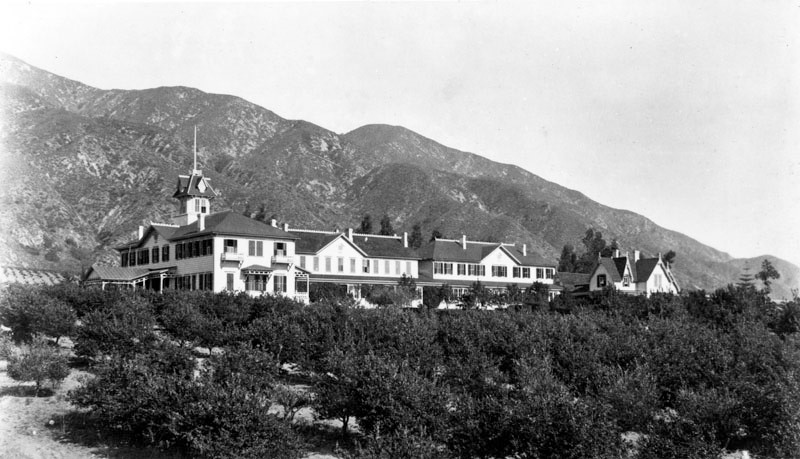 |
|
| (1884)* - View showing the two story Sierra Madre Villa Hotel and Victorian Cogswell/Rhoades House surrounded by vineyards and citrus groves all set against the Sierra Madre/San Gabriel Mountains. |
Historical Notes The northern edge of Cogswell's property roughly bordered present day Fairpoint St. north of the Eaton Canyon Golf Course. The southern tip of his property extended to present day Foothill Blvd. and Sierra Madre Villa Ave. The jagged western edge of the property tracked the Eaton Wash. Cogswell's purchase also included rights to half the water flow over a waterfall located north of present day Pasadena Glen. With the aid of 70 Chinese laborers, Cogswell's land was cleared and planted with citrus trees and grape vines. Water was transported from the water fall downhill by flume or clay pipe to irrigate the land. #+ |
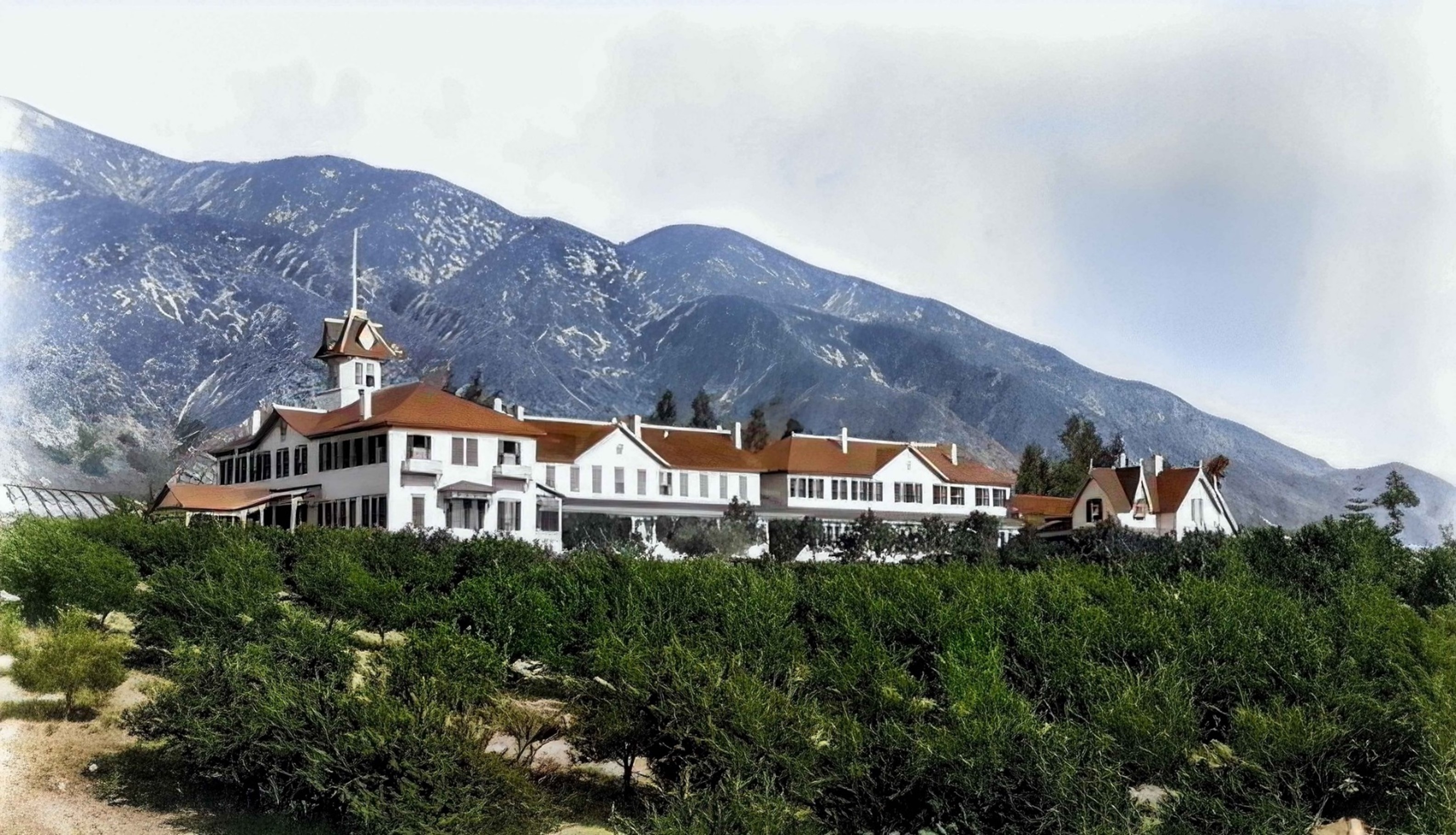 |
|
| (1884)* - View showing the two story Sierra Madre Villa Hotel and Victorian Cogswell/Rhoades House surrounded by vineyards and citrus groves all set against the Sierra Madre/San Gabriel Mountains. Image enhancement and colorization by Richard Holoff. |
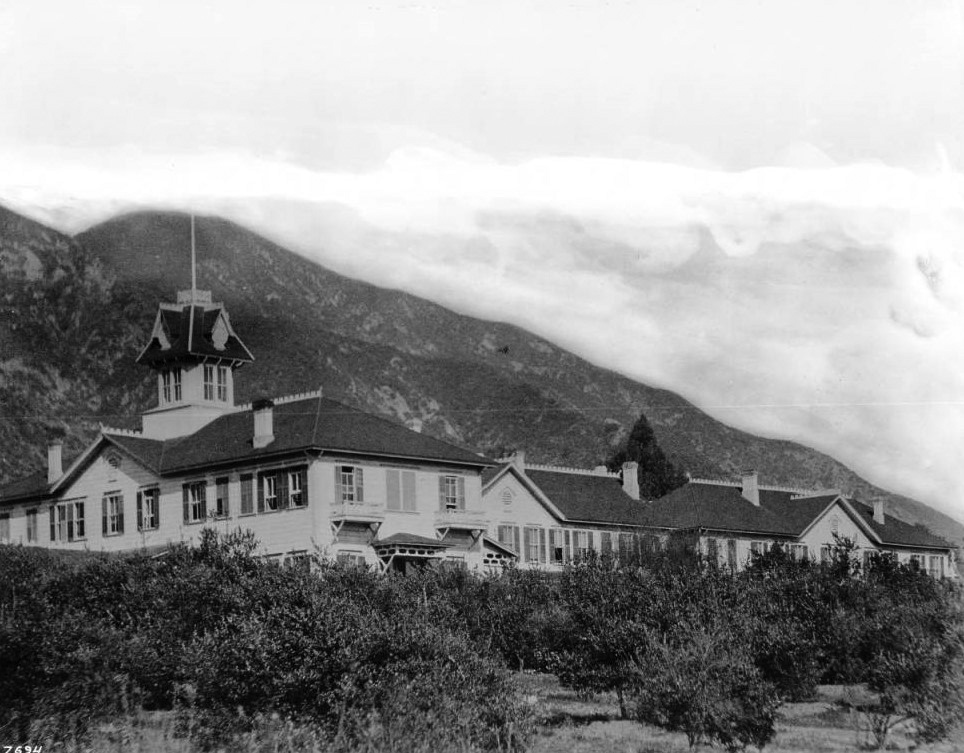 |
|
| (ca. 1890)^ – Close-up view of the Sierra Madre Villa Hotel in Pasadena. The two-story villa is pictured beyond a clump of short orchard trees that stands in the foreground, with the San Gabriel Mountains in the background. |
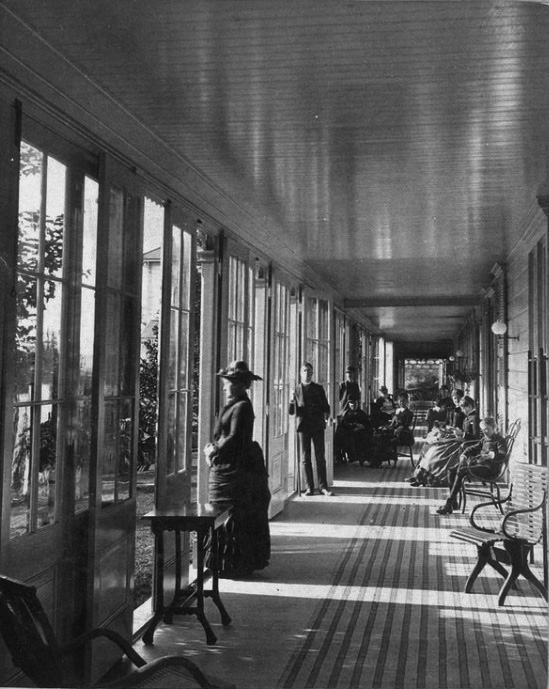 |
|
| (ca. 1890)^ – View showing the veranda of the Sierra Madre Villa Hotel with several guests just lounging around. A woman is seen looking out toward the view which includes orange groves in front of the hotel. |
Historical Notes Villa visitors were treated to fine accommodations (running water in each room) in the middle of a beautiful ranch setting. The Villa maintained its own bee apiaries, stable of horses and small herd of cattle. Then there were the groves: “There is probably no pleasure and health resort in either this country or abroad that will compare to the Villa in this respect. The hotel proper is literally surrounded with orchards. To particularize: there are upwards of 5,000 large orange trees…, upwards of 150 lemon trees, … and besides deciduous fruit trees, nut trees and a fine line of ornamental forest trees, shrubs, flowing plants, ect. Not only does the Villa grow all its own fruits, but also all the vegetables, small fruits, nuts, grapes, ect. with which the tables are freshly supplied three times a day.” (Rural Californian 1891) #+ |
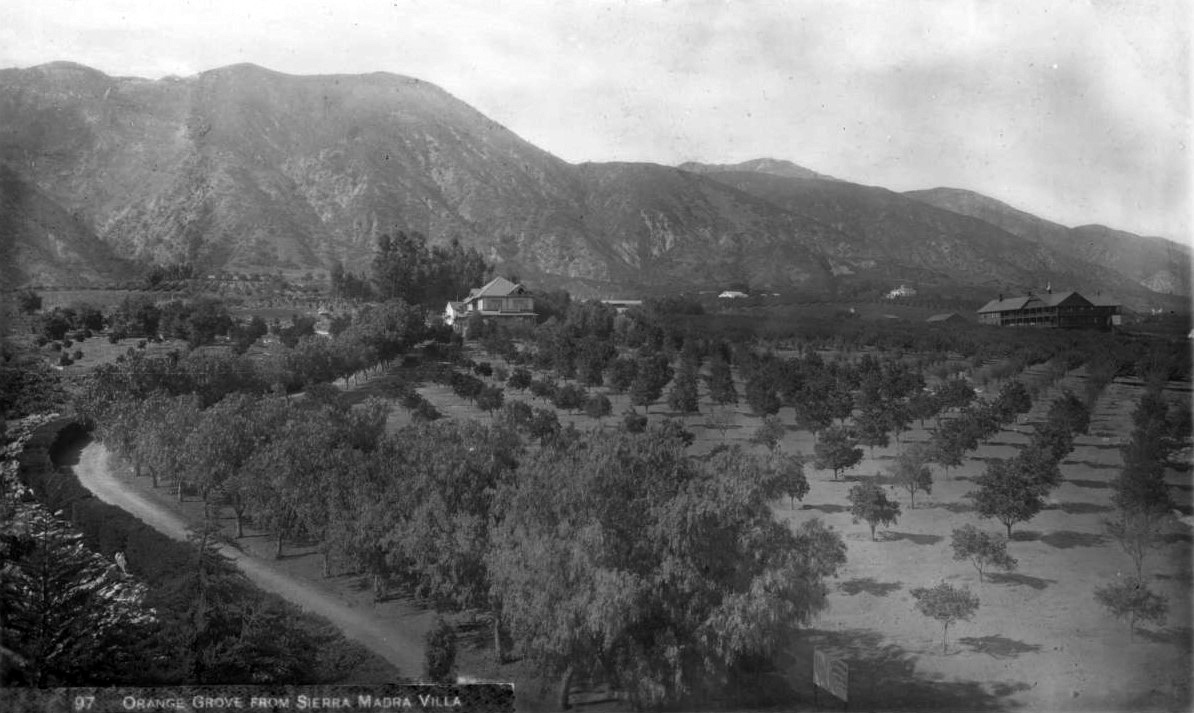 |
|
| (ca. 1890)^ – View showing orange groves in Pasadena as seen from Sierra Madre Villa Hotel with majestic San Gabriel Mountains in the background.. |
Kinneloa – Abbot Kinney Residence
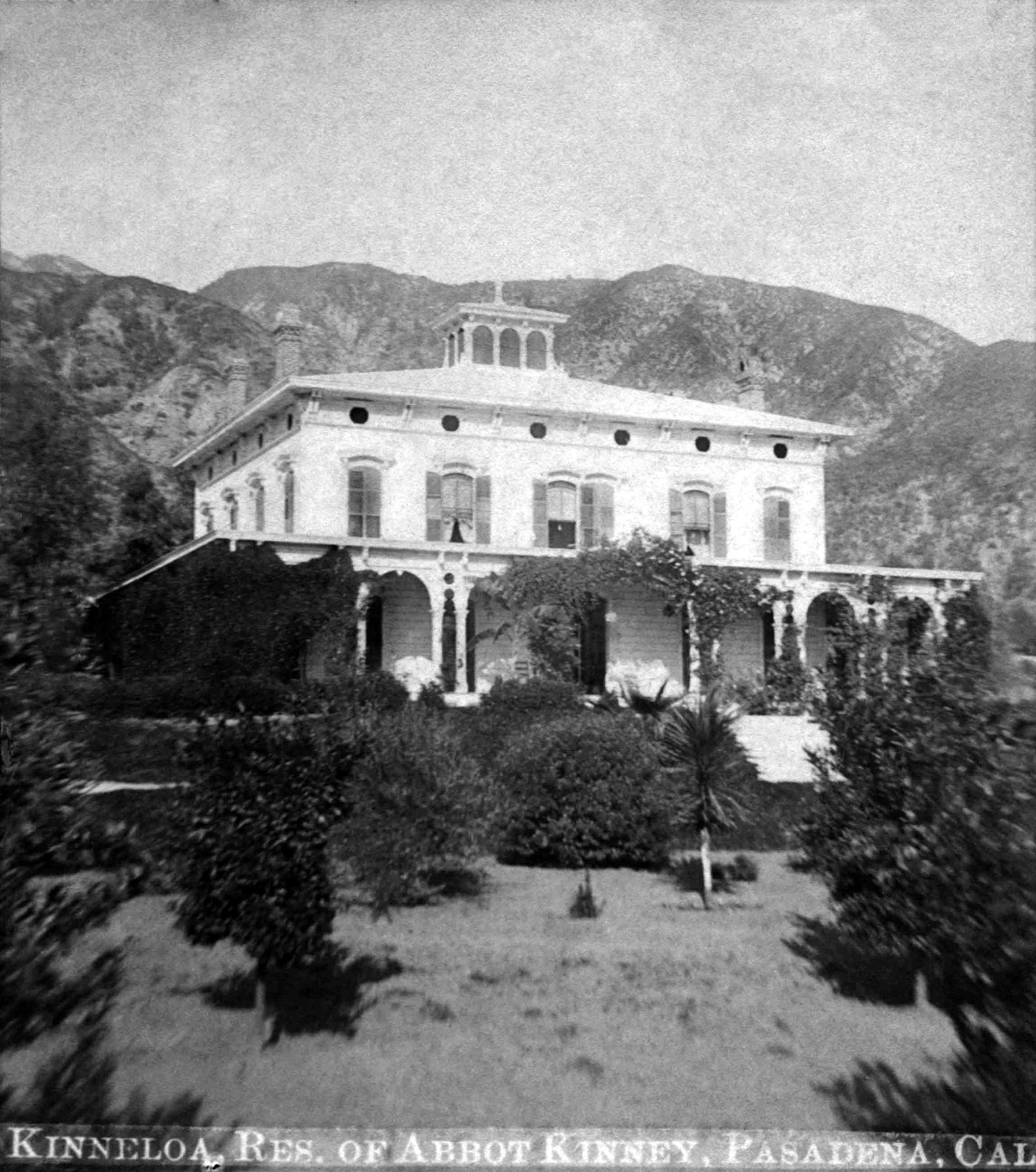 |
|
| (ca. 1883)^.^ – View showing Abbot Kinney’s Italianate residence at his 537-acre ranch, dubbed “Kinneloa”, east of Pasadena. The wood-frame Italianate home with a full wrap-around porch, a center rooftop pergola, unusual circular vent holes below the eaves and just a small portion of the expansive and expensive gardens around the structure, is placed in a picturesque spot at the base of the San Gabriel Mountains. The views from the home were also remarkable spanning the entirety of the valley and coastal plain to the ocean. |
Historical Notes In 1880, Abbot Kinney (tobacco fame and also developer of Venice of America) headed to the Sierra Madre Villa, a resort at the base of the San Gabriel Mountains near Pasadena, only to find there were no vacancies. He was offered a billiard table for the first night and then pitched a tent on the front lawn. Enamored with the valley that, as were so many wealthy easterners, he stayed, quickly purchasing his ranch from a beekeeper (apiaries were popular during the era.) By 1883, the name “Kinneloa,” said to be a combination of his surname and “loa,” the Hawaiian word for “mountain”, was being used for his ranch, which was lauded as a showpiece for its gardens, agriculture and the Kinney residence. The above photograph of Kinney’s residence was taken by Thomas G. Norton, a Pasadena photographer who died in 1885. So, we know that the date was in the first half of the decade, probably about the time that the name “Kinneloa” shows up in newspapers, circa 1883.^ |
Early Orange Packing House
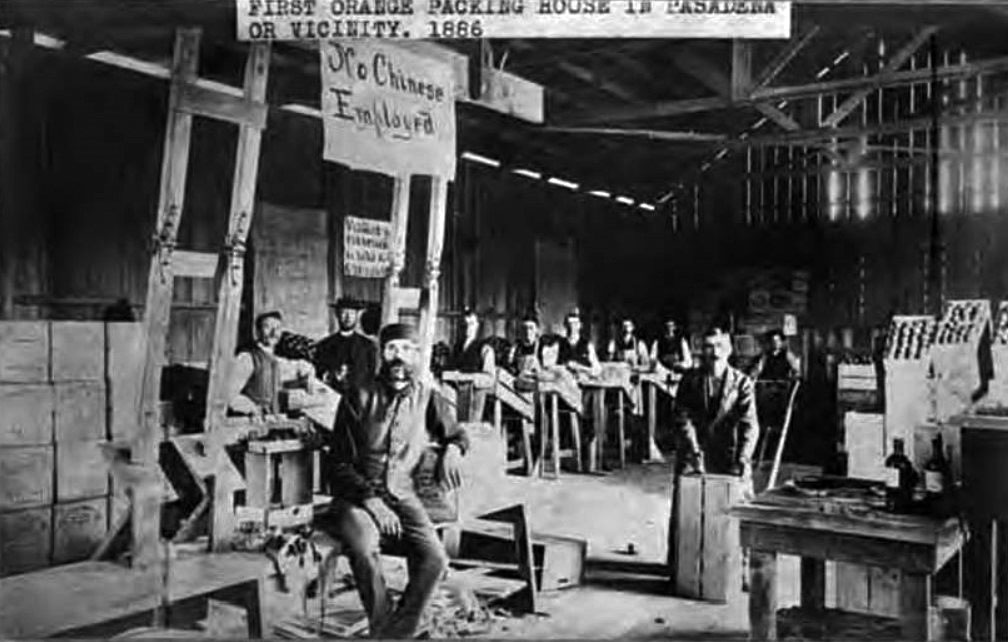 |
|
| (1886)*^* - View showing the Frank H. Heydenreich's Orange Packing House (First in Pasadena). A sign reads, 'No Chinese Employed. |
Historical Notes Many field workers were Chinese, but they were not welcome in the central city. Although the city was born in 1886, Pasadena as a community traces its origins to the 1875 founding of the San Gabriel Orange Grove Association, an agricultural cooperative carved out of Rancho San Pasqual. The colony of Indiana orange growers thrived, and its success fostered the growth of the settlement. |
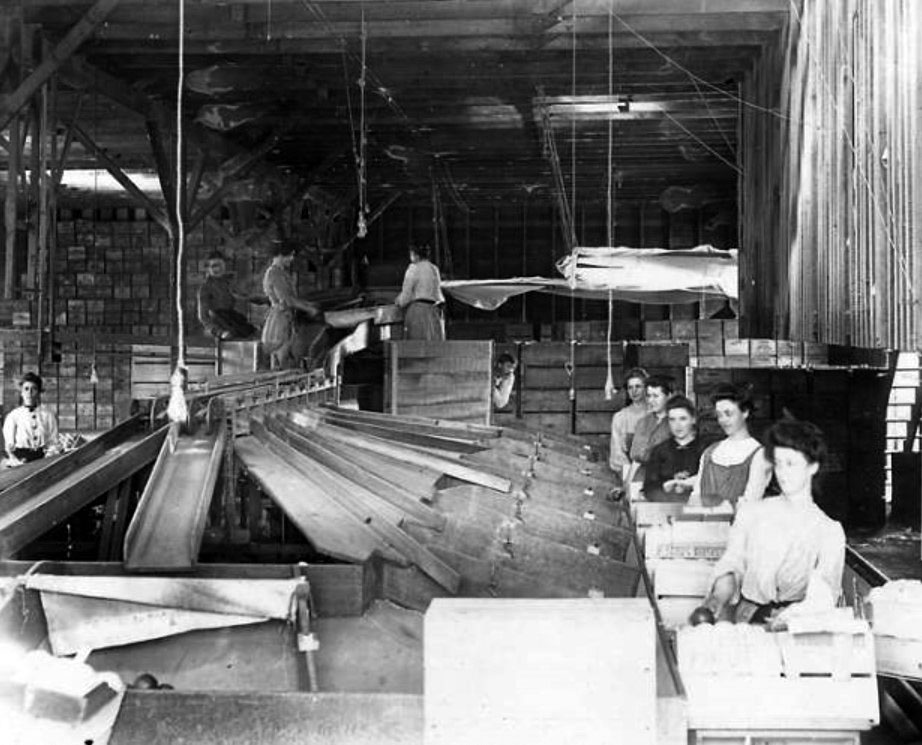 |
|
| (n.d.)*^* - View showing workers crating oranges in a Pasadena packing plant. |
Raymond Hotel
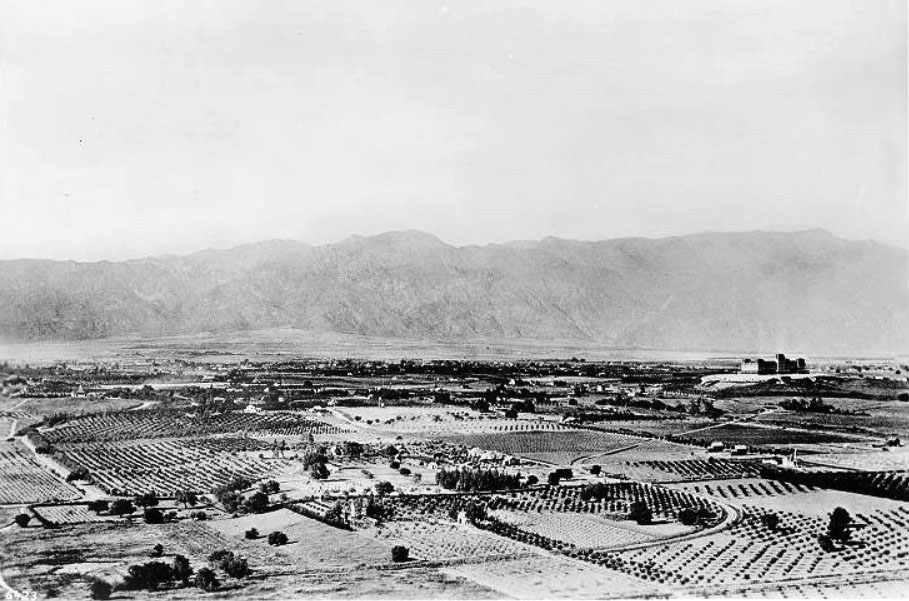 |
|
| (1886)#* - Panoramic view, looking north from South Pasadena, showing orange groves and residences. The Raymond Hotel sits on top of Bacon Hill at right-center with the San Gabriel Mountains seen in the background. |
Historical Notes The Raymond Hotel was the first major resort hotel of the San Gabriel Valley and was only opened from December to April. It was built by Mr. Walter Raymond of Raymond & Whitcomb Travel Agency of Boston, Mass. and sat atop Bacon Hill which lies between Pasadena and South Pasadena. Bacon Hill was renamed Raymond Hill with the opening of the hotel in 1886.* |
 |
|
| (1886)* - Looking at the multi-story Raymond Hotel in South Pasadena during the final stages of construction. |
Historical Notes More than 250 workers -- many of them Chinese -- spent three years constructing Raymond's hotel. In order to create suitable terrain for the hotel's 55-acre grounds, workers removed 34 feet from the top of Bacon Hill, blasting it with more than 1,000 kegs of black powder. Once the hill was sufficiently flattened, work began on the hotel structure itself. Four stories tall and designed in the Second Empire architectural style, the building featured 200 guest rooms, 43 bathrooms, 40 water closets, and a 104-foot-tall tower. The project became so expensive that Raymond ran out of funds and was forced to take on his father, a retired railroad baron, as a business partner.* |
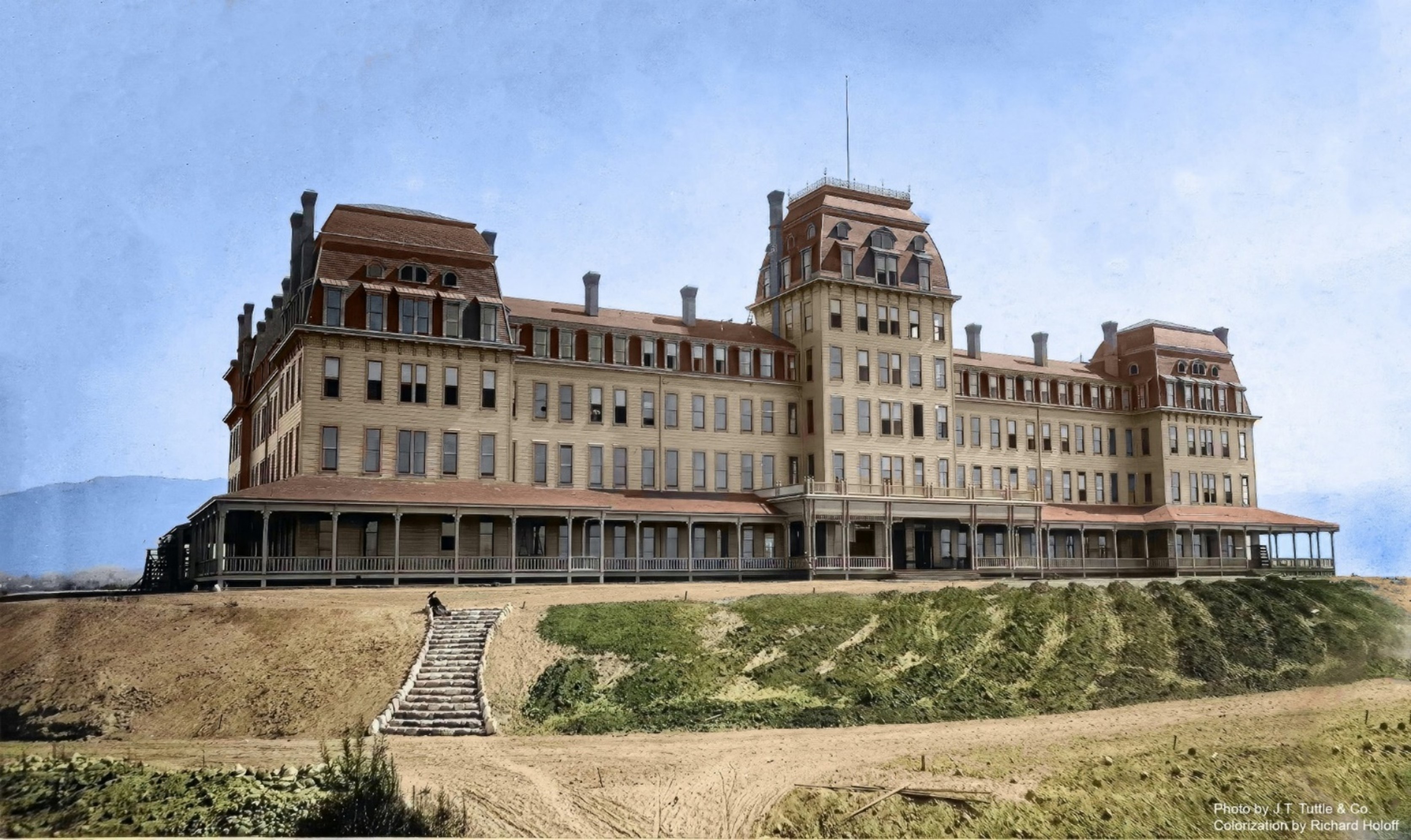 |
|
| (1886)* - Looking at the multi-story Raymond Hotel in South Pasadena during the final stages of construction. Image enhancement and colorization by Richard Holoff |
Historical Notes In June 1886 the Valley Union described the nearly completed hotel as "the most imposing sight in Southern California, and, perhaps, the greatest undertaking ever carried through here." |
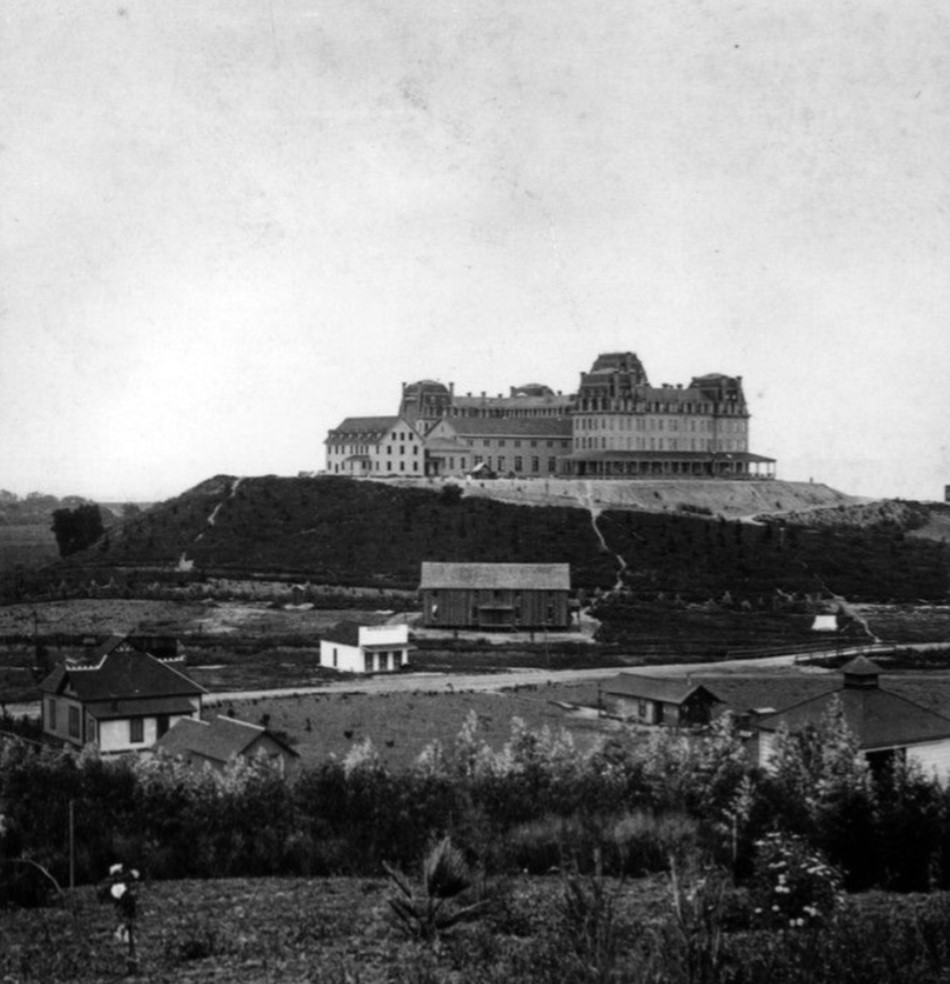 |
|
| (ca. 1886)* - A panoramic view facing the eastern facade of the Raymond Hotel. The surrounding land is still rural with scattered houses and small buildings close to a dirt road (Fair Oaks Ave) that passes over a bridge covering a small wash. |
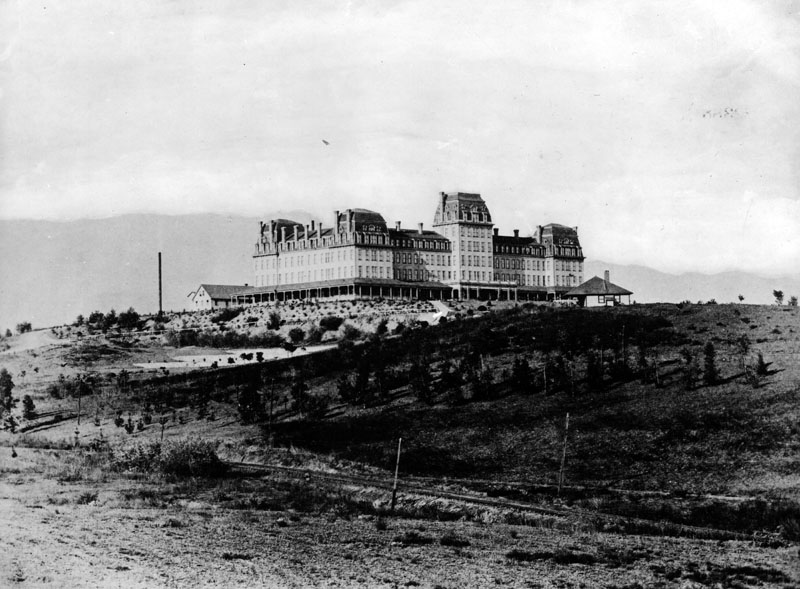 |
|
| (ca. 1886)* - View of the Raymond Hotel looking across the grounds at the western facade sans landscaping, located in South Pasadena. |
Historical Notes On Nov. 17, 1886, an inaugural ball marked the hotel's opening. The Los Angeles Times called the event, attended by a throng of 1,500, "perhaps the most extensive social affair in the history of the county" and "the mark of an important era in the history of Southern California."* |
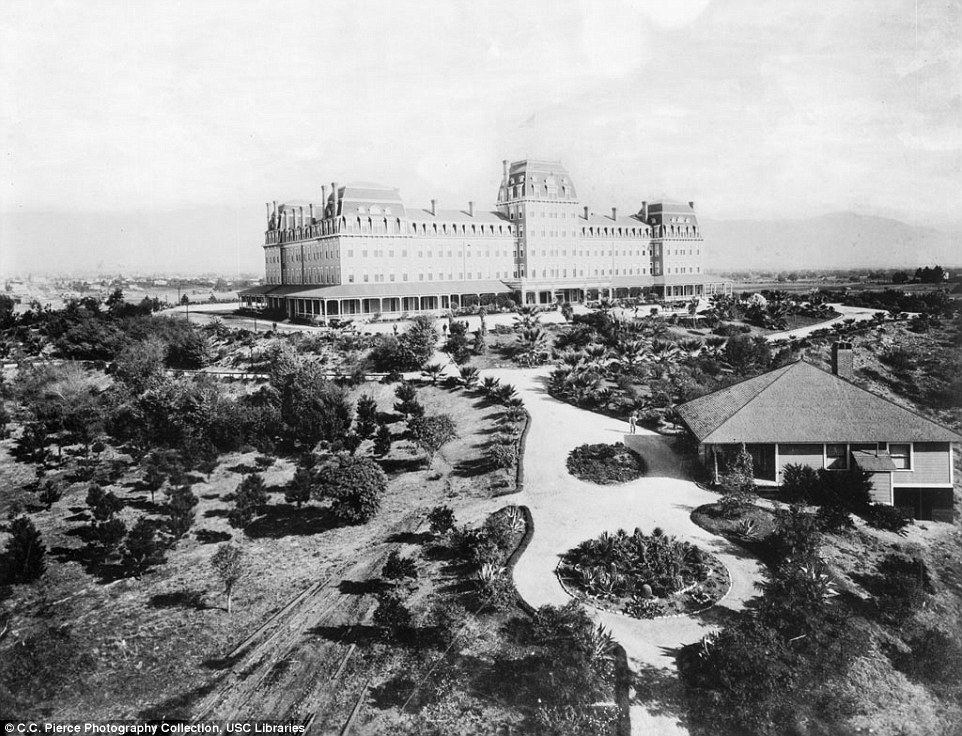 |
|
| (ca. 1890)* - A view of the Raymond Hotel in Pasadena showing the multi-story hotel with an encircling porch, Mansard roof, decorative cornice, brackets, interior and end-wall chimneys, dormer windows and a balcony. Photo by C. C. Pierce |
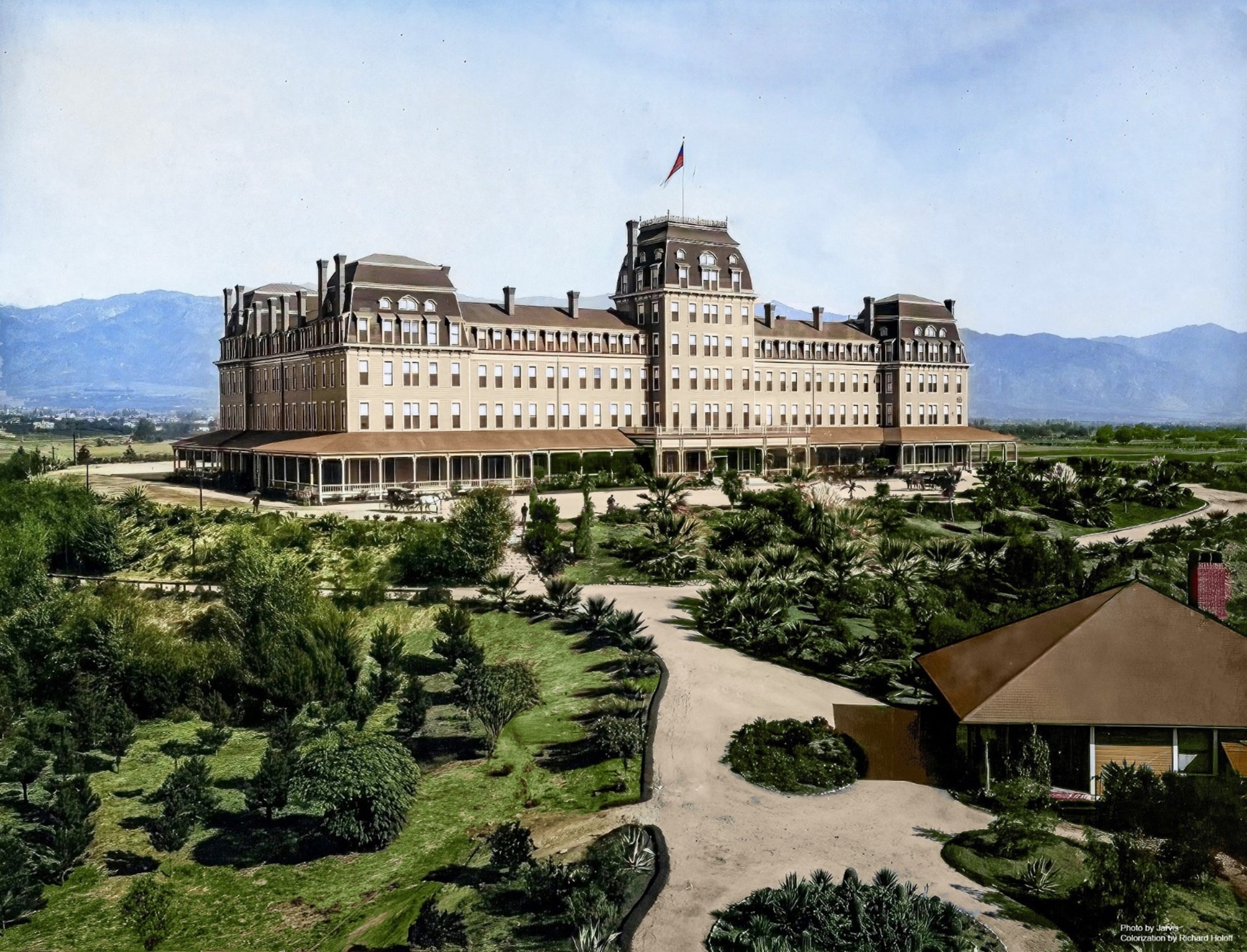 |
|
| (ca. 1890)* - A view of the Raymond Hotel in Pasadena showing the multi-story hotel with an encircling porch, Mansard roof, decorative cornice, brackets, interior and end-wall chimneys, dormer windows and a balcony. Photo by C. C. Pierce; Image enhancement and colorization by Richard Holoff |
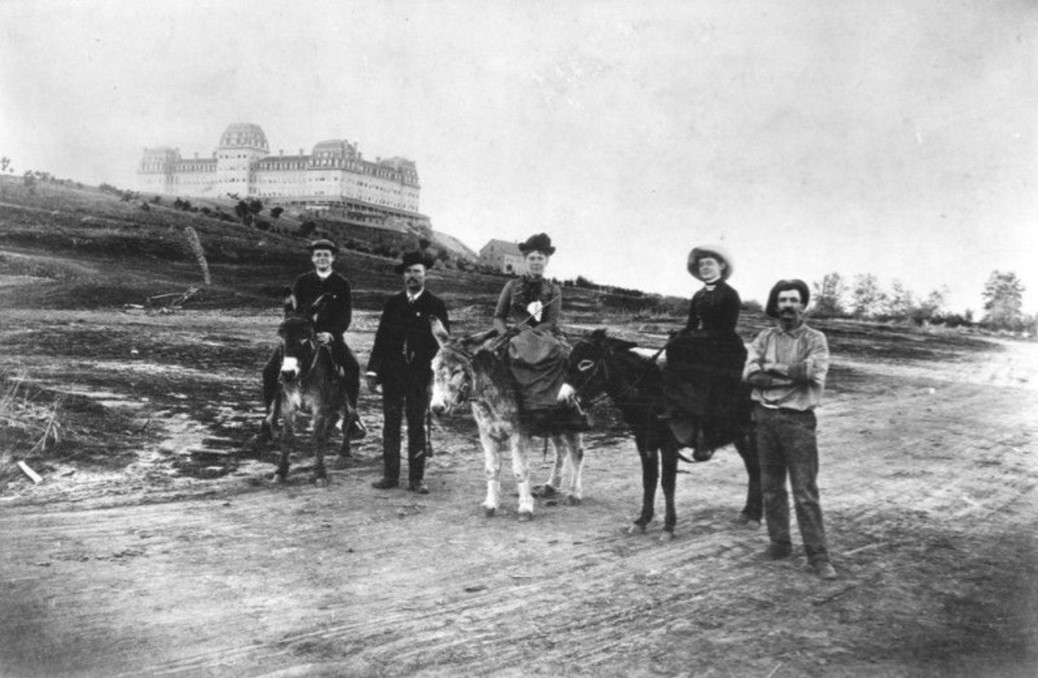 |
|
| (ca. 1890)*- Two women and a young man sit astride donkeys as they ride down the dirt road, accompanied by two men, that leads from the Raymond Hotel. The women sit side-saddle. |
Historical Notes The Raymond immediately transformed Pasadena into a mecca for East Coast winter tourists. |
 |
|
| (ca. 1886)* - View looking northwest showing the original Raymond Hotel with burros in the foreground, South Pasadena. |
Historical Notes The strange thing was the appearance of a 17th century French Palace on a rural hillside. |
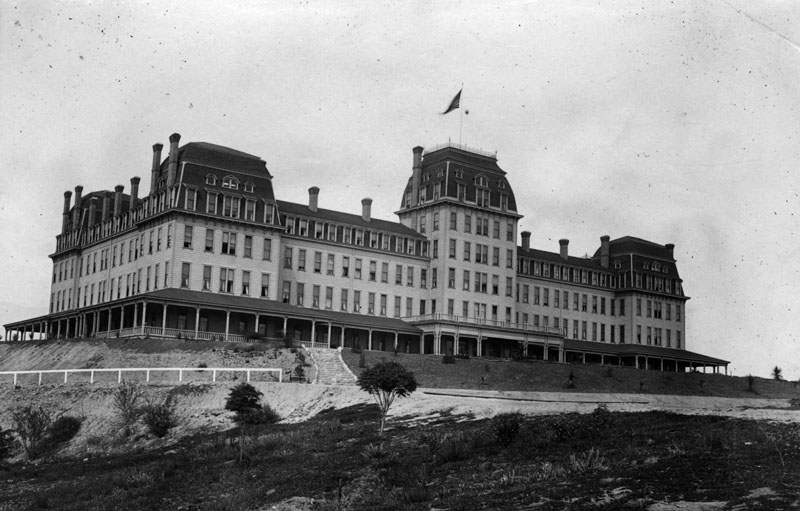 |
|
| (ca. 1886)* - View showing the Raymond Hotel with landscaping covering the embankment to the right of the stairs. Note the number of chimneys. |
Historical Notes Open annually from November to May, the hotel resembled an exclusive, hermetical community. While some adventurous guests took day trips to booming Los Angeles, dusty Pasadena, and other surrounding communities, most ensconced themselves on the resort grounds. An array of activities, from dances to concerts and from cards to billiards, kept guests entertained. * |
 |
|
| (ca. 1886)* - View showing the Raymond Hotel with landscaping covering the embankment to the right of the stairs. Note the number of chimneys. Image enhancement and colorization by Richard Holoff |
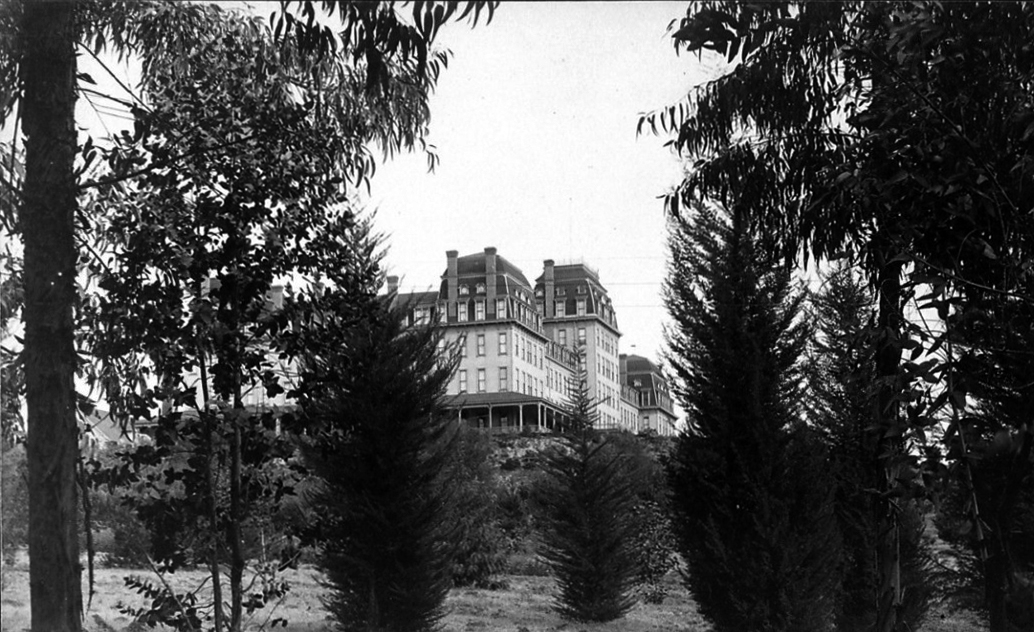 |
|
| (1890s)^*# – View showing the Raymond Hotel through the trees. |
Historical Notes Although similar hotels opened across the region, including the nearby Hotel Green in Pasadena and the beachfront Hotel Arcadia in Santa Monica, the Raymond remained Southern California's leading resort hotel until Easter Sunday, 1895. * |
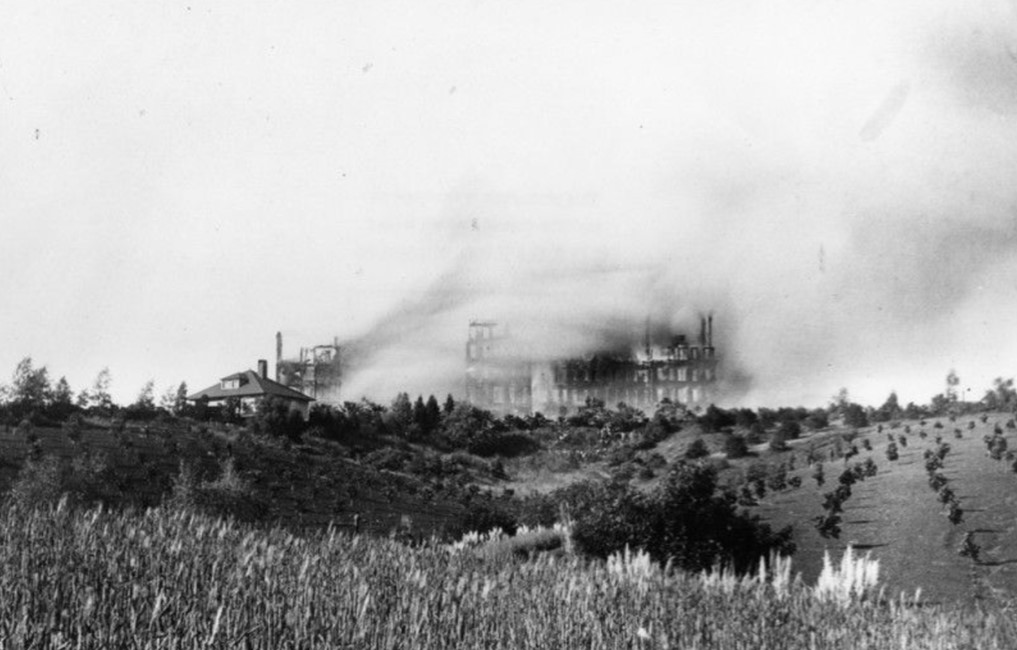 |
|
| (1895)* - View of the Raymond Hotel engulfed in flames. The hotel was a wood framed Victorian with a shingled roof and 80 chimneys. On Easter Sunday, 1895, a spark from a chimney set the roof on fire and the hotel and all its contents burned to the ground in 40 minutes. |
Historical Notes On Easter Sunday 1895, a spark from a chimney set the roof on fire and the hotel and all its contents burned to the ground in 40 minutes. At the time there were 165 guests staying at the hotel, but most were at church, and as fortune would have it, no one was hurt though all their possessions were lost. Walter Raymond was not to be disheartened by this loss since he had caught the Southern California fever. He immediately began promoting the area through publications and authors of publications who could attest to the virtues of the area. He attempted to augment the insurance money through a $250,000 bond issue, but there were too few people in the area with enough money to support it. Finally, a good friend and seasonal resident of the hotel, Mr. Richard T. Crane of Crane Plumbing, Chicago, agreed to a $300,000 mortgage which was applied to the building of a second hotel.^ |
2nd Raymond Hotel (1901-1934)
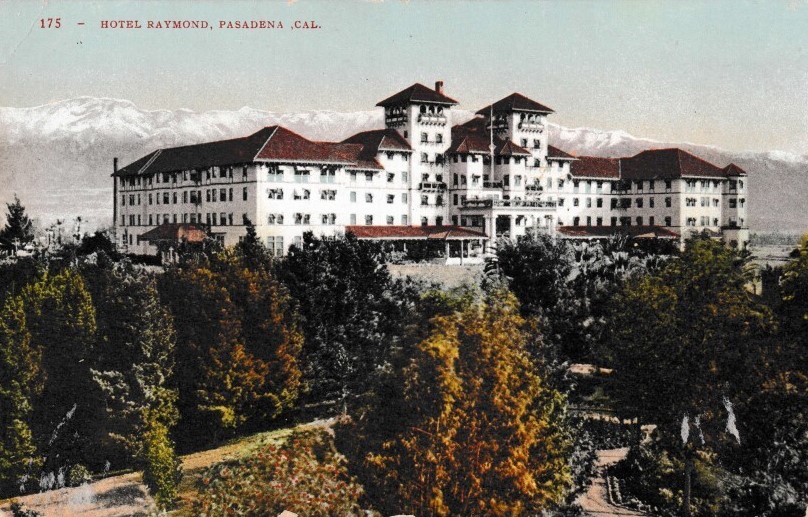 |
|
| (ca. 1901)*^ - Postcard view of the second Raymond Hotel (with fewer chimneys) built in 1901, torn down 1934. |
Historical Notes The second hotel opened on December 19, 1901 and was met with immediate success especially from those who had lost their winter residence for 6 years. The registry was filled with names of moguls from the East: Pullman, Schwab, Harriman, Swift, Armour, Rockefeller, Morgan, Carnegie, and of course R. T. Crane who spent his remaining winters at the Raymond.*^ |
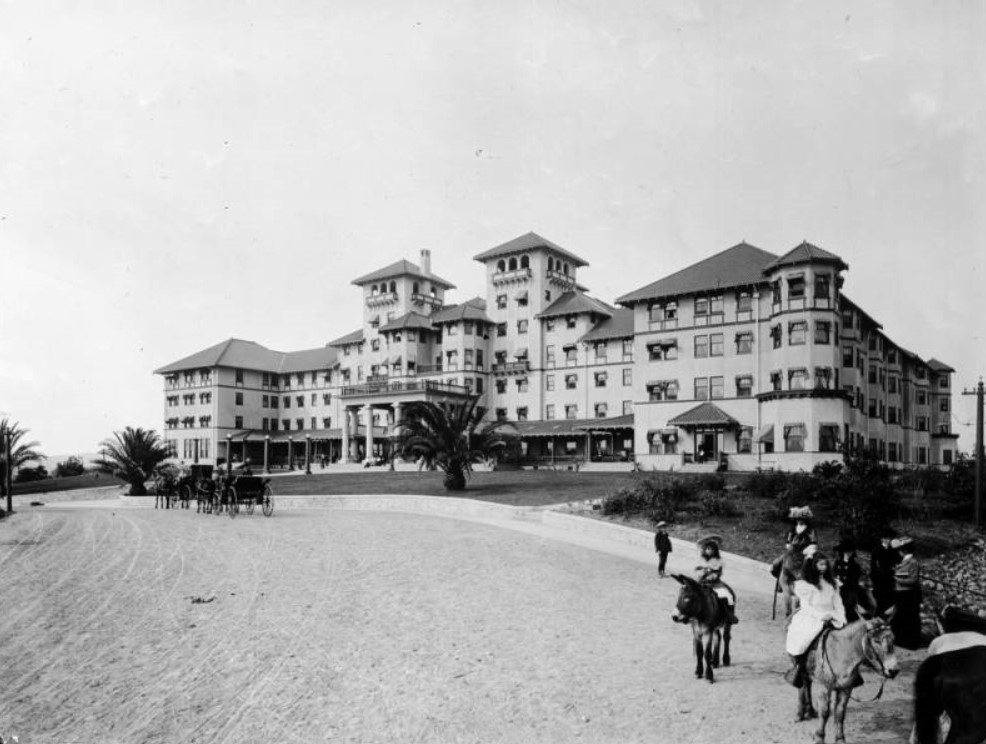 |
|
| (ca. 1905)* - Young girls on donkeys wait in circular drive of the Raymond Hotel. The Mission style three story building has a corner turret, portico and arcades. Palms and flowering bushes line the drive where horse-drawn buggies sit. |
Historical Notes With 400 rooms, golf links, and formal gardens, the Raymond's second iteration was even grander than the first. At the entrance, a new floral display, augmented by 575 electric lights, announced in ten brightly colored letters that visitors had arrived at "THE RAYMOND." Guests then entered a tunnel -- which still exists today, though sealed, under Raymond Hill -- and ascended into the hotel via elevator. *#* |
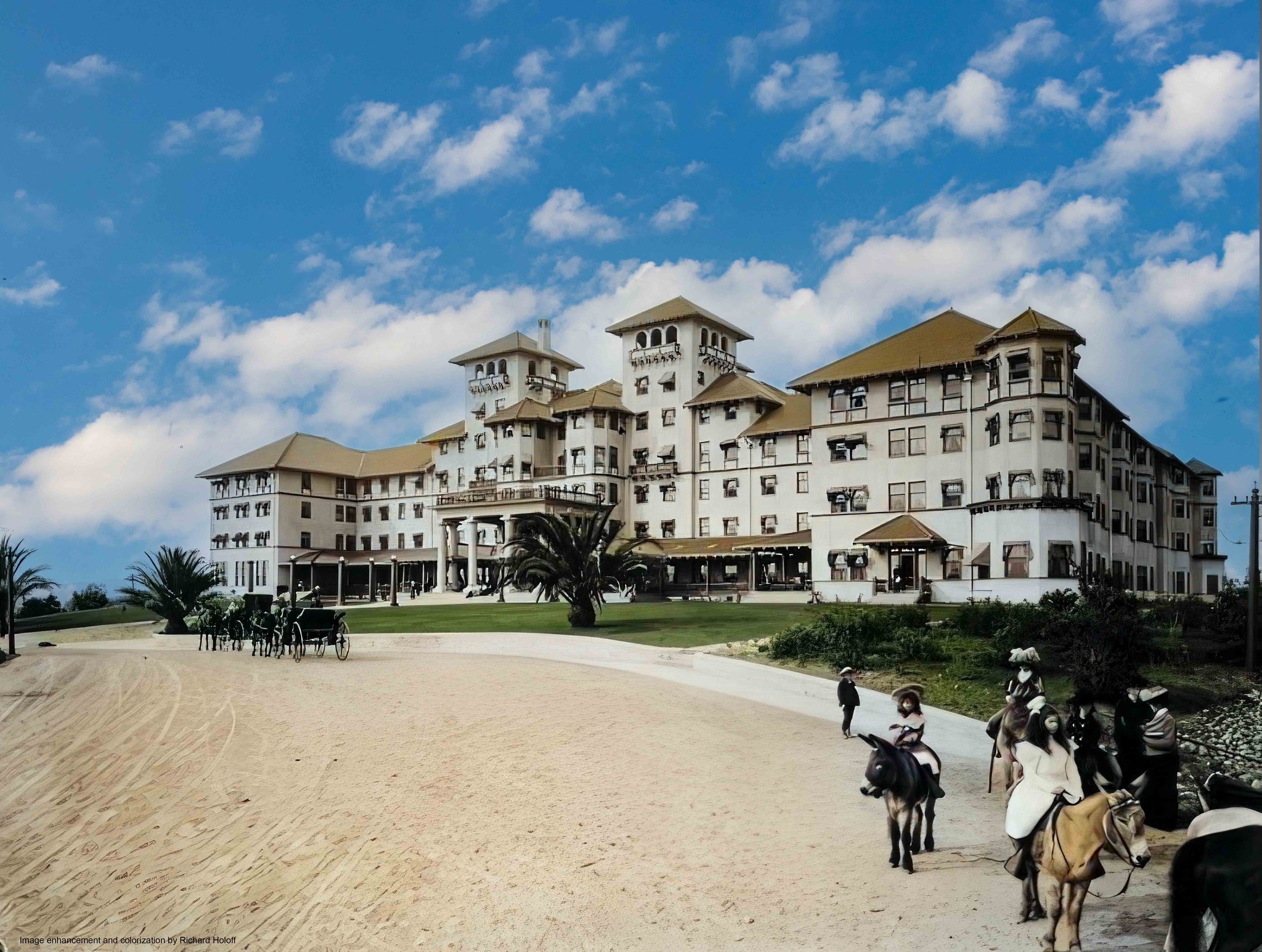 |
|
| (ca. 1905)* - Young girls on donkeys wait in circular drive of the Raymond Hotel. The Mission style three story building has a corner turret, portico and arcades. Palms and flowering bushes line the drive where horse-drawn buggies sit. Image enhancement and colorization by Richard Holoff. |
 |
|
| (ca. 1908)* - Panoramic view of the second Raymond Hotel and surrounding area. |
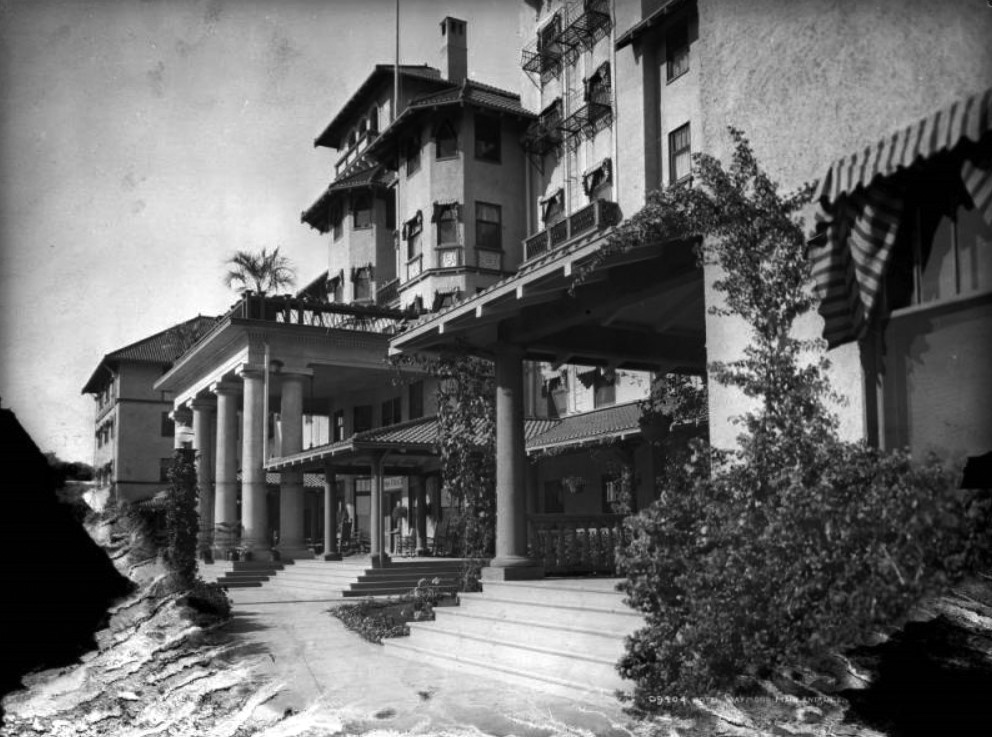 |
|
| (ca. 1910)*#*^ - View showing the front entrance to the Raymond Hotel with snow in the foreground. The Mission style three-story building has a portico, balconettes, arcade, striped awnings on windows, and a tile roof. Plants and flowering bushes decorate the main entrance. |
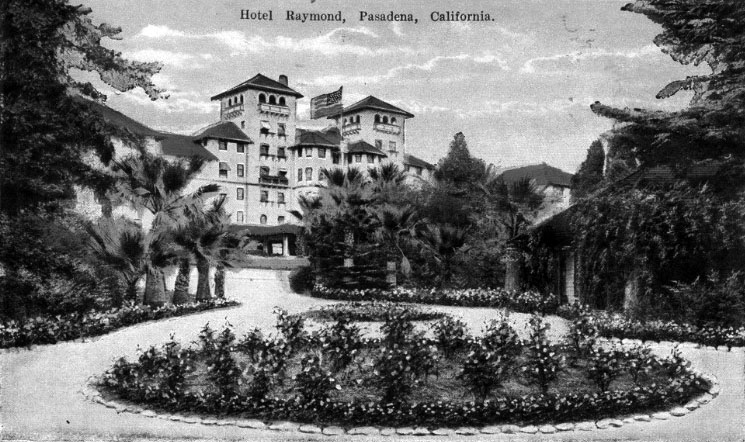 |
|
| (1931)^#^^ – Postcard view of the Raymond Hotel showing circular driveway and landscaping. |
Historical Notes The second Raymond Hotel had a larger foundation base, was more fireproof, and sported an architectural style more in keeping with the time. It had 400 rooms many with private baths, which was not a feature of the original. Fireplaces gave way to steam heating; the wood exterior was exchanged for concrete and stucco; the roof was tiled, not shingled, and electric lighting came with the plans. The plans also included an abundance of fire doors and extinguishers.*^ |
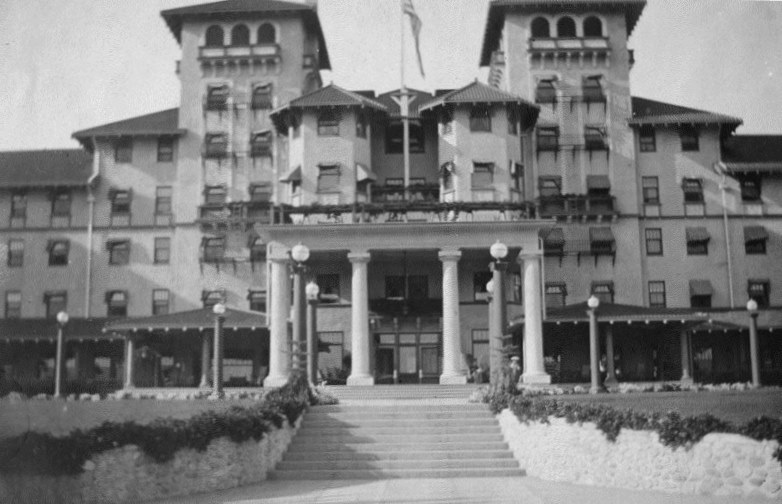 |
|
| (1902)* - Exterior view of the Raymond Hotel located in Pasadena. View shows the stairs at the front of the hotel. Four tall pillars grace the entranceway. |
Historical Notes The Raymond Hotel had its steady guests in spite of the fact that it also had competition from other hotels about Pasadena that were opened year round. There were the Hotel Green, a few blocks north on Raymond Avenue, the Vista Del Arroyo which overlooked the Arroyo Seco, and the Maryland Hotel on Colorado Boulevard.*^ |
 |
|
| (ca. 1902)^ – View looking north toward the 2nd Raymond Hotel with the San Gabriel Mountains in the distant background. |
Historical Notes The rebuilt hotel thrived over the succeeding decades, but whereas the original structure met its end in flames, the Great Depression spelled doom for the second. *#* |
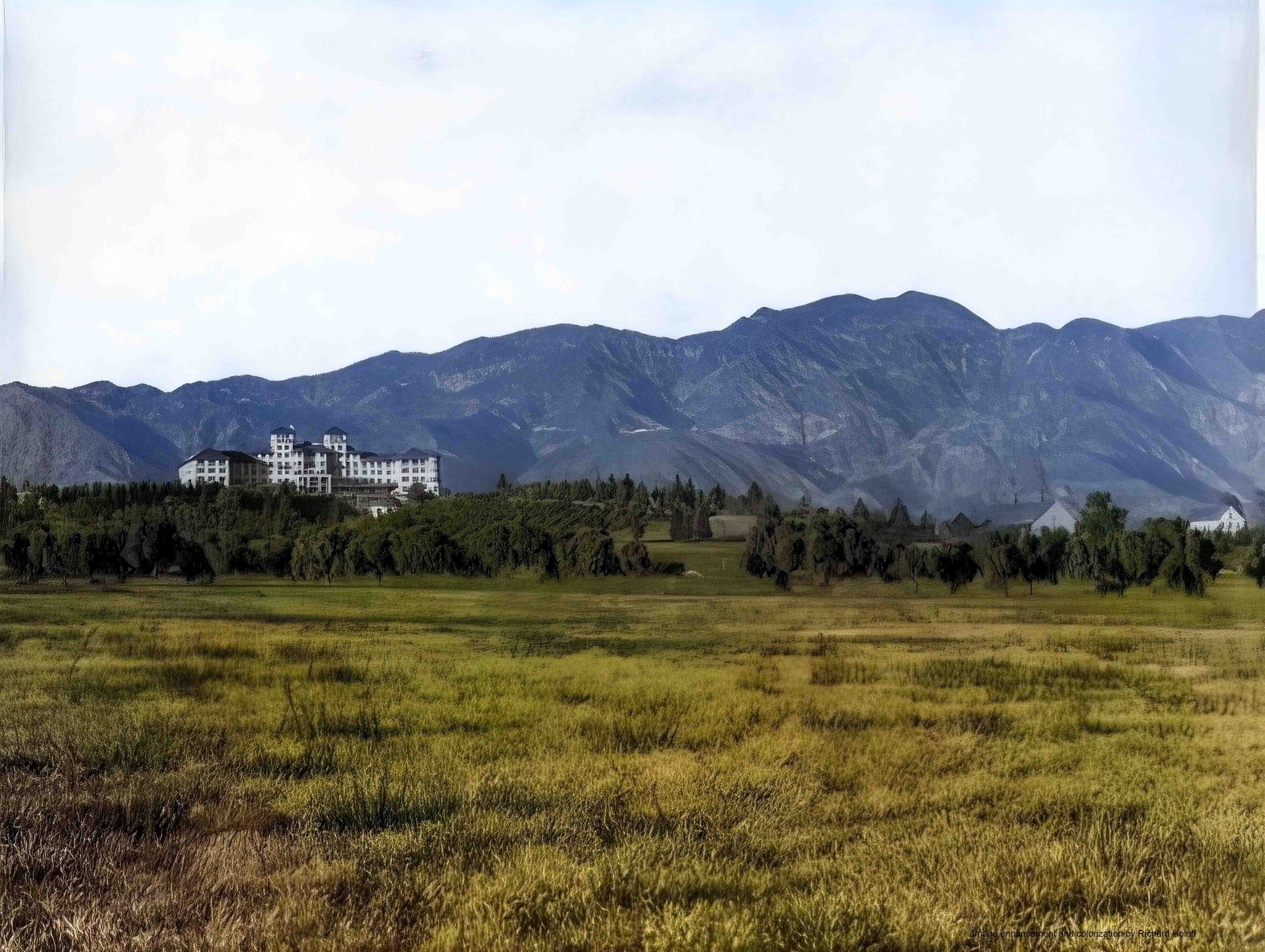 |
|
| (ca. 1902)^ – View looking north toward the 2nd Raymond Hotel with the San Gabriel Mountains in the distant background. Image enhancement and colorization by Richard Holoff. |
Click HERE to see more Early Views of the 2nd Raymond Hotel |
Altadena's First House
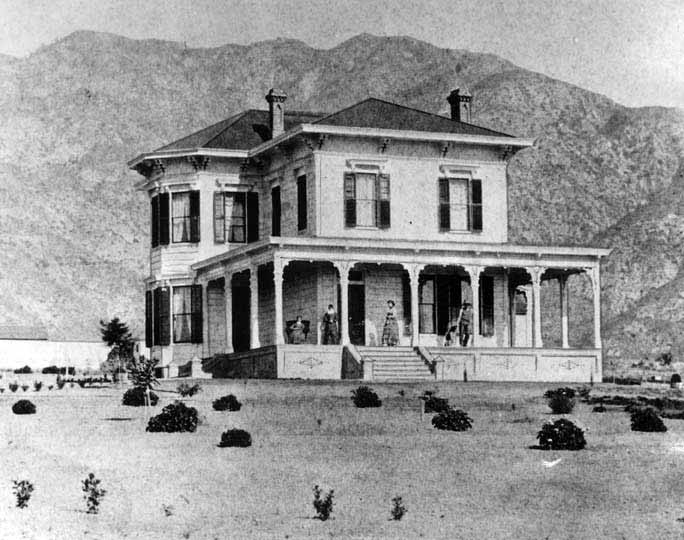 |
|
| (1882)* – View showing several people on the porch of the home of Capt. Frederick J. Woodbury. This was the first house built in Altadena. |
Historical Notes In 1880, Capt. Frederick Woodbury, and his brother, John Woodbury of Marshalltown, Iowa, purchased 937 acres known as the Woodbury Ranch. John Woodbury established the Pasadena Improvement Company in 1887, with a plot plan of residential development referred to as the Woodbury Subdivision. They contacted Byron O. Clark, who established a nursery in the foothills in 1875, and had since moved away. He called his nursery "Altadena Nursery", a name he coined from the Spanish "alta" meaning "upper," and "dena" from Pasadena. Woodbury asked if he could use the name "Altadena" for his subdivision and Clark agreed. The newly sprouted community of Altadena immediately began to attract millionaires from the East. In 1887 Andrew McNally, the printing magnate from Chicago, and his good friend Col. G. G. Green, had built mansions on what was to become Millionaire's Row; Mariposa Street near Santa Rosa Avenue. Newspaper moguls William Armiger Scripps and William Kellogg built homes side by side just east of Fair Oaks Avenue. A bit farther east, Zane Grey bought a home from Arthur Herbert Woodward, and added a second-floor study. The famous Benziger Publishing Company built a mansion on the corner of Santa Rosa Avenue (Christmas Tree Lane) and Mariposa. *^ Mariposa was taken from the Spanish name for a butterfly. |
Green Residence
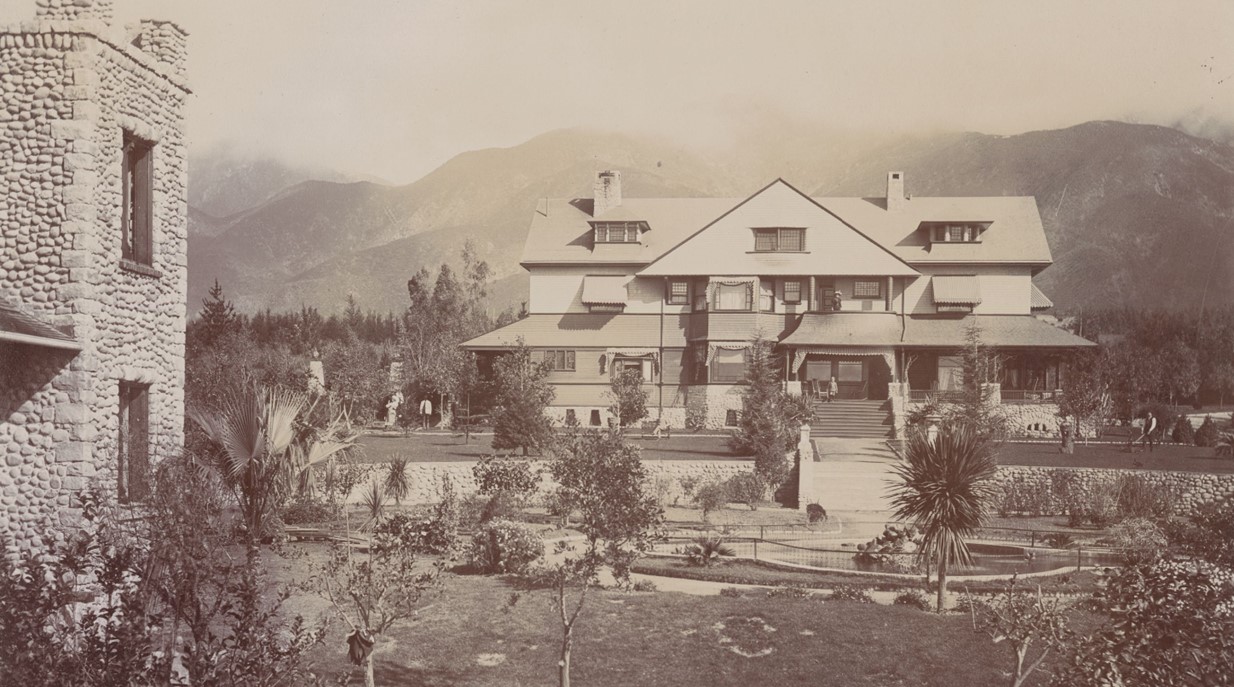 |
|
| (ca. 1888)* - View showing the home of Col. G. G. Green in Altadena. Green, the patent medicine millionaire--who was among the wealthy who moved to Altadena from all over the nation. |
Historical Notes Colonel G. G. Green was a larger than life millionaire from New Jersey who made his immense fortune in patent medicines and remedies. In 1888 the Green family headed to Altadena to summer in their newly completed house on the southwest corner of Mariposa Street and Santa Rosa Avenue. He built a lovely carriage house with a castle-like cobble stone tower to take care of his nine horses and garage his multiple carriages. Green spared no expense in landscaping the property. Although the house was sold about 1910, the Greens returned to the area each summer staying at Green's spectacular Green Hotel in Pasadena (now called the Castle Green.) The house was razed in the 1960s to make way for the Altadena library. However the carriage house remains. |
 |
|
| (1890)* – Residence of G. G. Green located on the southwest corner of Mariposa Street and Santa Rosa Avenue in Altadena. Photo by C. C. Pierce |
Historical Notes George Gill Green, a prominent figure in Pasadena and Altadena history, was an entrepreneur known for his patent medicine business and significant contributions to the local area. In 1893, Green acquired an unfinished hotel in Pasadena, which he completed and opened as the Hotel Green. Later in 1898, he built the "Central Annex" to Hotel Green, known as the Castle Green, a historic landmark listed on various registers. Green's entrepreneurial success was marked by his marketing campaigns and the production of his almanacs. His patent medicine business declined after the Pure Food and Drug Act in 1906, leading to the discontinuation of his products by 1916. George Gill Green passed away on February 26, 1925, leaving a lasting legacy in Pasadena and Altadena. |
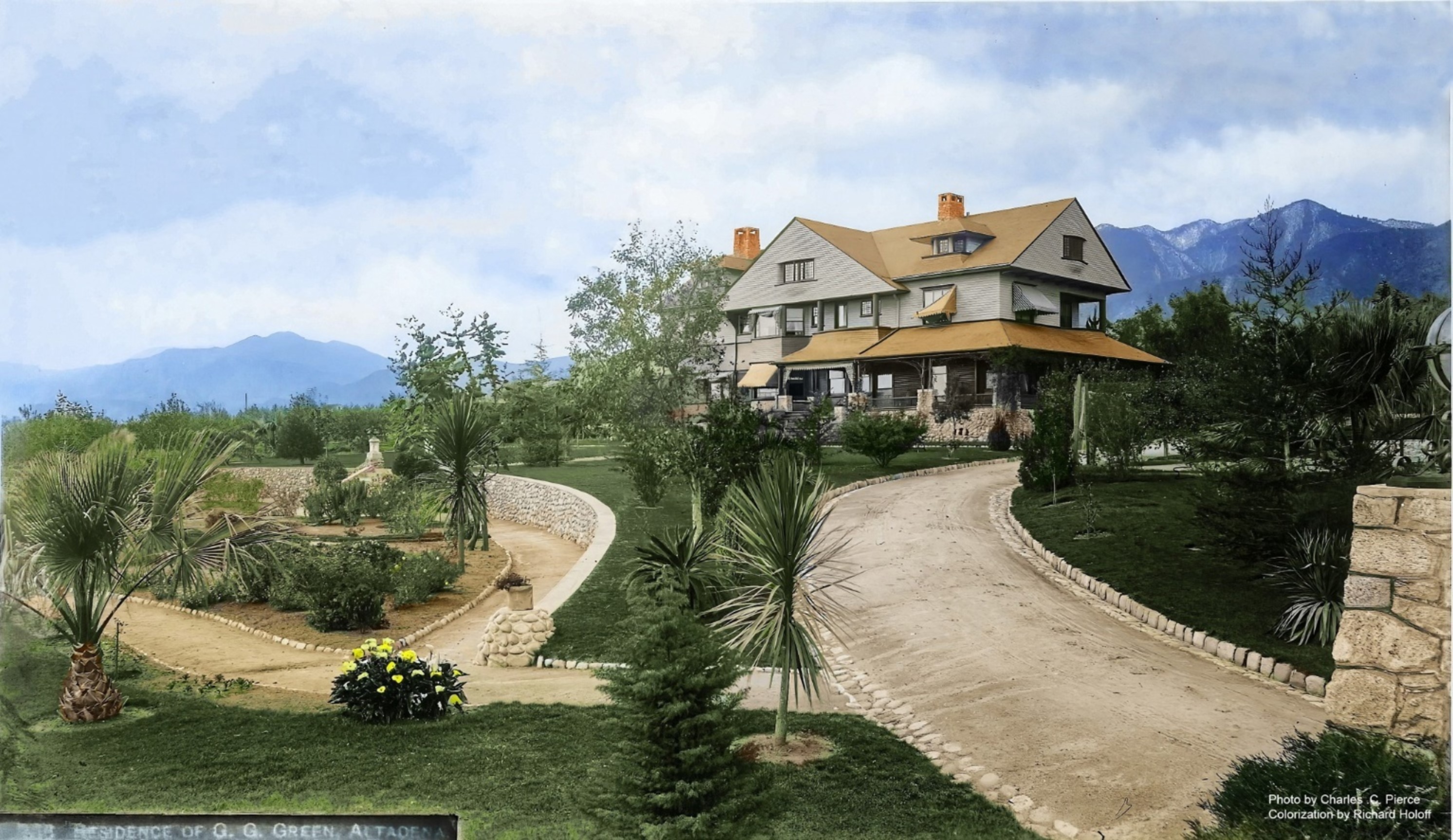 |
|
| (1890)* – Residence of G. G. Green located on the southwest corner of Mariposa Street and Santa Rosa Avenue in Altadena. Photo by C. C. Pierce; Image enhancement and colorization by Richard Holoff |
Abolitionist John Brown
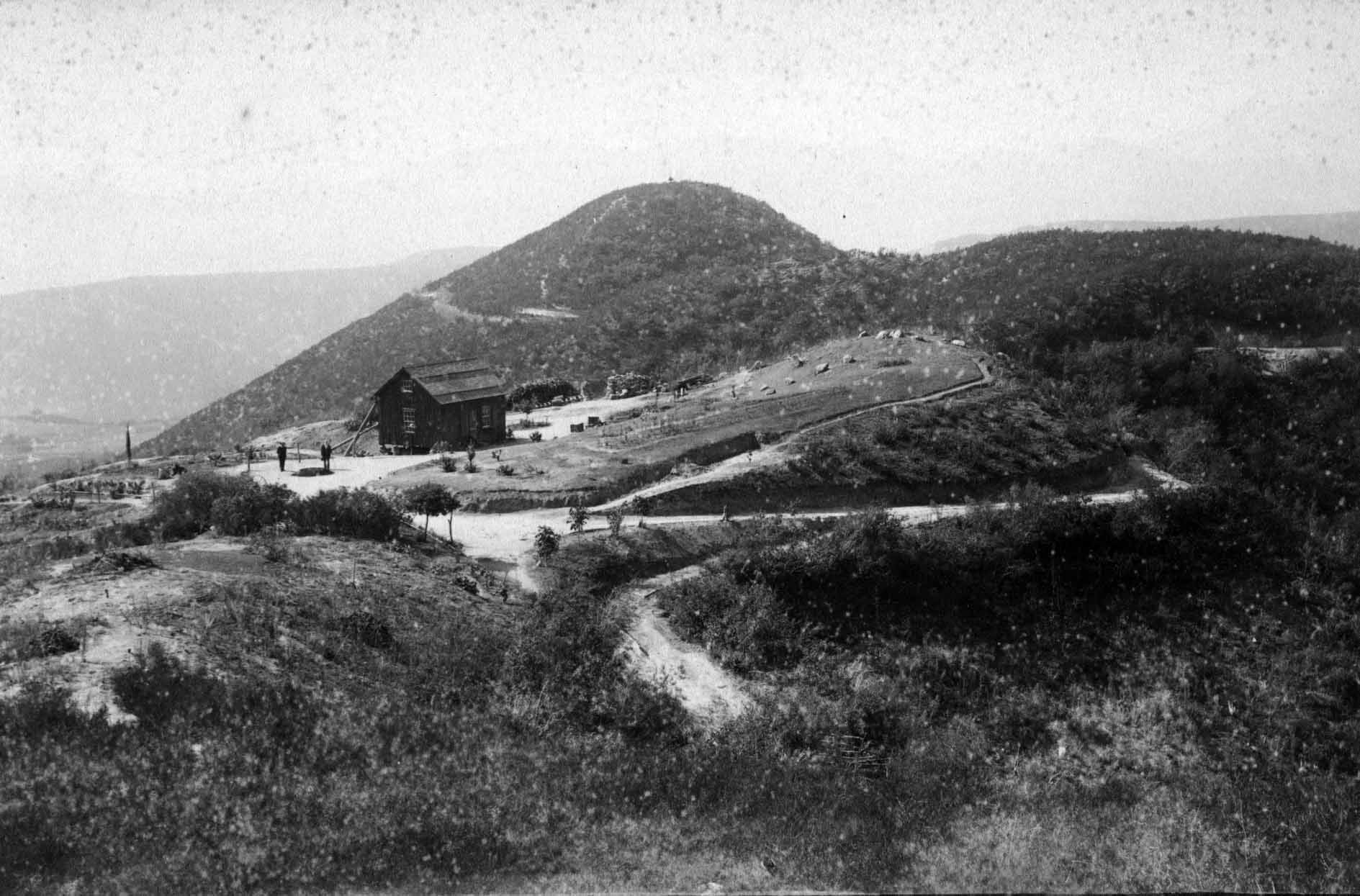 |
|
| (1880s)** - Bird's-eye view of abolitionist John Brown Boys' Ranch, with Little Round Top visible in background, located in Altadena. |
Historical Notes Known primarily through the notoriety of their father, brothers Owen and Jason and brother-in-law Henry Thompson also played important roles in history. All three fought proslavery forces in Kansas during the 1850s, and Owen participated in the Harpers Ferry raid, along with Henry’s brothers, William and Dauphin. John Brown and 21 followers overtook the U.S. Federal Arsenal and Rifle Works in the town of Harpers Ferry, Virginia, on October 16, 1859, in an attempt to steal weapons for a planned slave revolt. Though the raid ended in disaster, Owen and four others managed to escape, and over the course of 36 days, made their way to safety in the North. Existing as a fugitive for nearly twenty years, Owen hid with family in Ohio during the Civil War, and worked for the Underground Railroad until Emancipation. By the time the Browns moved to Pasadena in the 1880s, their radical days were long behind them. Their identities, however, were known to many, and soon they became minor celebrities in the growing city. #*^* |
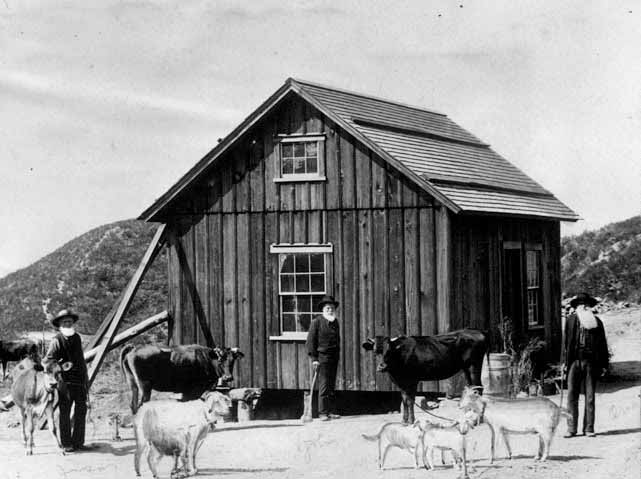 |
|
| (1880s)* - This is a remarkable photo of John Brown's sons--Jason, John Jr. and Owen (left to right)--at their cabin in the Altadena Hills. |
Historical Notes Owen Brown was at Harper's Ferry in 1859 and was the last survivor of that historic raid. |
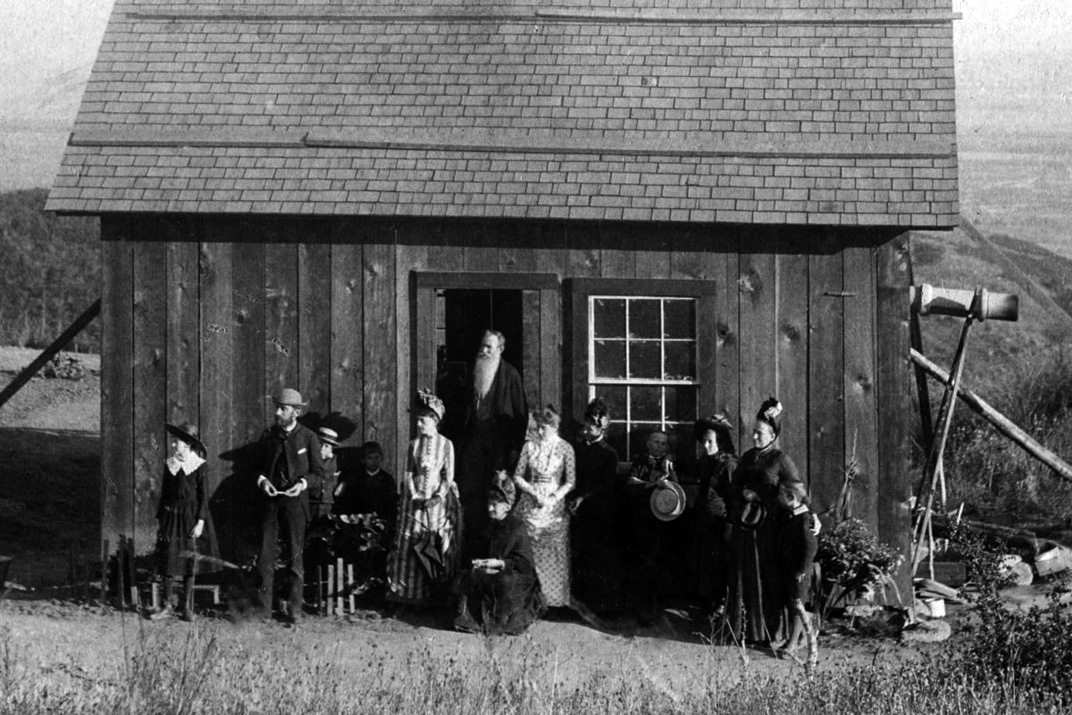 |
|
| (ca. 1887)* - Owen Brown, son of John Brown the abolitionist, and visitors at the Brown Brothers' Mesa Cabin, Altadena. |
Historical Notes Owen Brown was the last surviving member of the raiding party at Harper's Ferry; he died of pneumonia January 8, 1889 in Pasadena at the age of 64. Reportedly 2,000 mourners, equaling the entire population of Pasadena, marched in the funeral procession up to Little Roundtop Hill..*^ |
.jpg) |
|
| (1886)#* - Pasadena celebrates Grand Army of the Republic Day, 1886. The parade honored Union veterans of the Civil War, as well as Owen and Jason Brown, sons of the radical abolitionist John Brown and residents of nearby Altadena. |
* * * * * |
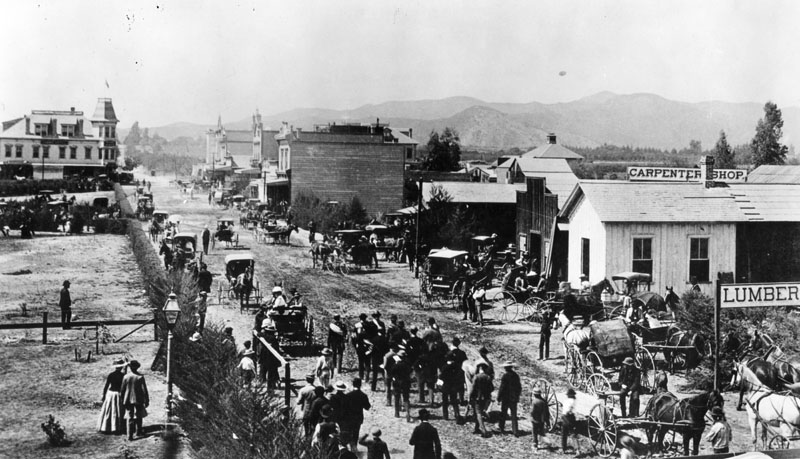 |
|
| (1886)* - View of Colorado Street, looking west. People of Pasadena are celebrating advent of the 1st Railroad with a parade, September 30, 1886. On the right there is a Lumber yard and a Carpenter's shop. Large building in the distance (left side), is the Ward Block, which includes the Pasadena Bank and the Grand Hotel. |
Historical Notes The mid-1880s saw the beginning of enormous growth and change for the young community. Pasadena acquired an identity as a resort town with the construction of several grand hotels and winter home of wealthy industrialists from the East and Midwest. Increasingly, vacationers decided to spend their retirement in Pasadena, while those sent to Southern California for health reasons were also attracted to the town. Railroad connections to Los Angeles and the east coast enabled these developments. Within Pasadena, Trolley cars linked sections of the expanding town with downtown, the railroad stations, and the hotels. In 1886, the city incorporated.*##* |
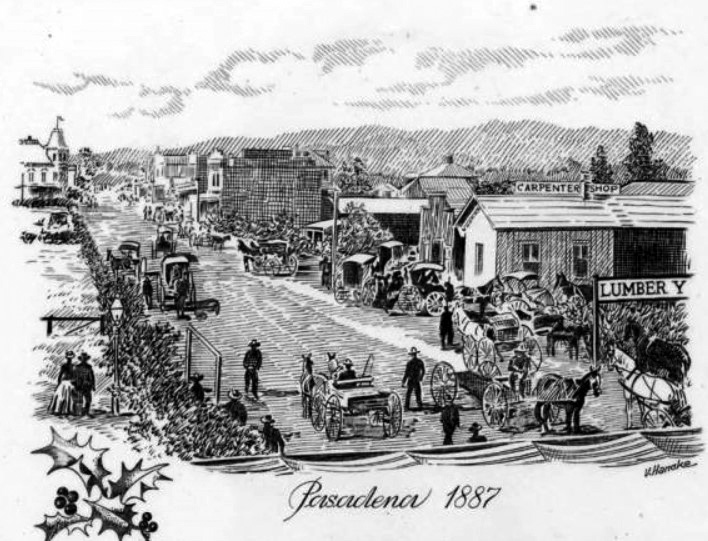 |
|
| (1887)** – Postcard view showing Colorado Street shortly after Pasadena was incorporated, July 19, 1886. |
Historical Notes Back of postcard, bottom reads: "Pasadena, our original home office city, in the year of our founding, 1887." |
 |
|
| (1887)* - View looking south on Fair Oaks from near Colorado showing several horse-drawn wagons parked alongside the dirt road. Several businesses can be seen on the right: a Market, Pasadena Carriage Works, a Clothing store and a Dry Goods store. |
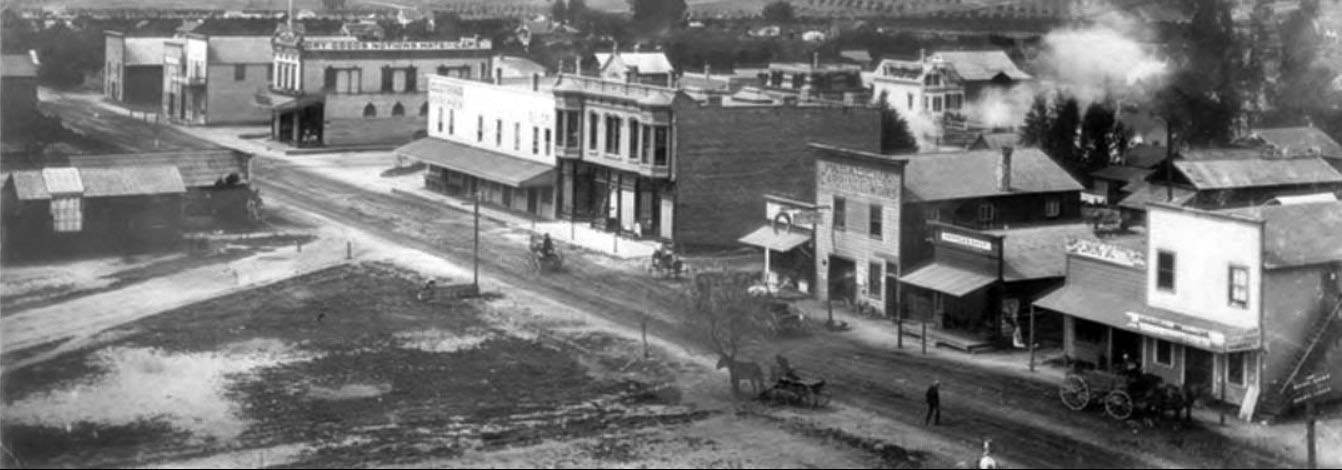 |
|
| (1887)** - Close-up panoramic view looking south on Fair Oaks Avenue from Colorado. Some of the buildings seen in the photo include Valley Feed Mill and Pasadena Carriage Works. |
Barney Williams Store
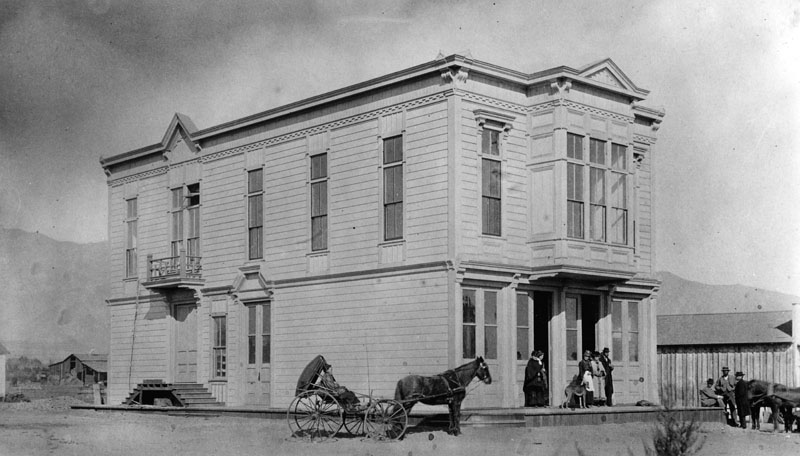 |
|
| (ca. 1887)^ - View of the Barney Williams Store in Pasadena on the corner of Colorado Street and Fair Oaks Avenue. A group of people stand on the porch of the two-story building while a horse-drawn carriage drives sits nearby. The building sports a clapboard veneer along with a balcony and a box window on its second floor. Several people attend a small horse in the background at right. |
Historical Notes Built by Lawson T. Hollingsworth in 1882, the building was later purchased by Romayne (Barney) Williams who named it Barney Williams Store and Hall. The store occupied the ground floor, and contained the first Post Office and had the first telephone connecting Pasadena and Los Angeles, as well as a hall. Later, the Parlor Theatre occupied the top floor.** |
Wilson School
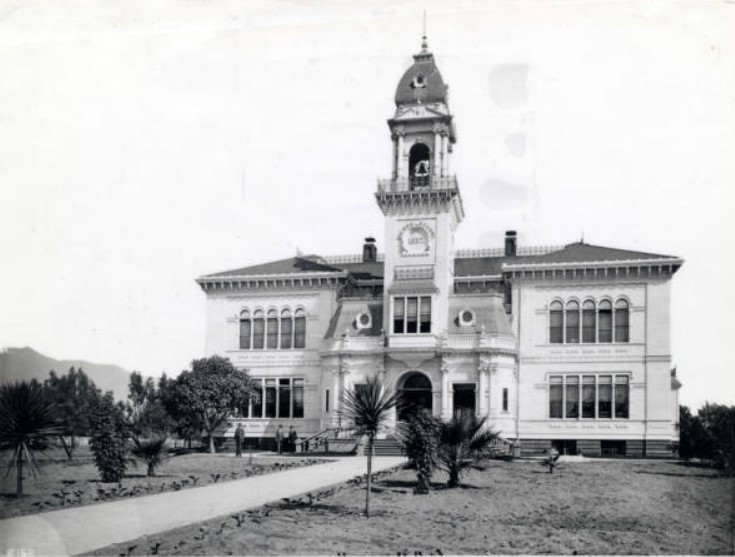 |
|
| (1887)** - View of the Wilson School located on the southeast corner of Marengo Avenue and Walnut Street. |
Historical Notes Benjamin D. Wilson School, located on the southeast corner of Marengo and Walnut facing the Marengo Avenue side, was named for prominent Pasadenan B.D. Wilson. It served as a school site from 1887 to 1924.** |
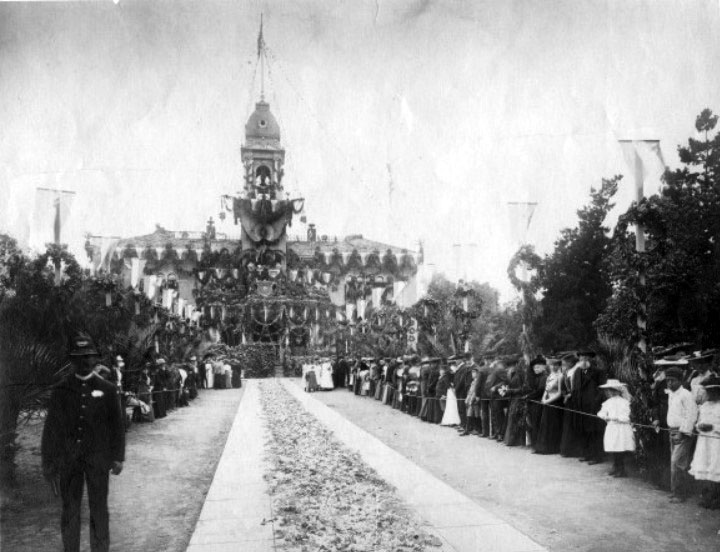 |
|
| (1903)** - View of a decorated Wilson High School during a visit by President T. Roosevelt on May 8, 1903. |
Historical Notes This school, which housed high school students from 1892 to 1903, was one of many buildings decorated for President Theodore Roosevelt’s visit. ** |
 |
|
| (1918)** - View of Wilson School (cor. Marengo & Walnut) used as Red Cross Hospital for flu epidemic. |
Historical Notes Illness from the 1918 flu pandemic, also known as the Spanish flu, came on quickly. Some people felt fine in the morning but died by nightfall. People who caught the Spanish Flu but did not die from it often died from complications caused by bacteria, such as pneumonia. During the 1918 pandemic: Unlike earlier pandemics and seasonal flu outbreaks, the 1918 pandemic flu saw high mortality rates among healthy adults. In fact, the illness and mortality rates were highest among adults 20 to 50 years old. The reasons for this remain unknown. #*^ |
Los Angeles and San Gabriel Railway Bridge
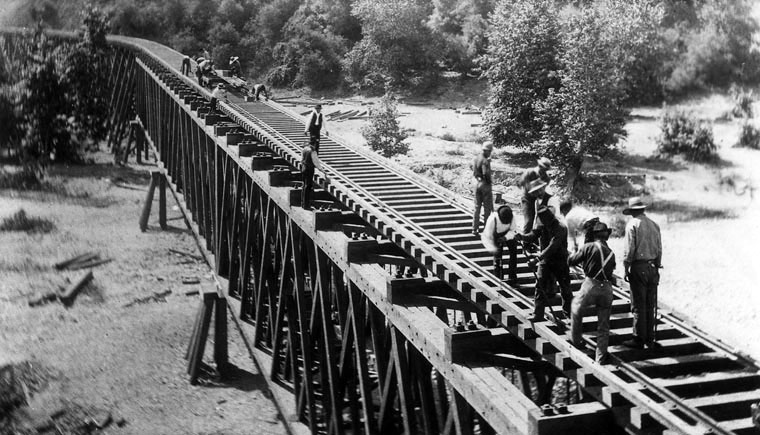 |
|
| (ca. 1880s)* - View showing two groups of men building the railroad over the tressels. This area of the tracks is the Los Angeles and San Gabriel Railroad, crossing into Pasadena. |
Historical Background The Los Angeles and San Gabriel Valley Railroad was founded in 1883 by James F. Crank with the goal of bringing a rail line to Pasadena from downtown Los Angeles. Los Angeles and San Gabriel Valley Railroad was sold and consolidated in 1887 into the California Central Railway. In 1889 this was consolidated into Southern California Railway Company. On Jan. 17, 1906 Southern California Railway was sold to the Atchison, Topeka and Santa Fe Railway and called the Pasadena Subdivision. The new rail line through the San Gabriel Valley was a boom to the valley's citrus, nuts and fruit growers, with a new way to get their goods to market.*^ |
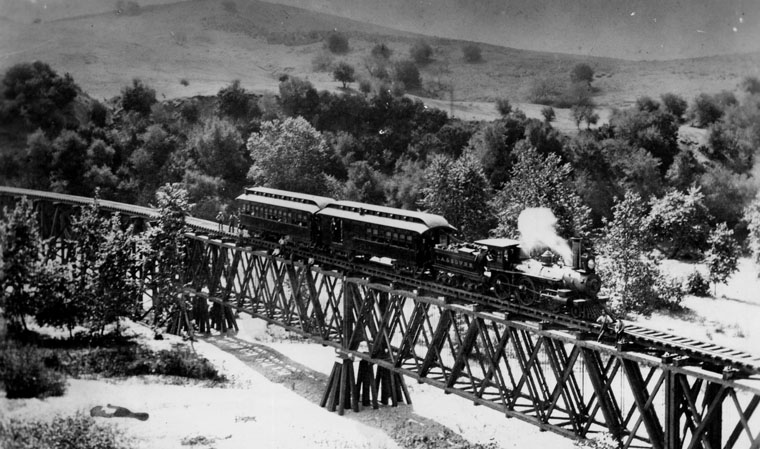 |
|
| (ca. 1885)*^ - View showing a Los Angeles and San Gabriel Railroad train on the bridge at Garvanza, the first trestle across the Arroyo Seco, approaching Highland Park from South Pasadena. The trestle, which was replaced later by the Santa Fe trestle, extends out from the forest, supporting a steam engine trailing two passenger cars behind it. Two men stand on the tracks at back, one with his hand on the last passenger car. Two more men stand to the side of the tracks in front of the engine. |
Historical Background With the goal of connecting all of the San Gabriel Valley, in November of 1886 the Los Angeles and San Gabriel Valley Railroad started building a line West from Mud Springs (what is now San Dimas). By January 1887 the rail had crossed the San Gabriel River in Azusa. In 1887 the line continued to Monrovia where a wooden structure rail station depot was built. This structure was replaced by the Santa Fe Depot which was built in 1926.*^ |
 |
|
| (1886)*^ - Map of the Los Angeles and San Gabriel Valley Railroad showing the location of the Arroyo Seco Bridge. |
Historical Background With the May 20, 1887 sale of the Los Angeles and San Gabriel Valley Railroad to the California Central Railway, (a subsidiary railroad of the Atchison, Topeka and Santa Fe Railway) the two lines where connected together at Mud Springs, completing the rail line from Chicago to Los Angeles through the San Gabriel Valley.*^ |
Arroyo Seco Bridges
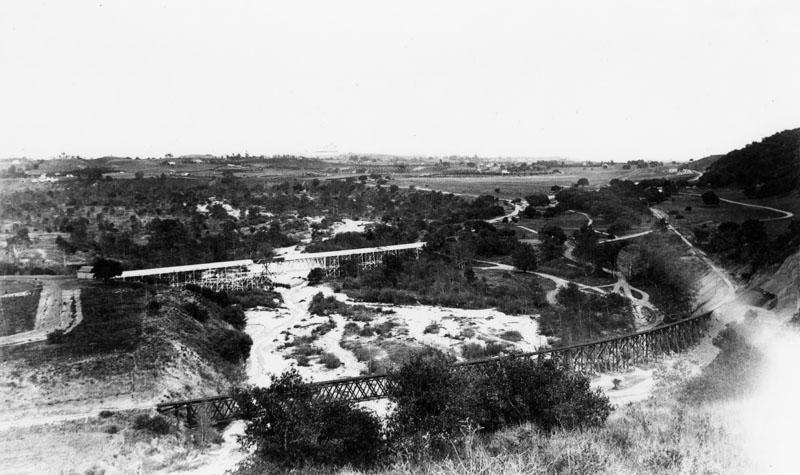 |
|
| (1891)* - Panoramic view of two railroad bridges in Arroyo Seco, in Pasadena. |
Historical Background The Arroyo Seco region can be considered by historical accounts as the birthplace of Pasadena. After the 1820s secularization of the Missions, the broad area to the east of the Arroyo was the Mexican land grant of Rancho San Pascual, present-day Pasadena, California. Manuel Garfias was the grantee of the Rancho and its longest early resident. His adobe house was on the east ridge of the Arroyo, in present-day South Pasadena. With the 1874 establishment of the community of the Indiana Colony, the new residents built their homes along today's Orange Grove Boulevard, the major north-south avenue paralleling the Arroyo on the east. However, the deep and seasonally flooded Arroyo presented a barrier to easy travel and transportation between renamed Pasadena and Los Angeles. Stories of four and five hours just crossing the chasm, whether exaggerated or not, abounded in Pasadena history.*^ |
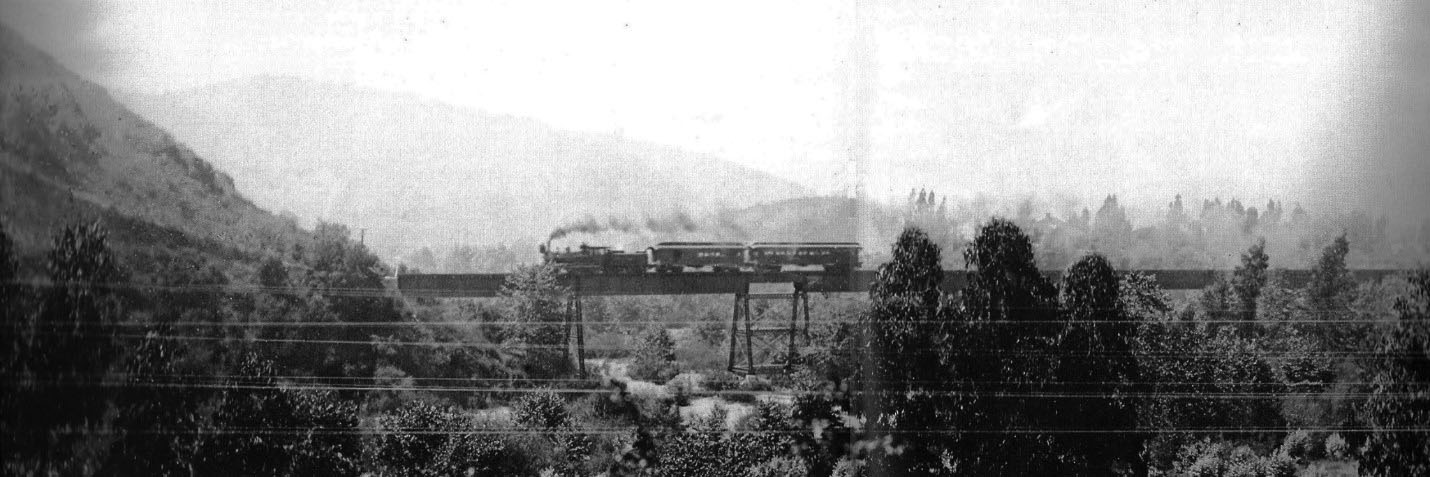 |
|
| (ca. 1910)++# – View showing the outbound Santa Fe morning local in route from LA to Pasadena crossing the Arroyo Seco. |
Historical Background The Santa Fe line served the San Gabriel Valley until 1994, when the 1994 Northridge earthquake weakened the bridge in Arcadia. In the late 1990s construction of the Gold Line started and opened on July 26, 2003. Thus the old Los Angeles and San Gabriel Valley Railroad right of way (ROW) is still in use today.*^ |
 |
|
| (ca. 1949)* - A Santa Fe mail train crosses the Arroyo Seco (and Route 66) near South Pasadena pulled by engine no. 3444. |
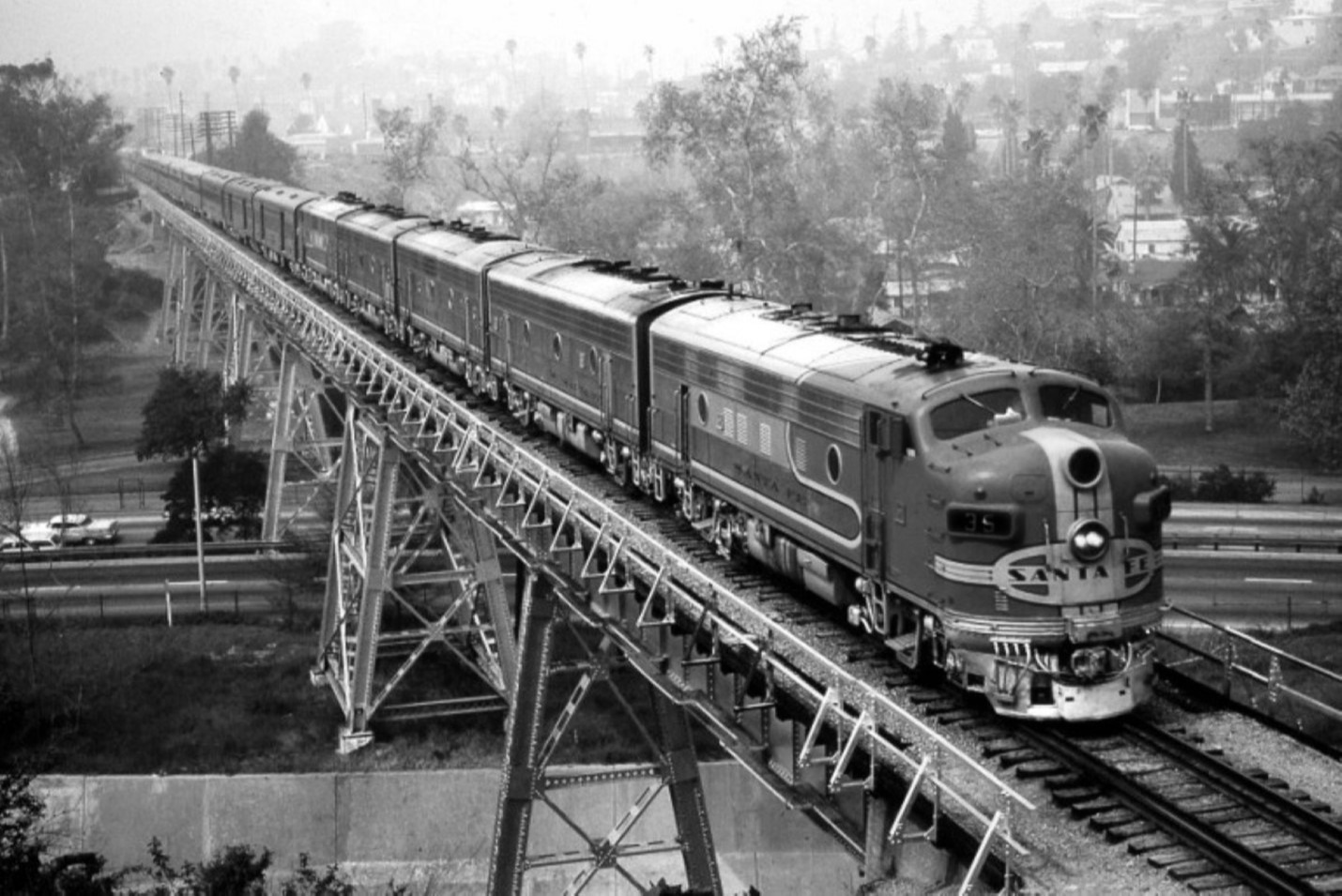 |
|
| (1960s)* - The fabled Super Chief crossing the Arroyo Seco. Photo courtesy of Terrence Butcher |
Historical Background The Santa Fe Arroyo Seco Railroad Bridge in Highland Park is the tallest and longest railroad span in the city of Los Angeles, and most likely the oldest such structure still in use. Rail service ended in 1994 and in the late 1990s, the bridge was retrofitted to accommodate the Los Angeles MTA's Gold Line light rail system which opened in 2003.* |
* * * * * |
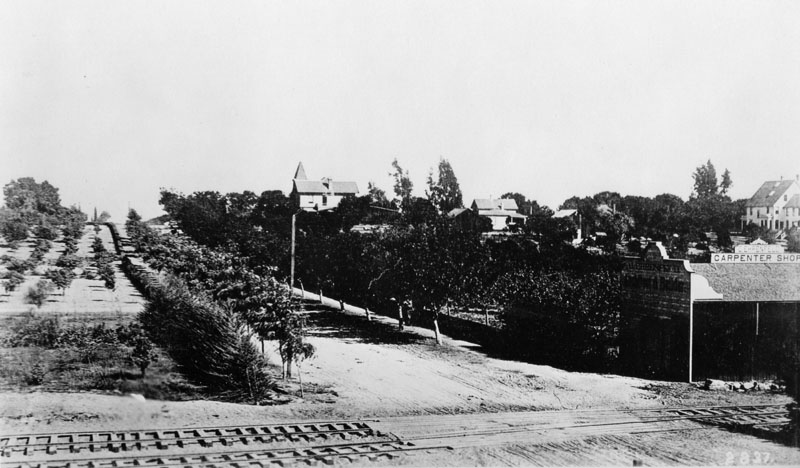 |
|
| (1887)* - View of Pasadena, looking east from the Salt Lake Railroad Depot along a rural street (Colorado Street?). The C. Ehrenfeld Carpenter Shop is in the right foreground. Railroad tracks (bottom foreground) run across the street. An orchard is on one side of the street. The residence of Dr. and Jeanne (the author) C. Carr is visible beyond the trees at center. A wooden building in the foreground at right has signs on it reading "C. Ehrenfeld, carpenter shop", "C. Ehrenfeld, architect & builder".^ |
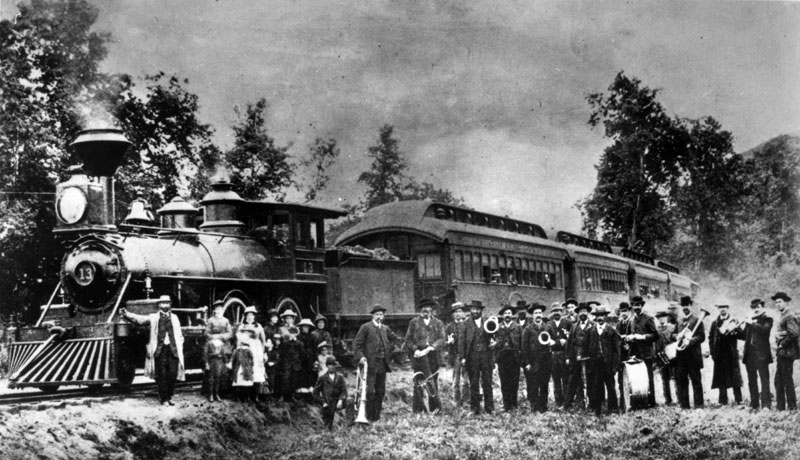 |
|
| (ca. 1888)* - Group photo was taken in the Arroyo Seco area. In the background is the California Southern R.R. (now the Santa Fe), locomotive #13, built in 1882. |
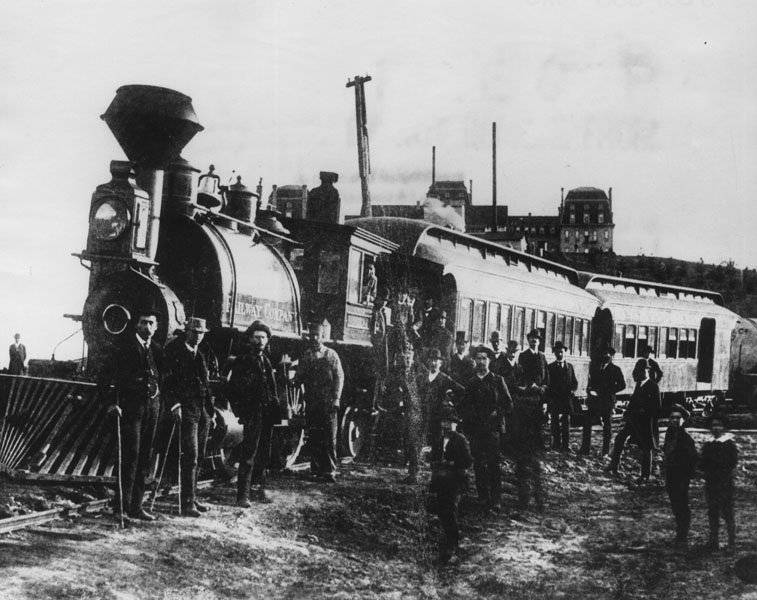 |
|
| (ca. 1888)* - The Los Angeles Terminal Railway in Pasadena near Raymond Hotel in background. |
Historical Background The Los Angeles Terminal Railway, earlier known as the Pasadena Railway, and unofficially as the Altadena Railway, was a small terminal railroad line that was constructed between Altadena and Pasadena, California in the late 1880s. It was a byproduct of a land boom period and a victim of the land bust that occurred soon thereafter. It opened officially on January 31, 1888. The service was originally organized as the Pasadena Railway Company in 1887 by investors John Woodbury, James Swartout, and the two prominent and wealthy Altadenans, Andrew McNally and Col. G. G. Green (aka) George Gill Green, mutual friends from with McNally from Chicago and Green from Woodbury, New Jersey.*^ Andrew McNally was the co-founder of the famed map making company Rand McNally in Chicago and had retired to Altadena in 1887. Green had made his fortunes in patent medicines and elixirs with his company based in Woodbury, New Jersey and was invited by McNally to move to Altadena in the same year. McNally and Green were heavily invested in the small railway, and each had a siding for his own private car to be pulled up alongside their properties which stood on either side of Santa Rosa Avenue from each other.*^ |
Andrew McNally Residence
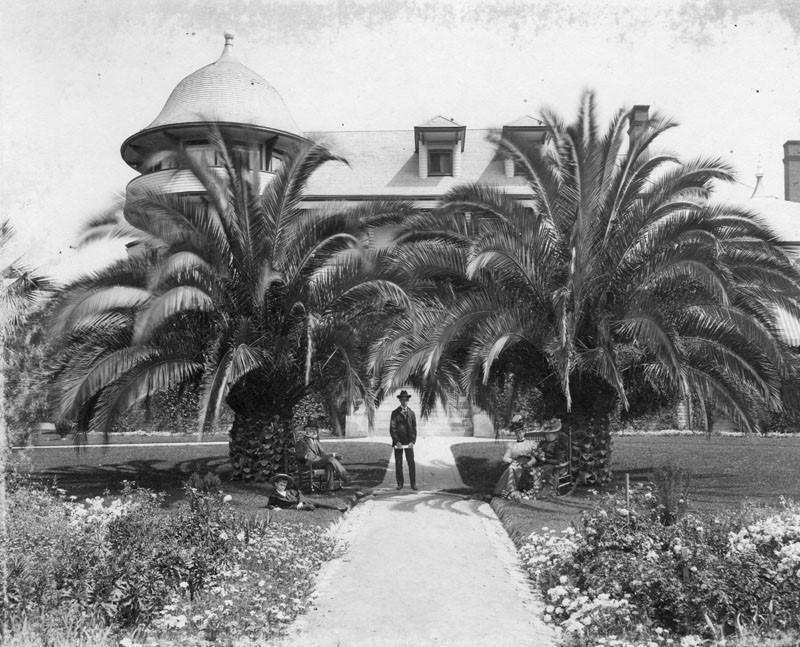 |
|
| (1888)* - View showing several people in front of the Andrew McNally residence in Altadena. The Queen Anne mansion is almost hidden by the palms. Frederick Louis Roehrig designed the home. |
Historical Background Andrew McNally was born in Armagh, Northern Ireland, and immigrated to New York City in 1857. A printer by trade, he moved to Chicago in 1858 and got a job in a print shop owned by William Rand at a wage of $9 per week. Rand and McNally became business partners and incorporated Rand, McNally & Co. in 1868, becoming one of the largest and best-known map publishers in history. After Rand retired in 1899, McNally was president until his unexpected death from pneumonia in 1904 at his winter home in Altadena. For nearly 100 years the company was majority owned and headed by several generations of the McNally family. In 1997, the family divested its majority stake for a reported $500 million.*^ |
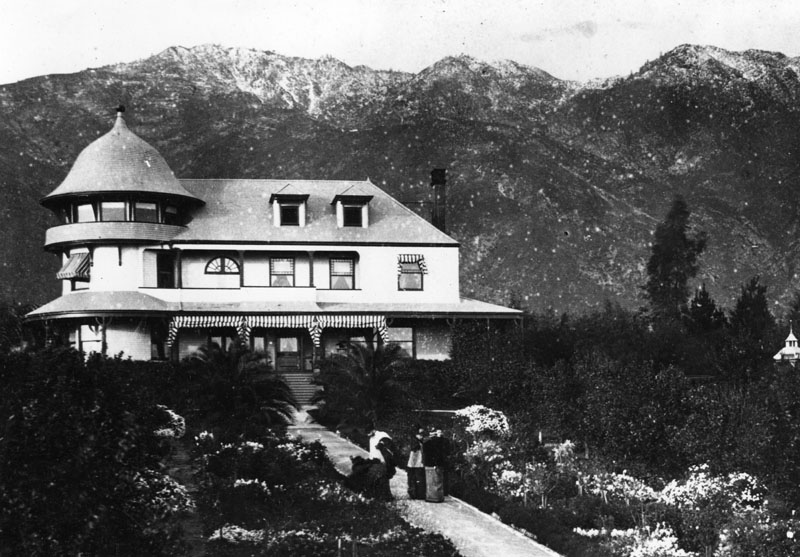 |
|
| (1888)* - Exterior view of the Andrew McNally residence on Mariposa Street in Altadena, with the San Gabriel Mountains in the background. |
Historical Background The McNally Queen Anne mansion was designed by architect Frederick Louis Roehrig and built in 1888. It is listed in the National Register of Historic Places.*^ |
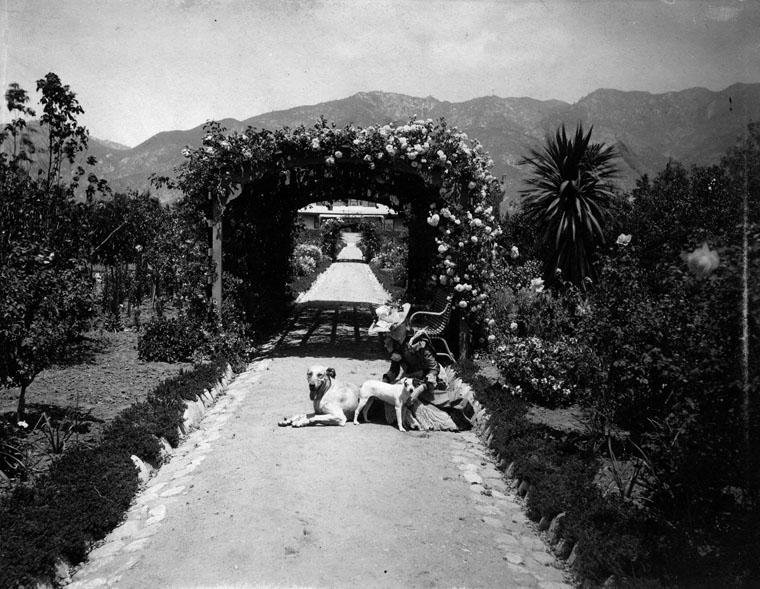 |
|
| (ca. 1888)* - View of a woman and two dogs on the path of the garden at the home of Andrew McNally, the well-known Chicago publisher. A partial view of the home may be seen past the arch of roses. Home is located on Mariposa Street and Santa Rosa Avenue in Altadena. |
Historical Background McNally paid Pasadena architect Frederick Roehrig $15,000 to design the Victorian house. Facing south, away from the street, the house offered vistas of the Los Angeles Basin, the Pacific Ocean, and Santa Catalina Island. The house has a three-story rotunda that allows a view to the San Gabriel Mountains to the north. McNally also built a private rail spur from Altadena Junction to his property to store his private railroad car.*^ |
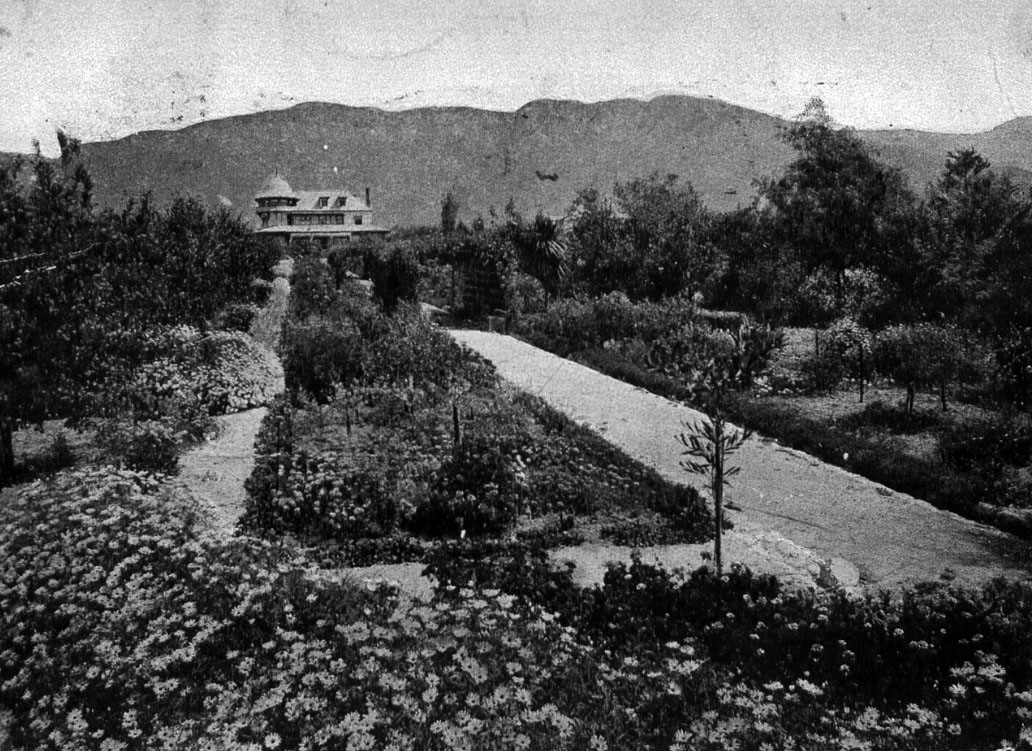 |
|
| (ca. 1900)*^ - Postcard view showing the McNally Residence and gardens. |
Historical Background The grounds were lavishly landscaped, with an aviary along Mariposa St. McNally's gardener also looked after the deodar cedars that grew along Santa Rosa Avenue. These trees became Christmas Tree Lane, which is also listed in the National Register. In 1904, McNally caught pneumonia while in route to his Windemere Ranch in La Mirada (The ranch headquarters is also listed in the National Register). He died shortly afterward. The gardens and aviary were neglected and some of the birds escaped. The property was then subdivided.*^ |
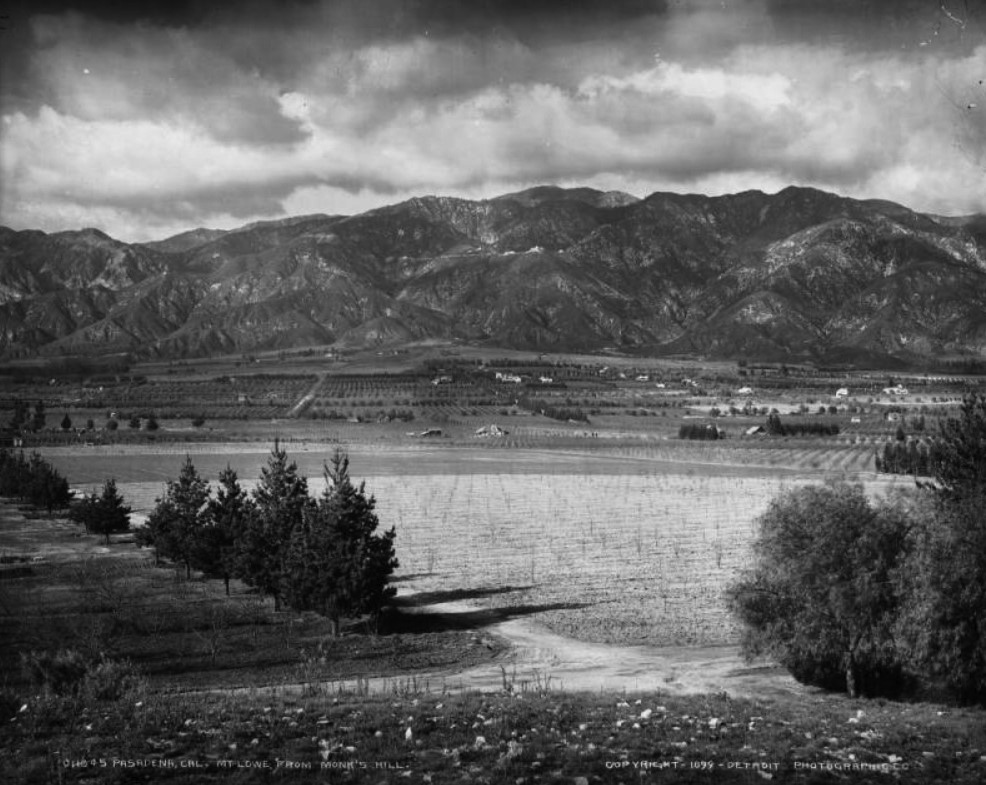 |
|
| (1899)* - View of Mt. Lowe from Monk's Hill on a cloudy day. Note the orange groves and vineyards in the foreground. The Echo Mountain House can be seen in the San Gabriel Mountains (top-center). On closer look you can make out Christmas Tree Lane with deodar saplings in the middle of photo. The McNally and Greene mansions are those buildings on either side. The dirt intersection in foreground is of Howard and Marengo. |
* * * * * |
Christmas Tree Lane
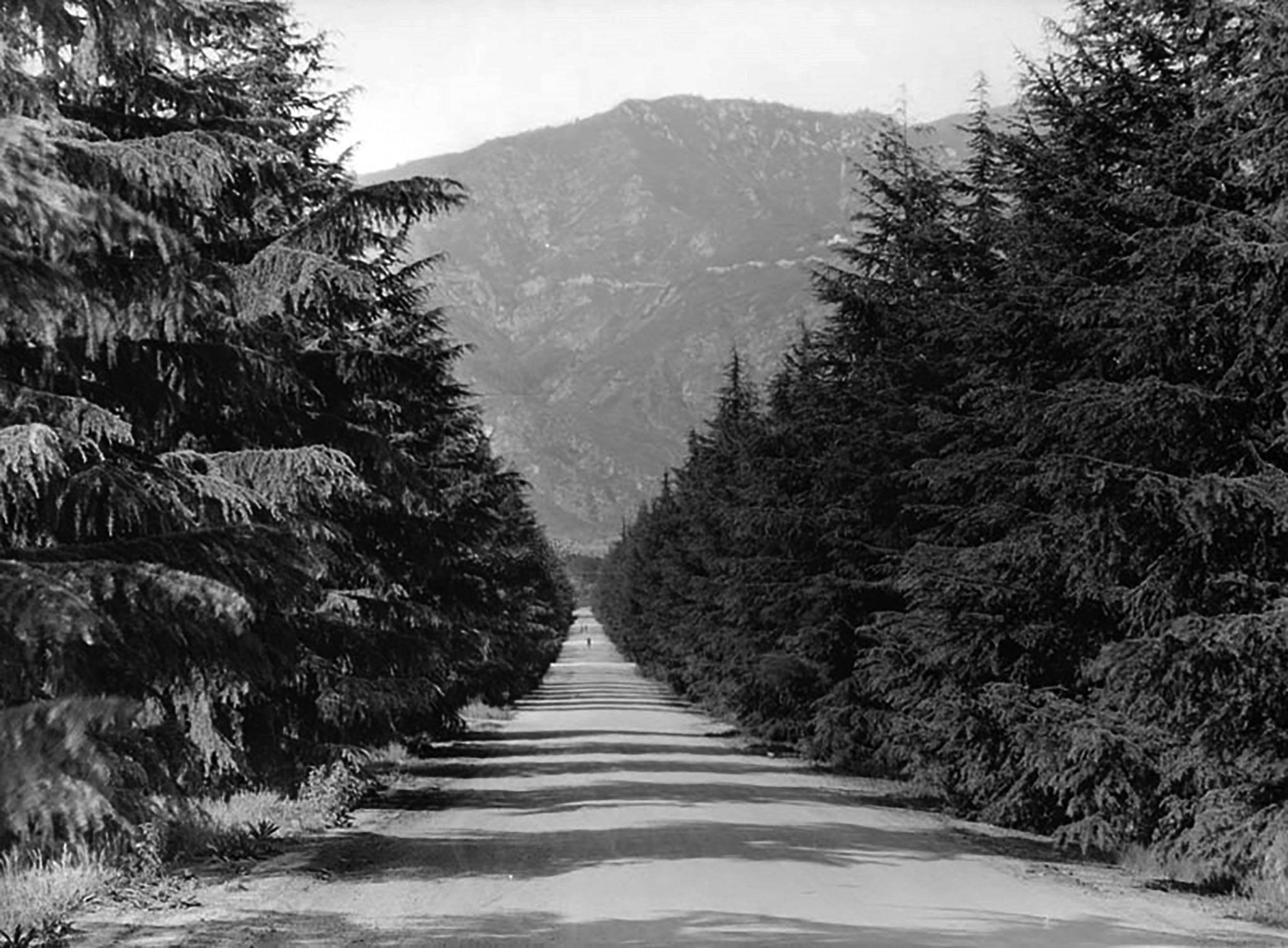 |
|
| (1915)* – View looking north along Santa Rosa Avenue in Altadena. This image was published five years before the holiday lighting tradition began and before the street became known as Christmas Tree Lane. |
Historical Background In 1885, real estate developer John P. Woodbury of the Woodbury family, founders of Altadena, planted 134 deodar cedar trees (Cedrus deodara) as part of a planned mile long entrance drive to a large estate he intended to build. The goal was to create a grand, park like boulevard that would enhance the surrounding land and attract development. The mansion was never constructed, but the trees flourished. Over time, the planned entrance drive became Santa Rosa Avenue, defined by the tall, evenly spaced deodar cedars that gave the street its distinctive character. |
.jpg) |
|
| (ca. 1928)* - Passengers in a car travel south on Santa Rosa Avenue, also known as Christmas Tree Lane in Altadena. The nickname was given to the street when the tradition of lighting the large deodar cedars with lights at Christmas time was started. Location: Santa Rosa Ave, both sides of street from Woodbury Rd to Altadena Dr, Altadena. |
Historical Notes The deodar cedar trees lining Santa Rosa Avenue were planted in 1885 as part of John P. Woodbury’s plan for a grand boulevard leading to a proposed estate. Although the mansion was never built, the trees shaped the street’s identity and created the setting that later made it ideal for a large scale holiday lighting display. The holiday lighting tradition began in 1920, when local residents and civic leaders decorated a portion of the street to celebrate the season. The display was well received and quickly became a yearly event. By the late 1920s, Christmas Tree Lane had become a popular destination for evening drives. Families slowly traveled the road to enjoy the lights, making it one of Southern California’s earliest and most enduring holiday traditions. |
 |
|
| (1938)* – A line of cars moves slowly beneath illuminated trees along Christmas Tree Lane during the holiday season. |
Historical Notes By the 1930s, Christmas Tree Lane was firmly established as a regional attraction. Visitors arrived by automobile from across the Los Angeles area, reflecting the growing car culture of the time. Traffic often moved at a walking pace, allowing drivers and passengers to fully experience the lights overhead. The trees created a tunnel like effect that made the drive feel both festive and intimate. Even during the Great Depression, the lights continued to be displayed. The tradition offered a sense of comfort and normalcy during difficult years. |
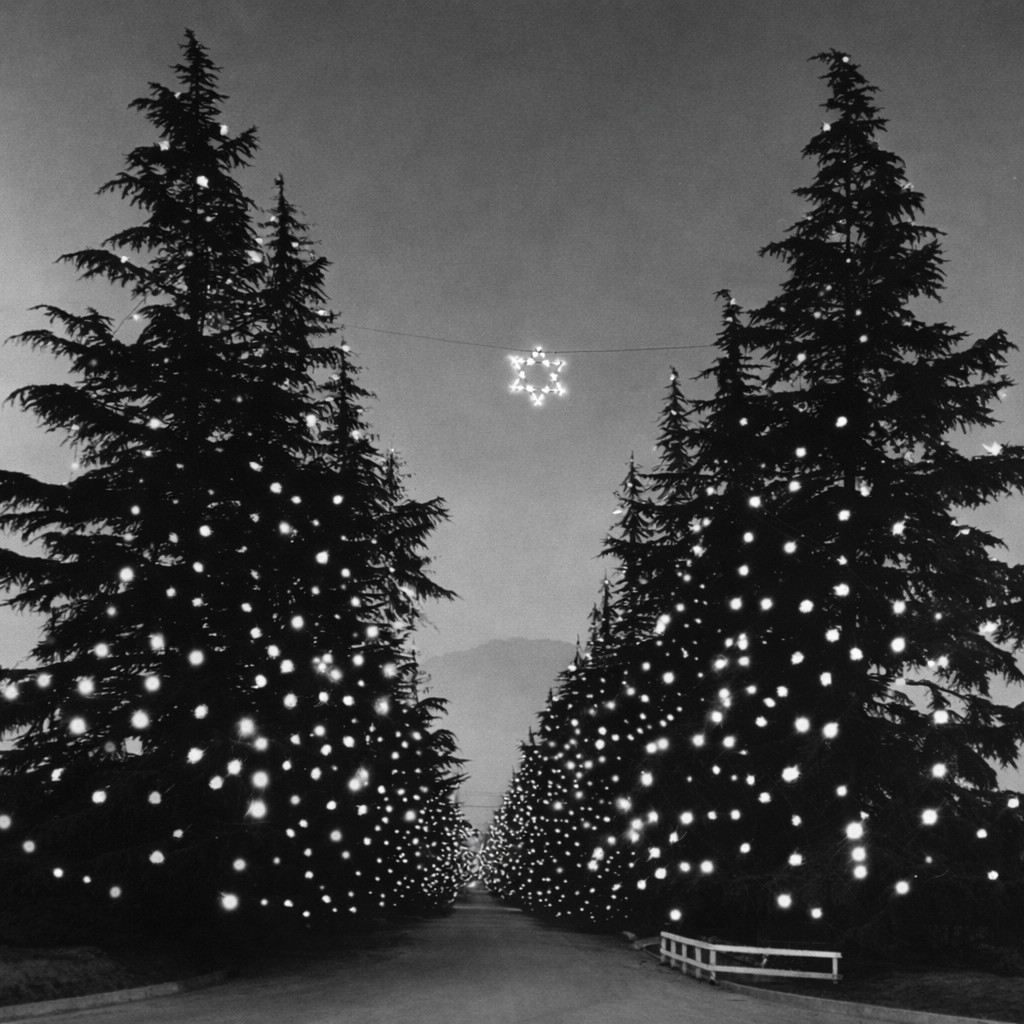 |
|
| (ca. 1947)* – Postwar view of Christmas Tree Lane showing the mile long stretch of illuminated deodar cedar trees. |
Historical Notes After World War II, Christmas Tree Lane returned as a bright symbol of peace and community. The postwar years helped solidify the name Christmas Tree Lane, which became widely used in newspapers and postcards. The Lane was not lit every year. During the mid 1940s, the lights were turned off for two seasons due to water shortages that affected hydroelectric power generation. The pause was temporary, and the tradition soon resumed. By the late 1940s, the display had grown into the full mile long stretch that continues today, maintained entirely by community effort. |
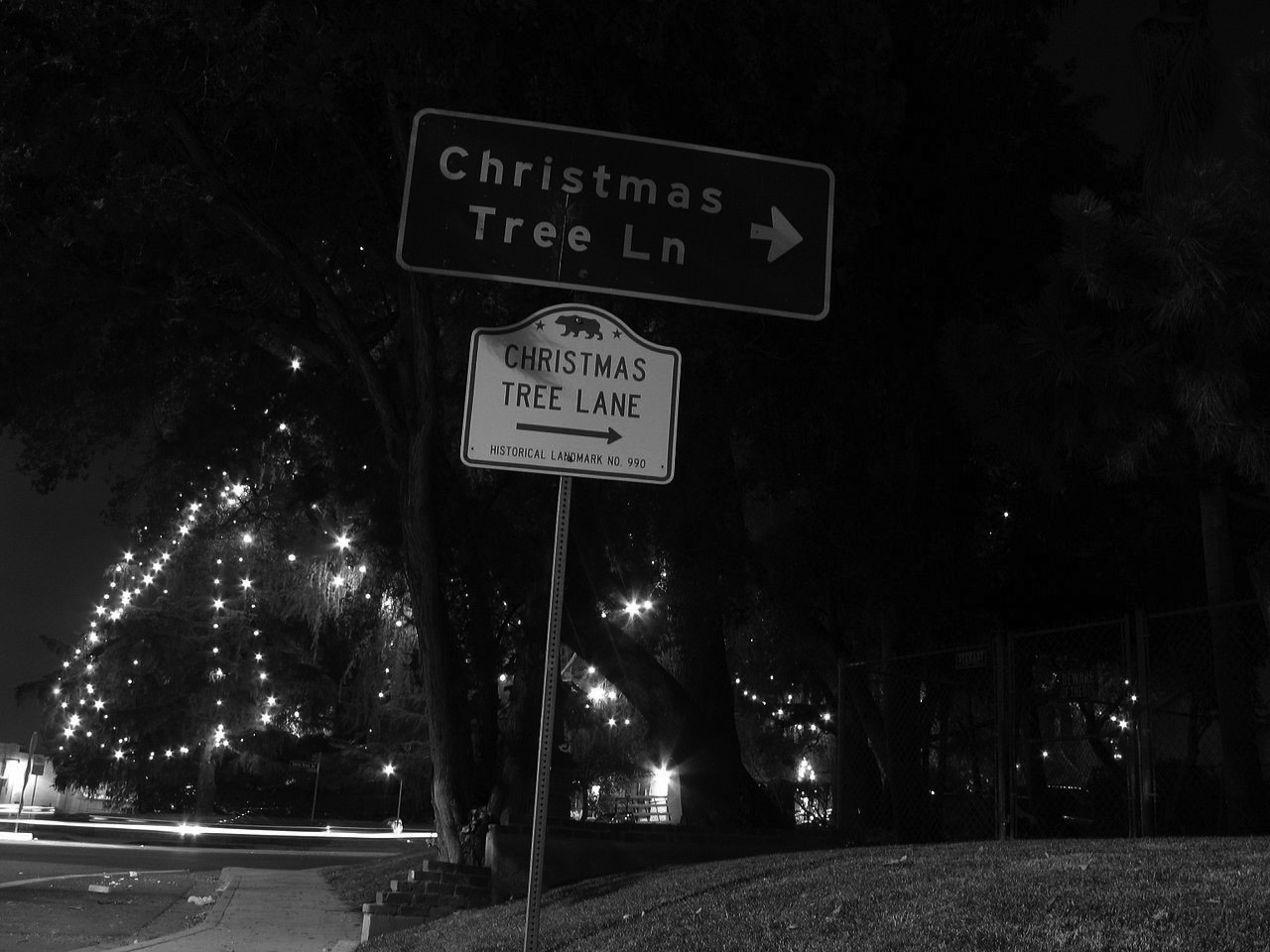 |
|
| (2006)* - Road sign marking Christmas Tree Lane, officially recognized as a California Historical Landmark. |
Historical Notes Christmas Tree Lane is designated California Historical Landmark No. 990. The designation recognizes both the historic deodar cedar trees and the long running holiday lighting tradition. The display is organized and maintained by volunteers. Each year, community members spend weeks repairing lights, testing wiring, and raising the strands into the trees using methods that have changed little over time. Christmas Tree Lane remains one of the oldest continuous holiday lighting traditions in the western United States. In early 2025, Altadena was affected by severe wildfires that damaged and destroyed thousands of homes, creating one of the most devastating disasters in the area’s history. Despite the destruction, the community chose to continue the Christmas Tree Lane tradition. Lighting the trees that year became a quiet act of resilience, offering comfort, continuity, and a shared sense of hope during a long period of recovery. |
* * * * * |
First Methodist Church
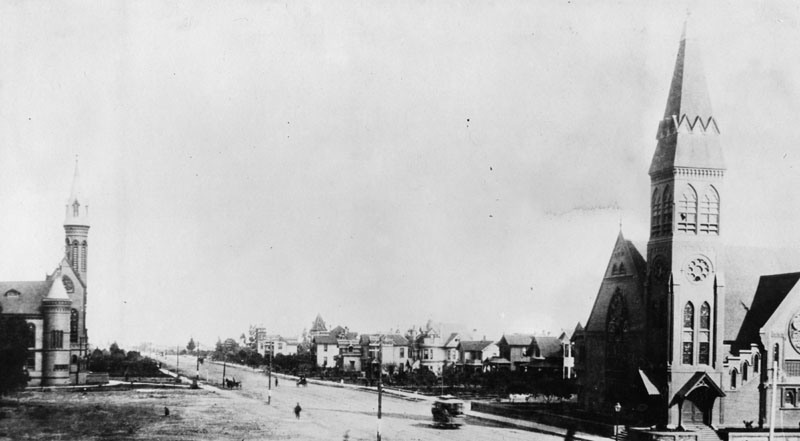 |
|
| (ca. 1888)* - View of Colorado Blvd. in Pasadena looking east from Marengo Ave. The church at right is First Methodist Church. The church at left is Pasadena Presbyterian Church, located on the northwest corner of Garfield Avenue and Colorado. |
Historical Background The United Methodist Congregation purchased land on the “hill” at the southeast corner of Colorado and Marengo. On March 20, 1887, a frame church with a 140-foot steeple and an adjacent eight-room parsonage were dedicated. The First Methodist Church was completed in 1888 and was also used as a kind of town hall. Susan B. Anthony and Dwight L. Moody spoke there, and the Siamese twins, Chang and Eng, displayed themselves there. Temperance, women’s suffrage and slavery were important issues at the time.*#^ |
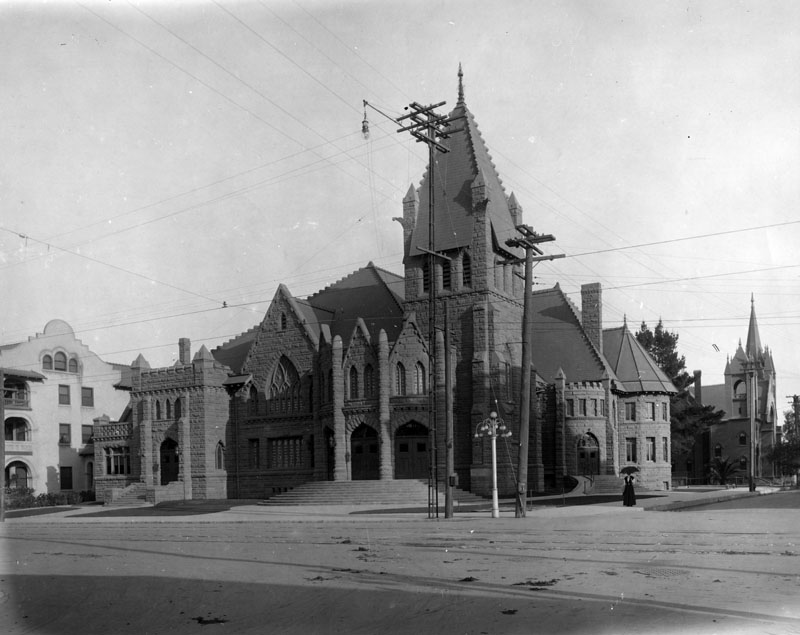 |
|
| (ca. 1901)* - Exterior view of First Methodist Episcopal Church at the southeast corner of Colorado Street and Marengo Avenue, in Pasadena; architect, John C. Austin. Portion of La Geralda Hotel shows at the left. |
Historical Background After the first church building was damaged by a tornado, a large stone church was built and dedicated on December 15, 1901 on the same corner. In 1923, the First Methodist Congregation completed its third church building located on Colorado Boulevard at Oakland Avenue where it resides today.*#^ |
Garfield School
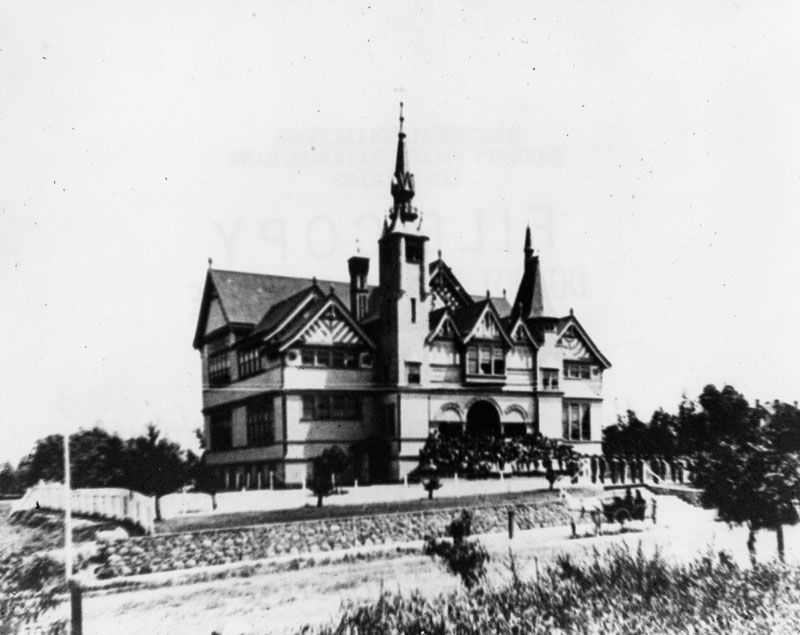 |
|
| (1888)* - Exterior view of Garfield School located in Pasadena. A horse-drawn carriage is parked in front of the school. |
Historical Background Built in 1888, Garfield School was located on the northeast corner of California Street and Pasadena Ave. It was first called the California Street School.** |
Scoville Bridge
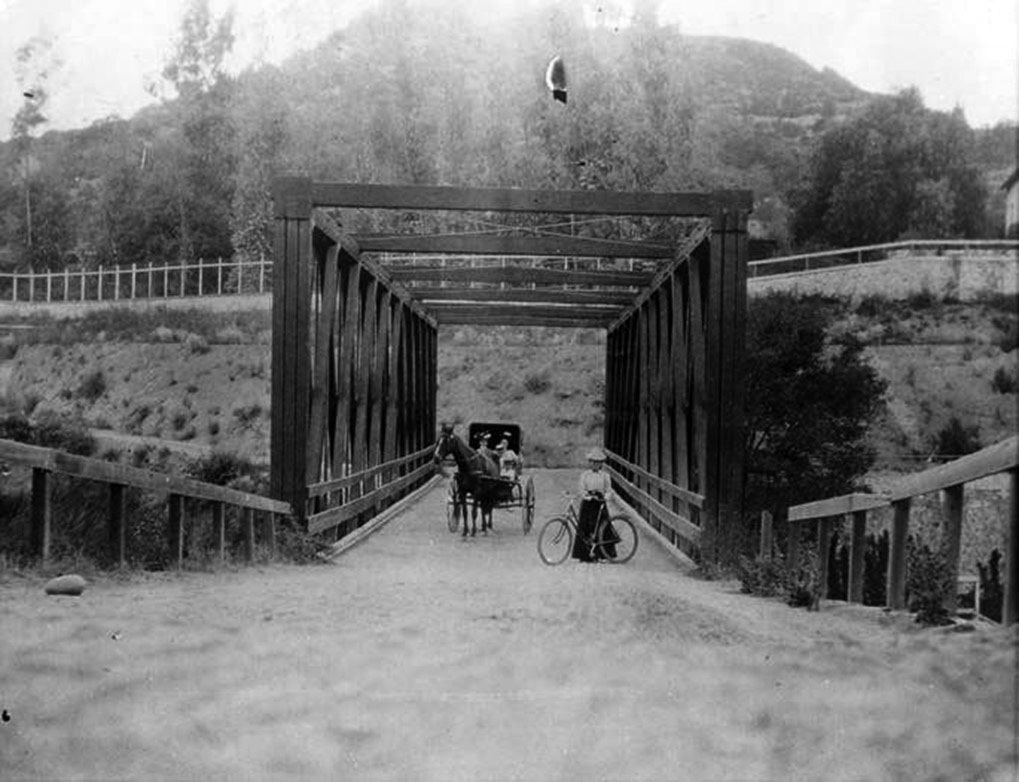 |
|
| (1889)* - The Scoville Bridge traversed the stream of the Arroyo Seco but still required travelers to descend into the ravine and then climb the opposite bank after crossing. |
Historical Background Pasadena was founded where it was exactly to take advantage of a reliable water supply, the Arroyo Seco ("Dry Gulch" in English). It was a reliable source of water in a rather dry environment. However the Arroyo Seco was also a problem, it was deep in a steep sided canyon. This meant that Pasadena was physically isolated from its western neighbors. Travelers would have to make long detours passable crossing north or south of Pasadena. This was finally changed by James Scoville who built his bridge in 1887. * |
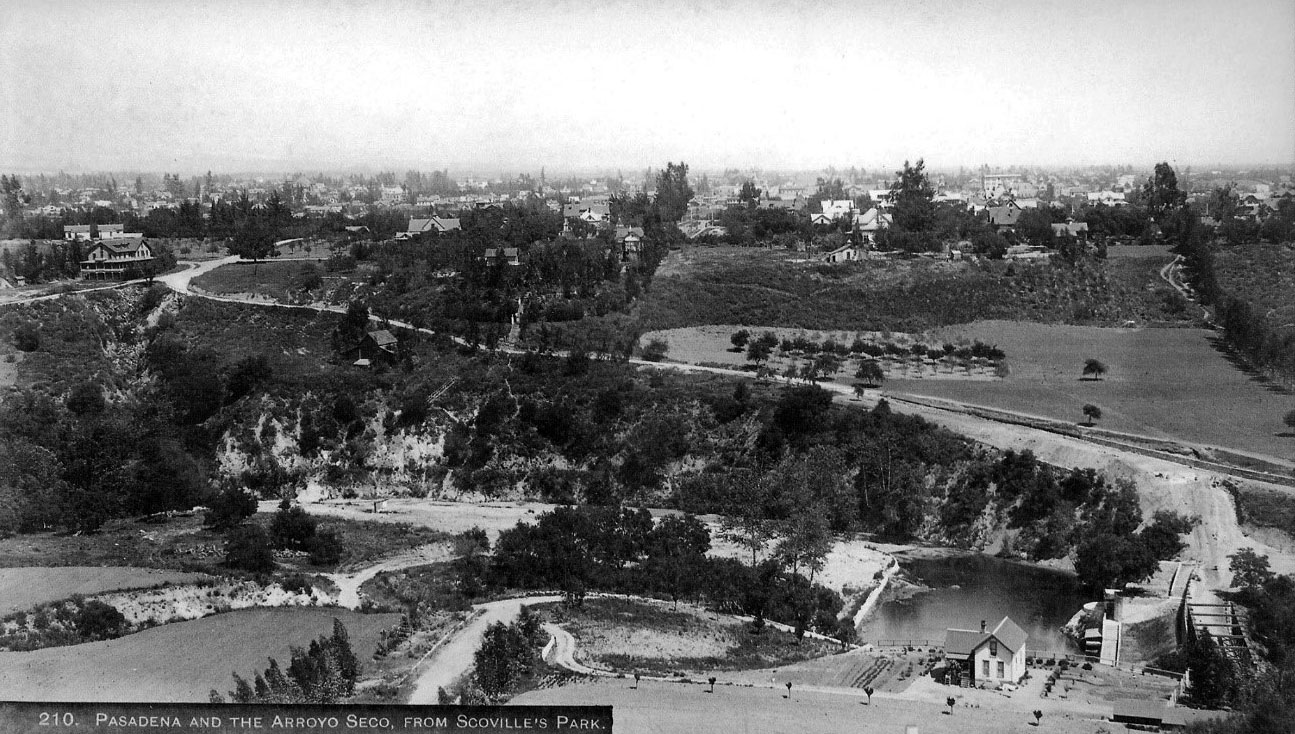 |
|
| (ca. 1890)++# - View looking east showing the Scoville Dam, Scoville Bridge, and City of Pasadena beyond. The dam and bridge are in the lower right corner. |
Historical Background Arroyo Drive crosses right to left rising to the junction with what is now W. Holly Street at left. W. Holly continues east to its intersection with N. Grand St., which at the time was connected to S. Grand Street below Colorado, and west to the Linda Vista Bridge. The Green Hotel can be made out at rear right. The place where the photo was taken was itself obliterated by the construction of the 134 Freeway.++# |
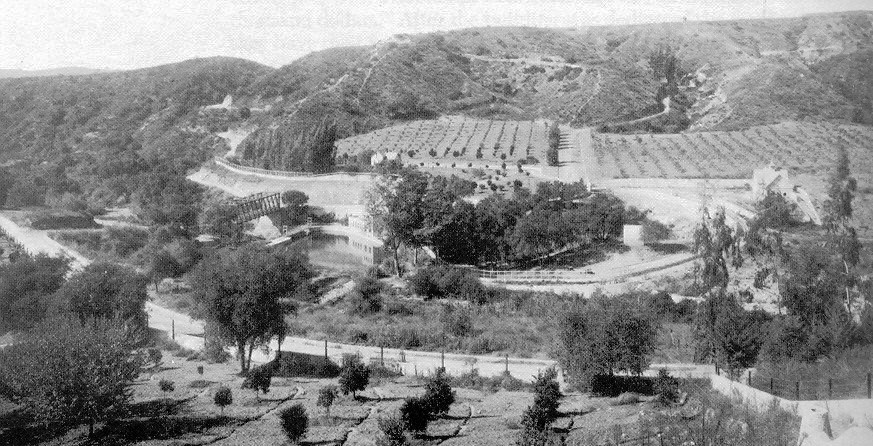 |
|
| (ca. 1905)++# - View of the Scoville Bridge, Dam and surrounding area. Photograph by A.C. Vroman. The dam and bridge were built 1887-1903; Note: S. Arroyo Blvd. is in the foreground. |
Historical Background James Scoville had been the Vice President of the Elgin Watch Co., President of the Prairie State Bank, and a trustee of what would later be known as California Institute of Technology. He built a pleasure garden on the bluff above the Arroyo Seco which went down the slope of the canyon walls to the stream itself. There he built a small dam and pump house. The top of the dam served as the eastern abutment of a wooden bridge, the first to connect Pasadena to the western side of the Arroyo. * |
.jpg) |
|
| (ca. 1905)++# – Closer view showing the Scoville Bridge, Dam and Pump House. |
Historical Background Scoville commissioned the construction of a timber truss-leg bridge to improve hauling, and a dam to provide water for irrigating crops and generating power. The bridge was a reused train trestle, left unused by the Atchison, Topeka and Santa Fe Railroad. The trestle was placed upside-down across the stream bed, and set in a concrete foundation on either side.* |
Colorado Street Bridge
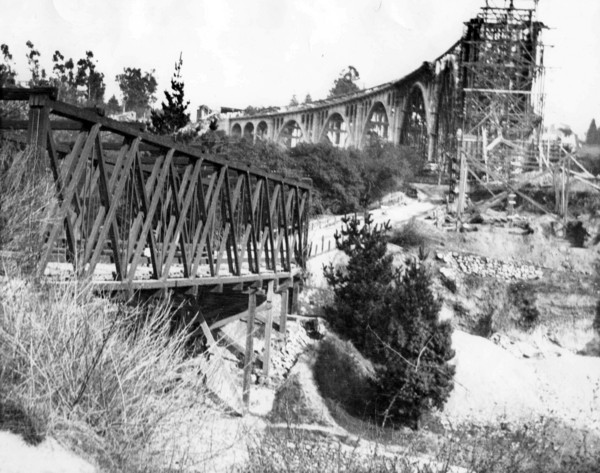 |
|
| (ca. 1913)*#* - A view of the Scoville Bridge next to the partially completed Colorado Street Bridge. |
Historical Background Scoville Bridge was still in service when the much larger and grander Colorado Blvd. Bridge was built above it. |
 |
|
| (1913)^ - View looking north at the Colorado St. Bridge under construction with the Scoville Bridge behind. |
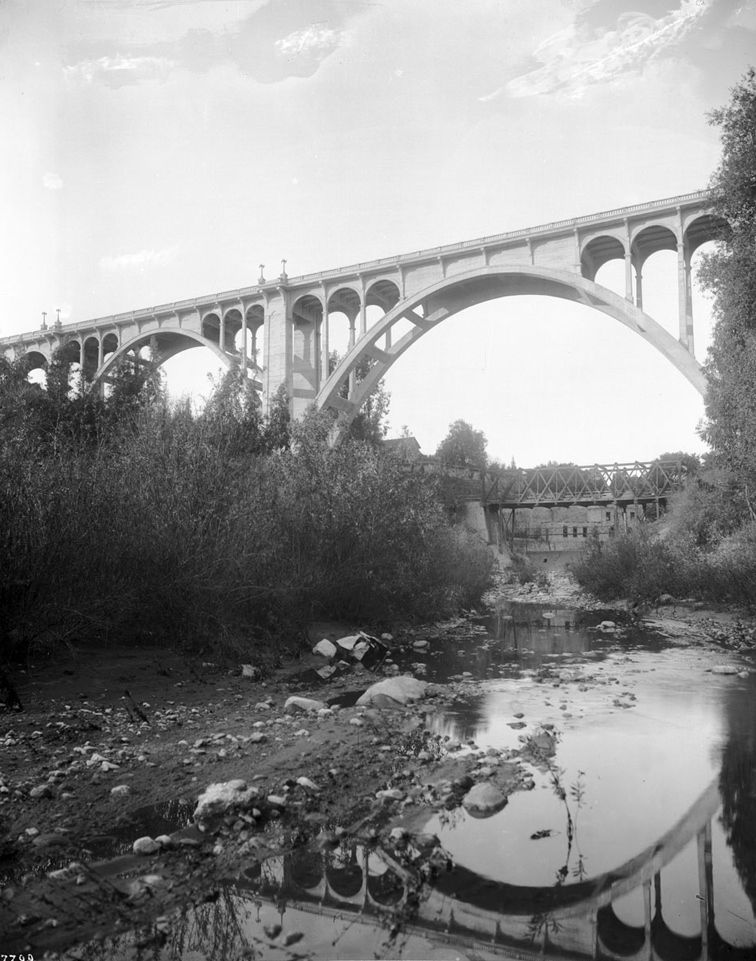 |
|
| (1914)^ - View looking up towards the newly completed Colorado Street Bridge. In the distance stands the Scoville Bridge shortly before a flood brought it down. |
Historical Background Scoville's original bridge survived until the flood of 1914, when the trestle was carried all the way down the Arroyo Seco and into the Los Angeles River. ++# Click HERE to see more early views of the Colorado Street Bridge. |
Parker-Mayberry Bridge
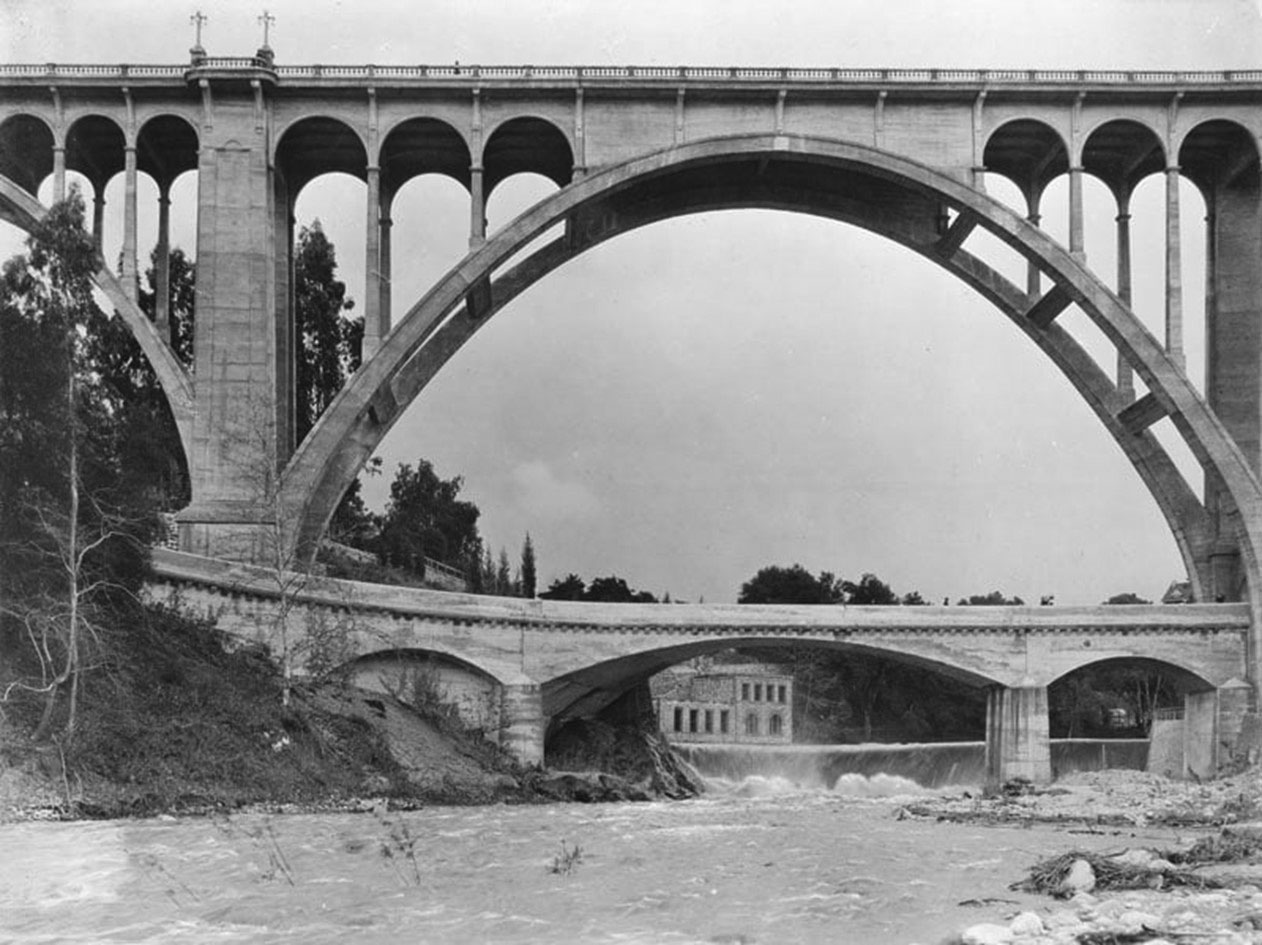 |
|
| (1919)* - The Parker-Mayberry Bridge, shortly after being completed with the Colorado Street Bridge right behind it. It replaced the Scoville Bridge which was destroyed by a flood in 1914. |
Historical Background Six months after the opening of the Colorado Street Bridge, a new bridge to cross the stream below it was commissioned by William Smith Mason of Chicago to give access to his property on the west side of the Arroyo, the new bridge was to be of reinforced concrete. The old Scoville Bridge and dam had been washed out in floods in early 1914, limiting Mason’s access to his property. The new bridge and dam, designed in conjunction with architectural engineers Edward Mayberry and Llewellyn Parker, spanned the stream directly beneath the piers of the big bridge, with graceful arches curving over its narrow roadway, only 18 feet wide on the eastern approach, but widening to 60 feet on the west. |
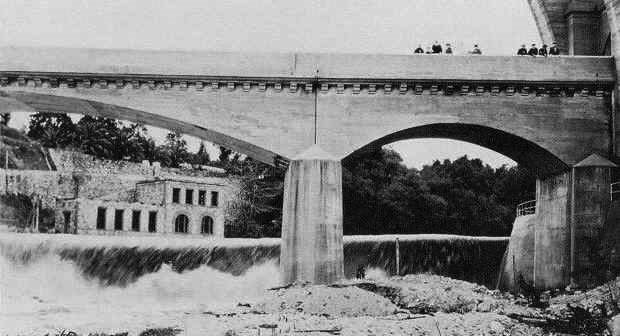 |
|
| (ca. 1920)^ - View of the Parker-Mayberry Bridge built to replace the Scoville Bridge. The Colorado Street Bridge is seen at upper-right. The structure at left rear is the pump house which contained the equipment necessary to pump water from the Scoville Dam up to the Orange Groves on the east side of the Arroyo. |
Historical Background The new Parker-Mayberry Bridge was approximately 150 feet long with a single broad arch over the stream. The design for the new bridge used classical details to harmonize with the main bridge above. The cost of about $50,000 was borne by Mr. Mason. |
 |
|
| (2022)* - A hiking group walks over the Parker-Mayberry Bridge with the Colorado Street Bridge directly above. Photo by Martin Thompson |
* * * * * |
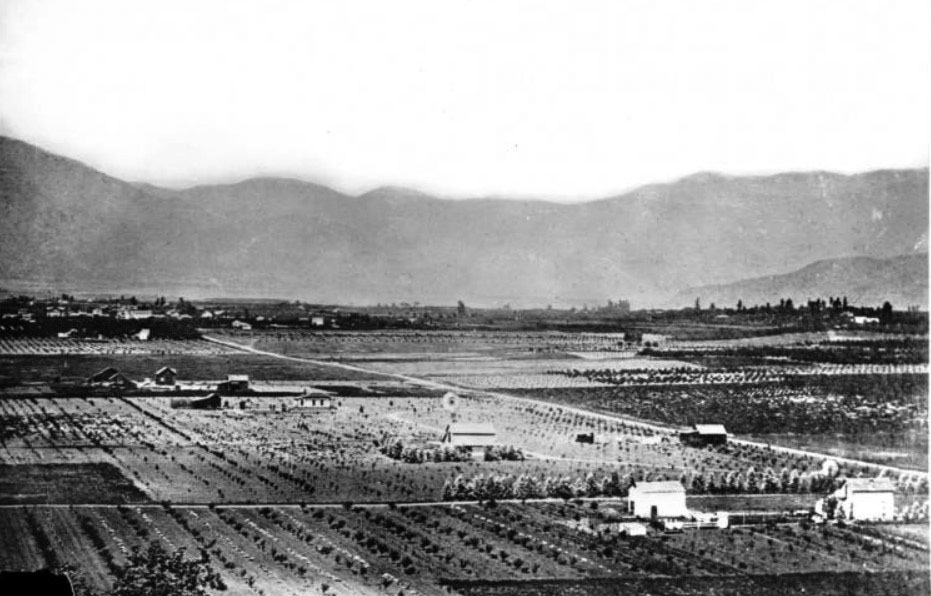 |
|
| (ca. 1889)^ - Panoramic view of Pasadena looking north from Raymond Hill. Sparse houses are separated by burgeoning agricultural fields. A house with a windmill-style weathervane stands at center and the San Gabriel Mountains are visible in the background. |
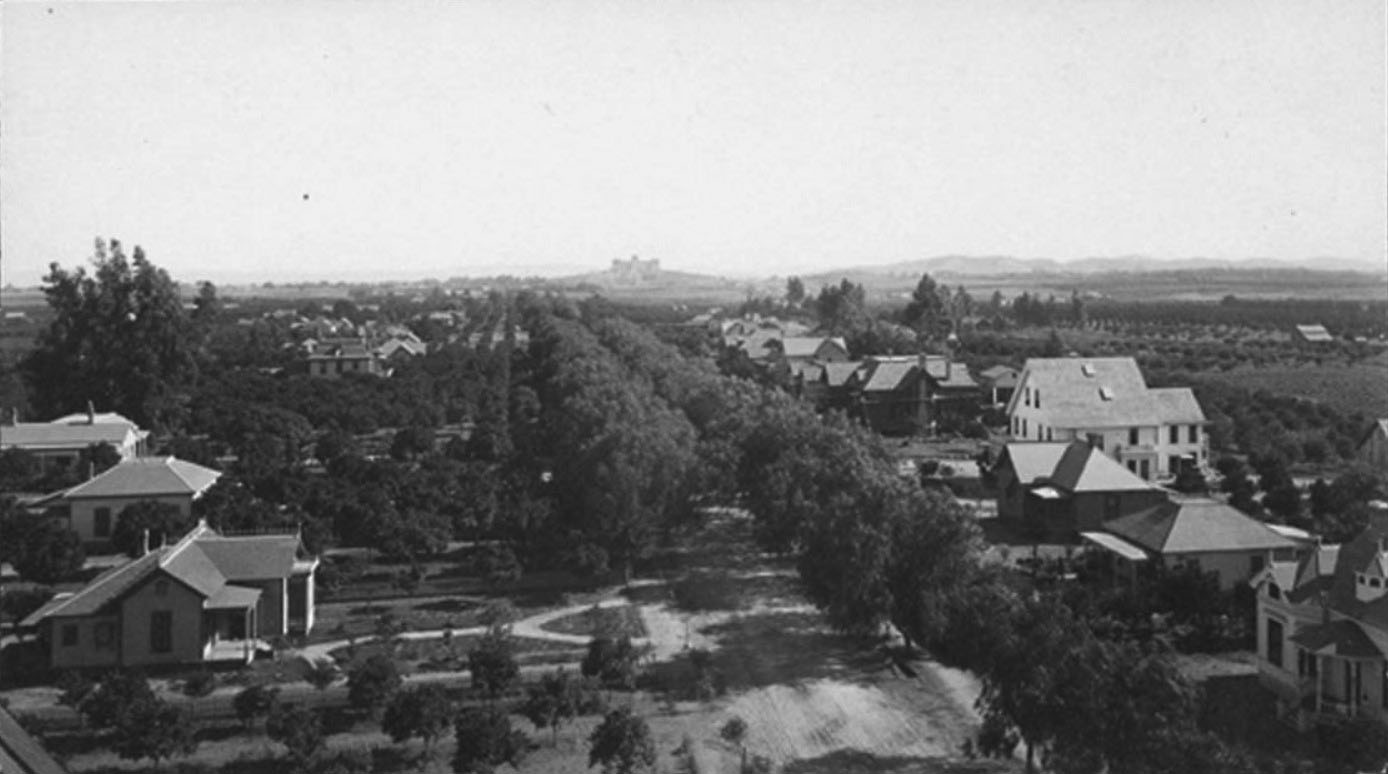 |
|
| (ca. 1889)*^* – Panoramic view of Pasadena looking south from the Methodist Episcopal Church on corner of Colorado St. & Marengo Ave. Orange groves are seen in the southwest with the Raymond Hotel on the hill in the far distance. A tree-lined dirt street and homes are in the foreground. |
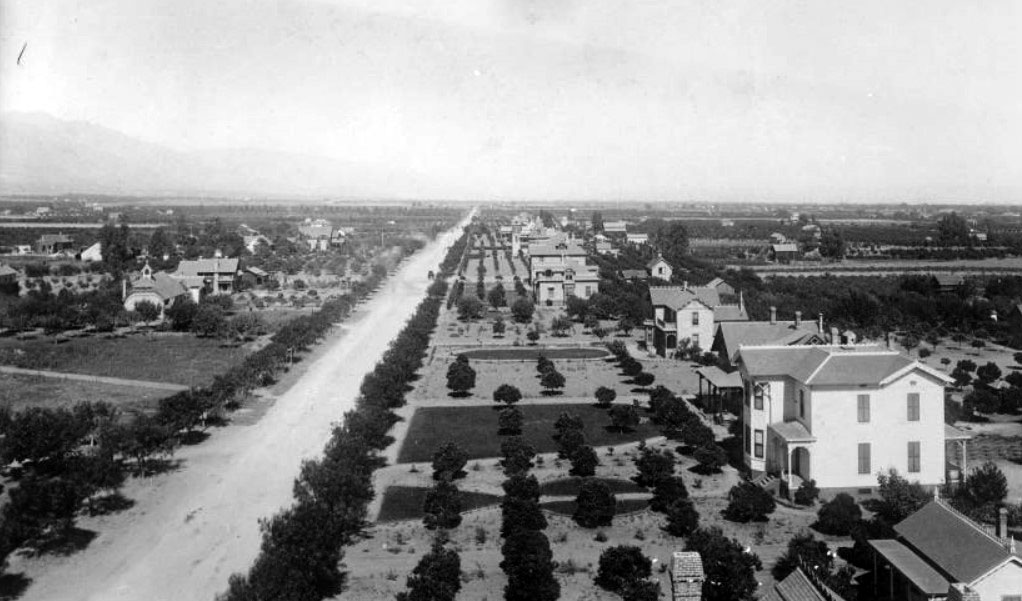 |
|
| (1889)#*- An elevated street view of Colorado facing east, taken from the Methodist Episcopal Church, at the corner of Colorado and Marengo. The street is residential, with houses set well back behind large lawns. "C.S. Frost & Sons Pasadena, Cal." is printed below the image. A typescript note attached to the top of the image reads "M.E. Church, corner of Colorado St. & Marengo Ave. looking east. 1889." |
.jpg) |
|
| (ca. 1890)^ - View of Pasadena looking north. The San Gabriel Mountains loom in the background over the closely-situated houses and buildings of the city whose crop rows are interspersed between them. The bell tower of the school at Colorado Street and Fair Oaks Avenue is visible at center about halfway from the bottom of the frame A water tower and a larger building are visible on the horizon in the left distance along with the mountains across the entire background. |
Colorado Street
 |
|
| (1889)* - A brass band heads the funeral cortege of Owen Brown, third son of the famous abolitionist, John Brown. The photo was taken January 10, 1889, looking east from Raymond Avenue along Colorado Blvd. The hill is at Marengo Avenue and was sliced away when Colorado was leveled in later years. The City Meat Market is on the left. |
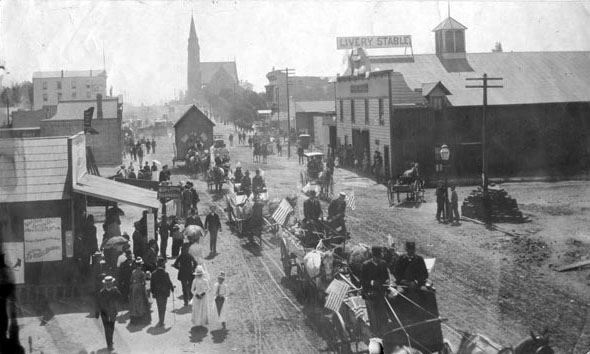 |
|
| (ca. 1890)*#* - View of Colorado Boulevard, then named Colorado Street, looking east to Marengo Avenue. Horse-drawn wagons with displaying america flags appear to be in a parade (possibly 4th of July). |
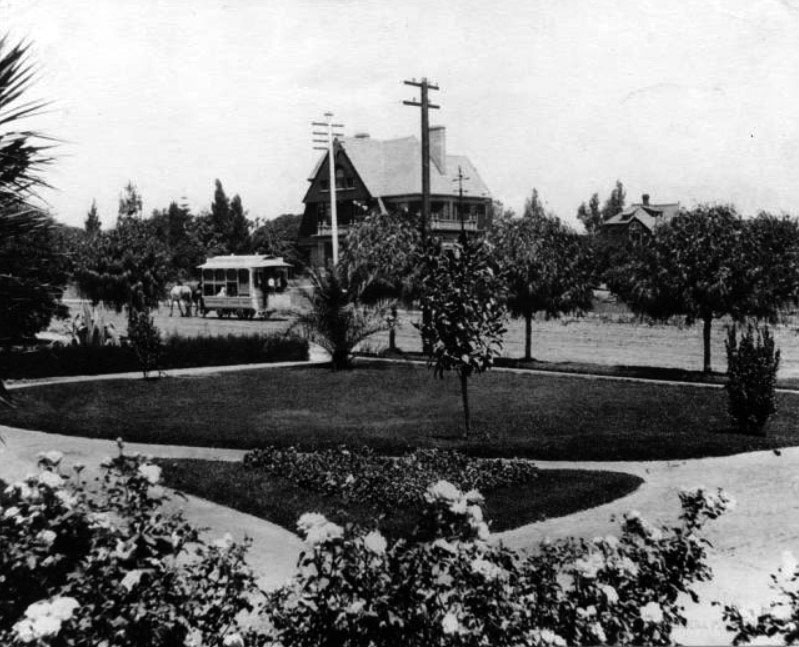 |
|
| (1890)*^* – View showing a horse-drawn streetcar on Colorado Street where Oakland now intersects. |
Old Town Pasadena
 |
|
| (ca. 1887)*^* - Memorial Day Parade looking east on Colorado Street at Fair Oaks. The Carlton Hotel (built in 1886) is seen on the left. San Gabriel Valley Bank is on the right. |
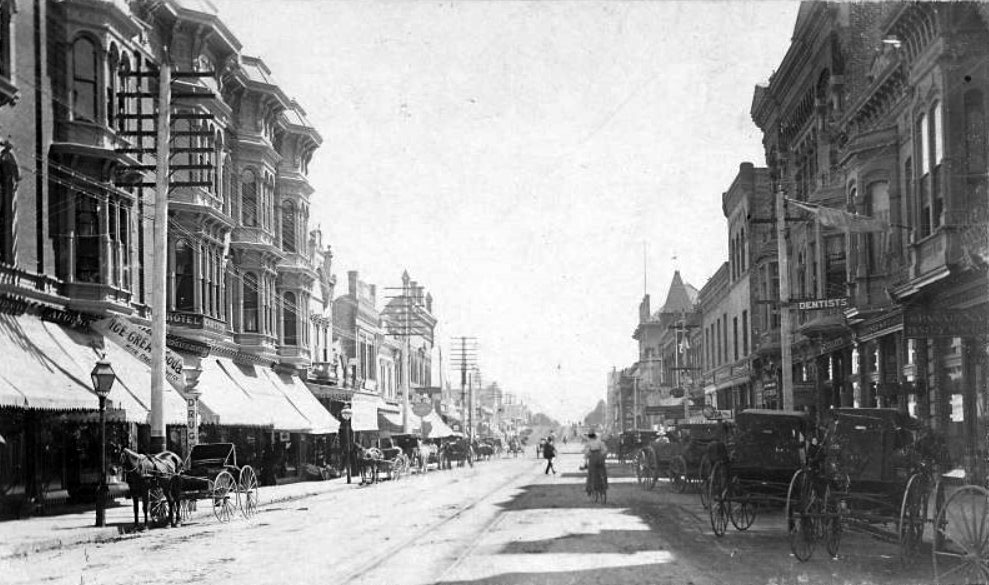 |
|
| (1887)** – View looking east along Colorado Street from Fair Oaks Avenue showing horse-drawn wagons parked along the curb. The Carlton Hotel stands on the left. |
Historical Notes Colorado Street was lined with shops and restaurants, and parking could at times be an issue. In the 1880s, parking was still a matter of finding a place to leave one's horse and carriage. |
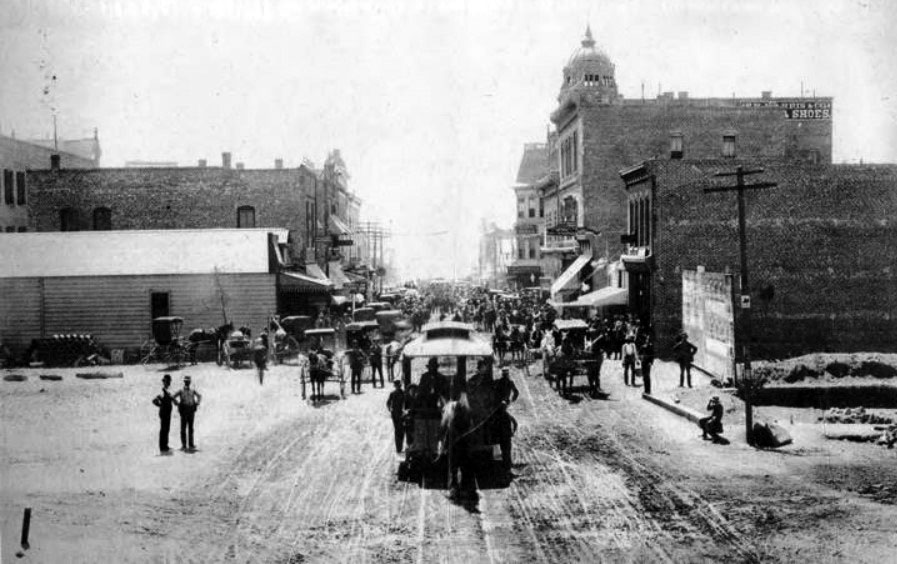 |
|
| (ca. 1889)** - View of Fair Oaks Avenue looking south to Colorado. At center, a horse-drawn trolley moves toward the camera. In the background, a very congested Fair Oaks Avenue with scores of horse-drawn carriages on both sides of the street. |
Historical Notes Residents would come here for shopping, community gatherings, or entertainment. Despite Pasadena's relatively small population, this densely compacted commercial district had the excitement and activity found in much larger cities. Colorado Street was frequently filled with horses, buggies, wagons, and pedestrians, along with horse-drawn streetcars in the late 1880s. |
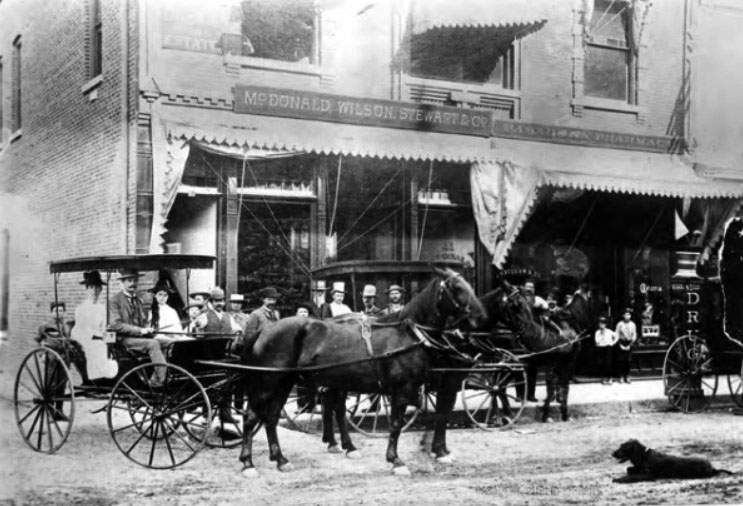 |
|
| (ca. 1889)** - This photo displays the buildings located on North Fair Oaks Avenue near the intersection of Fair Oaks and Colorado Boulevard in the year 1889. View shows a horse and buggy, several men and women, and a dog on the unpaved road in the foreground. |
Historical Notes The windows display the real estate company of McDonald, Wilson, Stewart & Co. at No. 11 N. Fair Oaks and the druggist J.H. Bellan & Co. at No 9. Although the western side of Fair Oaks maintains even addresses today, the decreasing numbers as one goes to the right suggest that this is the East side of the street. These buildings are also next to Barney Williams' Hall, one of the first buildings built at this intersection and Pasadena's center for entertainment at that time.** |
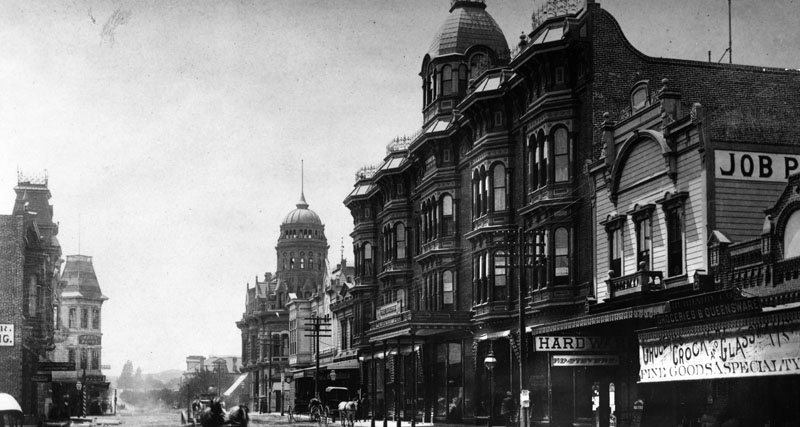 |
|
| (1890)* - Colorado Street (now Boulevard) near Fair Oaks Avenue in 1890. The large building at center-right is the Carlton Hotel. |
Historical Notes Colorado Street was renamed "Boulevard" through Old Town Pasadena from Arroyo Parkway to Orange Grove Boulevard in 1958.*^ |
 |
|
| (1890)* - View of Colorado and Fair Oaks Avenue in Pasadena, in 1890. Many storefronts can be seen on both sides of the street. On the left, there is: San Gabriel Valley Bank, a Drugs store and a Boots and Shoe store. On the right, there is: Oneill & Johnson Real Estate Insurance, a candy factory, Phillips Land & Real Estate Loans, and also the Ward Block building which includes the First National Bank. A trolley runs down the middle of the street and shares the road with horse-drawn vehicles. |
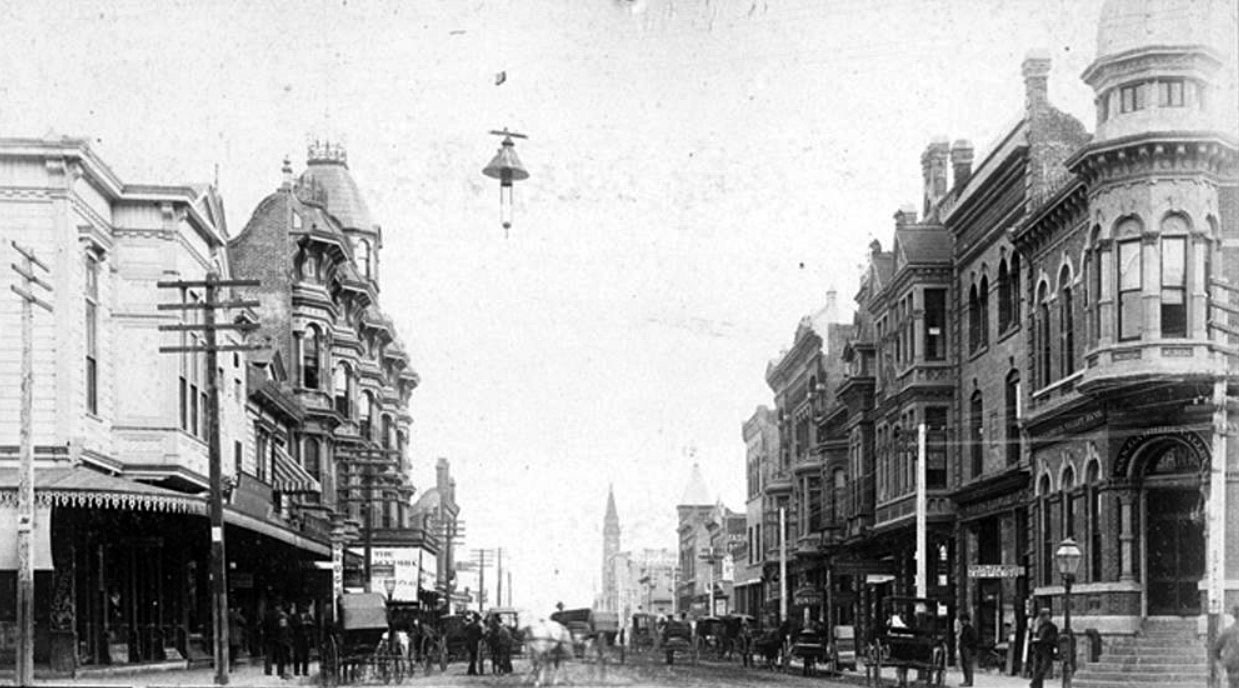 |
|
| (ca. 1890)*^* - Photo showing a vibrant day on Colorado Street (later Boulevard) looking east from Fair Oaks. The San Gabriel Valley Bank is at right (S/E corner). A streetlight hangs over the middle of the intersection. |
Historical Notes The San Gabriel Valley Bank, the building to the far right, was organized in February 1886 and moved to this location in 1887.*^* |
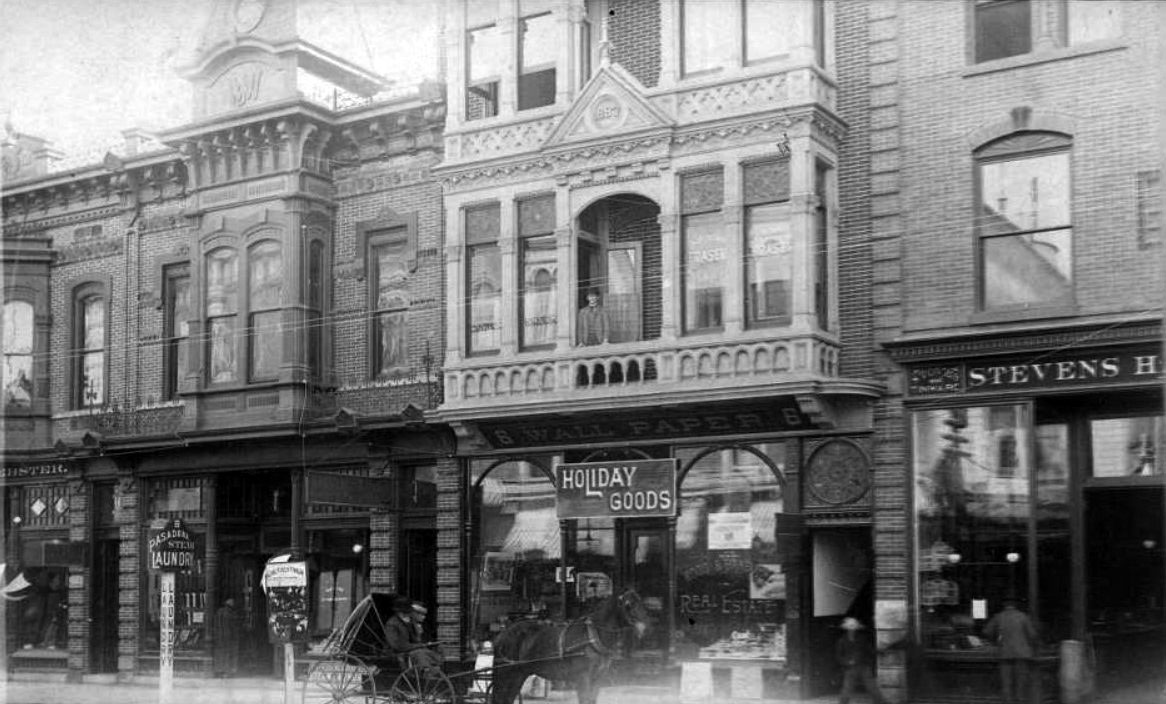 |
|
| (ca. 1890)** – View looking at the south side of Colorado Street just east of Fair Oaks showing a series of connected buildings, also referred to as the Fish Block, covering 24-28 E. Colorado. Signs include: PASADENA STEAM LAUNDRY, HOLIDAY GOODS, and WOOD & BANBURY REAL ESTATE. A horse-drawn carriage with passengers is parked in the foreground of the photo. |
Historical Notes The Fish Block on 26 E. Colorado Street was the YMCA headquarters in 1890. Built by Mr. Milford Fish in 1887, it was the site of offices of two Iowans: Mr. Wood and Mr. Banbury (one of Pasadena's founders). ** |
Pasadena's First Theater
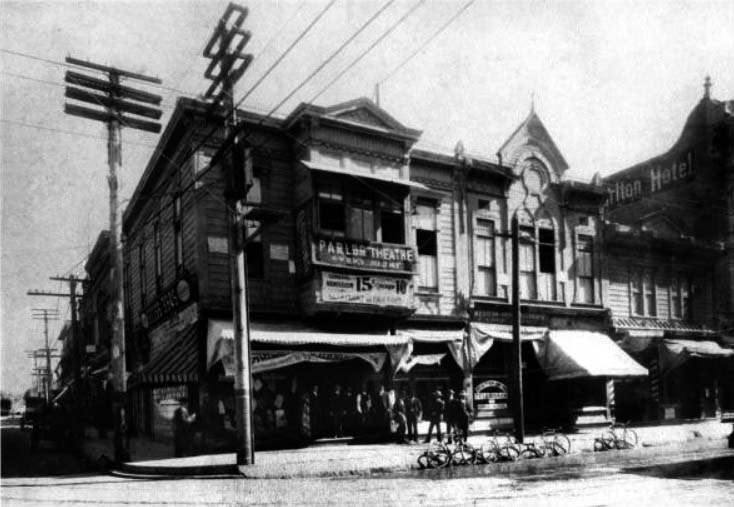 |
|
| (1890s)** - Exterior view of the Williams Hall Parlor Theatre, Pasadena's first theatre. It was located on the Exchange Block at Colorado. On the left side of the building we're looking north up Fair Oaks Ave. |
Historical Background The Williams Hall Parlor Theatre was Pasadena's first theatre. It was located on the northeast corner of Colorado Blvd. and Fair Oaks Ave. in second floor space.** |
* * * * * |
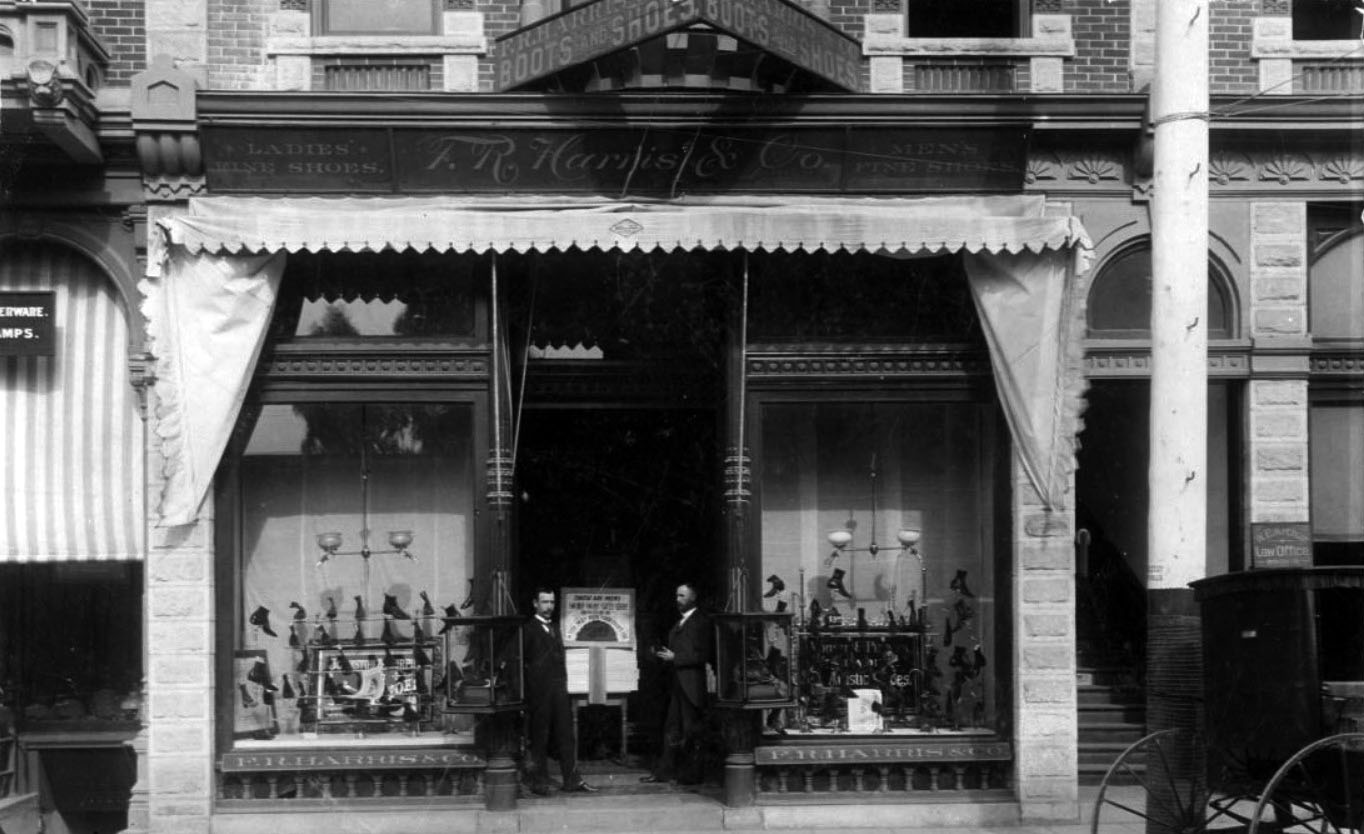 |
|
| (ca. 1892)** – Two men stand in the entryway of the Harris Shoe Store located on the north side of Colorado, near Raymond. |
Historical Notes The Harris Shoe Store was located at 7 - 9 West Colorado. Proprietor, F. R. Harris, is standing on left, and clerk C. D. Sargent is standing right. ** |
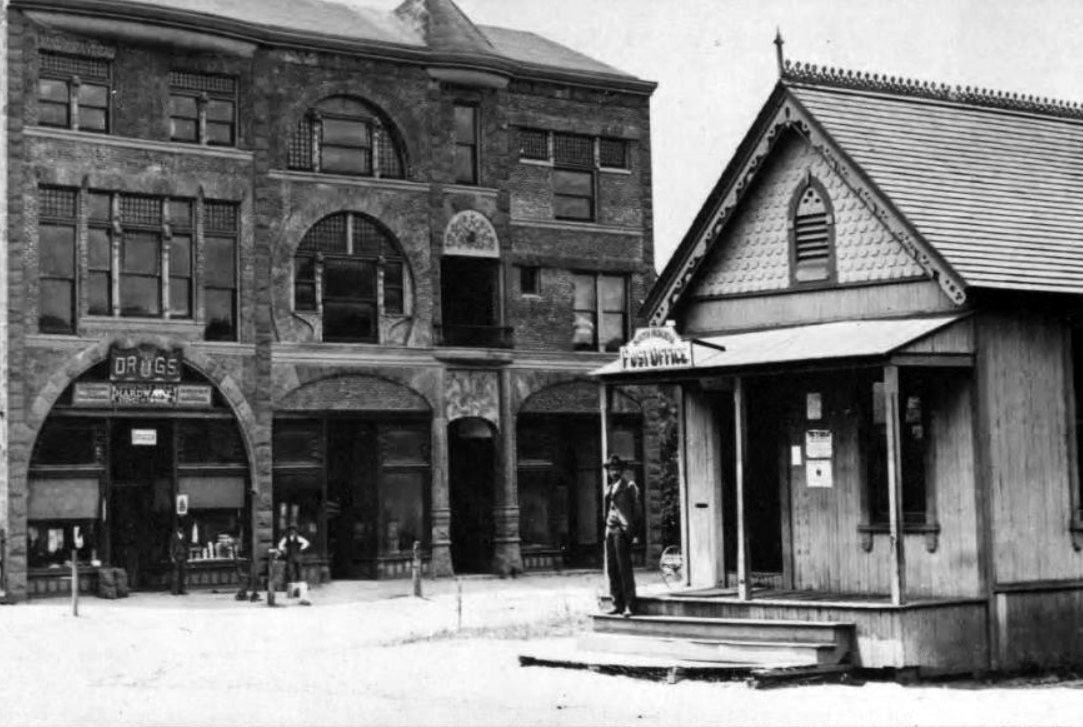 |
|
| (ca. 1888)^#^^ – South Pasadena Postcard showing Opera House Building and Post Office. |
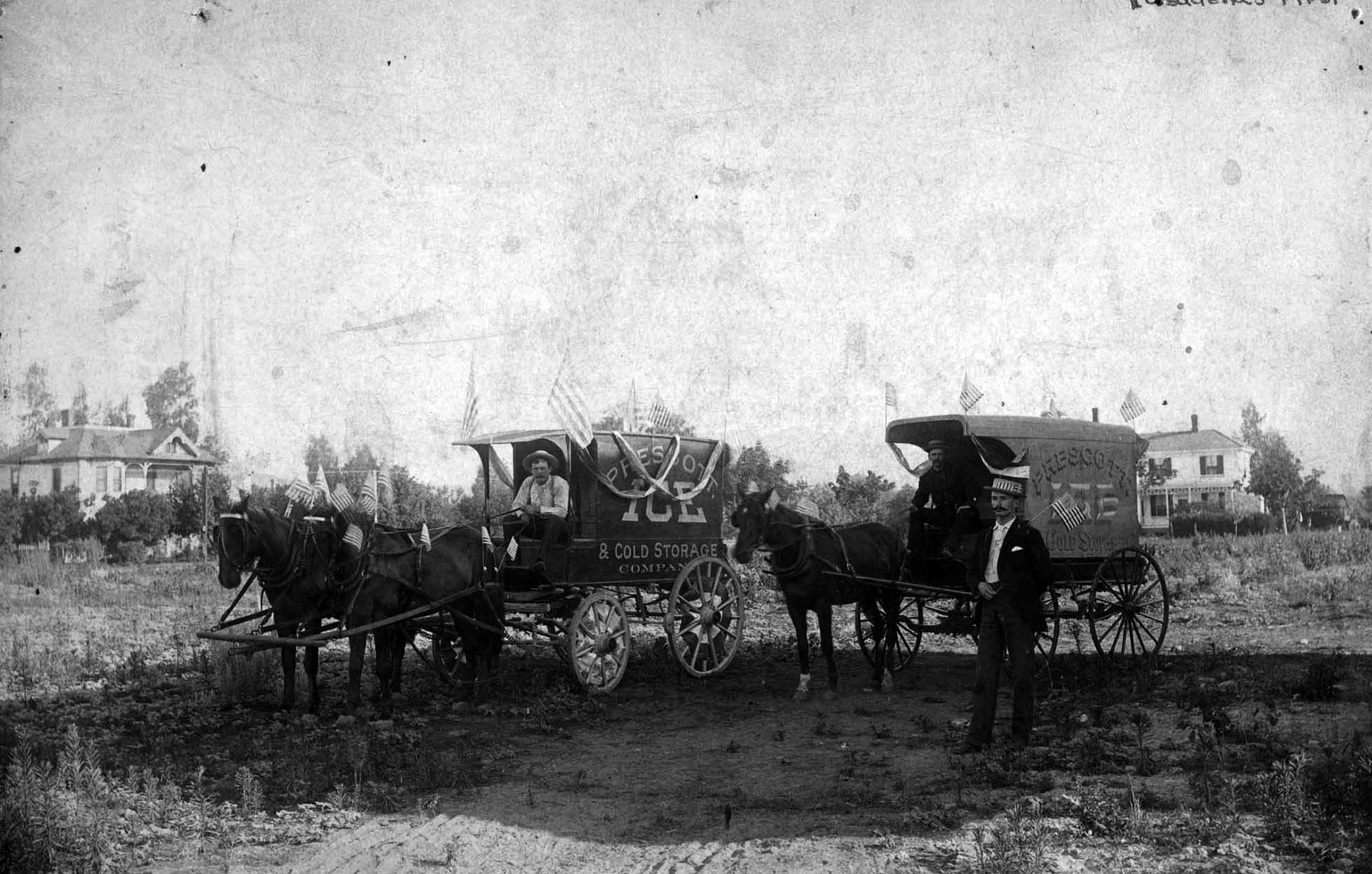 |
|
| (1889)*^* - Pasadena has ice for sale on July 4, 1889. Happy 4th of July! Caption reads “First Ice Wagons in Pasadena”. |
Historical Notes Founded in 1889 by J.C. Rust, the Independent Ice Company initially sold 'natural ice' shipped from Truckee. |
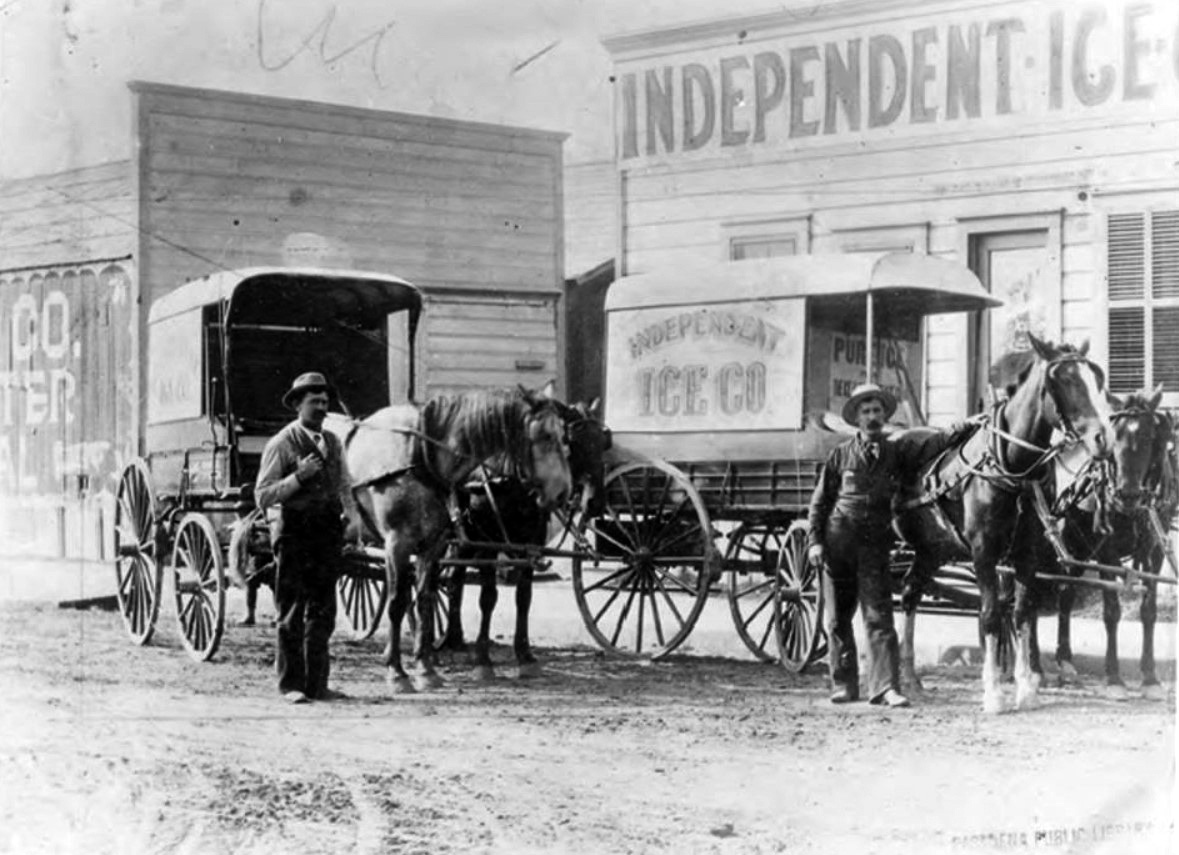 |
|
| (ca. 1890)** - View showing the Independent Ice Company located on the northwest corner of Union and Raymond. |
Historical Notes In the photo J.C. Rust is on the left and his younger brother, S.L. Rust, is on the right. |
Pasadena Grand Opera House
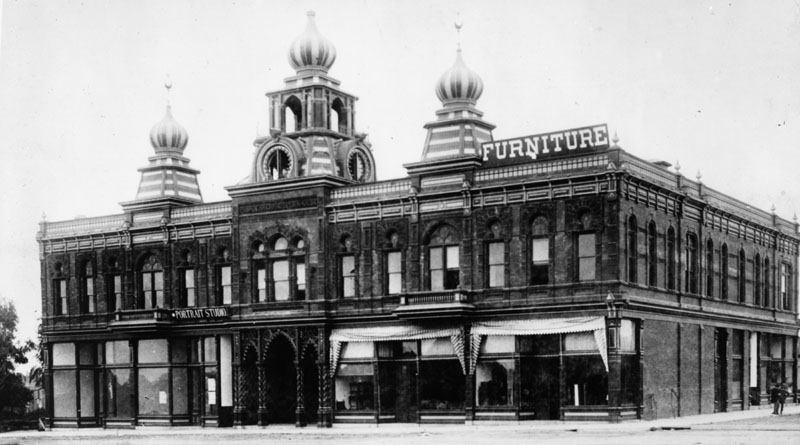 |
|
| (1889)* - Exterior view of the Pasadena Grand Opera House. A sign reading 'Furniture' sits on the right side of the roof line. |
Historical Notes The Grand Opera House was built in 1888 by the Grand Opera House Company and opened on February 13, 1889. The new opera company was formed a year earlier by E. C. Webster, Senator L. J. Rose, F. M. Ward, and Roscoe Thomas. The building was done in Moorish architecture, a style popular of the times. Ornately decorated with bronze and guilt, the opera house offered beauty rarely seen before. The very best of carpenters, artisans, and mechanical specialists were brought in to spare no expense in providing Pasadena with a world class opera house. Seating capacity was 1500 of which 900 seats were on the main floor and 600 were in the balcony. The main floor seats were on tiers that raised 18 inches for each row affording all the best of views. The folding back chairs were not only cushioned but held hat and umbrella racks. During 1890 the opera house steadily declined. Many thought it was because of being too far from the center of town. Others complained there was no heat causing uncomfortable situations for its patrons. Location, amenities, and plain old financial troubles caused the Opera House to be in a woeful condition by the end of 1890. The opera house was closed and bids were sought for its demolition and resale of the fixtures and furniture. By May of 1891 the Grand Opera House Company was bankrupt.^**^ |
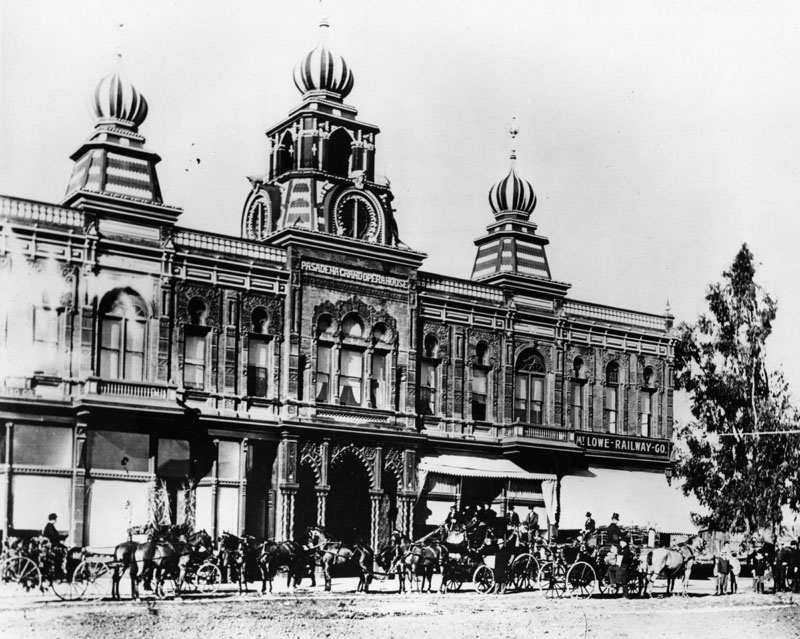 |
|
| (1891)* - View of the ornate facade of the Pasadena Grand Opera House with horses and carriages in front. A sign reading: "Mt. Lowe Railway Co." is seen on the right. |
Historical Notes In mid-1891 Thaddeus Lowe successfully negotiated with Senator Rose and the Ward brothers for the purchase of the Grand Opera House at a greatly reduced bankruptcy price. Quickly Lowe set out remodeling the Opera House to accommodate his various holdings. Engineer David Macpherson had offices up on the second floor and drafting rooms were set up for his mountain railway. Lowe had an office on the first floor and planned to sell tickets from it for his scenic railroad. |
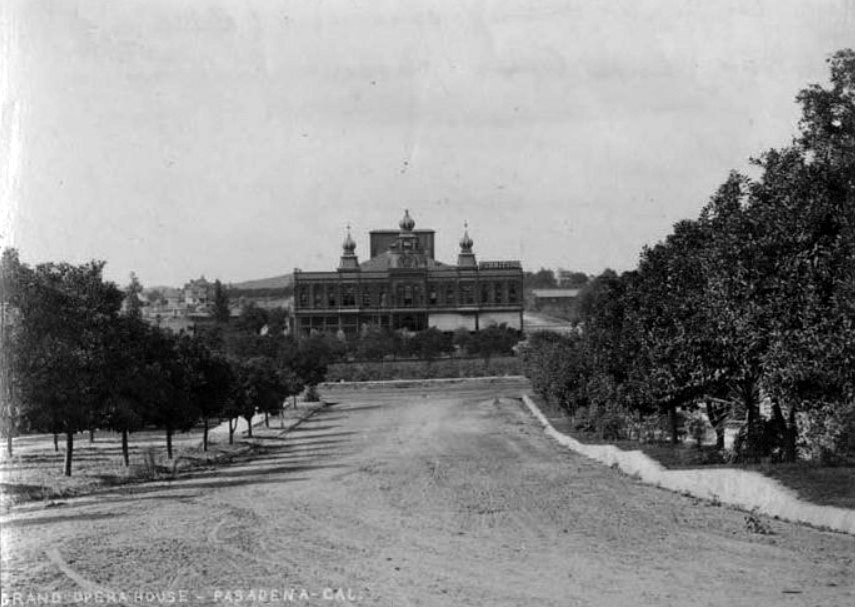 |
|
| (1893)^.^ – View showing the façade of the Pasadena Grand Opera House. |
Historical Notes Financial rough times came for Thaddeus Lowe. The scenic Mt Lowe railroad was taking much more money than expected and Lowe defaulted on the mortgage loan of his Orange Grove home and the Grand Opera House. The properties were foreclosed on and sold at auction. In the coming years the property changed hands a number of times, later becoming the Auditorium with fine hotel and eating facilities. By 1926 the grand old building known as the Grand Opera House had been razed and was eventually used by Royal Laundry as their factory and facilities.^**^ Click HERE to see more in Early Views of Mt. Lowe Railway. |
Thaddeus Lowe's Residence
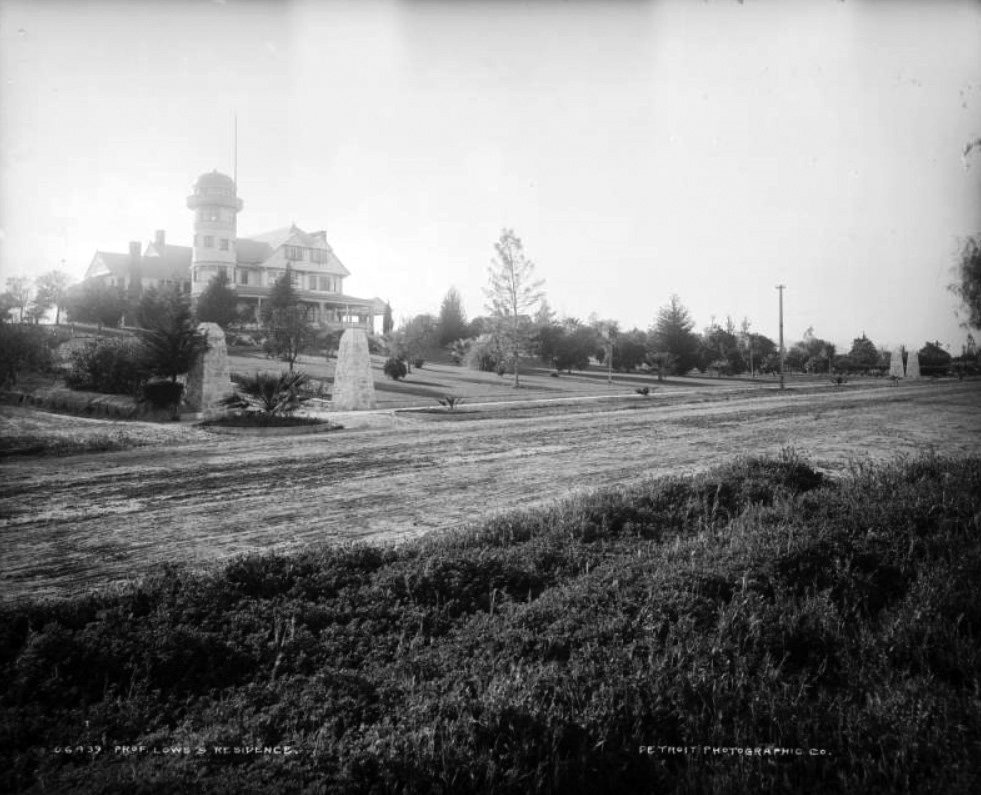 |
|
| (ca. 1890)*#*^ - View of Professor Thaddeus S.C. Lowe's home at 955 South Orange Grove in Pasadena. The multi-story stone and clapboard house has a multi-gabled roof, a large porch, dormers, chimneys, and an observatory within a domed tower. Stone entrance pillars and a manicured gardens front the house. |
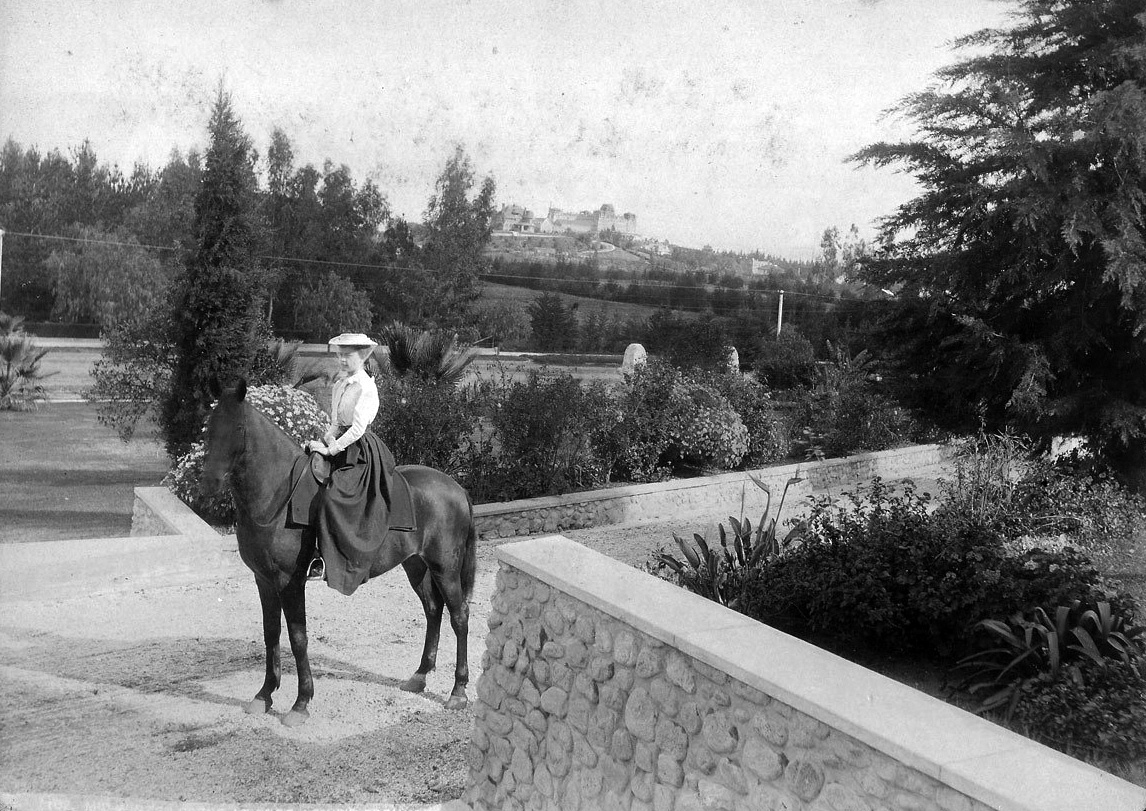 |
|
| (ca. 1890)++^ – View of a woman on horseback on the grounds of Professor T.S.C. Lowe's Pasadena Estate with the Raymond Hotel seen in the distance. |
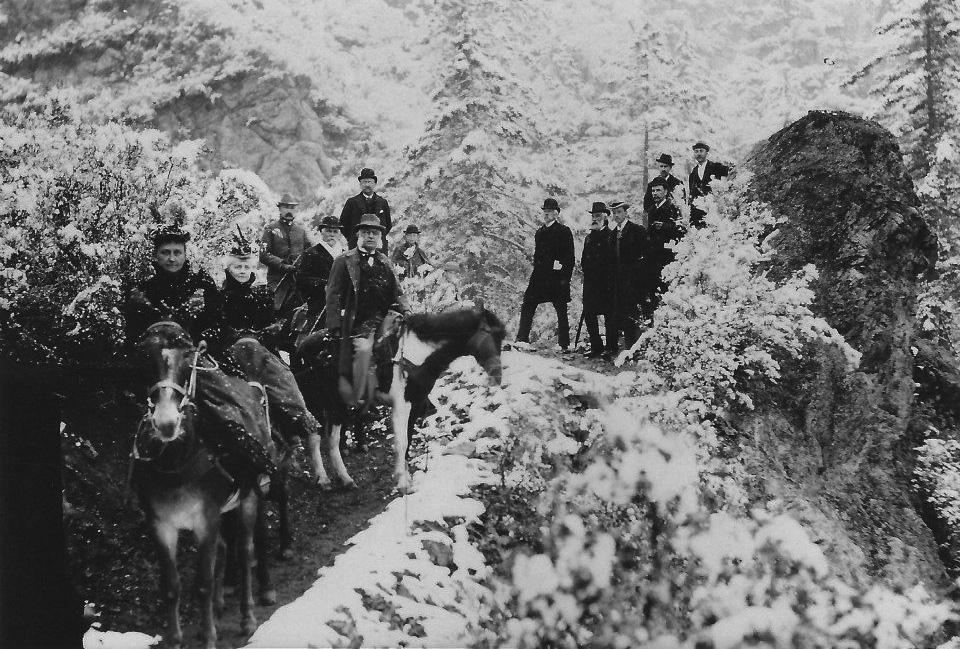 |
|
| (ca. 1893)* – View showing T.S.C. Lowe and party at Sphinx Rock in the San Gabriel Mountains. |
Historical Notes Professor Lowe loved giving tours, especially for visiting magnates. At left center, with bushy sideburns is Marshall Field, founder of the famous Chicago department store. Professor Lowe is just behind and to Field’s left in a derby. The older woman with the [under the circumstances] elaborate hat is Mr. Field’s wife Nannie. To the left of Nannie is one of Lowe’s many daughters, Edna. The man standing to the right of center with white papers in his coat pocket is the governor of California, H.H. Markham (1890-1894). Markham is the only California governor to come from Pasadena; Mount Markham is named for him. Beside the governor is Andrew McNally, the map king; his ornate Altadena mansion still stands at the corner of East Mariposa St. and Santa Rosa Avenue. ++# Thaddeus Lowe is best remembered for his Mount Lowe Railway which was placed on the National Register of Historic Places on January 6, 1993. The mountain itself still bears his name. Lowe is a member of the U.S. Army Military Intelligence Hall of Fame. Lowe Army Heliport at Fort Rucker, Alabama is named in his honor.*^ Click HERE to see more in Early Views of Mt. Lowe Railway. |
Painter Hotel (later La Pintoresca Hotel)
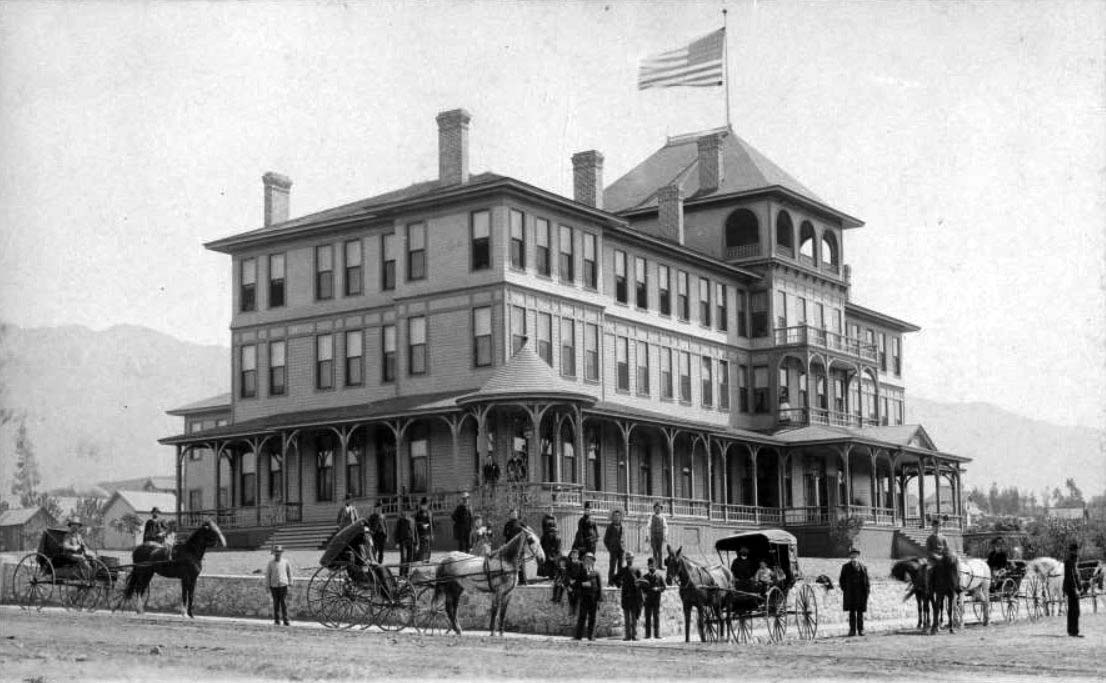 |
|
| (1888)* - View of the Painter Hotel located on the north side of Washington Street between Fair Oaks and Raymond. Built by J. H. Painter on land that he owned. |
Historical Notes The Painter Hotel opened Feb. 1888. It was the third largest hotel enterprise in Pasadena. The hotel was the distinguishing landmark of North Pasadena and is historical because of other large enterprises connected with it. |
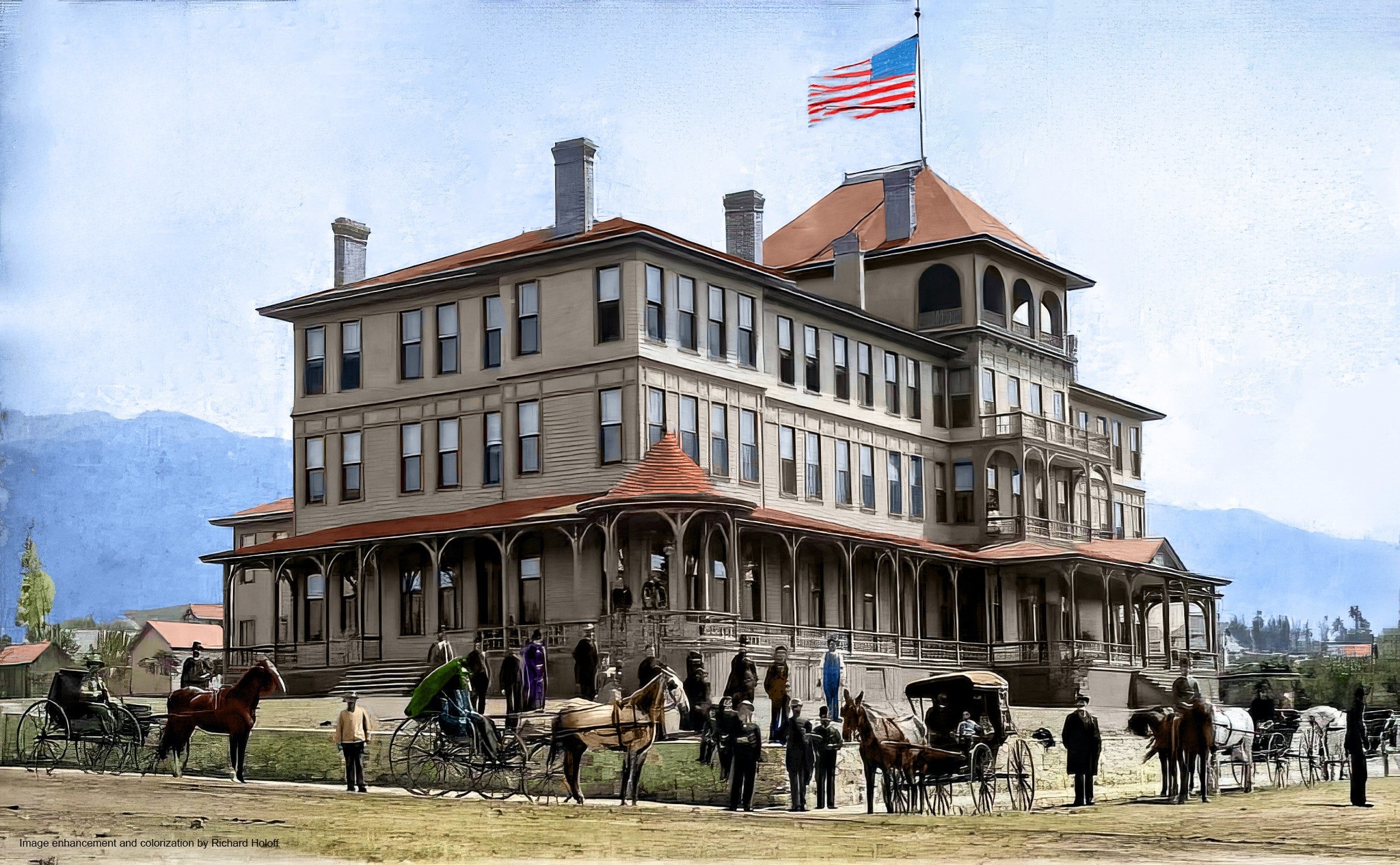 |
|
| (1888)* - View of the Painter Hotel located on the north side of Washington Street between Fair Oaks and Raymond. Built by J. H. Painter on land that he owned. Image enhancement and colorization by Richard Holoff |
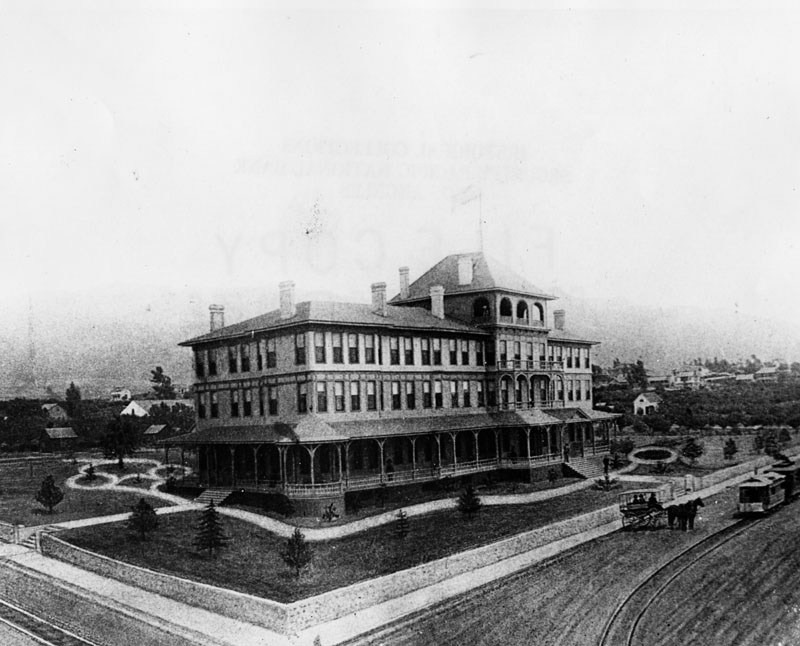 |
|
| (ca. 1890)* - Exterior view of the Painter Hotel. A horse-drawn carriage and trolley can be seen in front of the hotel on Washington Street. |
Historical Notes John Hunt Painter was a Quaker farmer living near Springdale, Iowa, who sent the firearms to abolitionist John Brown that were used during Brown's historic raid on Harpers Ferry in 1859. Painter was also an early settler of Pasadena where, in 1888, he erected the Painter Hotel (later La Pintoresca Hotel).*^ |
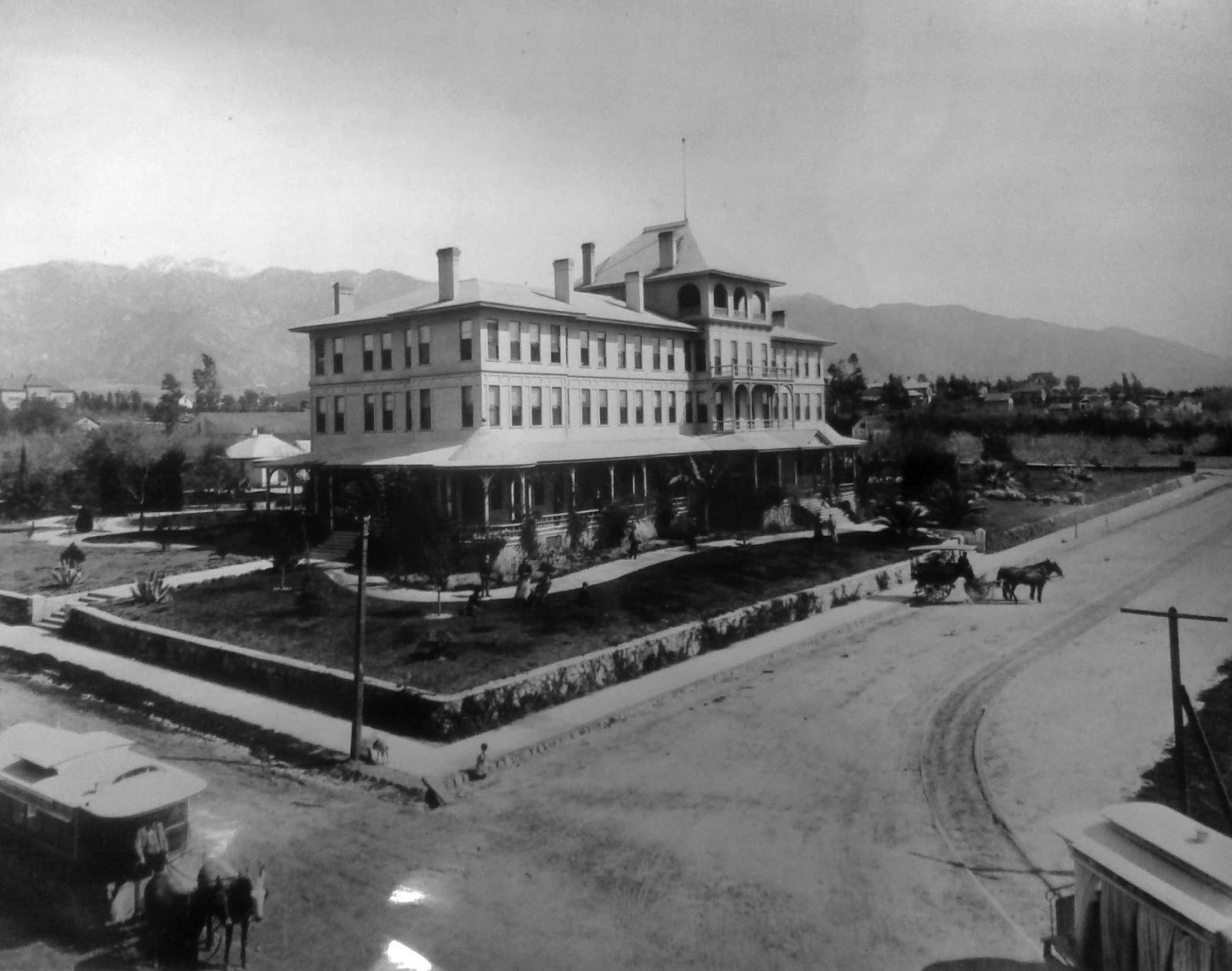 |
|
| (ca. 1889)* - View showing the the Painter Hotel. A horse-drawn carriage is front of the hotel on Washington Street and two horse-drawn trolleys are seen in the foreground. |
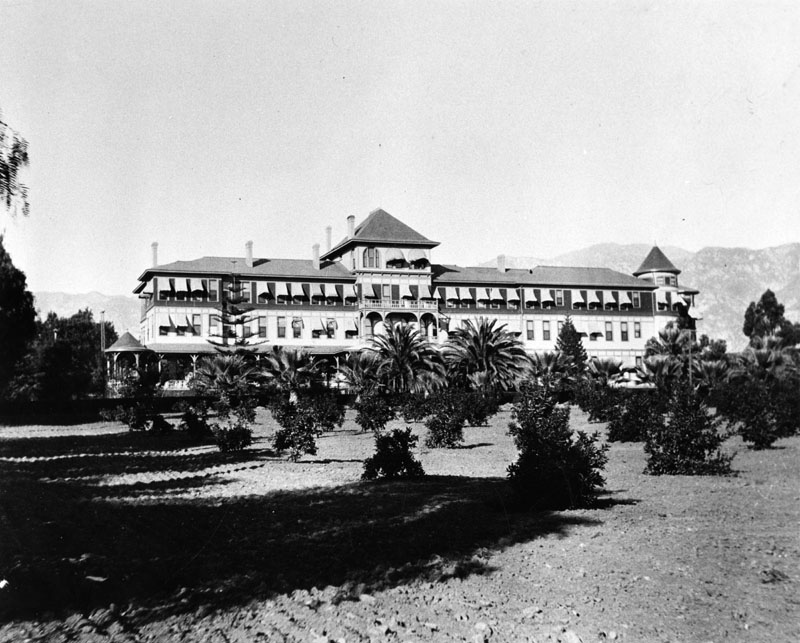 |
|
| (ca. 1890s)*- Exterior view of La Pintoresca Hotel (formerly Painter Hotel). Palm trees and an orchard can be seen on the grounds in front of the hotel. Note how the hotel has been enlarged (see previous photo). |
Historical Notes After the death of John Painter, the hotel was renamed La Pintoresca (1892). |
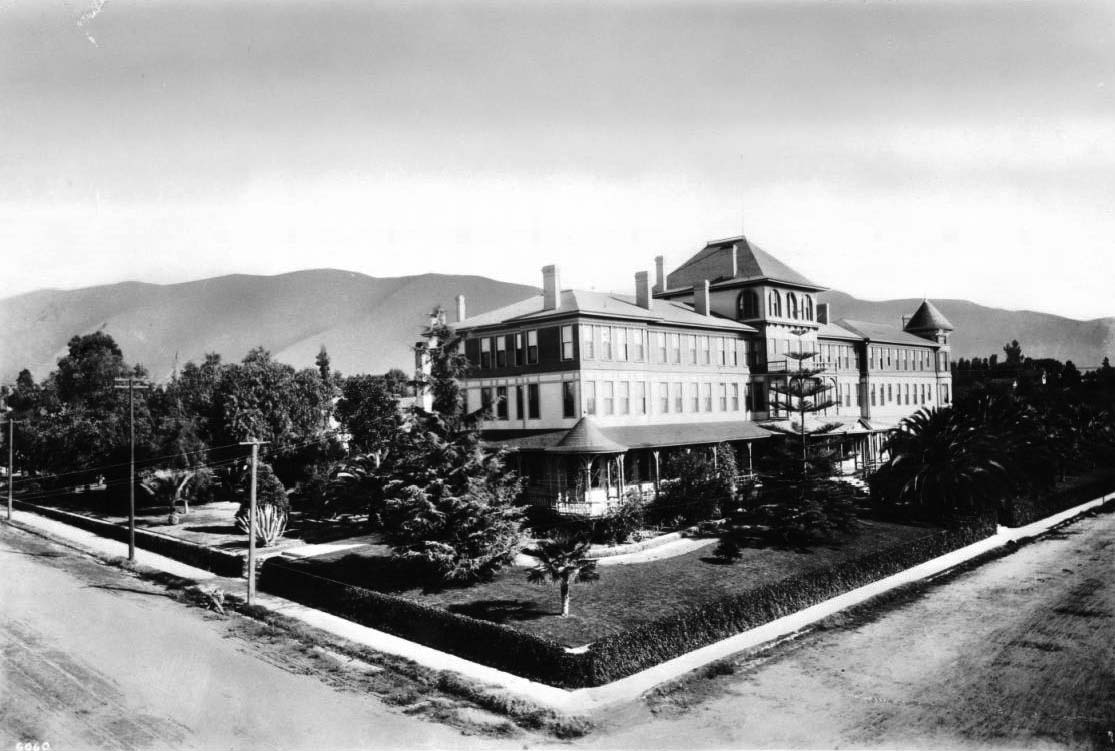 |
|
| (ca. 1895)* - View of the La Pintoresca Hotel, located on the northeast corner of Fair Oaks Avenue and Washington Street. The hotel stands at about four-stories tall. It features a conic-capped tower (at right), a conic-shaped corner (center), many windows and an immaculate yard. Trees, palms and bushes populate the yard. The San Gabriel Mountains are visible in the distance. |
Historical Notes "Pintoresca" is Spanish for the English word "picturesque". |
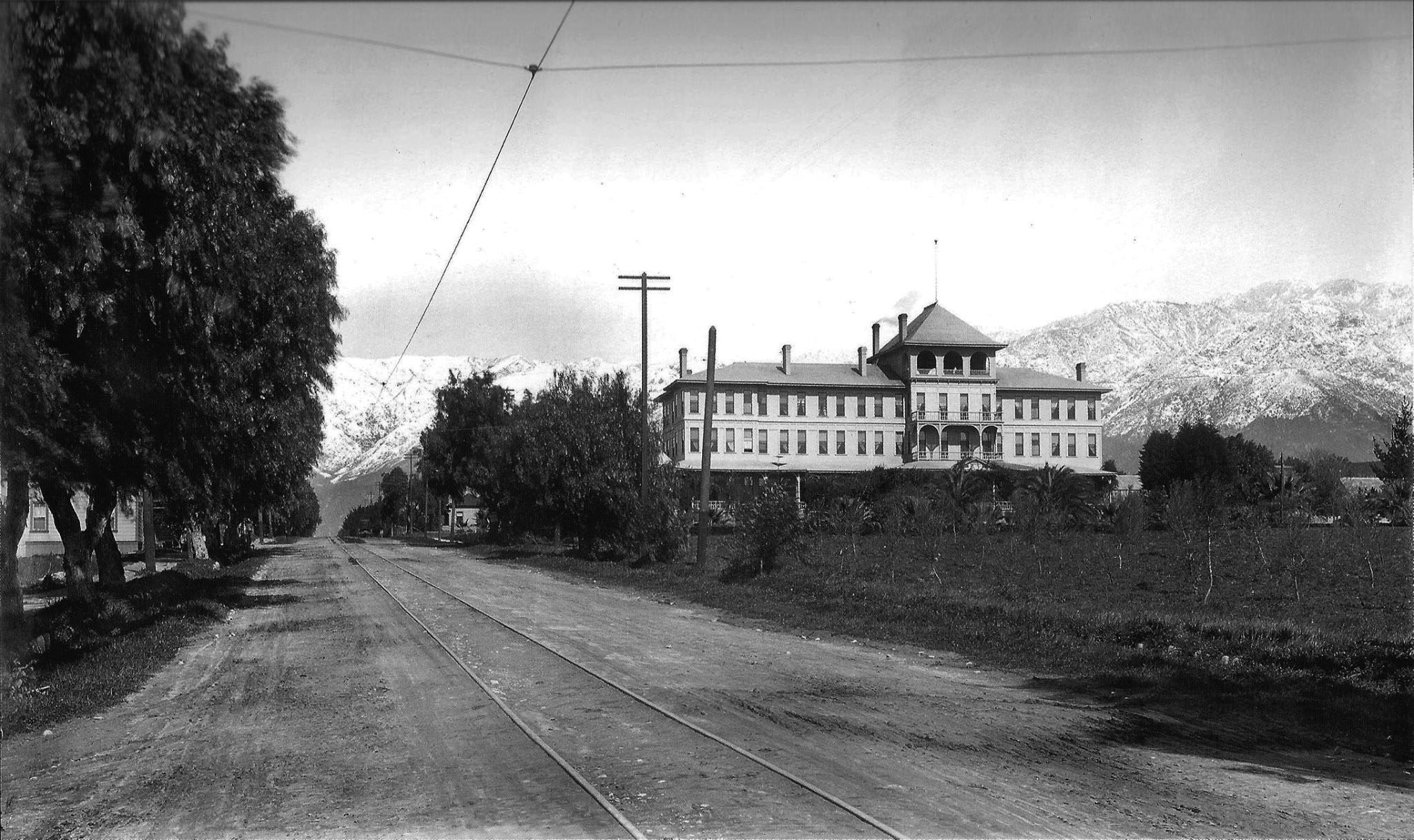 |
|
| (ca. 1890s)* – View looking north along Fair Oaks Avenue showing the La Pintoresca Hotel with the snow-covered San Gabriel Mountains in the background. You can barely make out Echo Mt. and Alpine Division ascending from it at right. |
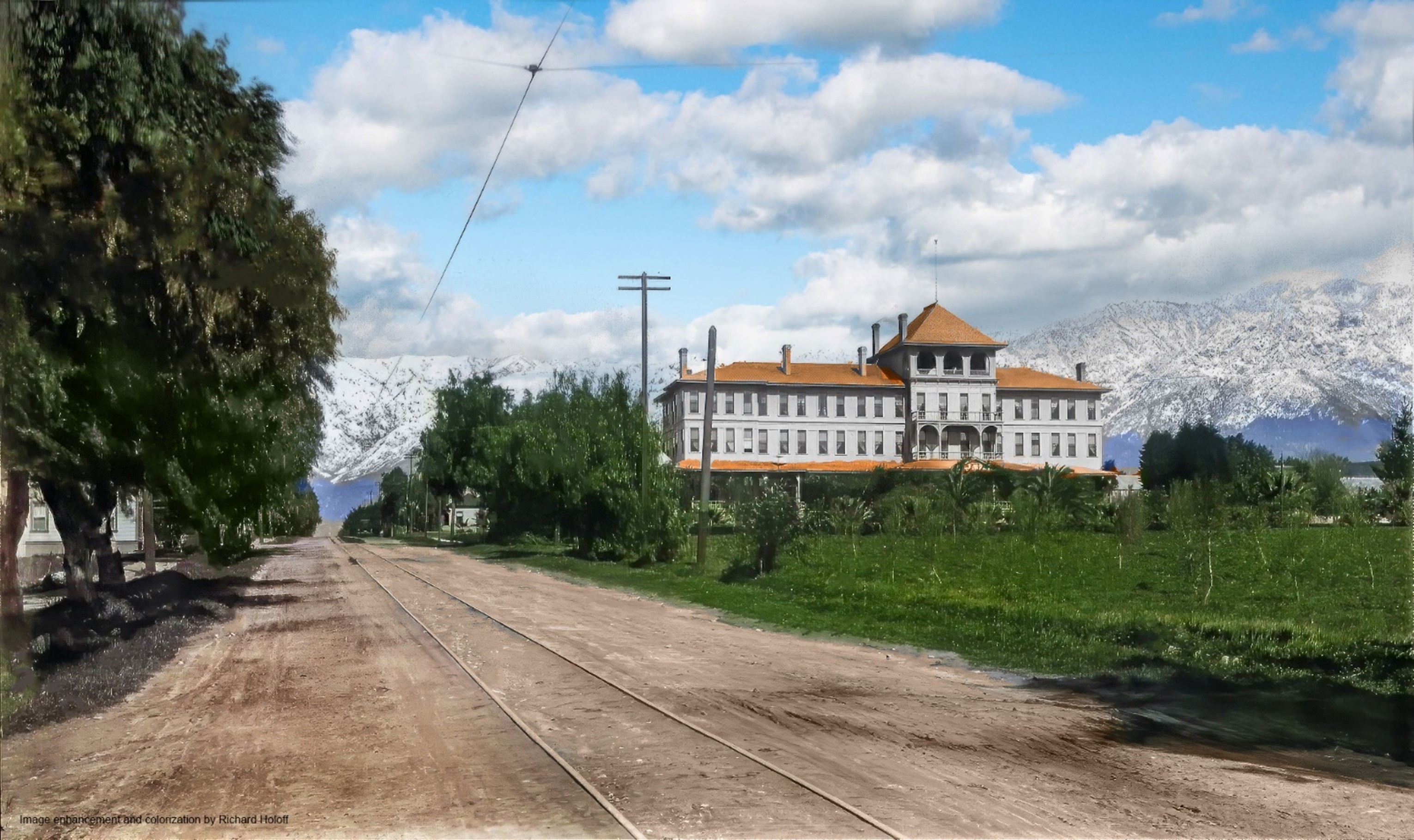 |
|
| (ca. 1890s)* – View looking north along Fair Oaks Avenue showing the La Pintoresca Hotel with the snow-covered San Gabriel Mountains in the background. You can barely make out Echo Mt. and Alpine Division ascending from it at right. Image enhancement and colorization by Richard Holoff |
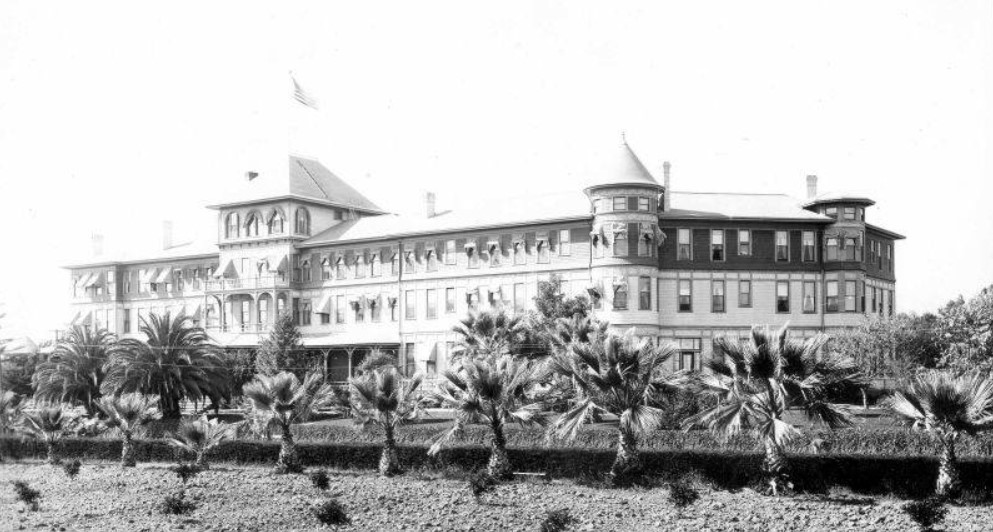 |
|
| (1897)* - Close-up view of the La Pintoresca Hotel showing a row of palm trees in front of the hotel. |
Historical Notes Over the years there were substantial additions to La Pintoresca Hotel, making it one of the largest hotels in Pasadena. |
 |
|
| (ca. 1910)* – Postcard view showing the La Pintoresca Hotel (formerly the Painter Hotel) on the corner of Fair Oaks Avenue and Washington Boulevard. This view shows the front facing onto Fair Oaks Avenue, with palm trees at the sidewalk and foliage around the porch. |
Historical Notes It was sold in 1905 and then destroyed by fire in 1912. Later, the City of Pasadena purchased the property and turned it into a park which it is today. * |
Early Pasadena Parades
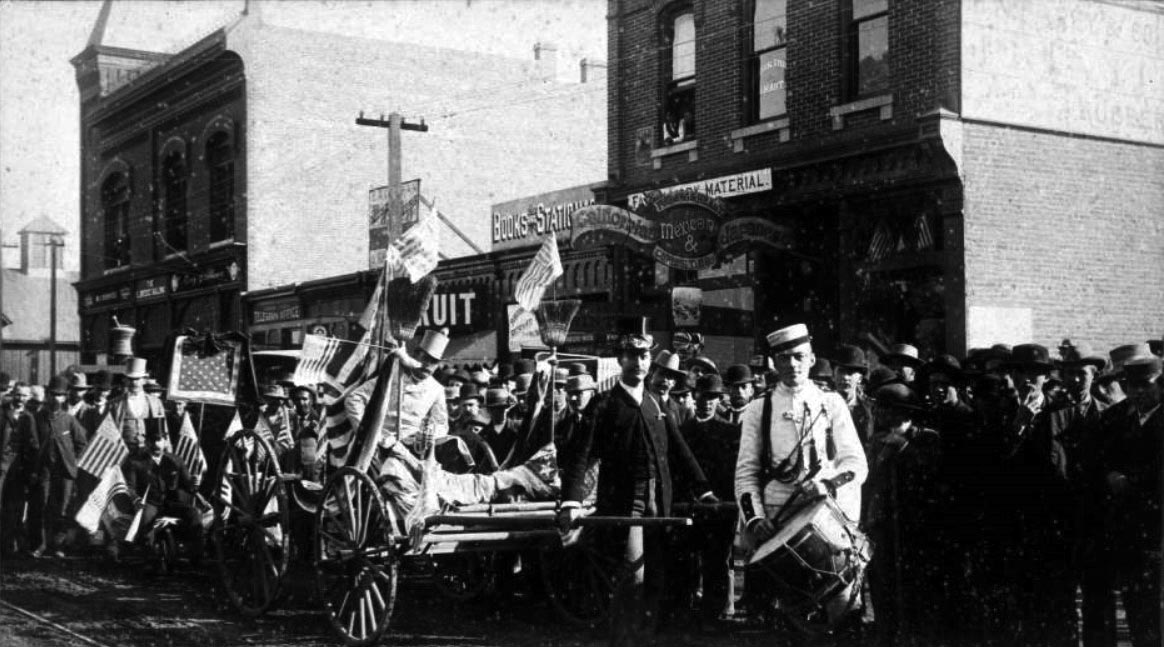 |
|
| (1888)* - A parade scene with spectators and American flags on Raymond Avenue, Pasadena. A drummer stands in uniform, and men in top hats are on a wagon draped with flags. The man at center holds a trumpet. Visible signs include "Telegraph Office" "Books and Stationery" "Musical Studio, J. Hart" (in upstairs window), "Furlong & Healy, Californian, Mexican and Japanese Curiosities." Photo Date: November 12, 1888 |
Historical Notes Title and date devised based on accompanying note that read: "Raymond Avenue. Nov. 12, 1888." This could possibly be related to an election, but the scene is not identified beyond the accompanying note. "Jarvis' Gallery, 29 E. Colorado St., Pasadena, Cal...."--text printed on verso. |
 |
|
| (1891)* - Decoration Day (now Memorial Day) parade in Pasadena, 1891. |
Historical Notes Memorial Day, which is observed every year on the last Monday of May, originated as Decoration Day after the American Civil War in 1868, when the Grand Army of the Republic, an organization of Union veterans founded in Decatur, Illinois, established it as a time for the nation to decorate the graves of the Union war dead with flowers. By the 20th century, competing Union and Confederate holiday traditions, celebrated on different days, had merged, and Memorial Day eventually extended to honor all Americans who died while in the military service. It marks the start of the unofficial summer vacation season, while Labor Day marks its end. The preferred name for the holiday gradually changed from "Decoration Day" to "Memorial Day," which was first used in 1882. Memorial Day did not become the more common name until after World War II, and was not declared the official name by Federal law until 1967. *^ |
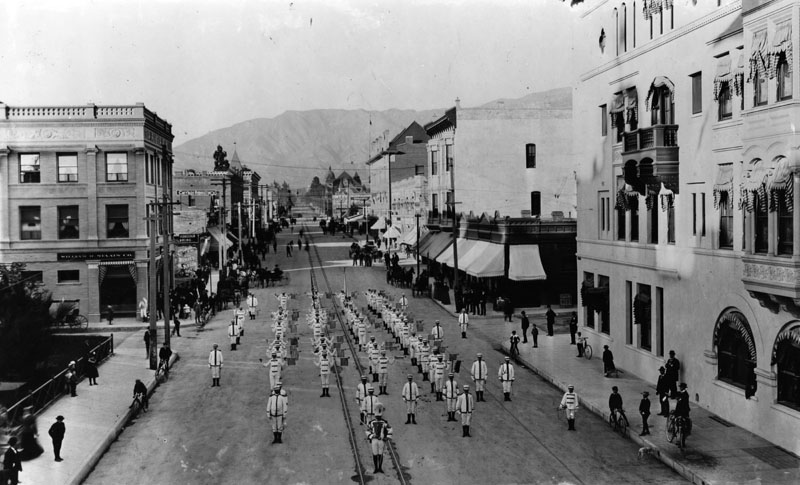 |
|
| (ca. 1890s)* - A flag-carrying marching group on Raymond Avenue, Pasadena, circa the 1890s. View is toward the north. William H. Staats Co. is on the left. |
Classical School for Boys
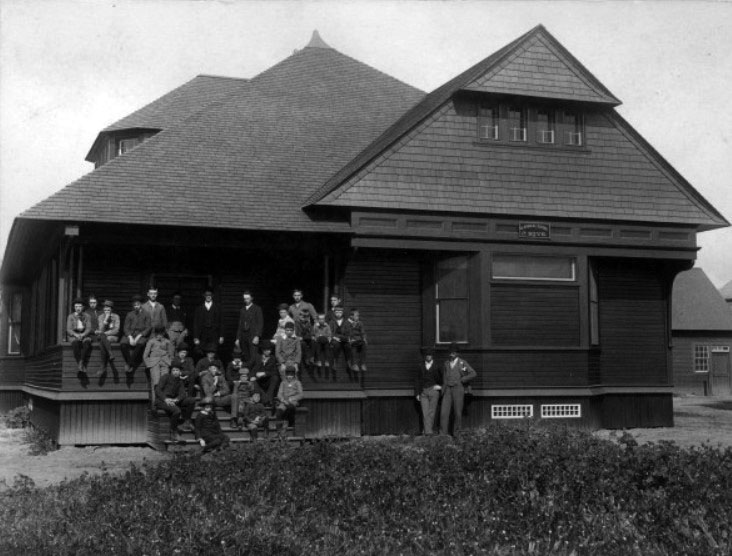 |
|
| (1891)** - View of a group of young men in front of the Classical School for Boys, located at 59 S. Euclid Ave. |
Historical Notes The Classical School for Boys opened in 1889 with a new building erected in 1891. Steven Cutter Clark, principal. |
Raymond Hotel (1st Raymond)
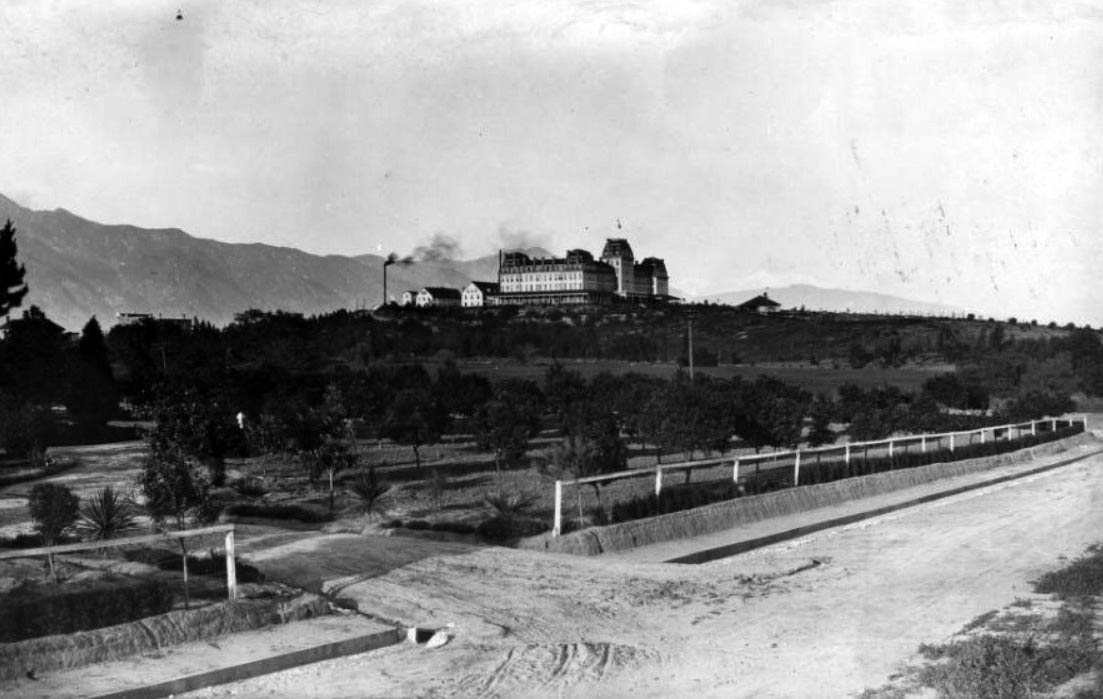 |
|
| (1895)* - View of the Raymond Hotel from its West Entrance. Wagon-wheel marks can be seen on the dirt road. |
Historical Notes The first Raymond Hotel in Pasadena was built by Mr. Walter Raymond of Raymond & Whitcomb Travel Agency of Boston, Massachusetts. It was a grand Victorian structure that opened on November 17, 1886, boasting 200 rooms and 80 chimney. Unfortunately, the original hotel burned down in 1895 but was rebuilt in 1901 with even more grandeur, featuring 400 rooms, golf links, and formal gardens. The hotel was a significant winter residence for wealthy Easterners and played a crucial role in transforming Pasadena into a popular destination for East Coast tourists seeking sunny skies and luxurious accommodations. |
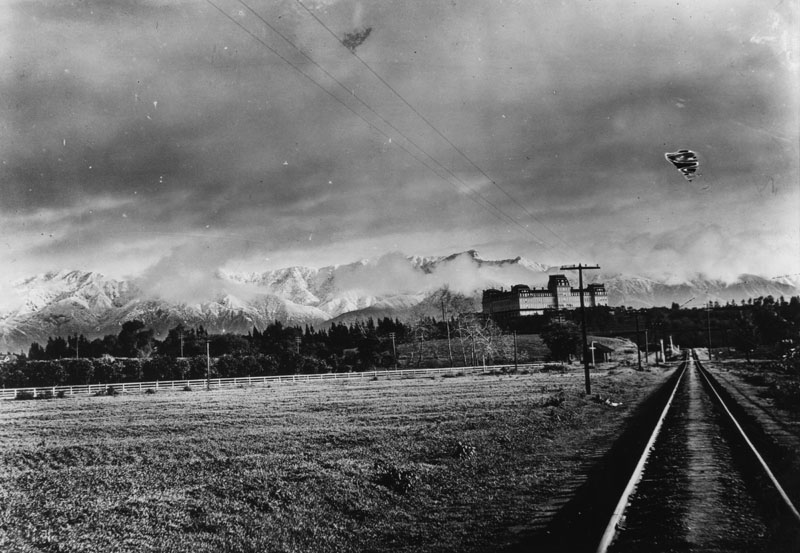 |
|
| (1894)* - The Raymond Hotel sits atop a hill and offers a view of the snow-covered San Gabriel Mountains that are partially obscured by clouds. Railroad tracks run from the foreground into the distance. Photo by C.C. Pierce |
Historical Notes The Raymond Hotel guests invariably arrived by train, the mainline Santa Fe which stopped at Raymond Station at the bottom of the hill. Many had private cars that would park on the side spur near the station. All guests were ferried by a horse-drawn bus to the hotel at the top of the hill. Later, much to the dismay of many guests, the old station closed down in deference to a newer station built up the tracks closer to downtown Pasadena. Guests were then forced to take an auto bus the extra distance to the hotel.* |
 |
|
| (1894)* - The Raymond Hotel sits atop a hill and offers a view of the snow-covered San Gabriel Mountains that are partially obscured by clouds. Railroad tracks run from the foreground into the distance. Photo by C.C. Pierce; Image enhancement and colorization by Richard Holoff |
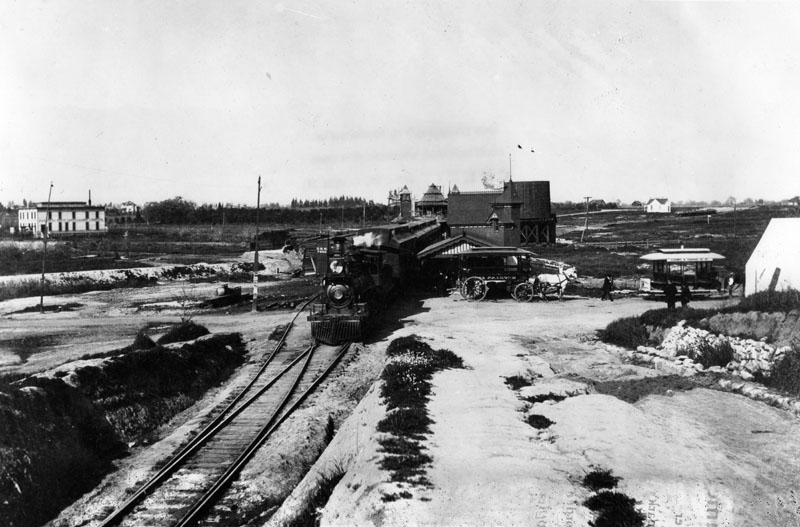 |
|
| (1890)* - Exterior view of the Raymond Station in South Pasadena. A locomotive with cars sits adjacent to the station, while a horse-drawn carriage and trolley stand ready to take passengers to the Raymond Hotel. |
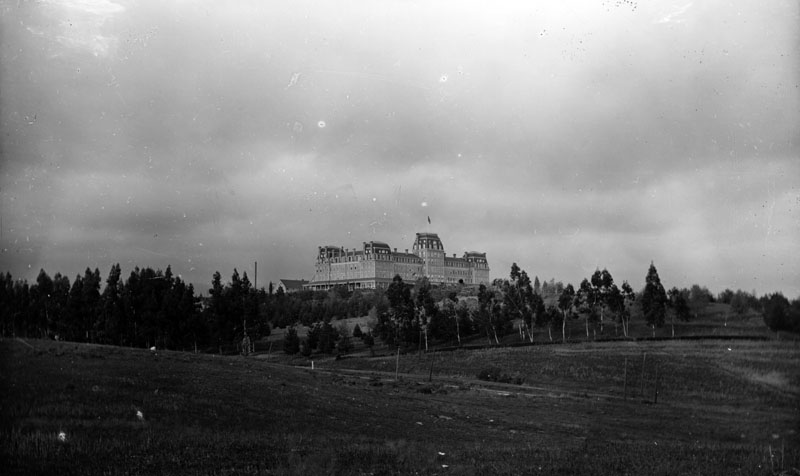 |
|
| (ca. 1890)* - View of the Raymond Hotel looking across the grounds at the western facade. Located in South Pasadena, it was the first major resort hotel of the San Gabriel Valley. |
Historical Notes There was a nine-hole golf course on a 50-acre lot alongside the hotel, and though it was humble in comparison, it was one of the few good attractions in the area. Much of the landscaping was done by the suggestion of the Mr. Theodore Payne, a famous local horticulturist of the time. The hotel also had card rooms, writing rooms, a reception room, and in the basement was a pool and billiards parlor — with a secret bar.* |
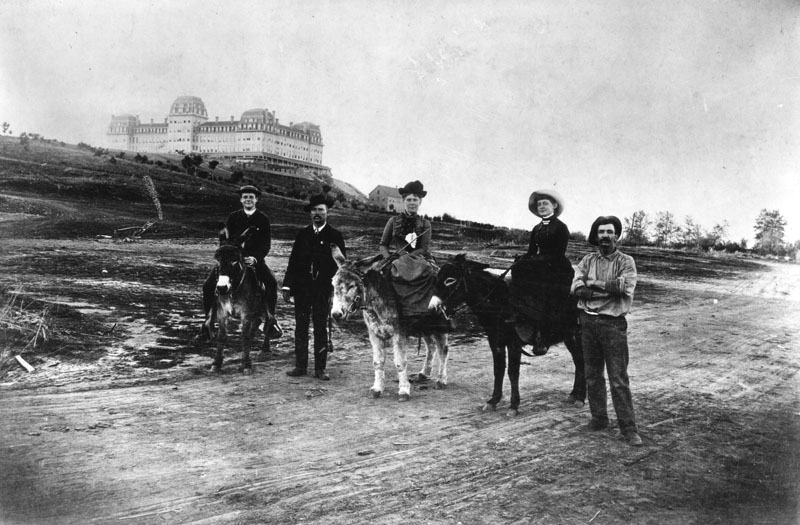 |
|
| (ca. 1890)* - Two women and a young man sit astride donkeys as they ride down the dirt road, accompanied by two men, that leads from the Raymond Hotel. The women sit side-saddle. |
.jpg) |
|
| (ca. 1890)* - View of the Raymond Hotel looking across the grounds at the western facade. A small building stands next to a path on the landscape grounds. Several horse-drawn carriages and stages are parked in front of the hotel. A portico runs around the building. |
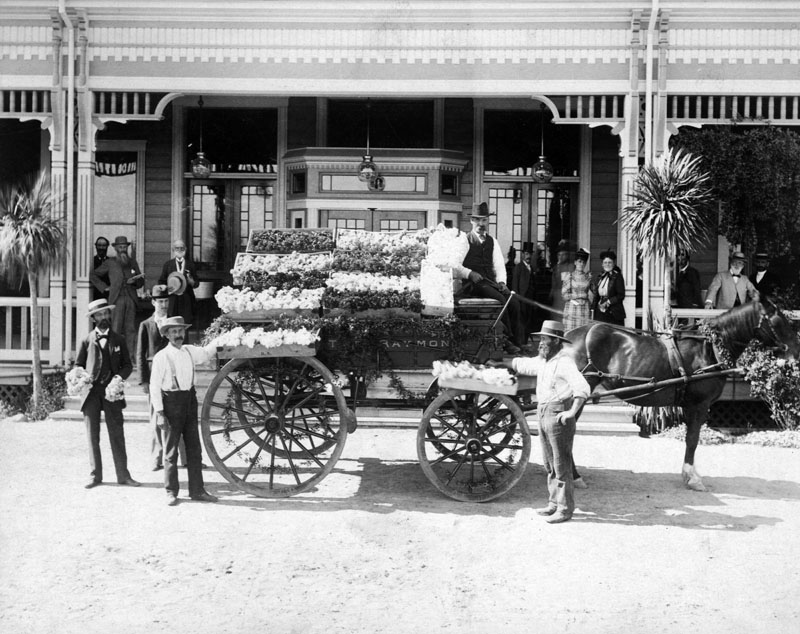 |
|
| (1890s)* - Long boxes of cut flowers lay on a horse-drawn cart with "The Raymond" printed on the side. The horse and driver have stopped at the entrance to the Raymond Hotel. Spectators watch the unloading from the shaded portico. |
Historical Notes The hotel had a large nursery operation with 500 American Beauty rose plants, 4 acres of carnations and a reported 3,000 pansies.* |
 |
|
| (ca. 1890s)* - View of tally-ho in front of the Raymond Hotel in South Pasadena with Colonel Marshall C. Wentworth standing at right. |
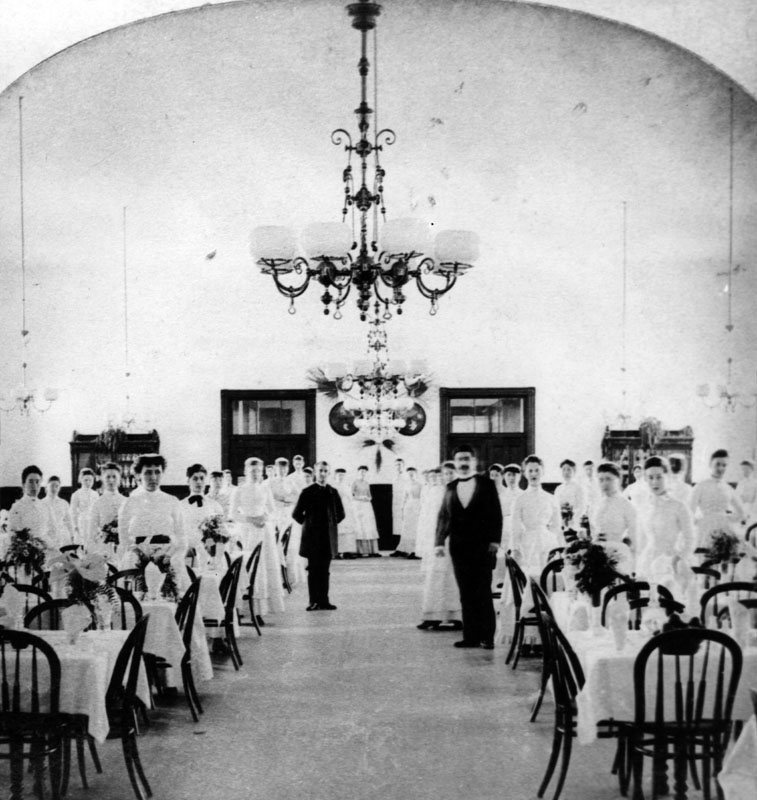 |
|
| (ca. 1890)* - The staff of the dining hall in the Raymond Hotel pose in their uniforms as they stand around the tables ready for the hotel's guests. |
Historical Notes The dining room was the largest room in the house able to seat 400 people. Pasadena City, which boasted of being a “dry” town, had an ordinance disallowing the sales of alcohol — except to the hotel guests.* |
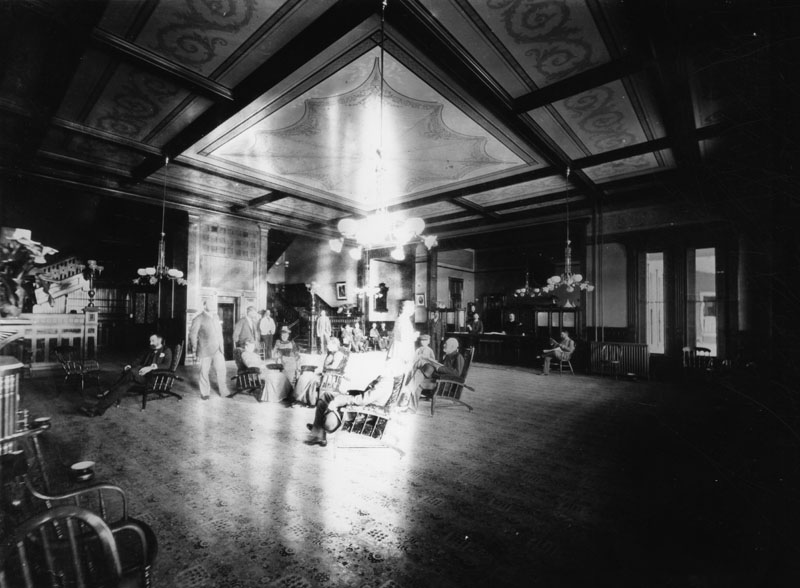 |
|
| (ca. 1890)* - A group of people sit under a hanging light fixture in the luxurious and spacious lobby of the Raymond Hotel. The beamed ceiling is decorated with painted motifs. An elevator is directly behind the seated group and large staircases behind the elevator and on both sides lead to the upper floors. The reception desk is to the left of the front doors. The floor is carpeted and spittoons stand close to several chairs. |
Historical Notes Part of the success of the Raymond was the transcontinental tours which came through the hotel. The tours were discontinued as the onslaught of newcomers repeatedly bothered the regular guests, who by now were a mainstay of the hotel.* |
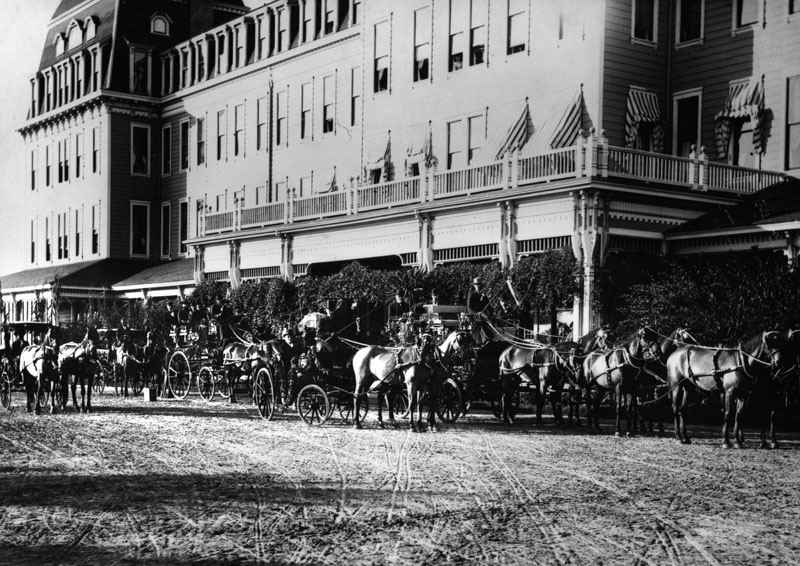 |
|
| (ca. 1890s)* - Mount Lowe - Tally Ho carriages parked in front of the Raymond Hotel, in Pasadena. Carriages take hotel guests to Mount Lowe and back. |
Historical Notes This is the original hotel built by Mr. Walter Raymond of Raymond & Whitcomb Travel Agency of Boston. It burnt to the ground in 1895 and was replaced by a second Raymond Hotel in 1903.* |
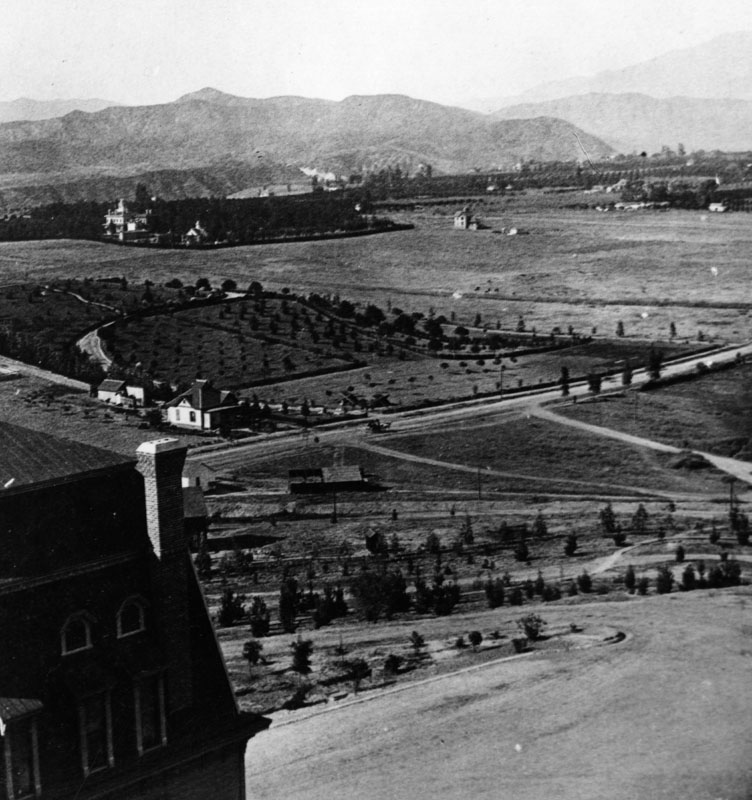 |
|
| (ca. 1890)* - View looking northeast from the Raymond Hotel showing the landscape between the hotel and the San Gabriel Mountains. |
 |
|
| (ca. 1890)#* - View looking south from the Raymond Hotel toward Oneanta Park. |
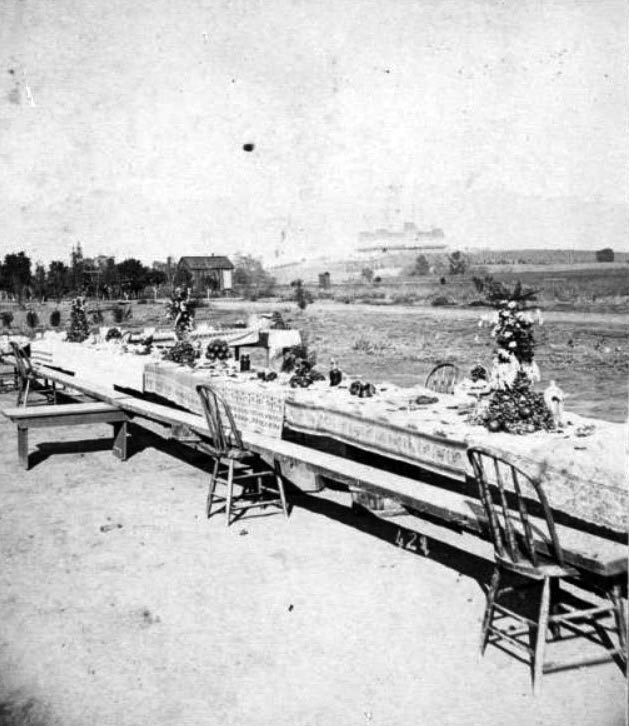 |
|
| (ca. 1890)* - View looking north showing a long picnic table set with decorative centerpieces and tablecloths in a field in South Pasadena, with the Raymond Hotel visible in the distance. |
Historical Notes The first Raymond Hotel was built in 1886 and burned down in 1895. A second Raymond Hotel would be built. It opened in 1901. |
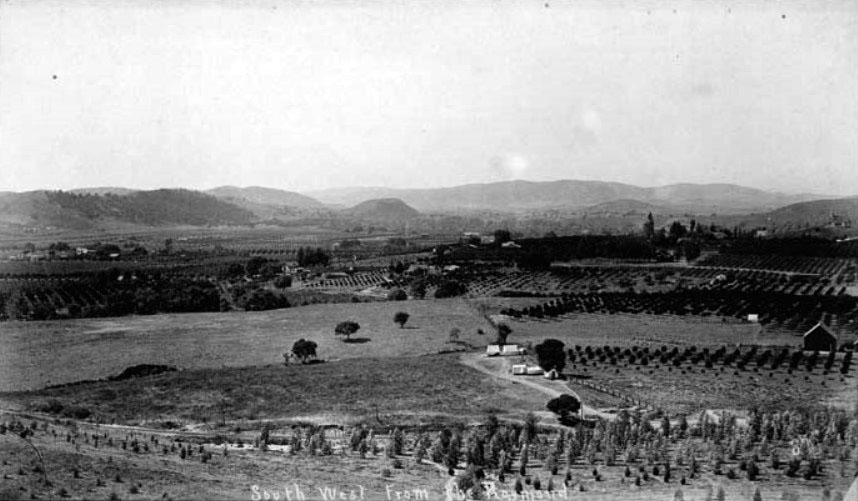 |
|
| (ca. 1890)^## – View looking southwest from the Raymond Hotel. |
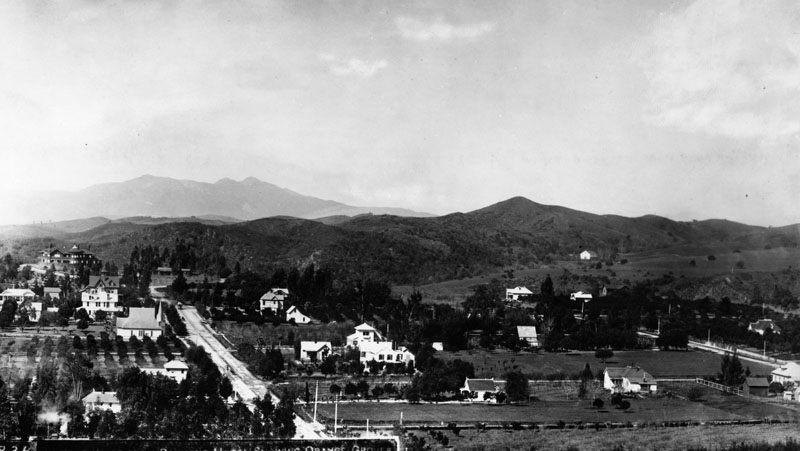 |
|
| (ca. 1890s)* - View of orange groves looking west from the Raymond Hotel. |
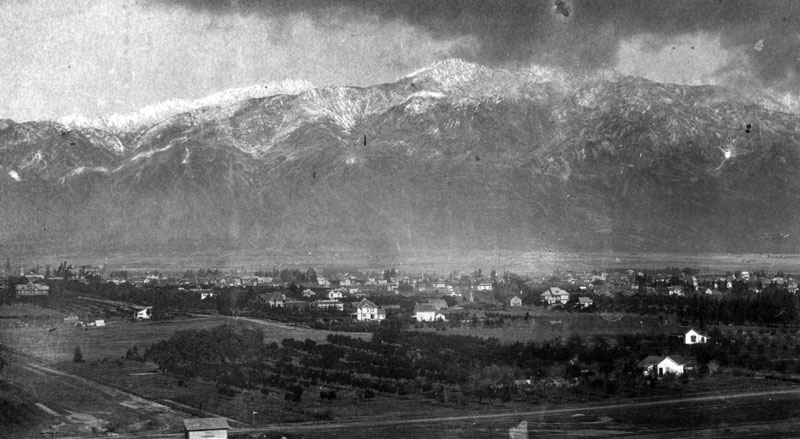 |
|
| (ca. 1890)* - View taken from the Raymond Hotel in Pasadena shows residential homes and cultivated land. Snow on the Sierra Madre's can be seen in the background. |
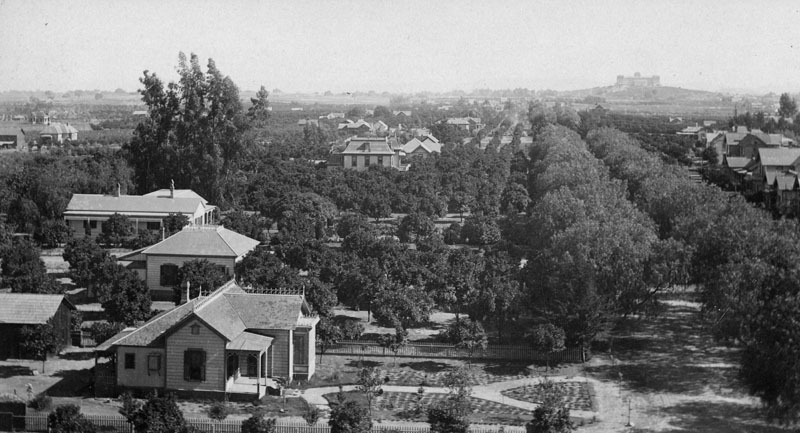 |
|
| (1890)* - View of Pasadena residential area looking south from the M. E. Church. In the far distance can be seen the Raymond Hotel perched on Bacon Hill. |
Mt. Lowe
.jpg) |
|
| (ca. 1890)* - Postcard view showing Pasadena and Mount Lowe taken from the Raymond Hotel. |
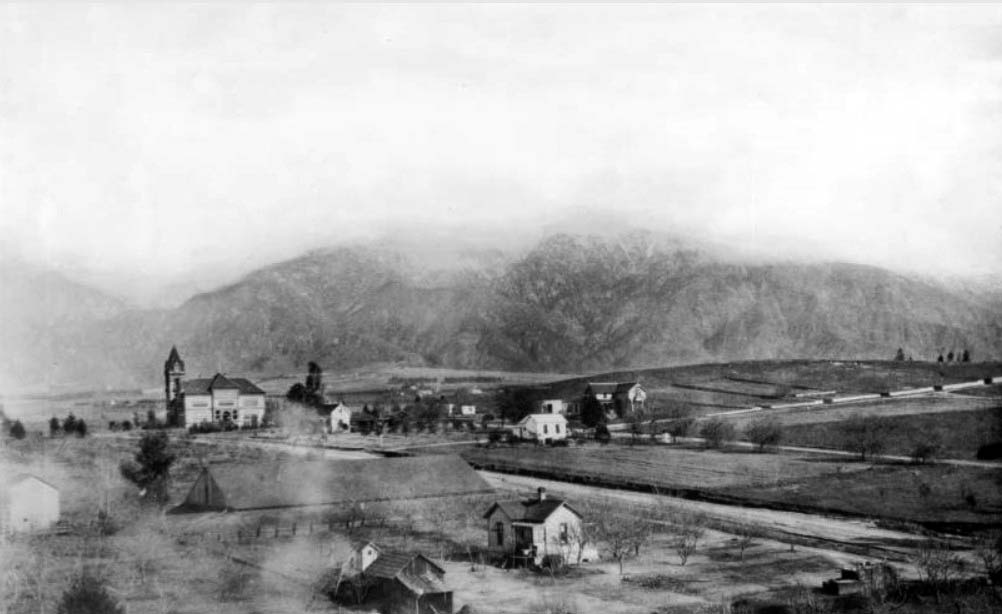 |
|
| (ca. 1893)^^ - Panoramic view of Pasadena, looking northeast from the La Pintoresca Hotel. Houses and trees are sparsely scattered across the landscape. Mt. Lowe and Echo Mountain are in the center of the range. |
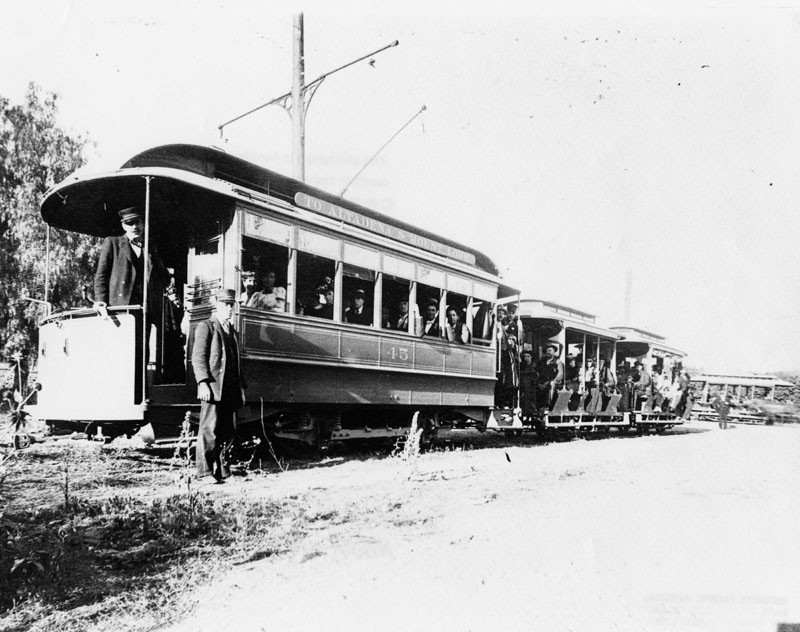 |
|
| (ca. 1890s)* - View of three streetcars full of travelers on their way to Altadena with continuing service to Mount Lowe, as indicated on the top car streetcar #45 on the left. Visiting Mount Lowe in the San Gabriel Mountains was a "must" for the local inhabitants as well as tourists. The journey started at Mountain Junction in Altadena, moved by electric car (such as shown here) to Rubio Pavilion, the bottom terminus of the Cable Incline Railway. This photograph was taken at Lake Avenue and Mariposa in Altadena. |
Click HERE to see more in Early Views of Mt. Lowe Railway |
South Pasadena
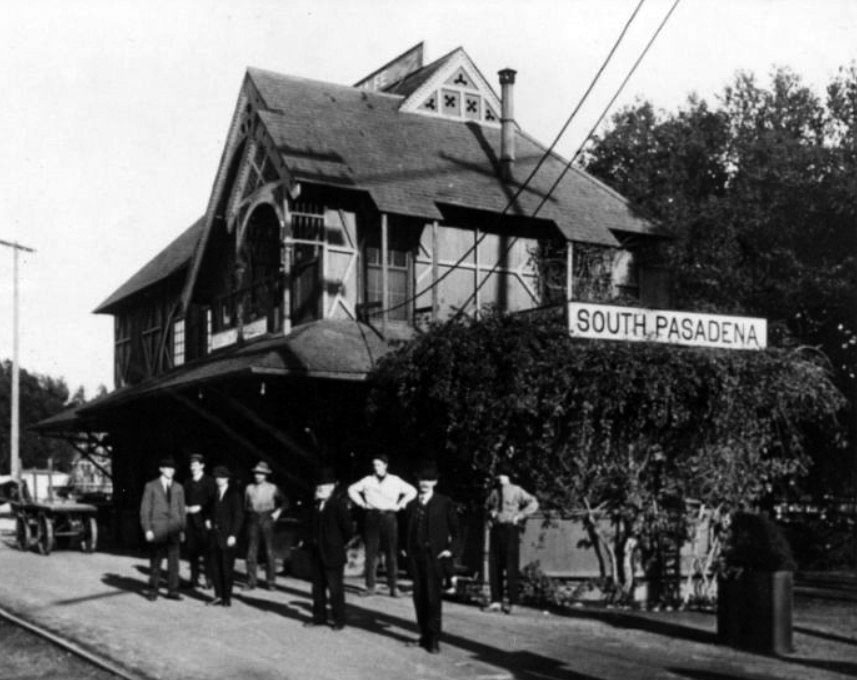 |
|
| (ca. 1890)^#^^ – View showing eight men posing in front of the Santa Fe Railroad Station in South Pasadena. |
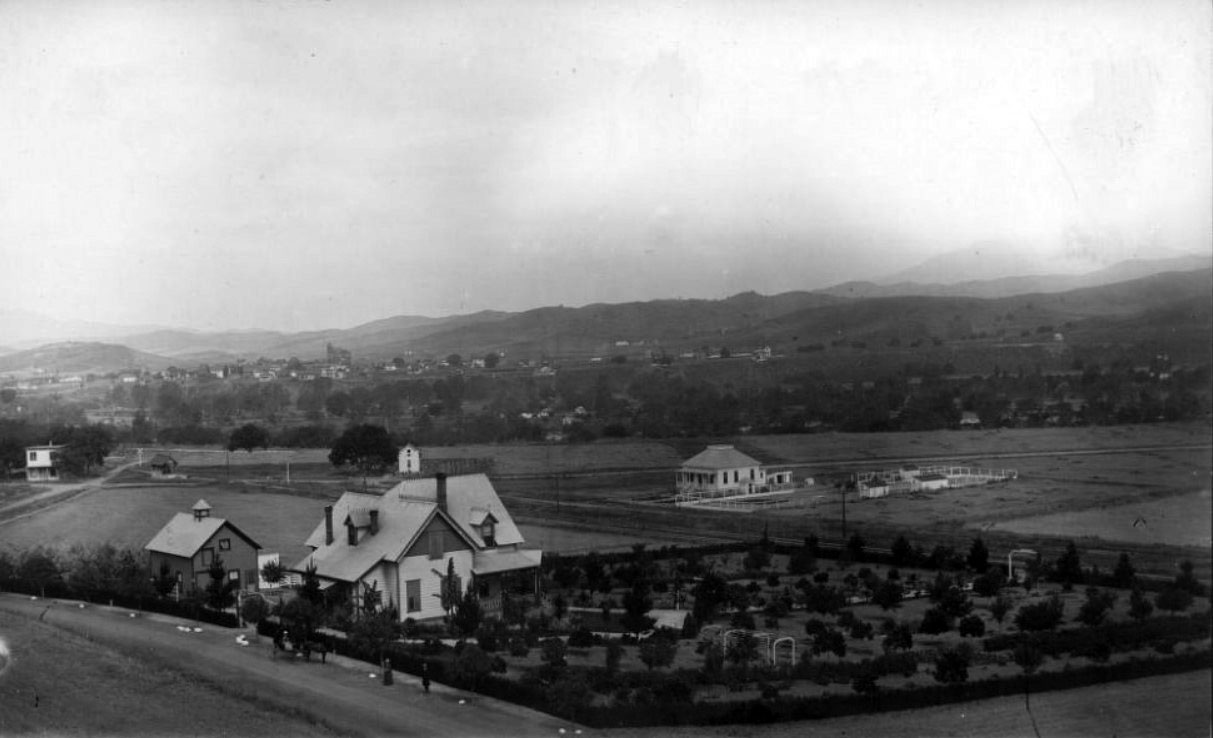 |
|
| (ca. 1890)^#^^ – Panoramic view of South Pasadena showing houses and farms. |
Historical Notes In February 1888, members of the southern portion of Pasadena attempted to gain more control over their own property and a vote for incorporation was made. In 1888, South Pasadena incorporated the southern portion of the Indiana Colony and land south and eastward to the Los Angeles border.*^ |
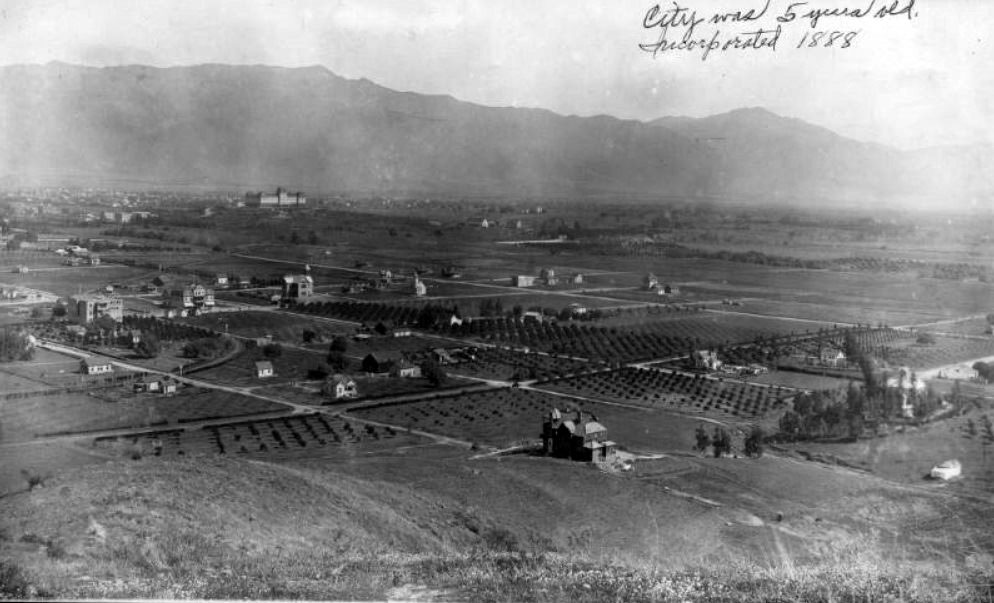 |
|
| (ca. 1893)^#^^ – View of South Pasadena from the Monterey Hills. The Raymond Hotel can be seen on top of Bacon Hill. In the background and beyond is the City of Pasadena and the San Grabriel Mountains. |
Historical Notes On March 2, 1888, the city of South Pasadena was incorporated with a population slightly over 500 residents, becoming the sixth municipality in Los Angeles County. It was chartered with roughly the same area as the current South Pasadena, about 3.42 square miles. With completion of the Pacific Electric Short Line, putting the entire city within easy walking distance of the “red car” stations, South Pasadena also became a one of the first suburbs of Los Angeles. South Pasadena is associated with that of the Cawston Ostrich Farm and the Fair Oaks Pharmacy and Soda Fountain as they played vital roles in the history of the city.*^ |
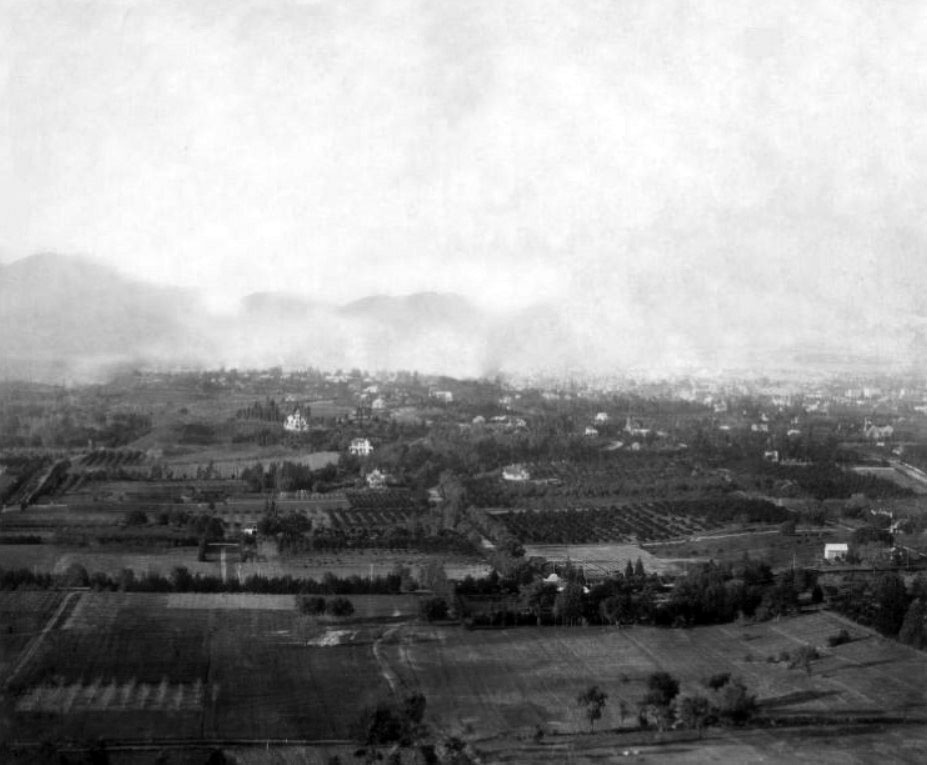 |
|
| (1895)^#^^ – View of South Pasadena from the Monterey Hills showing the rich farmland. |
_1895.jpg) |
|
| (1895)^#^^ – View of South Pasadena from the Monterey Hills. In the distance can be seen the Rayomond Hotel, the City of Pasadena, and the majestic San Gabriel Mountains. |
Altadena
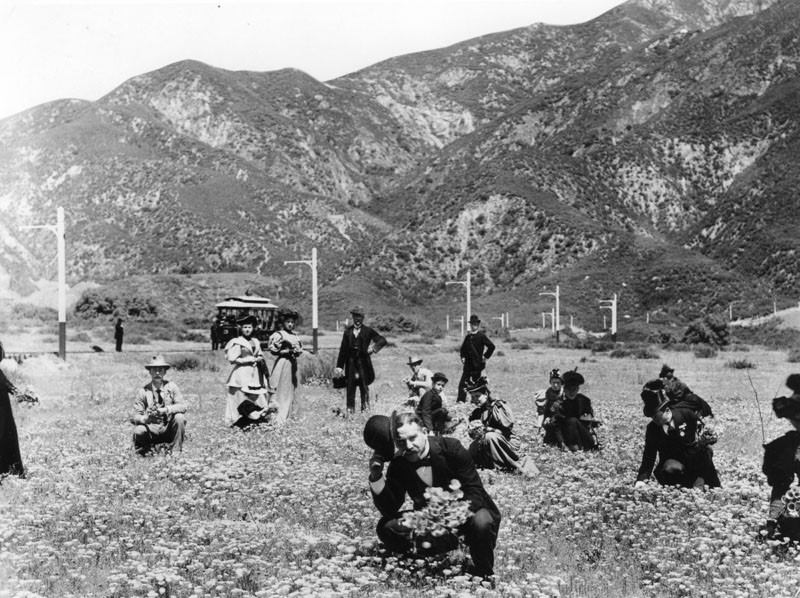 |
|
| (ca. 1895)* - A group of people picking California poppies growing naturally near north Lake Avenue in Altadena. The Mount Lowe Railroad electric car is parked nearby, and the poles lead north to the end of Lake Avenue and turn right. |
Historical Notes Altadena has always been popular for its colorful poppy fields, and before the turn of the century it was even more popular, for the sailors on ships coming into coast harbors could see the "flaming" fields from far off, and often used them as navigation aids. There were always enough for folks to pick, too.* |
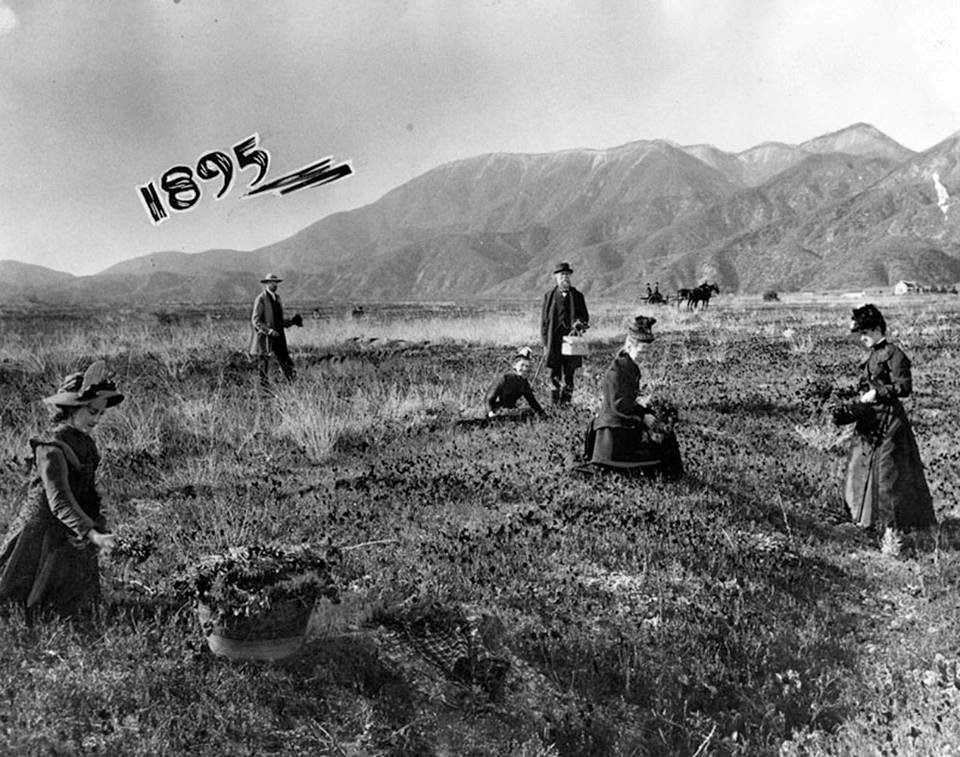 |
|
| (1895)* - View showing a group of people picking flowers in a poppy field about the spot where Lake Avenue now meets Woodbury Road. |
* * * * * |
Please Support Our CauseWater and Power Associates, Inc. is a non-profit, public service organization dedicated to preserving historical records and photos. Your generosity allows us to continue to disseminate knowledge of the rich and diverse multicultural history of the greater Los Angeles area; to serve as a resource of historical information; and to assist in the preservation of the city's historic records.
|
More Historical Early Views
Newest Additions
Early LA Buildings and City Views
History of Water and Electricity in Los Angeles
* * * * * |
References and Credits
* LA Public Library Image Archive
^*California Historic Landmark Listing (Los Angeles)
#* Huntington Digital Library Archive
#+ East of Allen blogspot: Sierra Madre Villa; William Cogswell, Famous Artist and East Pasadena Pioneer
#*^Flu Pandemic of 1918: www.flu.gov
*^^Nuestra Señora la Reina de los Ángeles: losangelespast.com
*#*KCET: When L.A.'s Most Famous Streets Were Dirt Roads; Scoville Bridge; The Raymond Hotel
*#^First United Methodist Church of Pasadena
^*#Noirish Los Angeles - forum.skyscraperpage.com; First Church; Raymond Hotel
^##California State Library Image Archive
###Library of Congress: Raymond Hotel Parnoramic, ca.1908; Hotel Green Panoramic, ca. 1908
#++Bridgehunter.com: Scoville Bridge; Colorado Bridge
*++Christmas Tree Lane Association
++^Professor Thaddeus Lowe- Mount Lowe Railway
^**^The Grand Opera House – by Jake Brouwer
*#*^Denver Public Library Image Archive
*#*#Downtown Pasadena's Early Architecture
^#^^Calisphere: University of California Image Archive
*##*The Development of Pasadena and Washington Square: washingtonsquarepasadena.org
#*^*Hometown Pasadena: Pasadena's Abolitionist Heritage
#^**Eventbrite.com: Altadena Historical Society Tour of Col. G. G. Green's Carriage House
*^ Wikipedia: History of Pasadena; Tournament of Roses Parade; The Langham Huntington; Hotel Green; Rose Bowl Game; Pasadena City Hall; Old Town Pasadena; Los Angeles Terminal Railway; Richard H. Chambers United States Court of Appeals and the Vista del Arroyo Hotel and Bungalows; California Institute of Technology; Benjamin Wilson; Raymond Hotel; Fair Oaks Avenue; South Pasadena; Andrew McNally; McNally Residence; Owen Brown (Abolitionist); Altadena; John Hunt Painter; Los Angeles and San Gabriel Railroad
< Back
Menu
- Home
- Mission
- Museum
- Major Efforts
- Recent Newsletters
- Historical Op Ed Pieces
- Board Officers and Directors
- Mulholland/McCarthy Service Awards
- Positions on Owens Valley and the City of Los Angeles Issues
- Legislative Positions on
Water Issues
- Legislative Positions on
Energy Issues
- Membership
- Contact Us
- Search Index